

100+ Europe Travel Tips for First Timers & Must-Knows Before You Go
Last Updated: November 6, 2023
*FYI - this post may contain affiliate links, which means we earn a commission at no extra cost to you if you purchase from them. Also, as an Amazon Associate I earn from qualifying purchases. Check out our Privacy Policy and Disclosure. for more info.
Headed to Europe for the first time and trying not to cry?
I get it. You’re probably a hot mess of emotion right now. Between the excitement of ticking off bucket list moments and the anxiety of getting pickpocketed or (possibly worse) getting side-eyed by cool European youths, there’s a lot of potential for stress carbs and sheer overwhelm.
Don’t worry though – I have all the Europe tips you need in this post to keep those first time jitters at bay, and ensure you’re fully prepared for your big European adventure.
So, what are some must-knows before you travel to Europe for the first time? Read on for a full of my best Europe travel tips, after over a decade of travelling around/living on this gorgeous and delicious continent.
NOTE: As an aggressively apologetic Canadian, I must first clarify that these European travel tips are written from a North American perspective, and there are some culture shocks that (while seemingly basic) can really confuse a 1st time visitor, so… yes, this is just me covering all the bases. Enjoy!
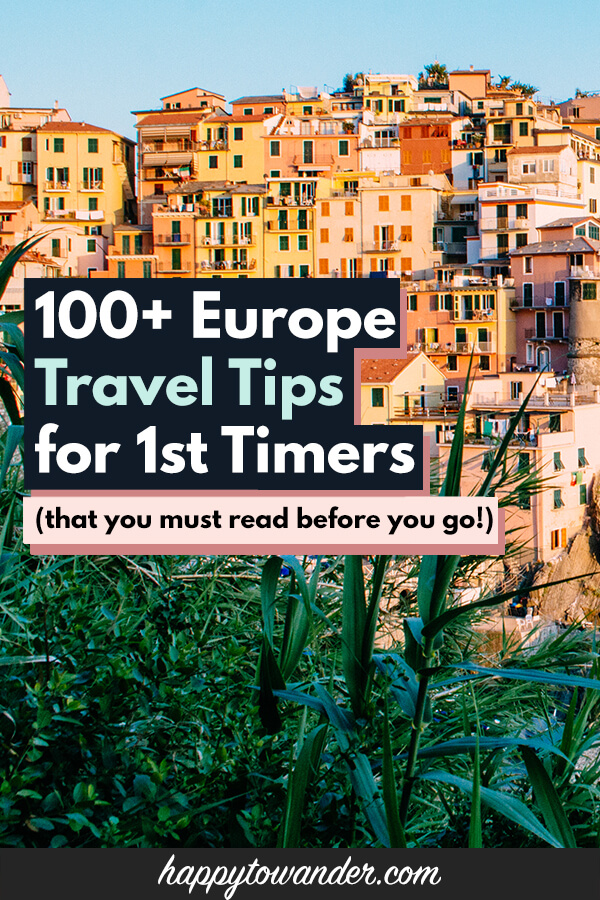
Save this list of Europe Travel Tips for Later!
You’ll be very glad you did.
Europe Travel Planning Tips
Let’s start with some planning-related Europe tips to help you with flights, booking hotels in Europe, choosing dates, the best times to visit Europe, etc. to get you from armchair travel to your real-life dream trip.
Steal my step by step guide to planning a trip to Europe from scratch
This post is full of random Europe travel tips, but if you are looking more for step by step guidance, be sure to check out my step by step guide to planning a Europe trip.
Also be sure to check out my free Europe trip planner book , as well as my free International Travel Checklist for a list of things to do before you travel abroad.
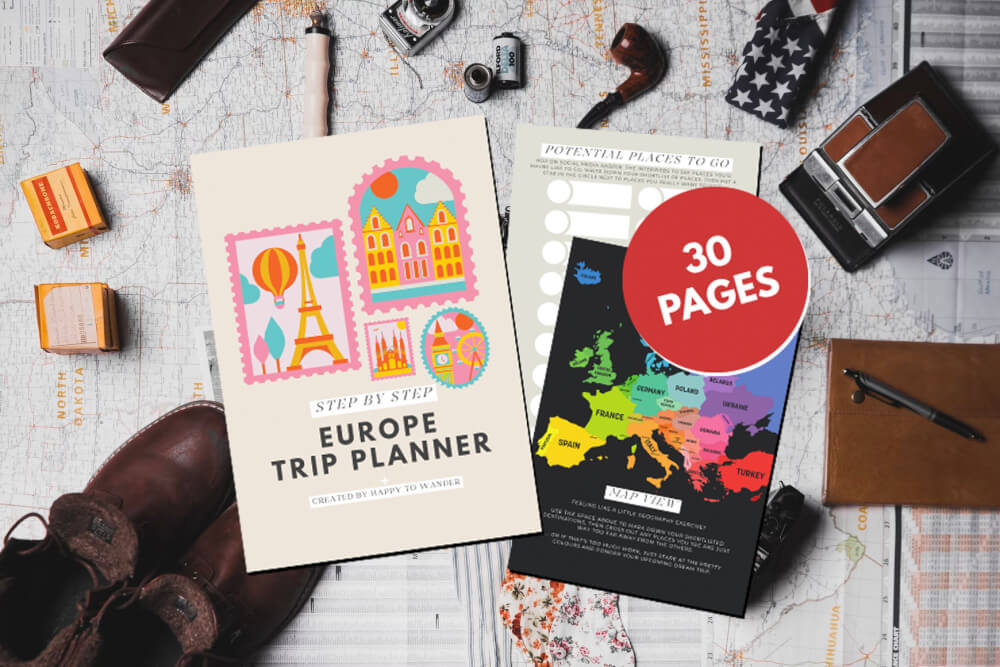
Avoid peak travel times
If you have the luxury of flexibility, I’d avoid visiting Europe between mid-June to the end of August.
Simply put, this is when prices and crowds are at their highest, and (depending on where you go) temperatures during this season can reach a point of salty, sweaty discomfort.
Instead, consider going in the Spring , Fall or Winter!
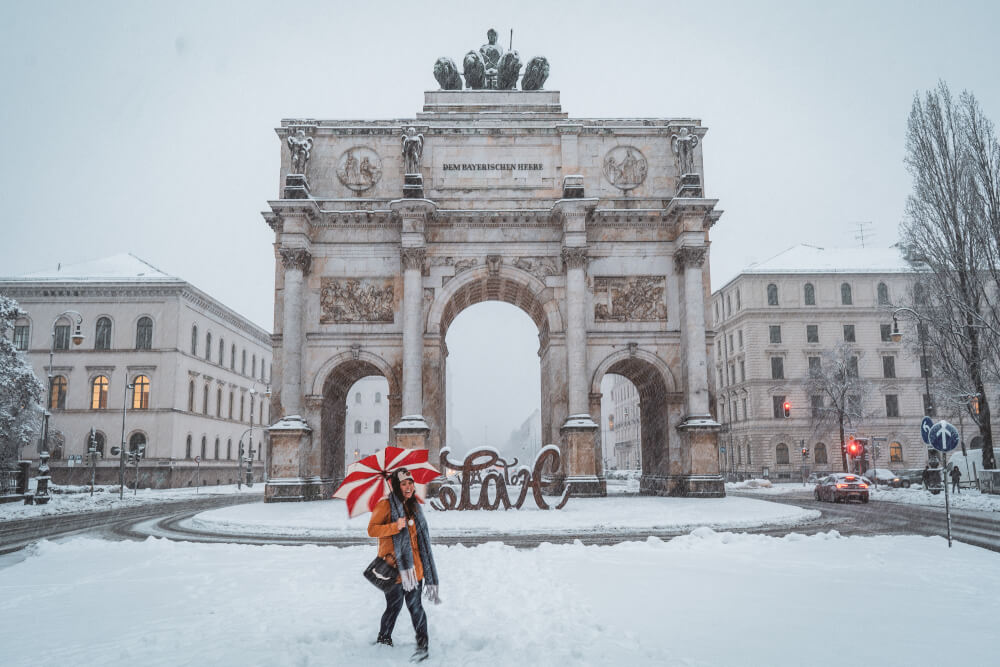
Avoid European holidays
In addition to avoiding North American holiday periods, be sure to also consider popular European school holidays too.
Generally, speaking longer European school holidays will take place during Easter/Christmas, a very popular time for European families to travel around the continent too.
Yes, Europeans can be avid tourists too. Don’t forget that!
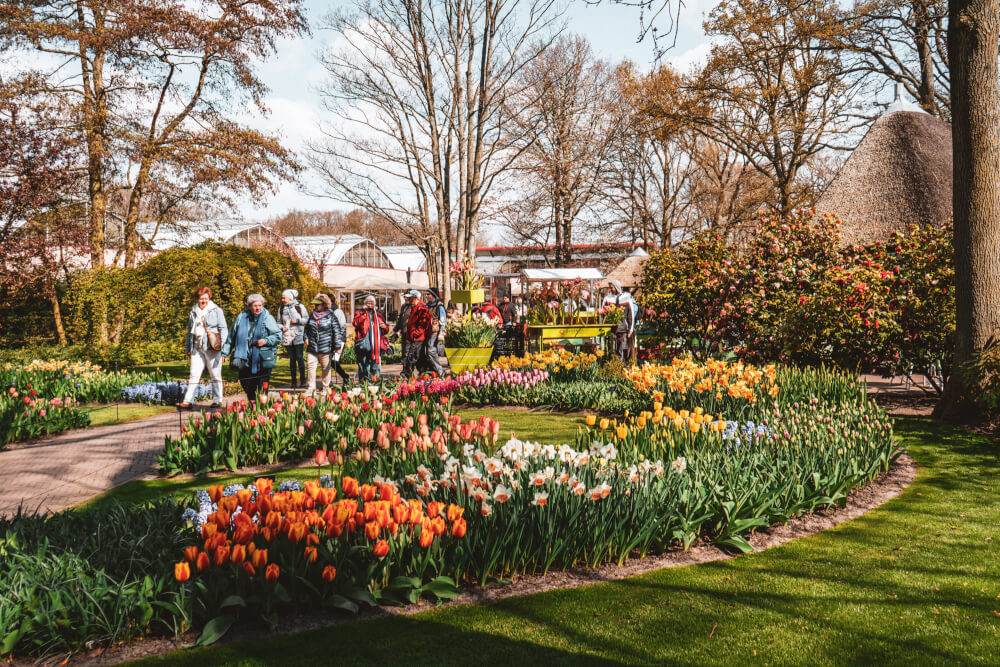
Go for Christmas markets!
Okay, this may be a direct contradiction to what I said above, but one exception I’d make for “peak season travel” in Europe is going to Christmas markets.
This is one of the most magical times to visit Europe, and if you plan your visit for earlier in the season (late November, rather than close to Christmas), you’ll usually be able to avoid the bulk of the crowds.
Here are my top must-knows for visiting Christmas markets in Europe if you want to learn more.

Consider getting a travel credit card
I’m going to level with you: no matter how you plan it, even if you stay in hostels and subsist solely on hummus and bread scraps, you will end up spending a lot of money on your Europe trip.
… so you might as well try to reap as many rewards from it as possible!
Getting a travel rewards credit card before booking all your hotels and flights is one of my favourite underrated Europe travel tips.
There’s a million options out there, so I’ll leave the research/choice up to you, but just make sure you’re booking everything on a card that maximizes the amount of benefits you get.
For me personally, I have the Amex Platinum , which yes has a really high fee but at least for the first year it’s super worth it because you get travel credits, travel insurance, lounge access, and most importantly, enough bonus sign-up points to get you a roundtrip flight to Europe from North America! It’s not for everyone, but definitely worth looking into.
Bonus sneaky point hoarding tip: Travelling with friends? Especially if they don’t collect points of their own, offer to book for everyone, then have them pay you back. Whee – free points without needing to spend all the money!

Get a Wise card
If you’re not interested in getting a travel credit card, a handy and free alternative I can highly recommend is a Wise card.
Having a Wise card allows you to “send and spend money around the world at the real exchange rate”, avoiding hidden fees in the process.
It is SO handy for travel, because you can use it for over 150 currencies around the world, and you even get 2 free ATM withdrawals per month with it overseas.
And because your card is linked to your Wise account, you can simply load it up with a minimal amount of money so you don’t have to risk your normal credit/debit cards while walking around.
You can use my referral link here to transfer your first $500 fee-free.
NOTE: I’ve also had a good experience with Revolut when I lived in Germany, but they don’t offer services for Canadians so I can no longer use them.

Focus on one or two countries for shorter trips
Unless you have a lot of time to work with, I would recommend getting to know one or two countries well rather than trying to visit too many countries in one go just for the sake of checking them off your list.
While travelling between European countries can be affordable and quick, hopping around too much can be a sure recipe for burnout and time lost commuting.
Plus, the more you see of one country, the more you’re able to get more off-the-beaten path and find spots you hadn’t heard of before!
Check out my list of 1 week itineraries for Europe if you need inspiration.
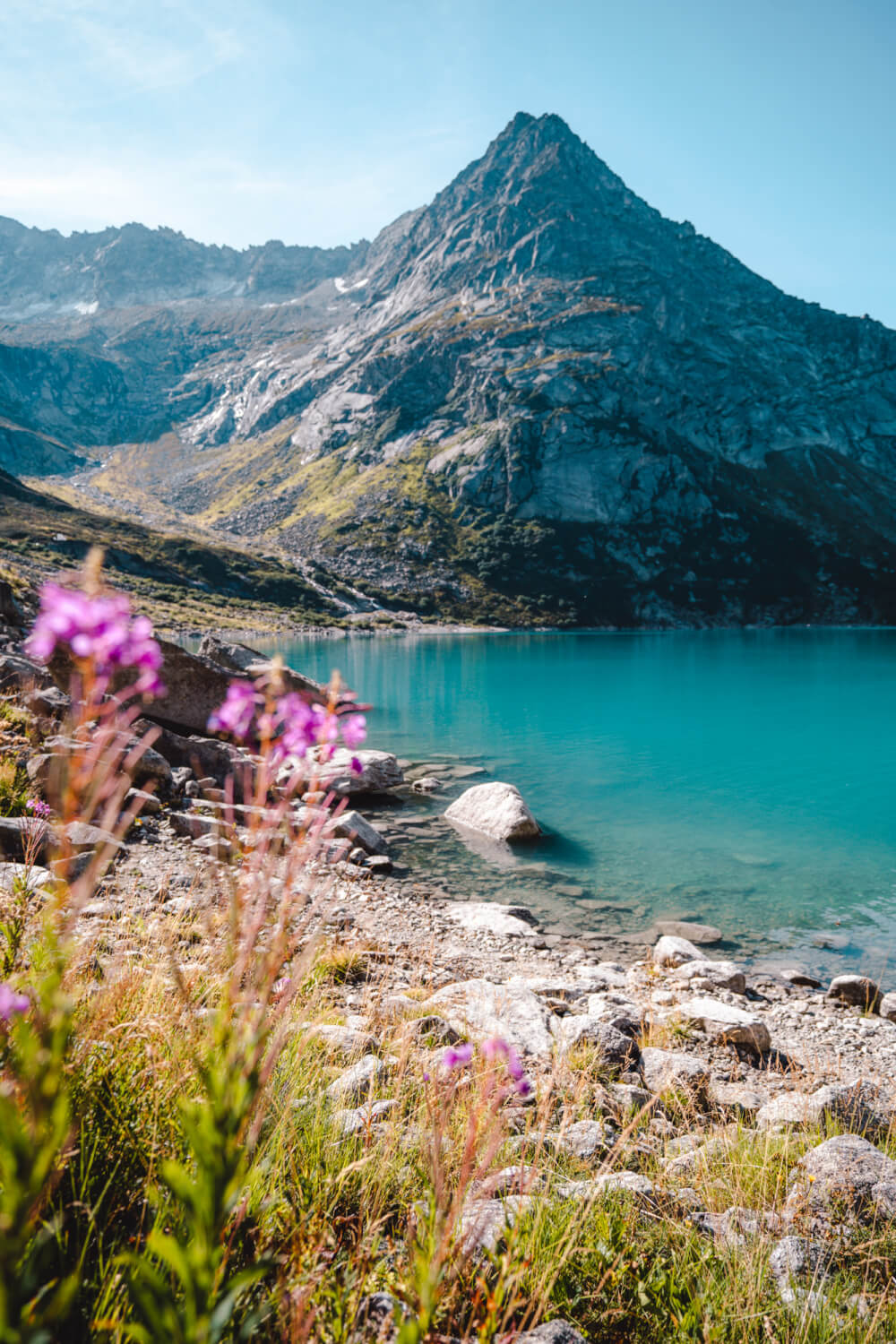
Learn all about the Schengen Area
An important must-know for all first time visitors to Europe is that border-free travel doesn’t exist across the continent (as is commonly believed).
Rather, border-free travel apples only between countries in the Schengen Area, this group of 27 countries (accurate as of 2023):
- Liechtenstein
- The Netherlands
- Switzerland
When crossing borders outside of these countries, you will need to clear passport control as normal.
Understanding this distinction will help you plan how long you can stay in different countries, as well as Europe in general, and give you some insight into logistics like when you’ll need to clear passport control, and which visas you might need for where.
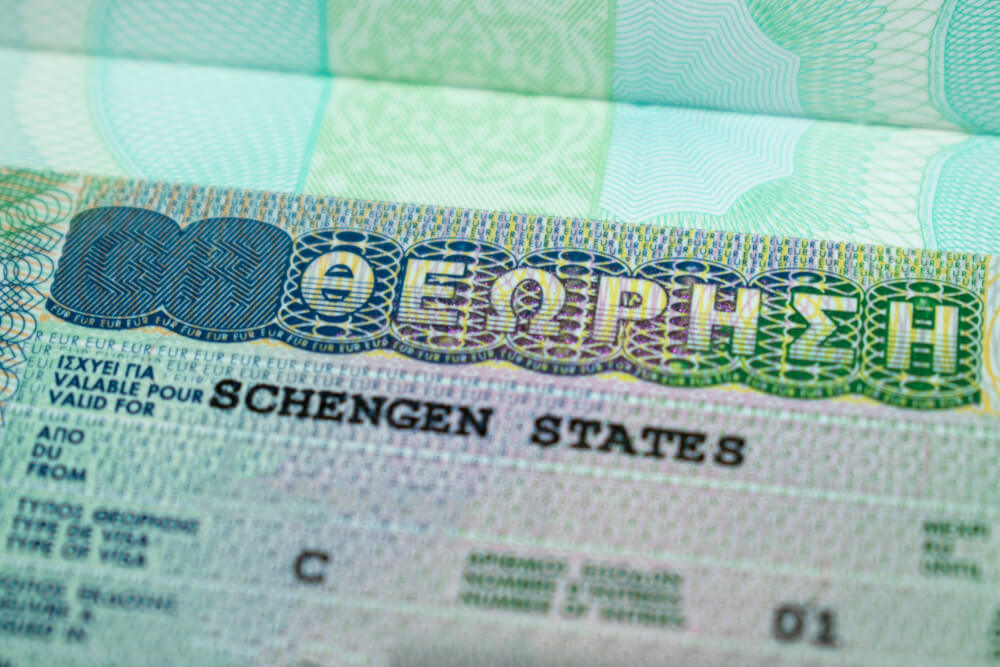
Use your understanding of the Schengen Zone to legally stay in Europe longer
For most tourists, the maximum amount of time you can spend in the Schengen Zone is 90 days out of 180 days .
Simply put, if by the time you leave, you can look back on the past 180 days and say you stayed less than 90 days total, you’re good.
BUT if you want to stay in Europe for longer than that amount of time, you can utilize your Schengen Area understanding to stay longer, simply by including travel to non-Schengen countries.
For example: Let’s say you can only spend 90 days in the Schengen Zone, but you’re allowed to spend 180 total in the UK. You can easily make your European trip longer than 90 days by adding time in the UK, Ireland, Bulgaria, Romania or any other non-Schengen country.

Consider more off-the-beaten path destinations
Another benefit of visiting non-Schengen countries is they’re often lesser visited, and filled with some truly amazing hidden gems.
For example, I’m a HUGE fan of Bulgaria. (Here are some of the coolest things to do in Bulgaria that you probably haven’t heard of.)
While I totally understand the desire to see the most popular and best-known destinations on your trip, sometimes visiting these lesser known spots can bring amazing surprises that end up being the highlight of your vacation!
Of course, there’s a middle ground too – you can easily get the ‘best of both worlds’ by combining a hugely popular destination with some side trips to other lesser known places in the same country. These posts might help with that:
- The Best Places to Visit in England (Besides London)
- The Best Places to Visit in France (Besides Paris)
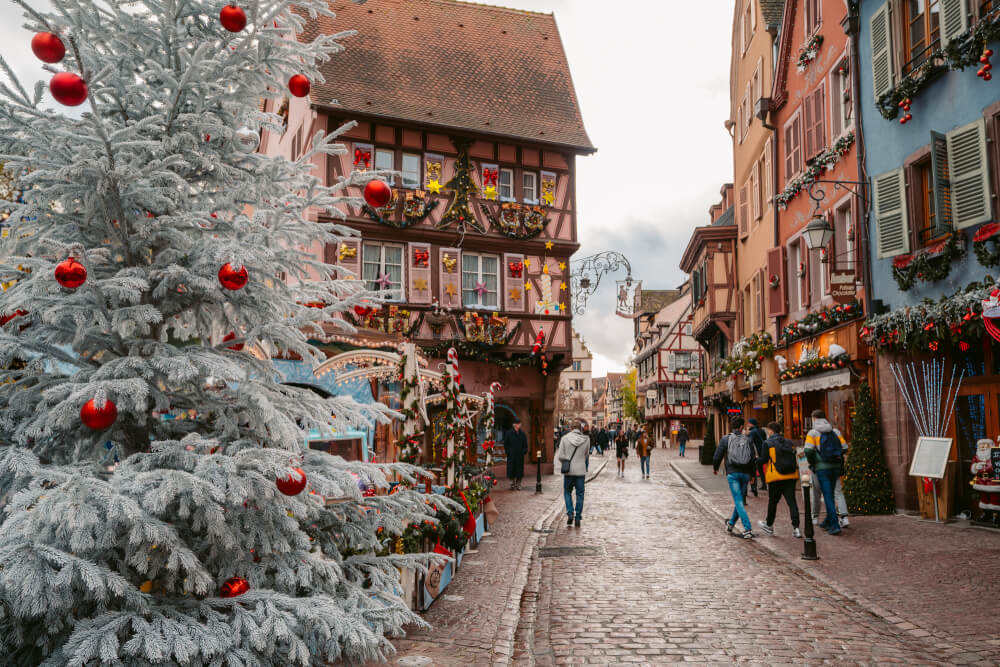
Offset pricey destinations with more budget-friendly ones
If you’re hoping to visit Europe on a budget, but still have some pricier destinations on your bucket list (e.g. Switzerland, Norway, Sweden, Iceland, UK, Germany, etc.), then a great way to cut costs is to round out your itinerary with more affordable stops (e.g. Bulgaria, Romania, Poland, Montenegro, Lithuania, etc.)
This of course makes more sense on longer trips where you’ll be covering a lot of ground, but just remember than some European destinations are MUCH rougher on the budget than others, so mix it up if you’re looking to give your wallet a break.
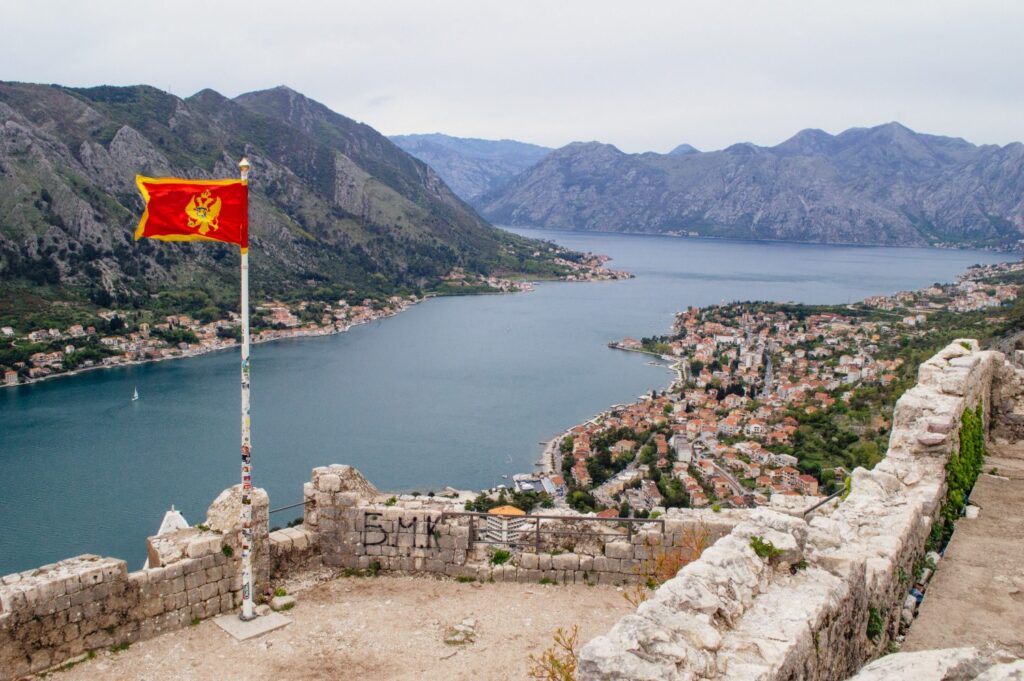
Alternate between busy and chill destinations
On a similar note, you should make sure your Europe trip itinerary also includes a mix of busy and relaxed places.
One of the biggest mistakes I made during my first backpacking trip was I crammed SO many huge cities into my itinerary, one after another.
But when your itinerary is nothing but European heavyweights like Paris, London, Amsterdam, Rome and Florence… yikes, you’ll be sightseeing your eyeballs off daily with zero chance for breaks.
So, here’s a very important Europe travel tip when planning your itinerary: try to space out the “big” cities with chiller destinations, maybe nature or beach breaks so you have time to rest up before sightseeing like the Energizer bunny once more.

Learn the tricks to getting cheap flights TO Europe
Not sure how to get the best flight deals for your big Europe trip? Be sure to check out my guide on how to get the cheapest flights to Europe .
I promise it’ll save you hundreds of dollars, if not more.

Take advantage of free stopovers
Certain airlines have a free stopover program where you can have a long layover for no extra cost, meaning you get two destinations for the price of one plane ticket!
Here are some Europe-based airlines that offer this:
- IcelandAir: Free stopovers in Reykjavik for 1-7 days
- Iberia: Free stopovers in Madrid for 1-6 nights
- TAP Portugal: Free stopovers in Lisbon and Porto for 1-5 nights

Steal my step by step process for finding the best hotels
If you’re overwhelmed by the prospect of booking all your own places to stay, I have just the resource for you.
Here’s how to find the best accommodation in Europe every time.

Book hotels far in advance
And if you don’t have time to check out my whole step by step process, then here’s the #1 piece of Europe accommodation wisdom I can give you: book your hotels as soon as possible.
In many of Europe’s most popular destinations, good value accommodation books out quickly, so your biggest defense against outrageous prices and poor quality hotels is booking early.
Even if you’re not going in peak season, you never know when an unexpected event (e.g. a big concert, sports game or conference) will send hotel prices soaring, so the sooner you book, the better.
I know that committing to a hotel early can feel scary, but if you use Booking.com , you can find hundreds of hotels that offer free reservations and free cancellations up until a certain point.
I’ll often hop on Booking.com to make a placeholder / “just in case” reservation in the early stages of my planning just to ensure I have a Plan B in case prices skyrocket.
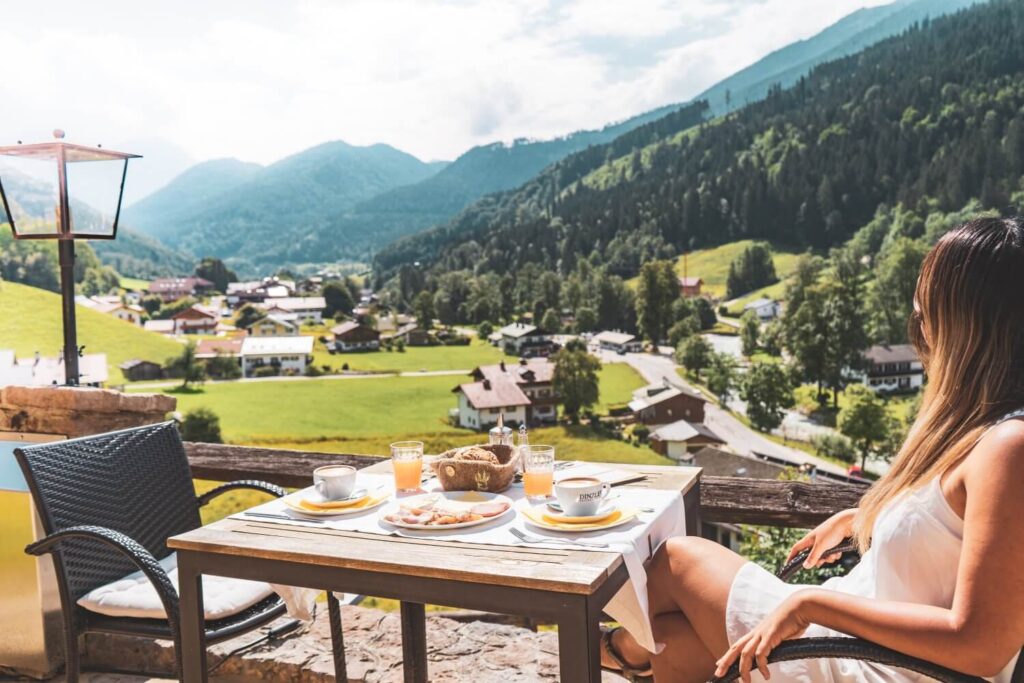
The European hotel star system is different to North America
I grew up with a North American hotel system where 5* meant opulent luxury and 1* meant run for the hills, unless you want to lose your kidneys.
The star ratings in Europe are a bit different. Instead of stars coinciding to quality on a scale of 1-5, the stars actually correspond to a checklist of amenities/requirements.
SO, you can get some amazing 2* properties that are simply smaller and don’t really have things like a spa or pool, while also finding crappy 4 or 5* properties that have that rating just because they’re big and have amenities like fitness centers and valets (i.e. many chains).
Learn more about the criteria for star ratings here.

Avoid airport hotels unless flying in or out
Tempted by a cheap hotel deal near the airport? Run.
Unless you are flying into your destination late and need a place to crash or are flying out early in the morning, do NOT book a stay at any airport hotels.
With Europe travel, you want to ideally be close to the sights or at least in a scenic neighbourhood, not next to a motorway. Adding in the time and cost of commuting to/from the city centre, it’s rarely worth it so keep that in mind the next time you’re tempted by the siren’s call of an airport Ibis.
Learn the options for free accommodation in Europe
Hoping to find places to stay for free in Europe? There are indeed options for that!
Here are a few ways you can potentially find accommodation for free:
- Couchsurfing: Crashing with someone within a community of travellers where people offer to host each other in their homes free of charge
- House Swap: Trading homes with someone (like in The Holiday). Many sites facilitate these exchanges, including HomeExchange and Kindred
- House and Pet Sitting: Looking after someone’s house/pets in exchange for free accommodation. One of the most popular platforms for this is Trusted Housesitters
- Workaway: Volunteering your time/services in exchange for accommodation
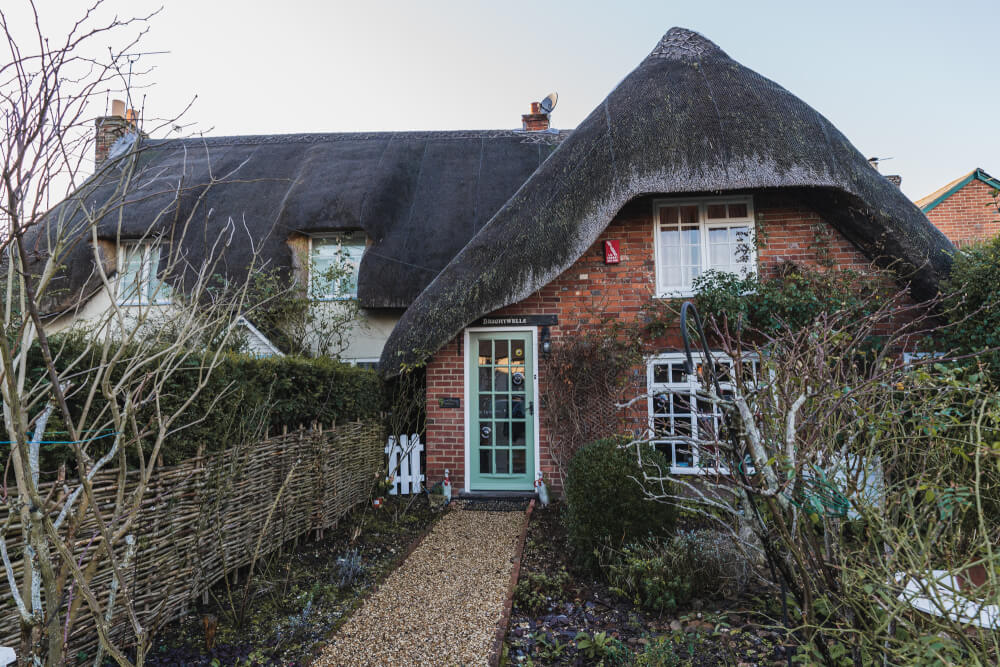
Don’t forget travel insurance
I personally believe that travel insurance is a must for every trip. Trust me, the peace of mind is worth the cost!
Click here to check rates with WorldNomads.

Make sure you’ll have Internet access
This tip goes without saying, but if you’re old school and prefer to travel without Internet, don’t.
Really, as romantic as it is to disconnect during your travels, having an Internet plan for your phone is crucial. It allows you to navigate with Google Maps, use translation apps, do research on the go, etc.
Without it, your trip will be infinitely harder. No joke – some places these days even require you to have data to scan menus!
Luckily, roaming within the EU is free, and it’s wayyyy cheaper than what we have in Canada.

Download helpful apps before you go
On that note, once you have a data plan set up, you can take advantage of all the helpful apps for Europe travel available.
Some of my favourites include…
- Omio : Great for comparing and booking transport options (including buses, trains, and flights) from Point A to Point B.
- Google Translate : A must for translating signs and menus if you are in a country where English isn’t the main language
- Splitwise : Helpful for tracking expenses split between friends, great for minimizing awkwardness when dealing with trip finances
- Too Good to Go : Perfect for buying discounted meals at the end of the day to save food from going to waste

Download TripIt to keep track of all your travel bookings
Speaking of helpful Europe travel apps, another one I can recommend is TripIt.
This app works like magic to organize your hotel bookings, flights, tickets and all in one place… the best thing is, it does it automatically through scanning your inbox for confirmation emails.
If you’re planning a long trip with multiple stops, hotels, modes of transport, etc. to worry about, then TripIt is a great tool for organizing everything in one neat place.

Ensure you have proof of onward travel
“Proof of onward travel” is a very important consideration that many first-time travellers forget about.
In sum, it’s proof that you’re leaving your destination before your visa or allowance expires.
Usually this proof is provided in the form of a ticket back home, or a ticket elsewhere to prove that you’ll be leaving at some point.
A lot of people dismiss this requirement as a myth, but trust me: it’s not.
I was once almost barred from boarding a flight to Germany because my return flight was after the 90 day Schengen Zone allowance, and I didn’t have proof I would be leaving the Schengen Zone before the 90 days was over. I intended to spend some time out of the Schengen Zone to ensure I never overstayed, but they demanded proof… so yes, they do check!
Want to learn more? I have a full article if you want to read more about proof of onward travel and my experience lawyer-ing myself out of that (very awkward) situation.
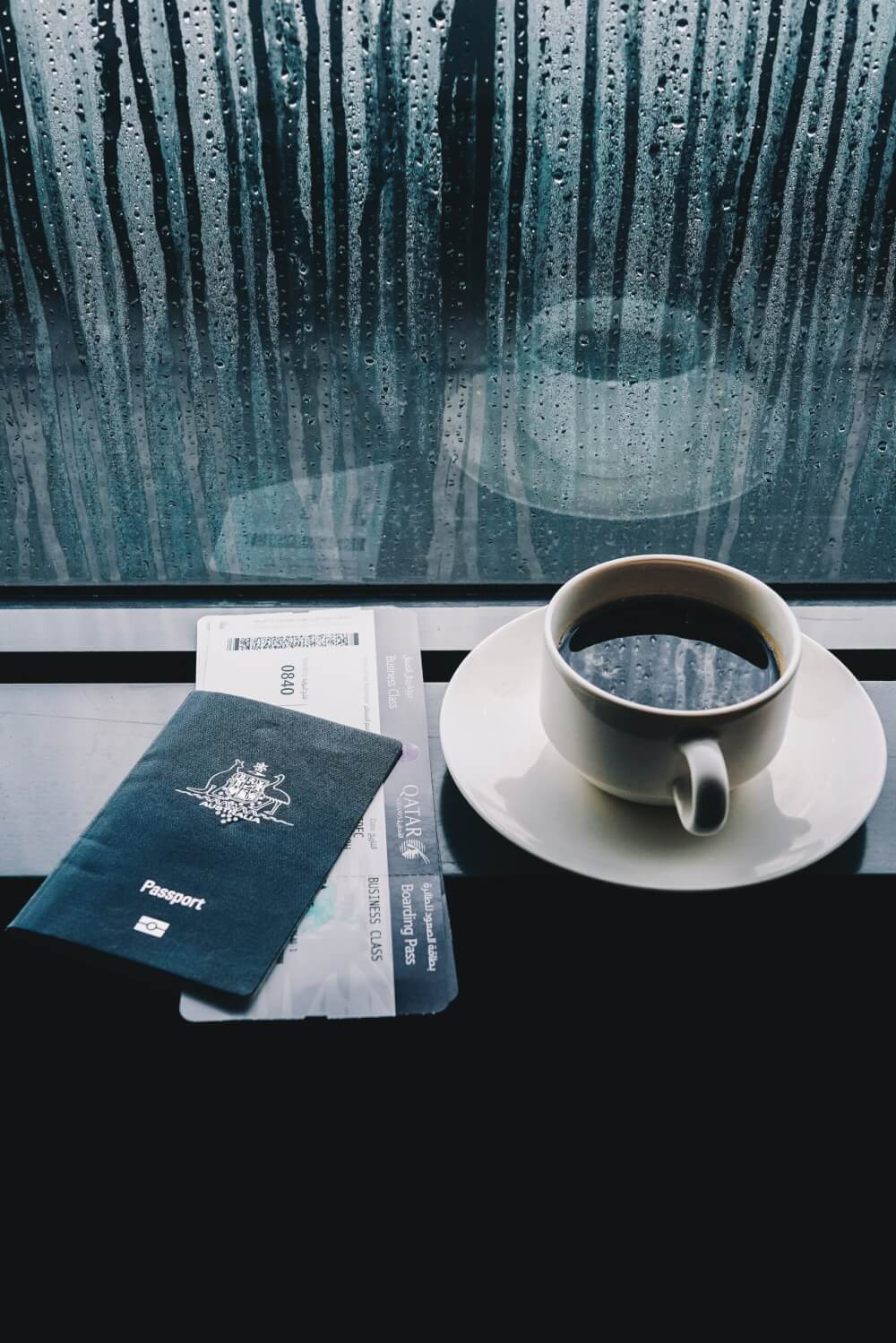
Steal my pre-made itineraries
Lastly Europe travel planning tip: I know that making itineraries can be exhausting, but luckily there are Type A laptop gremlins like me who adore doing it.
So, here are some itineraries for you to steal in case you need them:
- My 1.5 month Western Europe backpacking itinerary
- My 40+ one week in Europe itineraries
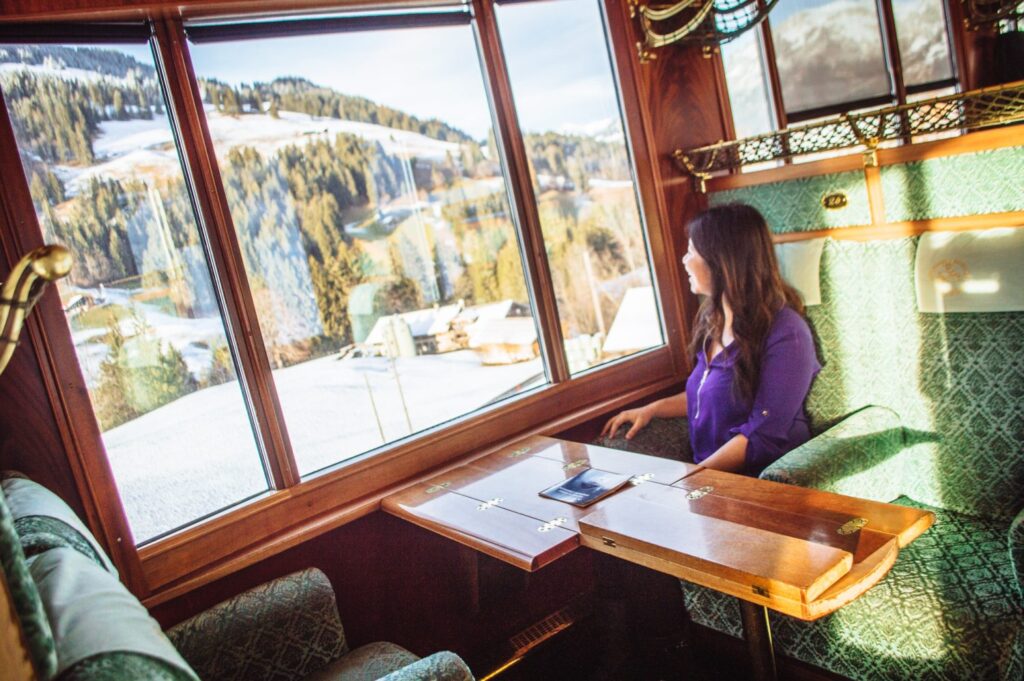
Europe Travel Tips for Transport & Getting Around
Getting around Europe can be really daunting for a first-time visitor, so here are all my best Europe tips related to transport and getting from one place to another.
Public transport is abundant and amazing
Don’t be afraid of using it!
I’m always shocked when I hear travellers who think that they’ll need to rent a car for their Europe trip.
Oftentimes, you really won’t need to, especially if you’re mainly visiting big cities.
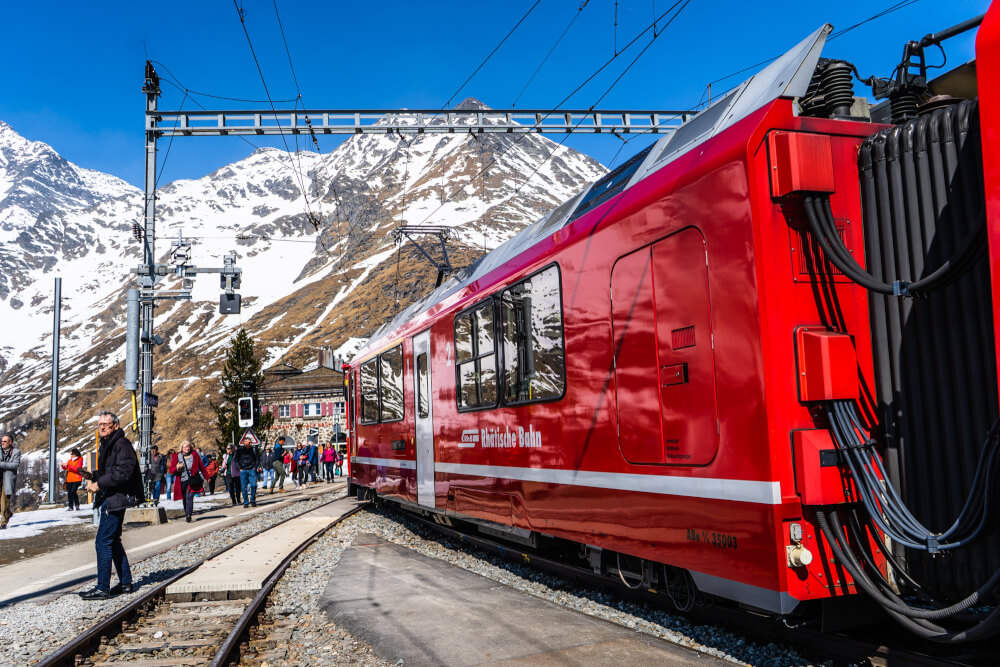
On that note…
Avoid renting a car
Unless you are doing a trip that focuses heavily on natural sights or smaller remote villages, odds are you won’t need a car.
Public transport (as I mentioned above) is a solid option, and involves a fraction of the stress often unleashed by car rentals.
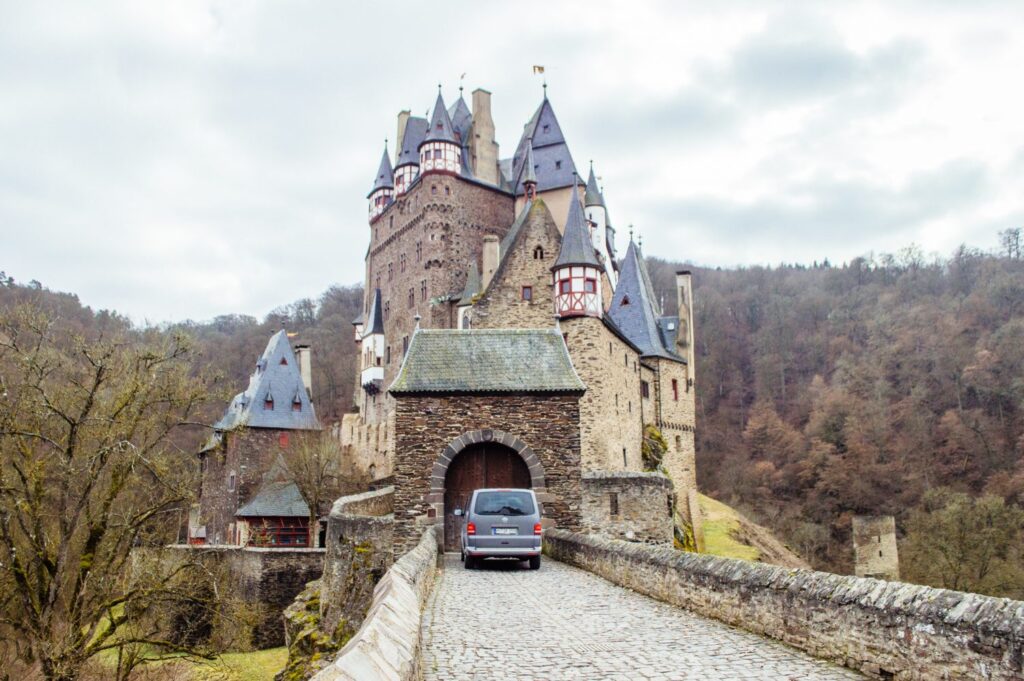
… But beware of hidden costs if you do rent a car
When it comes to car rentals in Europe, often the first price you see isn’t indicative of what you’ll have to pay in the end.
Some hidden/additional costs might include…
- Age or nationality based surcharges
- Additional driver fees
- Multiple country fees
- Extra miles
- Extra insurance
- One way fees
- Tolls/vignettes
So if you still want to rent a car, here is a post to help you figure out how much renting a car in Europe really costs .
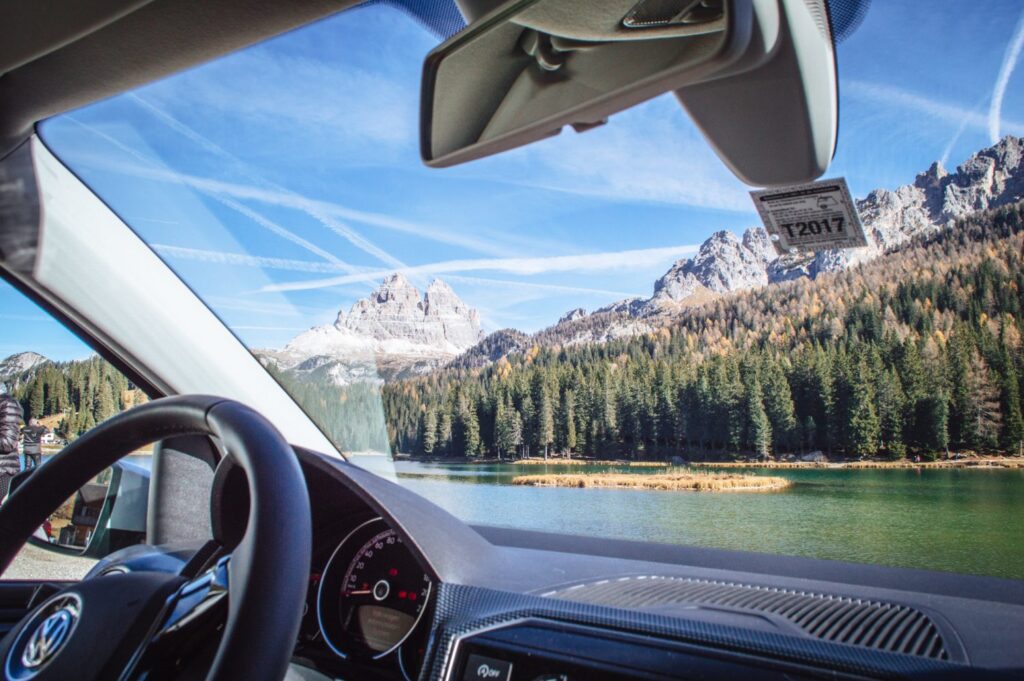
Renting a car? You might need a vignette
One of the pains of car rentals is the additional fees. In many European countries, you need to pay for a vignette (a sticker you put on your car) to use their motorways.
In Switzerland for instance, this costs 40 francs… and yes, you need to make sure you have the vignette BEFORE you drive into the country, as there are automatic scanners at the border that can pick up your details and send you a ticket later (which we learned the hard way).

Do a lot of research before committing to a Eurail pass
Many first time visitors to Europe think of a rail pass as the cheapest option, but very often, booking your train tickets in advance will work out to be cheaper than a Eurail pass, especially if you aren’t taking that many trains and don’t need full flexibility (i.e. you are okay to book the trains advance).
Eurail passes can be great value, but not always. If you need help figuring out whether they’d make sense for you, read my full Eurail review for more details.
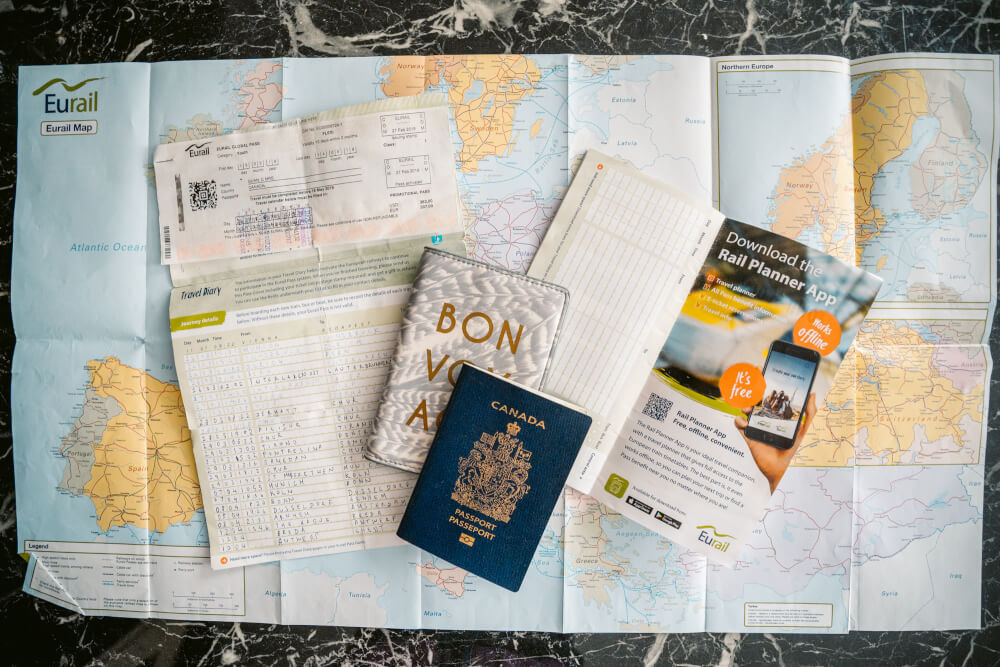
Look into scenic European train rides
I’ve already made my allegiance to European public transport pretty clear, but one of the main reasons is simply how beautiful it can be.
Sure, trains aren’t always the cheapest way to to travel Europe , but they’re often the most scenic and beautiful.
So if you’re into the idea of travel as an experience, then be sure to read my post on the best scenic train rides in Europe , and the best scenic train rides in Switzerland .
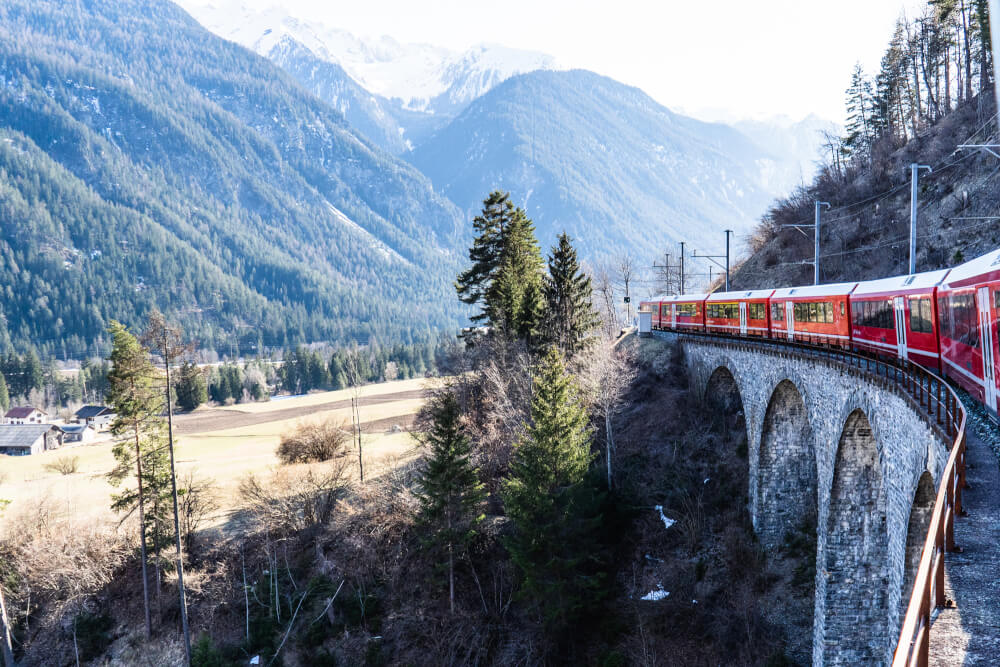
Familiarize yourself with Europe’s most famous budget airlines
One of the cheapest ways to get around Europe is hopping around on budget airlines… where sometimes an international flight is cheaper than a 6 pack of nuggets.
Of course, the epic prices come with their own set of drawbacks, usually in terms of the flight experience, customer support, and additional add-ons (which always come at an extra fee).
You can learn more specifics about Europe’s top budget airlines through my reviews here:
- Honest RyanAir Review
- Honest easyJet Review
- Honest WizzAir Review

Consider bus/coach travel if you’re on a budget
In addition to planes and trains, Europe is very well connected by an extensive bus (AKA coach) network.
One of the main contenders in this space is Flixbus, but depending on the country you’re visiting, there’s often local companies offering affordable bus travel between cities as well.
Again, I’d recommend using Omio so you can quickly compare buses, trains, and flights at the same time, but just know that bus travel in Europe can be a really cheap, safe, and easy way to get around.
Although there are of course some downisdes as well. You can read my full Flixbus review for more details.

Book an airport transfer for minimal stress
I love navigating Europe with public transport but if you’re travelling with a lot of luggage or as a big group, one of the more cost effective ways might actually be to just book a private transfer or taxi.
Of course, depending on where you go, taxi scams can be a real possibility, so for the least stressful option, consider booking a Welcome Pickups transfer, which is a set price, includes an English speaking driver who monitors your flight arrival time, and offers free cancellations up until 24 hours before.
This saves you the hassle of trying to get a taxi/navigate the language barriers to do so.
… Plus they pick you up with a cute little sign that has your name on it!
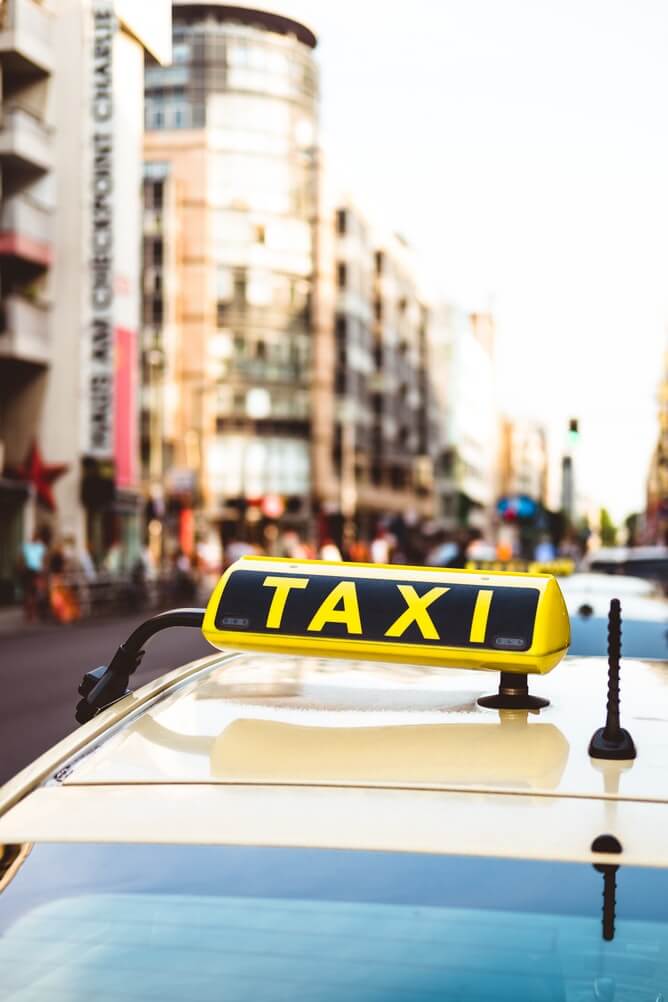
Do research on how trains work in your destination
I have to say, one of the most overwhelming things for me in Europe was getting used to how trains work. I come from West Coast Canada, where passenger rail from city to city is very limited.
SO if you’re new to train travel, it might be helpful to do some research on how the train system works in your destinations, paying attention to particularities like…
- Where to find the right platform for your train
- Where to stand in order to find the right section of your train
- Whether you need to buy and validate tickets before you get on board
Train stations are chaotic and stressful places, so you’ll ideally want to know these main things before you get there, otherwise you may have a lil mental breakdown on-site.
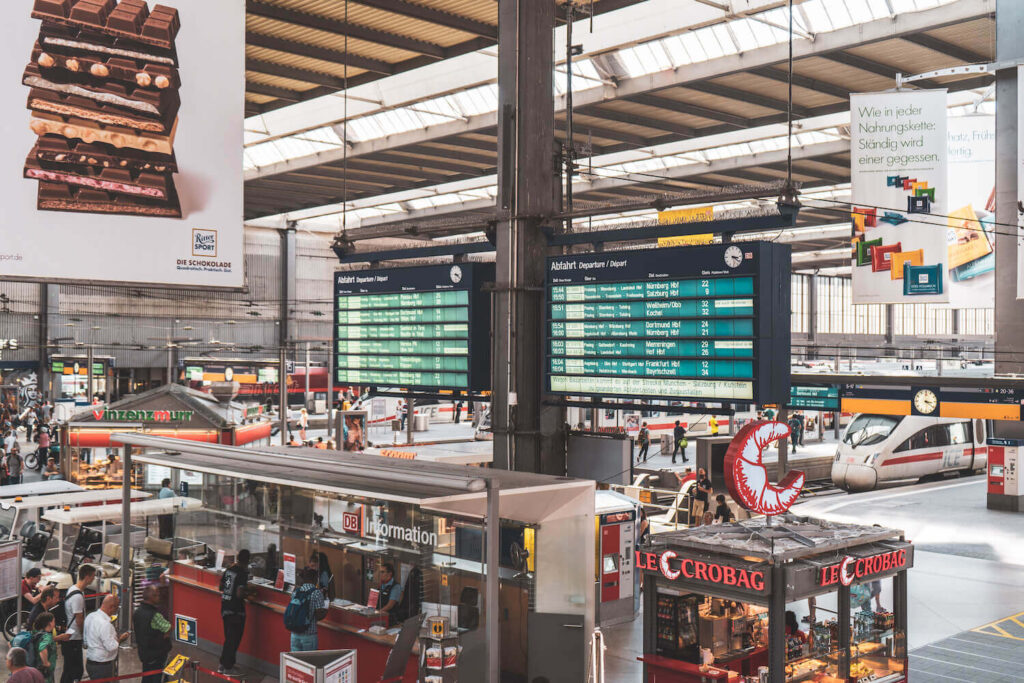
Use train station lockers
If you’re looking for a stress-free way to explore a city for the day, or if you need a place to dump your bags before check-in or after check-out, a convenient solution can often be found at your destination’s train station.
At larger train stations in Europe, there will usually be paid lockers or a ‘left luggage’ office for you to leave your bags for a small fee. Be sure to take advantage of these so you can explore without hauling all your lively possessions with you.
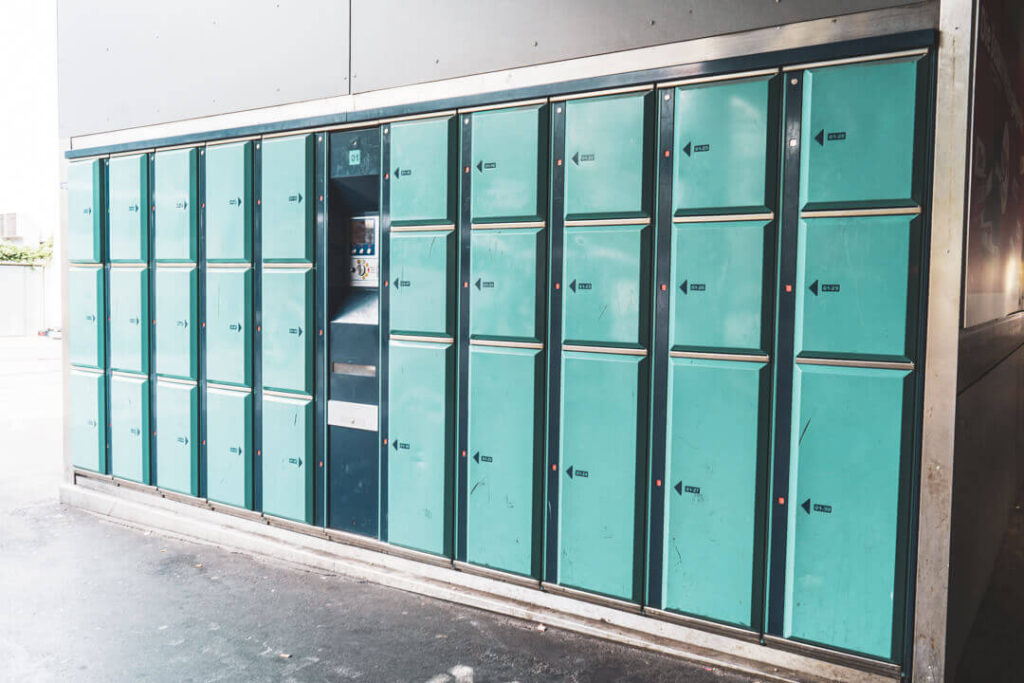
Order taxis or rides through apps whenever possible
Of course, this isn’t possible everywhere, but taxi scams are so widespread in certain European countries that you should definitely use an app when you’re able to.
The most popular ones in Europe include Uber, or FreeNow which is like Uber except you’re ordering an official licensed taxi.
Ordering through an app helps ensure you get a fair rate, and is also (in most cases) more convenient than waiting at a taxi stand or trying to wave one down in the street.
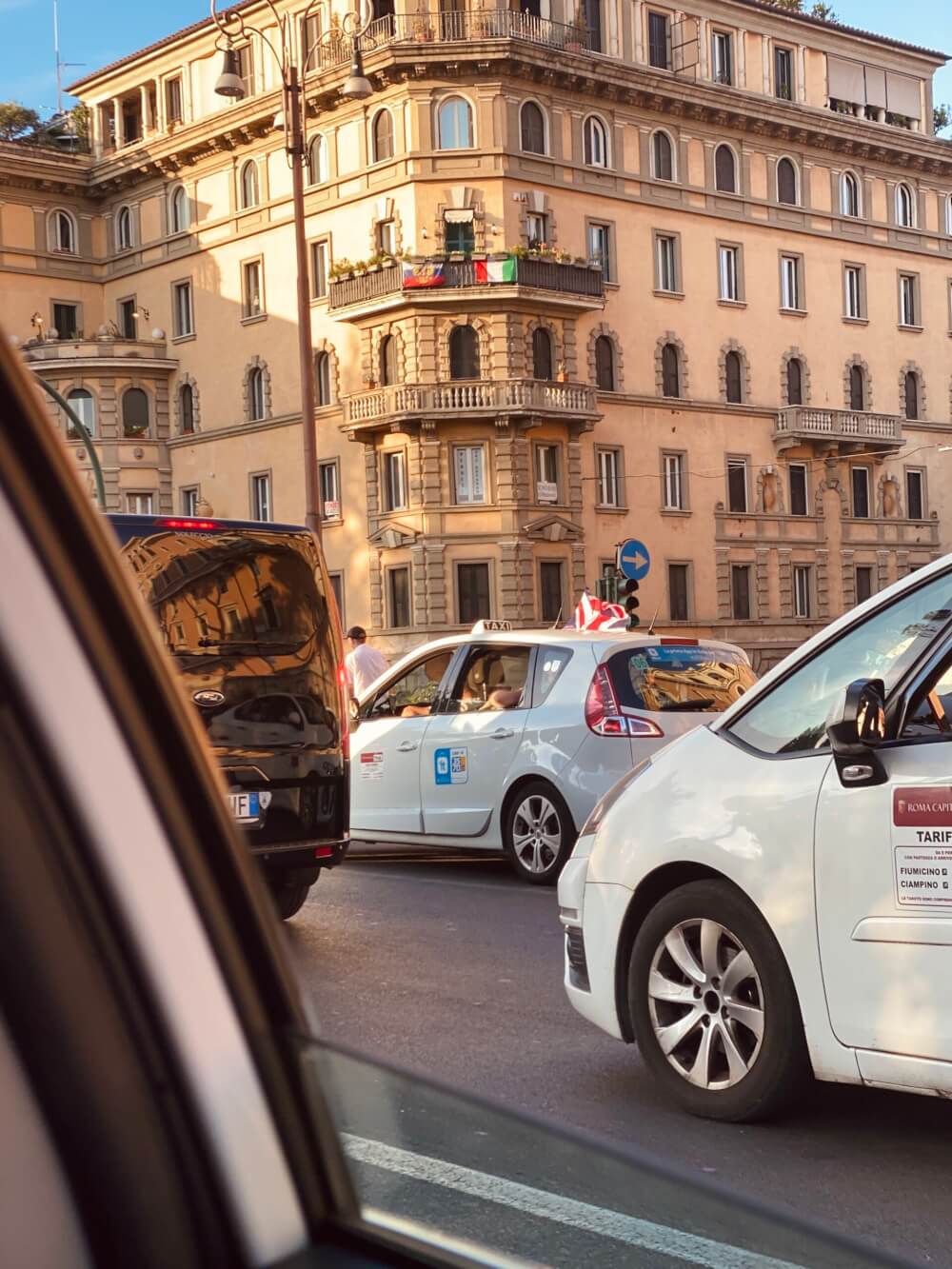
Always look for deals with public transport
If you’re relying on public transportation to get around during your trip (which I highly recommend), then doing a bit of research on ticket types and discounts can really save you a lot of money.
Most major European cities offer some kind of discount for day tickets, group tickets, or multiple trip bundles, so be sure to look into those rather than buying single tickets every time.
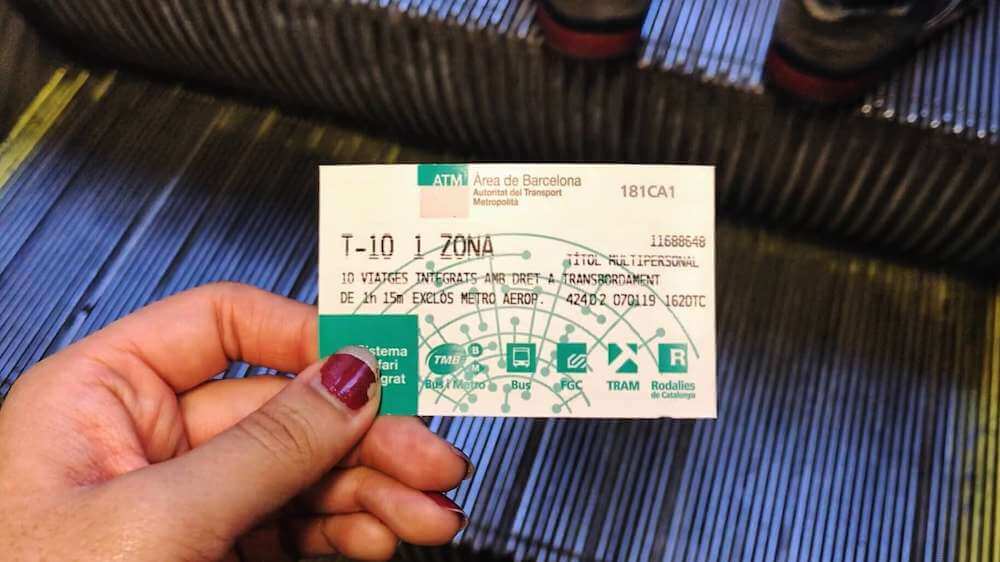
Always validate and hold onto your ticket
When it comes to navigating public transportation in Europe, most times it’s not enough to simply buy a ticket – you must usually a) validate it properly and b) keep it on you in case of inspection.
Who’s checking you ask? Well, most major European cities have random ticket controllers who periodically go around to make sure you’ve paid for and validated your fare correctly.
Sometimes (like in Paris) they’ll even ask to see your ticket after you’ve left the train platform, so be sure to hold onto your ticket until you’ve left the station.
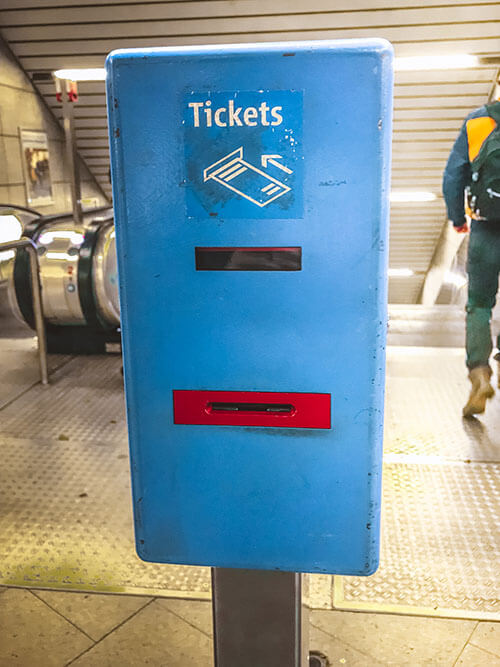
Avoid public transport during rush hour… and during big events like sports games
When you’re a care-free tourist, it can be easy to forget the woes of mundane daily life like trying to get home during rush hour. Well, don’t forget: no matter where you go, they have a rush hour too, so be sure to avoid it whenever possible.
Ideally, you should aim to avoid public transport during times that locals are commuting to/from work. Pay special attention as well to big events like huge concerts or sport games, which can also make public transport a nightmare.

Easily rent bikes or scooters
Most major European cities now have e-bikes and e-scooters that you can easily rent on-the-go through an app. This can be a fun way to quickly and cheaply get around the city.
Options will depend on your destination, but keep an eye out upon arrival! If they are available, odds are you will see them everywhere.

Europe Tips for Attractions
Odds are, if you’re visiting Europe, your plans involve a lot of sightseeing. So, here are some of my best Europe travel tips related to attractions and itinerary planning.
Prepare yourself for scaffolding and restorations
Europe is an amazing destination thanks to its history.
… But the flip side of that is that it is old and so are many of its most famous monuments.
So, mentally prepare yourself for the possibility that the amazing church or landmark you’ve seen a million times on social media is covered in scaffolding, or doesn’t look as you hoped due to restorations.
For example, the first time I went to Rome, I was devastated to see the Trevi Fountain completely covered with scaffolding, and drained of water.
And most travelers have similar stories. There’s no way around it, but just keep in mind that it’s possible!
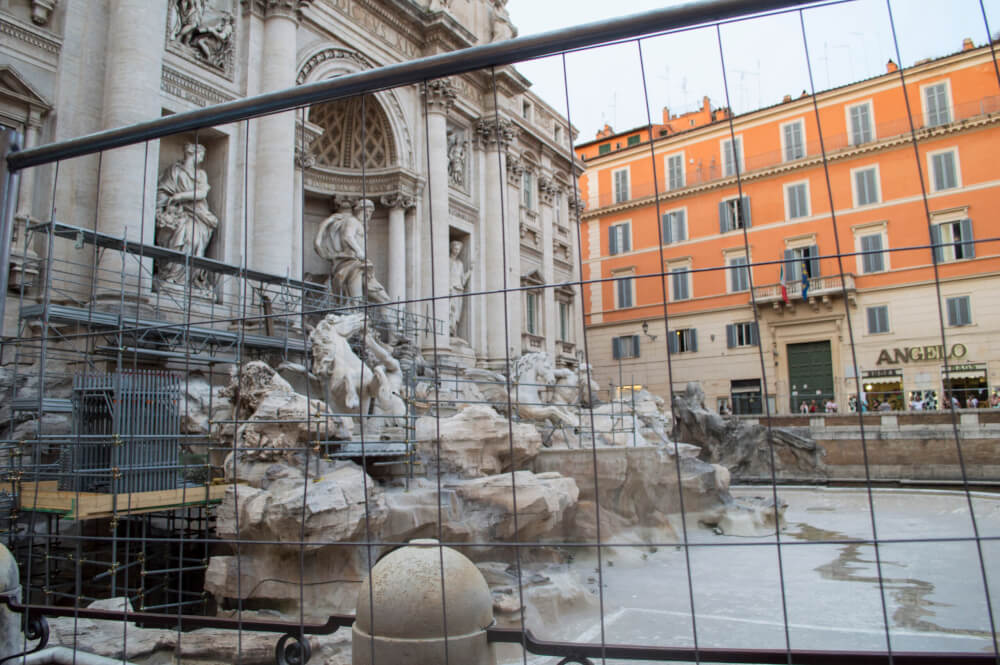
Look into age-based discounts
Oftentimes, whether you’re looking at train tickets or attraction tickets, there will be enticing discounts available based on your age, so be sure to look into those for additional savings, especially if you’re considered a child, youth (often this goes up to age 27!) or senior.
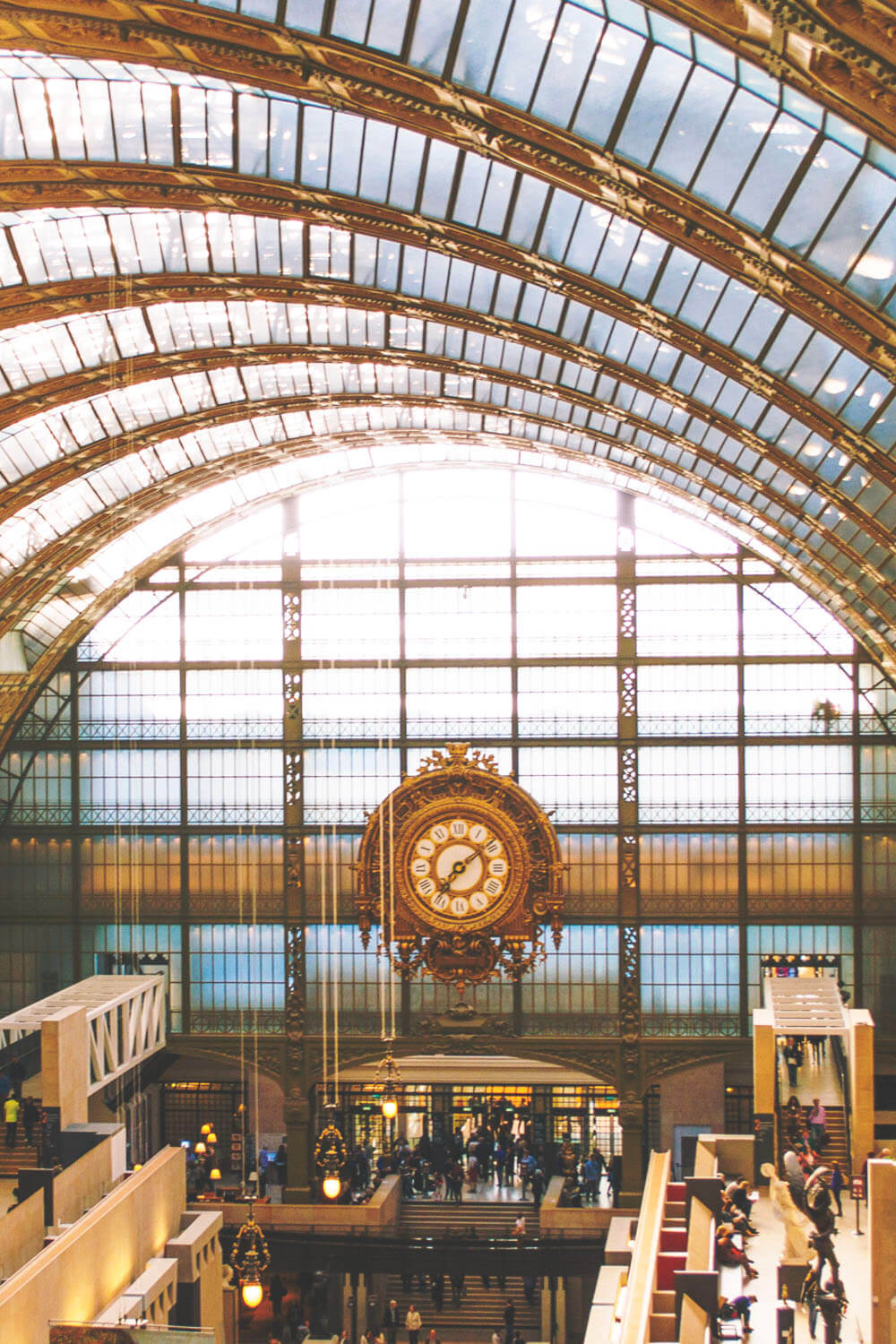
Get an ISIC Card if you’re a student
Here’s a very important Europe travel tip for students: if you are a student, the good news is you’re eligible for a wealth of additional discounts and offers.
The bad news is, often European institutions won’t recognize or accept student IDs from abroad, since they’re all so different.
An easy way to get around this though is by getting an ISIC Card , which is an internationally recognized student ID that costs about twenty dollars, but will save you at least that much in discounts.
I’d recommend getting one if you plan to travel around Europe for a longer time.

On a budget? Prioritize free museums and sights
This is one of my top Europe backpacking tips – do not sleep on the many free things to see and do in Europe.
Everywhere you go in Europe, there will be free things to do and see, ranging from free museums to beautiful architecture and street art.
So, be sure to research beforehand and see what free things there are to do at your destination.
NOTE: A lot of museums across Europe offer free admission on particular days of the month. Take advantage of these offers!
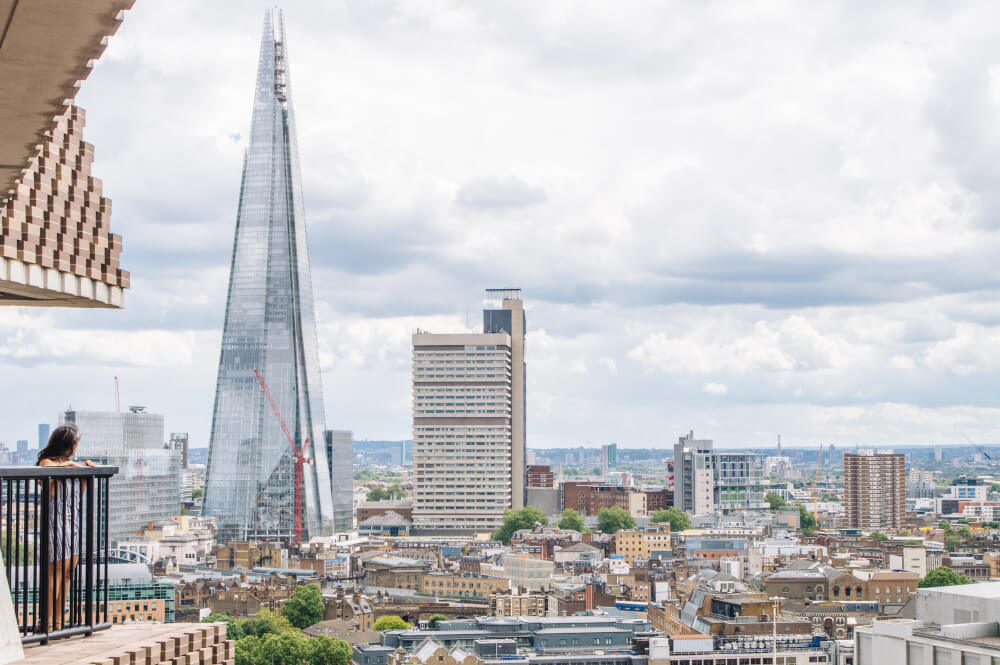
Book tickets for attractions in advance whenever possible
This is usually cheaper, and can save you a lot of time on the day of your visit because at major attractions, there’s usually a separate line for people who already have tickets.

Skip the line tickets are usually worth it
If you’re visiting a busy destination, then I’d highly recommend looking into Skip the Line tickets for major attractions, which will allow you to get in quicker.
Remember, during your trip, time is money, so paying a bit extra to skip the line is definitely a good use of funds.

Visit attractions shortly before closing time
While most guides advise that you visit the main sights early, another sneaky hack that works quite well is visiting right before it closes.
I did this once with the Vatican Museums, entering about 1.5 hours before closing time and it I practically had the place all to myself!
In contrast, one time I did an early morning tour of the Vatican and it was already quite busy because other tour groups were starting at the same time.

Book special tours that are before or after public opening hours
Many busier destinations will offer this now, and it’s a magical way to experience the top sights with a fraction of the crowds.
I once did a sunrise tour around Venice and it was incredible to see all the main sights and feel like I had them mainly to myself.
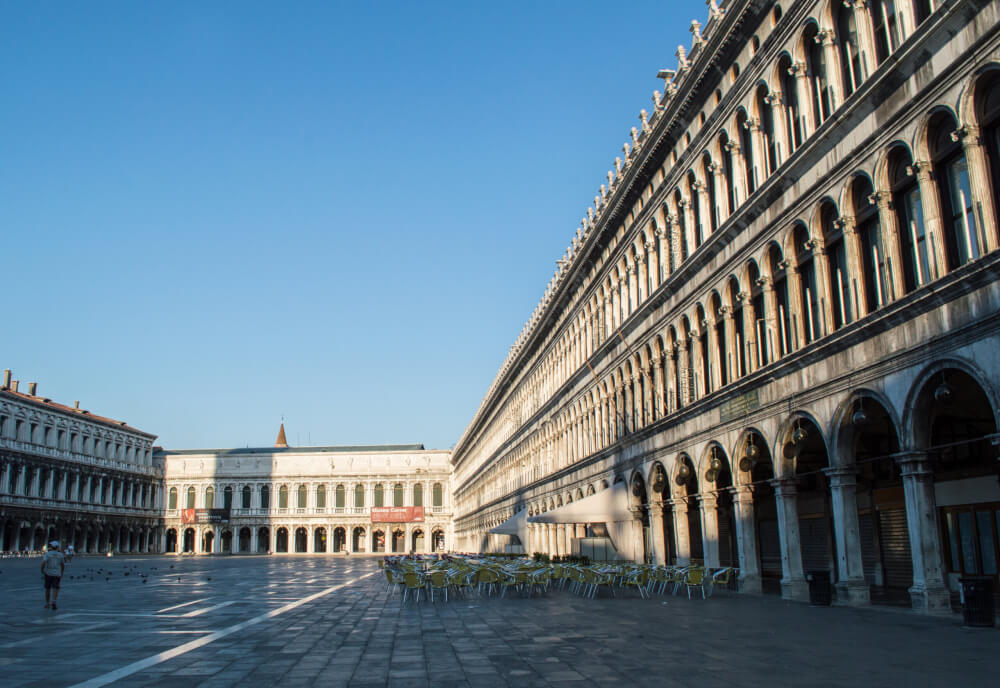
Seek out fun and unique tours in general
Gone are the days that destinations offer just your old standard tours that cover everything generally.
These days, in most major European destinations, there are special tours you can book based on interest, with tours focusing on everything from history and food to street art and photography.
I usually like to have a quick search on GetYourGuide to see what’s available.

For touristy cities, research on local blogs
In big cities like Paris or London, sure there’s a lot of tourists, but there are even more locals, who live there and call it home.
This means there’s a whole other side to the city that many tourists miss out on, from cool pop-ups and restaurants to special cultural events. I always try to look up fun events/updates on local blogs before every trip, and have gotten some really fun travel memories out of it.
You might find my guide on How to Find Cool Stuff to Do Near You helpful.

Seek alternate viewpoints to main landmarks
If you ever find yourself in a place wanting to get THE photo of a major landmark (e.g. the Eiffel Tower in Paris, the Coliseum in Rome, etc.) then a great way to get an amazing photo away from the crowds is by seeking out alternative angles and perspectives.
Remember, landmarks are big, so odds are you can find some cool places to get your photos without having to cram with everyone else. Simply walk a few blocks away and try to find unique views!

Always search for information on the official websites of attractions (even in the local language)
These days, hours/entry requirements can change quickly and third party guides (yes, even Google Maps!) may be inaccurate.
So, if you’re trying to find information on how to book tickets or what opening times are, make sure you always go straight to the source rather than other sites or blogs (even mine!)
For example, on my most recent visit to Rome, the Pantheon had changed its policy to be open only for reserved time slots on weekends, which would have been really unlucky because I saw no information about this anywhere else.

Don’t spread yourself too thin
An ideal itinerary should have a mix of sights, experiences & relaxing. Don’t burn out by forcing yourself to see everything. I personally always ensure that there’s a relaxing or chill activity on each day, whether that be a picnic or just a relaxed coffee/cake afternoon.

If you’re not interested, don’t force yourself just because it’s a must do
I think too often, first-time visitors in Europe get caught in this trap of needing to see all THE most famous things, but remember: at the end of the day, this is your vacation, so don’t force yourself to see something just because a random person on the Internet told you to.
I personally love museums but they’re not for everyone, so just remember it’s your vacation and there’s no need to do something just because it’s famous.
… but psst – if you ARE into museums, don’t wait until your trip to go! There are tons of really cool virtual museums you can check out when you’re bored. Pro tip from one hopeless nerd to another.

Safety Tips for Europe (And How to Not Get Scammed!)
Is Europe dangerous to travel? This is one of the most common questions that first-time visitors ask. Honestly, so long as you keep the following Europe safety tips in mind, you will be fine.
Be wary of petty theft and scams when you visit Europe
Certainly in more touristy cities like Paris and Barcelona, opportunistic crime is abundant.
You can learn the most common pickpocket techniques and how to avoid them in my post about how to avoid pickpockets in Europe , but overall, the key is to always be vigilant and keep an eye on your belongings.
Pickpockets thrive on distraction, and tend to operate in high-traffic areas that have a lot of people/tourists (e.g. train stations), so be especially careful to not let anyone get too close.

Look into theft-proof bags and accessories
There are a lot of amazing theft-proof travel accessories out there these days. The bad news is they’re not always the cheapest.
If you’re willing to splurge a bit on something high-quality and designed to thwart pickpockets, here are some options:
- PacSafe’s products are all made to be theft-proof, including their signature backpack here and day bag here
- Secret passport scarves like these are a great way to stash THE most important things in a subtle and discreet way
Research the pickpocket hot zones for your destination
Most major cities have certain areas that are particularly well-known as pickpocket destinations.
In Rome for example, there’s Termini Train Station where I got pickpocketed, and Bus 64 AKA the Pickpocket Express.
Knowing where pickpockets tend to operate can help provide some ease of mind, and help you figure out when to be on guard.

Keep valuables out of sight
Leaving your phone on a terrace table, or your purse hanging on your chair are both easy ways to get your valuables stolen!
Sure, it’s easy to let your guard down when you’re trying to relax, but remember that keeping your valuables out like that can be an easy way for them to get snatched.
Whenever I’m dining anywhere, I always keep my bag between my feet so they’re hard to access, and make sure to not leave my phone out on the table (on my lap, under a big napkin is often a safer bet!)

Don’t take “free stuff”
A very common scam in touristy European places is people will offer you something for free “as a gift”, but then demand you (or one of your travel buddies) pay for it.
Some examples include…
- Friendship bracelets
Generally, they will set up shop in busy, touristy areas, so remember to be especially cautious in these areas.

Don’t sign any petitions
Another common scam is the petition scam, usually run by groups of young women.
They’ll come ask you to sign a petition (often first breaking the ice by asking if you speak English) and then either demand a donation from you, or distract you as someone else picks your pockets.
… So if someone asks you to sign a petition, just ignore and walk away. Better safe than sorry!
Rudeness is the way to get rid of scammers
On that note, if you find yourself in a situation where you are being followed or confronted by one of the aforementioned scammers, the best thing to do is ignore them and walk away.
They can be very persistent, but will give up eventually when you ignore them.
Limit the amount of cash you bring out with you
I always say to plan for ‘worst case scenario’, so another one of my top Europe safety tips is to not bring around more cash than you’d stand to lose.
Once upon a time, my friend was carrying around hundreds of euros in her bag (at the start of her trip) and was pickpocketed in Nice on her very first day! Pickpockets work quickly and unexpectedly, so don’t bring out more than you’d be okay losing.

Store your cards separately
On a similar note, make sure to not carry all your cards in one wallet, so that (in case you are pickpocketed), you have a back-up.
I would recommend keeping one card in your suitcase, or in a separate bag.

Don’t make yourself appear to be a good target for robbery
Sometimes when I’m travelling I’ll see people doing photoshoots posing with their designer shopping bags, completely oblivious to the fact that they’re making themselves targets.
Worse, sometimes they just leave the bags on a bench or on the stairs while they’re occupied on their phone.
If I were to write a “how to get robbed in Europe” article, these are the types of behaviours that would make the list, so make sure you’re not making yourself a clear target, and don’t wear unnecessarily flashy outfits or accessories which might catch a thief’s eye.

Keep your phone out of reach
Phone snatchings are becoming a really common crime, especially in big cities like London, so avoid having your phone haphazardly out, or at least be sure to pay more attention when you do, especially…
- If you’re standing close to doors on public transport
- If you’re walking along a bike lane or road

Be careful of bike lanes
Speaking of bike lanes, here’s another important (physical) Europe safety tip: be mindful of them.
If you’re like me and come from somewhere that they’re not overly common, it’s way too easy to accidentally walk onto them and potentially get yourself run over (or more likely, make yourself an annoyance to a cyclist just trying to get home).
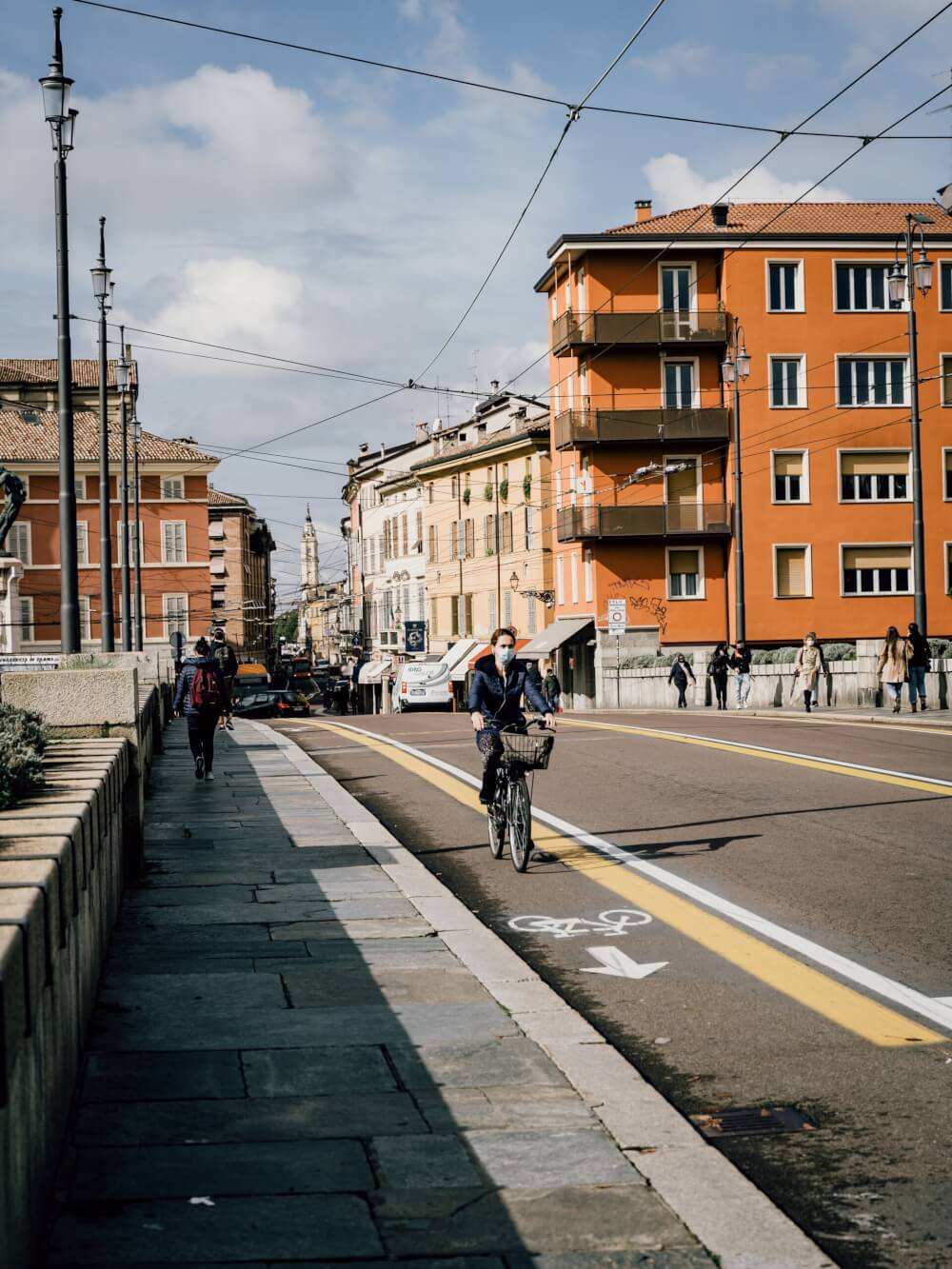
Beware of strangers asking you to go for drinks randomly
This is a scam that’s more prevalent in famous party cities, but if a random person (usually an unreasonably attractive woman) comes up to you off the street and asks you to grab a drink, odds are rather good that they’re not just a friendly local looking to grab drinks with a stranger.
This is a common scam where people (again, usually beautiful women, but not always) will bring targeted tourists into bars they’re working with to get a few drinks, only for these tourists to get charged extortionate rates for these drinks, because you never question how much stuff costs when you’re trying to flirt.
Extreme stories even say that bar staff will block the door until the tourists pay up.
Moral of the story: if it seems too good to be true, it probably is.

And beware of children
A general rule of thumb is this: if a kid is confidently coming up to you and/or getting close unannounced, keep your valuables close and watch your pockets. This is often a distraction tactic used by pickpockets, and sadly some kids are also trained to steal from a young age too.
I almost lost my wallet in Bratislava this way, when a woman asked me to take her photo and her kid started running around me as a distraction.
I realized pretty quickly what was happening and caught my pickpocket literally with her hand in my purse. Luckily, I was able to swat her hand away just in time.
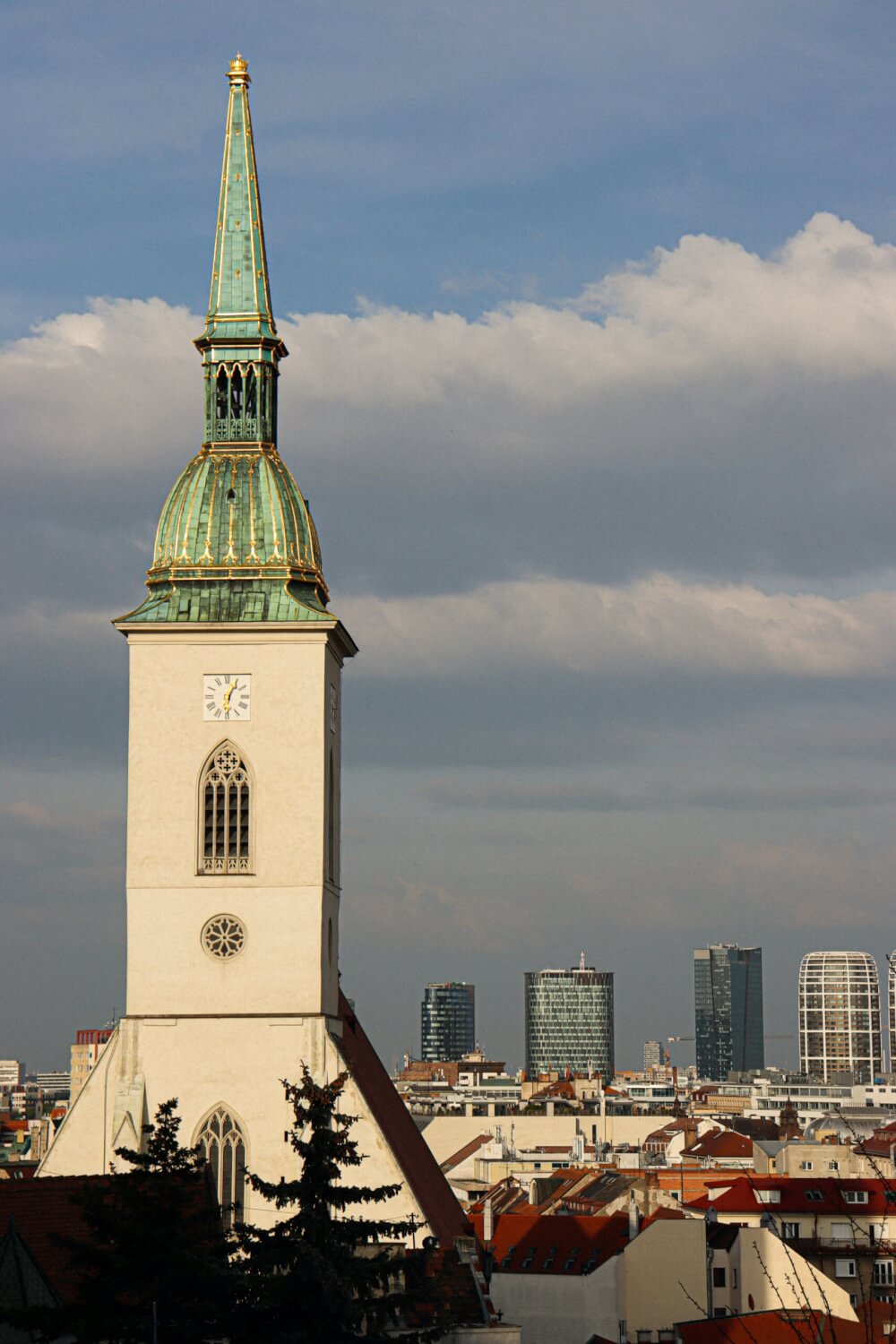
Buy some small locks to put around your zippers
Another great travel hack I’ve picked up over the years is simply buying a set of small cable locks like these and keeping one in each bag.
That way, you can quickly lock your zippers together in crowded situations and prevent anyone from randomly opening your bag.
Simple, but effective.
Look up common taxi rates and scams before arriving
While I’m a firm believer that public transport is the way to go, sometimes you might need to take a taxi, whether it’s because you’re arriving late, running late, or just want to splurge a little.
While this varies depending on the country, taxis are often prime scam zones! I’ve personally been scammed by taxis in Prague and also in Sofia.
Particularly if you are leaving from busy areas like airports or train stations, some opportunistic drivers will take advantage. This is how I got charged 4x the usual fare in Sofia, mainly because I didn’t know better.
So, if you plan on taking a taxi, make sure you search up how much that route should generally cost, and also familiarize yourself with common scams.
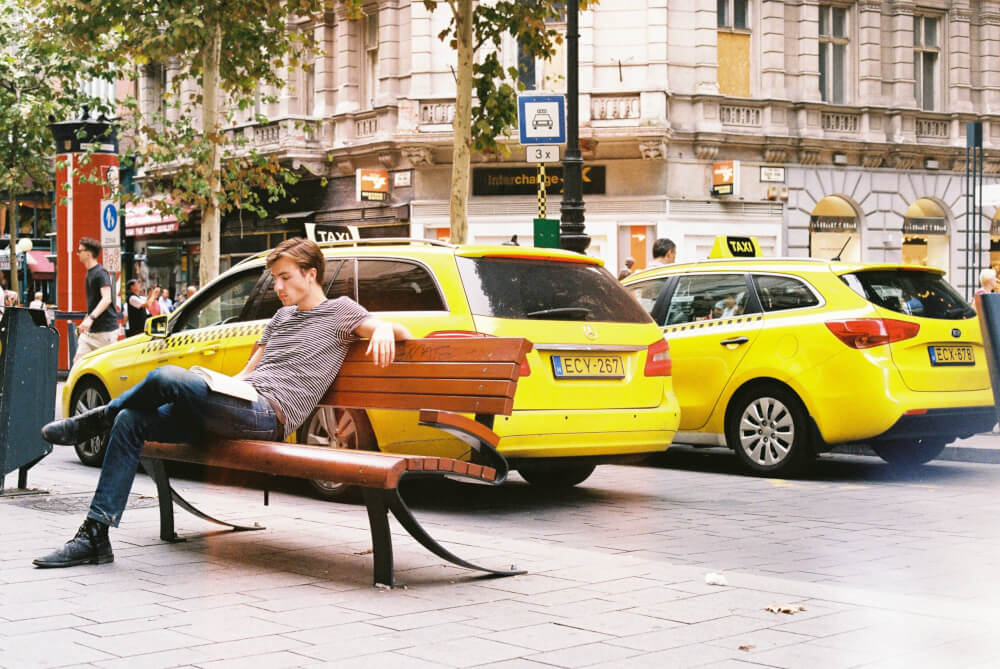
Know the emergency numbers
In North America, 911 is the go-to when you have any kind of emergency, but the numbers are different in Europe.
Within the EU (and a handful of other countries), the general emergency number is 112, and most countries will have other numbers for more specific emergency services as well.
So, be sure to take note of what these are before your trip, although I’ve heard anecdotally that 911 should reroute to emergency services as well.
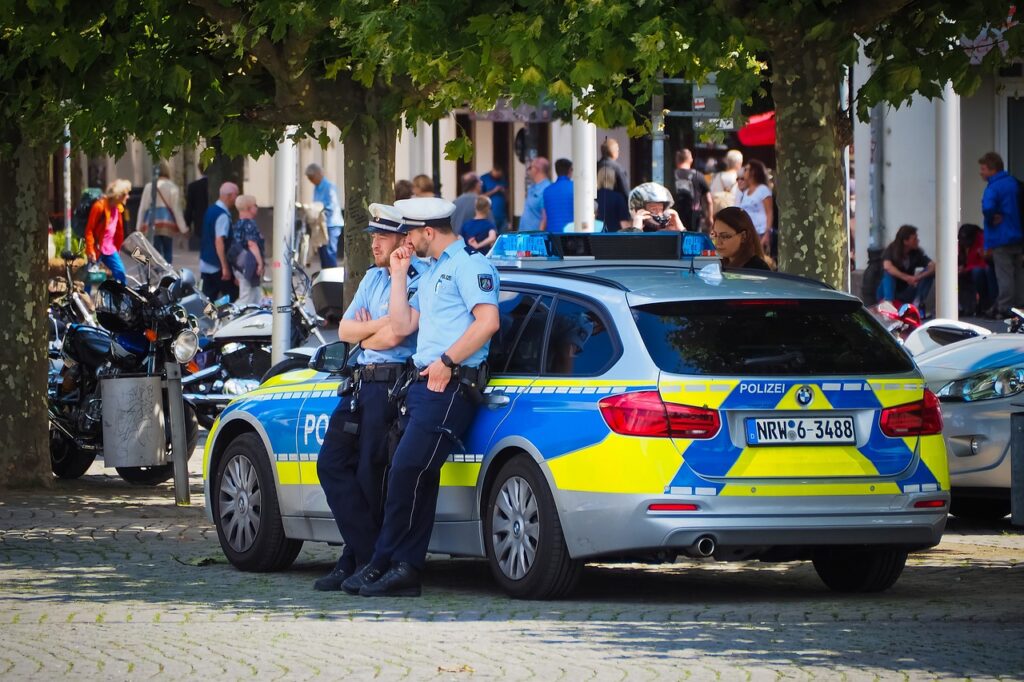
Avoid sketchy EuroNet ATMs
If you’re going to an ATM, try your best to find one that’s connected to an actual bank.
There are a lot of ATMs (especially around tourist areas) that charge huge fees, or make currency conversion more confusing than it needs to be so you can get charged more.
As a general rule, don’t use any of those Euronet ATMs – they’re the worst!
Have a plan in case of a worst case scenario
This isn’t just a good Europe travel tip, but a good tip for travelling anywhere – make a plan for the worst case scenario.
Imagine your bags get stolen with your passports and all your cash/cards – what would be your backup plan? What would you do if you lost your phone?
Having a plan in place can minimize stress in the event that anything does happen, and having that peace of mind is very important for any vacation!
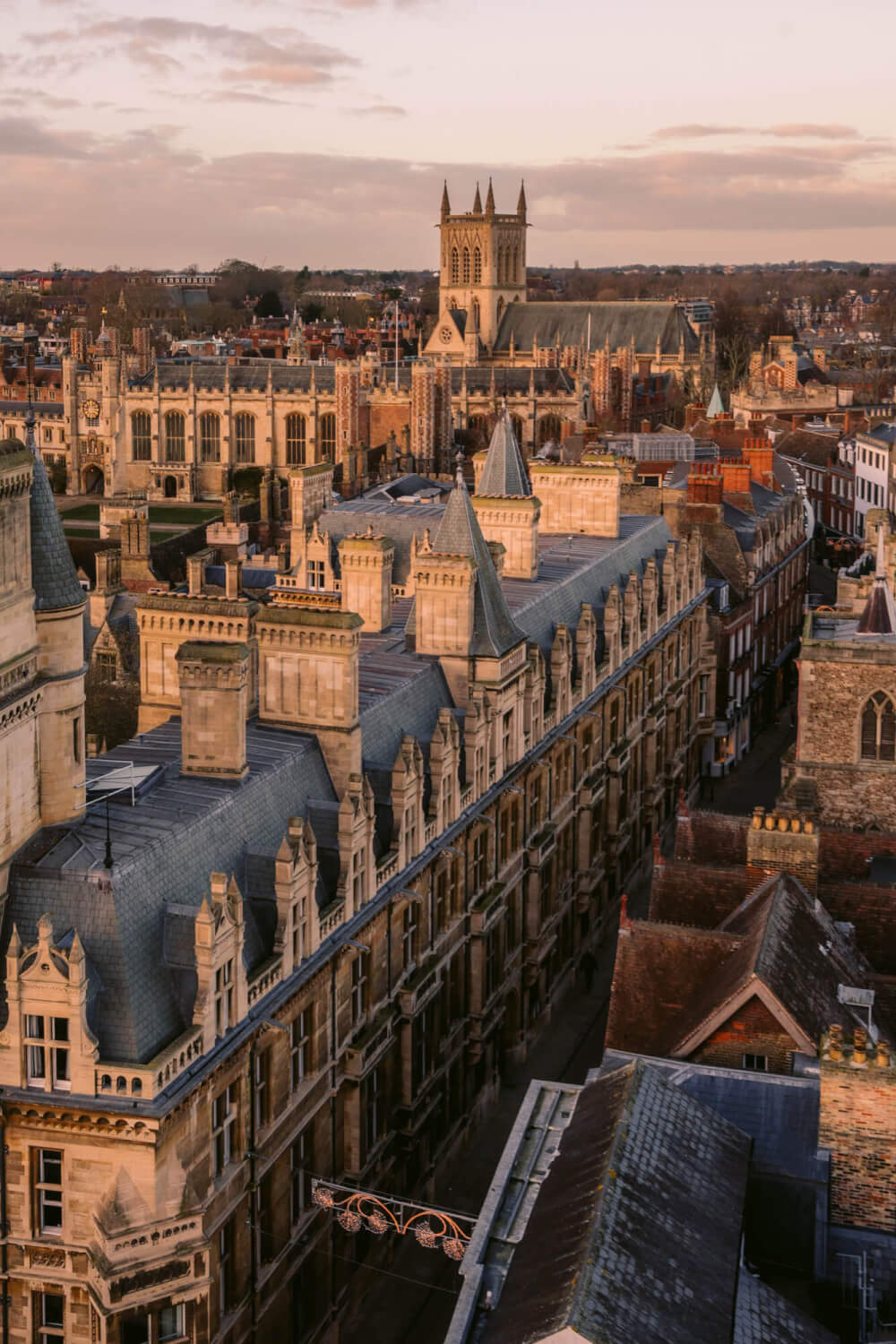
Get a good VPN
If you plan to be travelling longer-term, getting a reliable VPN is a must.
In short, VPNs (or Virtual Private Networks) mask your IP address and encrypt your data so that you can protect your identity online, browse anonymously, and even change the geographical location you’re browsing from.
This can be helpful in a lot of backpacking situations. In the past, I’ve used a VPN to…
- Access streaming for my favourite TV shows that weren’t available in the country I was travelling in
- Visit sites that were blocked in the country I was travelling in
- Access important sites (e.g. banking portals) that flagged my visit as suspicious because I was in a new country
- Securely browse the Internet with public WiFi knowing my data/identity was protected
As a real cheapskate (especially in my earlier travel days), I’ve tried every free VPN under the sun, and always found them to be unreliable or buggy.
After doing lots of research, I decided to splurge on Private Internet Access , which I’ve been using for the past few years, and I’ve been loving it. It’s super easy to use, very reliable, and actually (when you break it down) not expensive it all.
Subscribe via this link and you can get it for under 3 bucks a month.

Food & Drink Tips for Europe
When in Europe, eating and drinking well is a must! Here are some of my best tips for making the most of Europe’s varied food culture.
Visit grocery stores to save big
Not only is visiting supermarkets abroad just a fun cultural activity in general, you can save a great deal of money by buying snacks/drinks there vs. from vendors as you’re out and about.
If you have cooking facilities at your accommodation, making some of your own meals can also be a huge money-saver, even if you’re just swapping out a sit-down lunch for a picnic one.

Beware that you might need to weigh your own produce
Of course, visiting supermarkets abroad can come with its own healthy dose of culture shocks, one of the main ones being that most countries have their own different method of handling produce.
Should you weigh it? Print a sticker? Just bring it as-is?
The answer will depend, so observe what others are doing before you get caught awkwardly at the cashier with a woman shouting at you in Bulgarian because you didn’t weigh your tomatoes (true story).

Have a quick search of regional specialties before you go
European cuisine is SO diverse, and even within one country, you’ll have all kinds of different regional dishes to try, so I’d recommend doing some research beforehand about the top must-tries, so you can keep an eye out for them.
For example, you might think you know what Italian food is but when you go to actual Italy, you’ll realize that every region has their own special dishes, so be sure to look into what those are before just getting pizza everywhere.

Dine far away from tourist attractions
A general rule of thumb is that any restaurants right next to major tourist attractions are probably gonna have a poor price to quality ratio, since they cater more to tourists who are flush with cash and unlikely to return.
My tip? Just walk a few blocks over before starting your food hunt, or d some research beforehand to find well-rated restaurants near you.
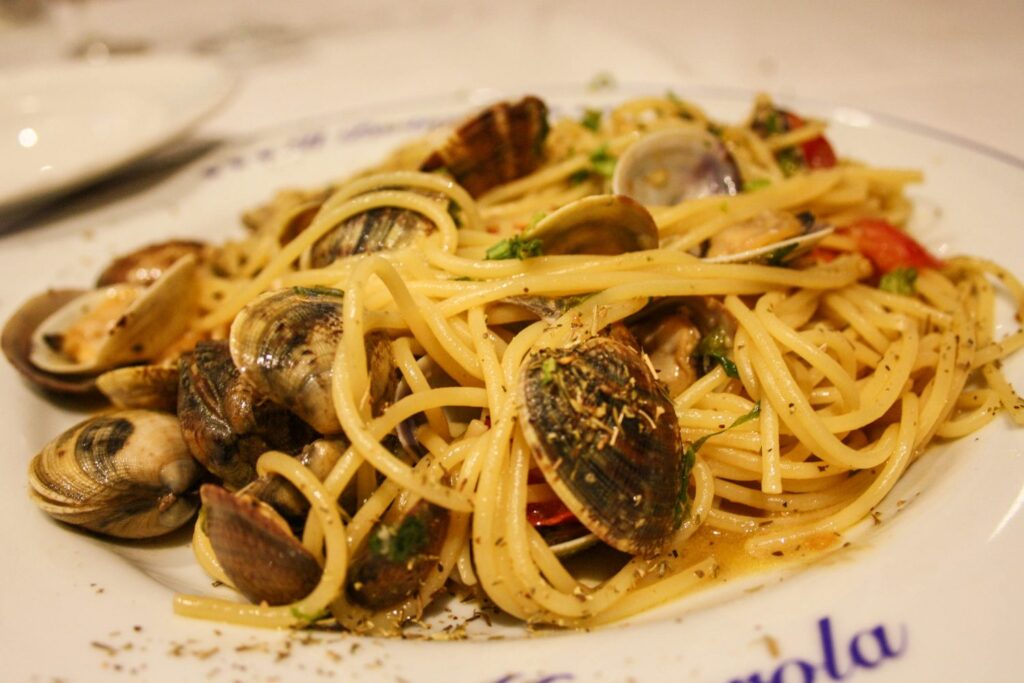
Learn how to spot a tourist trap restaurant
Tourist trappy restaurants are a dime a dozen in Europe’s more popular destinations, so make sure you work on your tourist trap radar.
A few red flags include…
- Big pictures
- The menu being translated into a million languages
- The words “TOURIST MENU” over it
- A really persistent person out front beckoning you to come inside
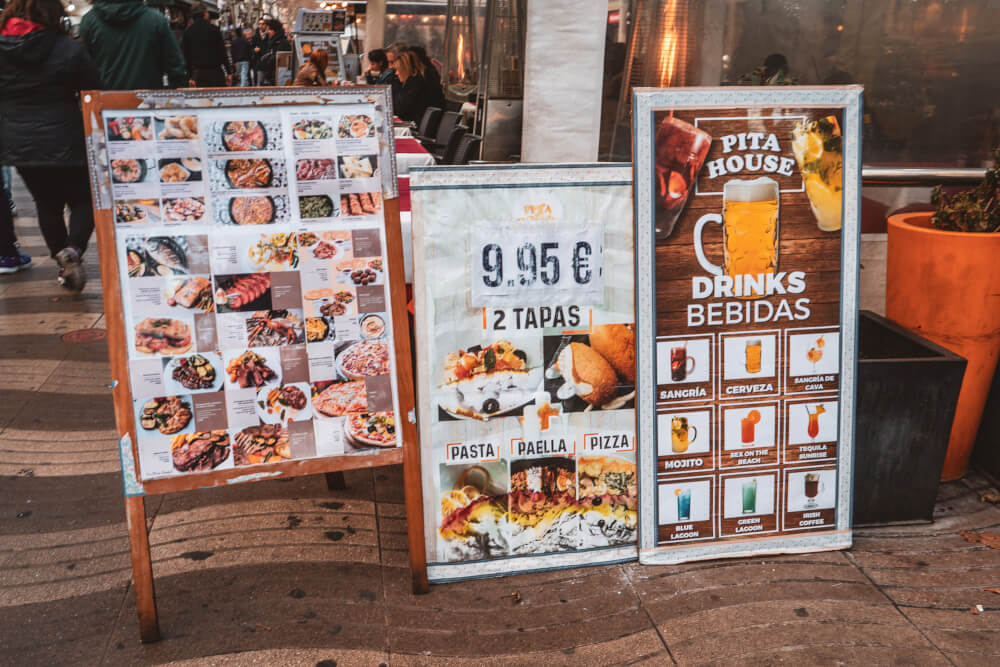
Double check that places have prices on display before ordering
This may be the oldest scam in Europe’s “let’s extort tourists” playbook, but any restaurant with fair pricing will be transparent with their pricing.
If you come across a restaurant that doesn’t list prices upfront, then run for the hills.
Never assume “it can’t be that bad” because odds are they’ve omitted their prices for a reason and plan to charge you an extortionate amount, like this place which went viral for a 500 euro lunch bill.

A quick check of reviews is a must
While I don’t believe reviews are accurate 100% of the time, I do think they’re very helpful for establishing patterns, especially when there’s a bunch of reviews all saying the same thing.
A quick search of the restaurant (even on Google Maps Reviews) can help prevent you from getting scammed or being subject to mediocre food/service.
Lunch specials are usually cheaper
If you’re gonna splurge and treat yourself, lunch might be the time to do it. Many places will offer special deals for lunch, so keep an eye out for those!

Usually the bill won’t come until you ask for it
Generally speaking, the ultra-friendly and proactive customer service you get in North America doesn’t really exist in European countries.
Very rarely will you have servers come up to constantly check on you and ask how you’re doing, so if you’re wondering why nobody has brought the bill around, just get their attention because they don’t tend to drop it off until you ask (doing so without asking is actually considered a bit rude in itself).
Don’t shy away from food tours
If you’re running on limited stomach space but want to try as many local specialties as possible, then food tours are a really fun and delicious option.
Most big destinations in Europe have them these days, and they’re a great way to sample a lot of local foods while also getting a local guide’s perspective and expertise.
Context is key and learning about food (while eating it!) is the best.
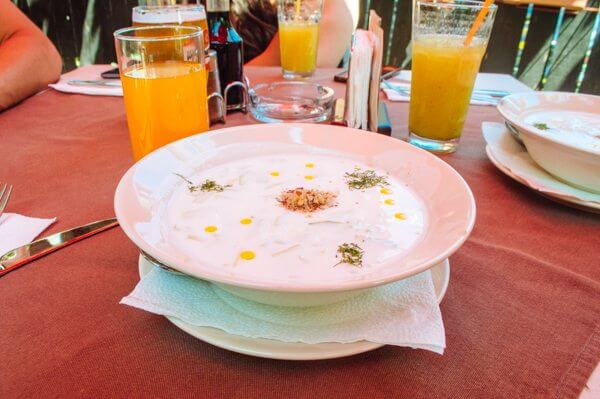
Take a cooking class
Another foodie activity that’s now offered in most European destinations these days is cooking classes.
There’s no better souvenir than learning how to prep your favourite foods once you get home, so definitely consider adding one to your itinerary.

Get used to sparkling water
Sparkling water is a lot more common in certain European countries than in North America, to the point where sometimes it’s the default if you ask for water.
If you’re not a fan of spicy H20, then make sure to specify Still when you order water.
Don’t pay extra for hotel breakfast
Don’t get me wrong, I love a good hotel breakfast when it’s included in the room rate, but if you’re given a choice, you can save a lot of money by going out to get breakfast at a bakery, which is also more fun in my opinion.

When weather permits, picnics are a much better option
I love picnics. They’re such a romantic and affordable way to enjoy a meal, especially when you have a great backdrop.
Make sure you picnic at least once during your trip – I promise you’ll love it! And your wallet will too.

Generally speaking, Europeans eat later than North Americans
After living in Germany for a few years, making dinner plans with friends at home almost put me in a coma. Dinner at 5:30 or 6pm? Wayyyy earlier than most European countries, especially Spain where dinner time is often after 9pm.
Of course, you can take advantage of this cultural difference by getting a table at popular restaurants simply through booking as soon as they open.

Be openminded with trying new foods
I hated beer until I had it in Belgium. I hated cheese until I tried smoked cheese in the Netherlands.
I don’t know how to explain it, but certain food and drink items just taste different, and frankly, better in Europe than they do in North America.
So before you write something off as a food you don’t like, give it a try. You might be pleasantly surprised, especially if it’s the regional specialty.
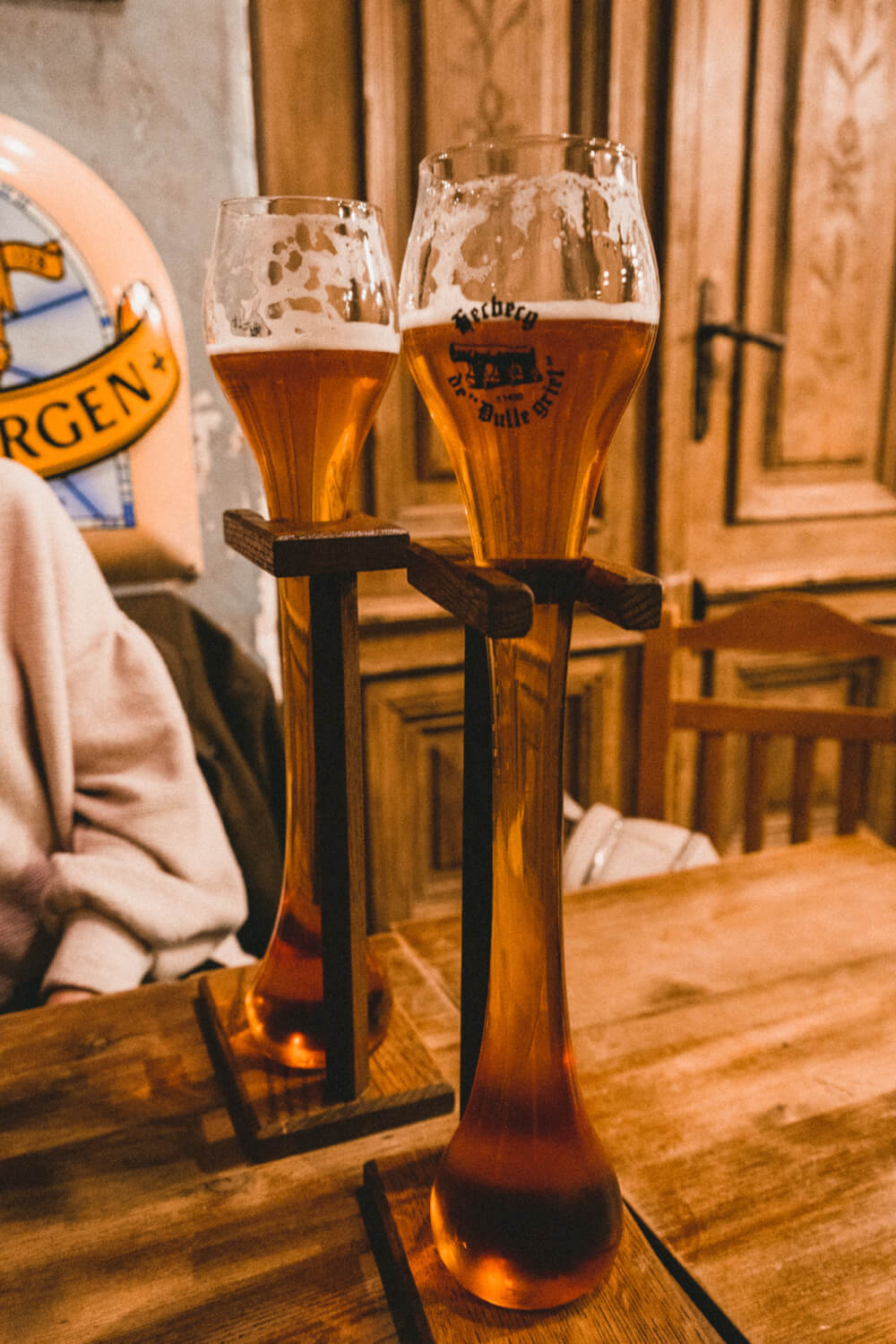
Get takeout for super cheap with Too Good to Go
One of my favourite (little-known) Europe travel apps is called Too Good to Go.
They service many major European cities, and basically, it’s a free app that restaurants use to sell their leftover food at the end of the day (sometimes at lunch too).
This helps minimize food waste, and means you can pick up an entire take out meal for less than 5 euros.
Sure, you don’t get to choose what you get, but it’s an excellent way to eat cheap and help reduce waste at the same time.
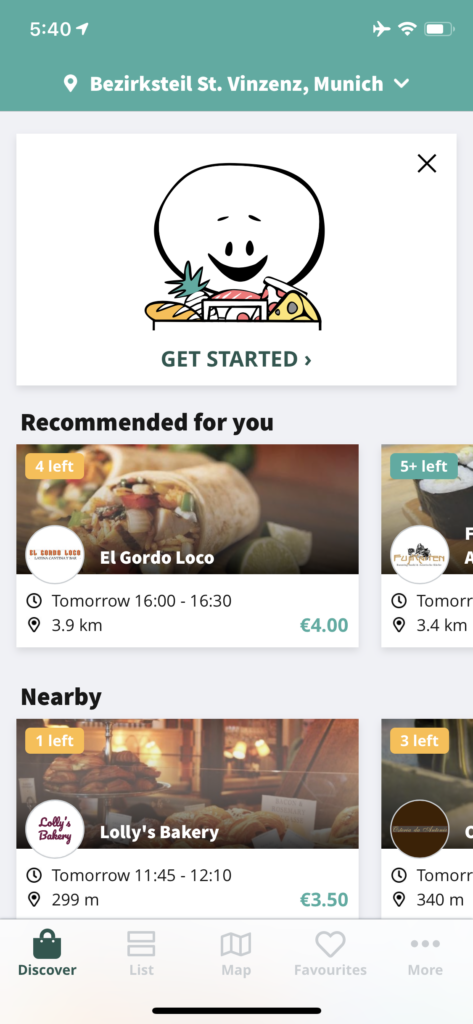
Culture & Etiquette Tips for Europe
Tourists can often have a reputation for being rude… but not you! Not on my watch. Here are some culture and etiquette tips to keep in mind for your trip to Europe.
Culturally, Europe is a million different entities
One of my biggest pet peeves when it comes to Europe travel advice is when books or sites tell you “In Europe, tipping is like…”, “In Europe, locals are…”
… Which I know is kind of ironic in an article simply called “Europe Travel Tips” but shhh just go with it.
Long story short: Europe is composed of dozens of countries, each with their unique cultural nuances and norms, so be sure to research culture tips specifically for where you’re going, because things like tipping, queuing, meal times, etc. can vary considerably across the continent.

Learn at least hello and thank you
While visitors can often survive just fine without learning the local language, i’s generally good manners to know basics such as hello and thank you for every country you visit.
… So be sure to practice that a bit before you go!
Do not tip by North American standards
As I previously mentioned, tipping in Europe does vary from country to country, but never would a 20% tip be considered the bare minimum like in North America sometimes.
So, be sure to research tipping culture in your destination before you go. In many countries, tipping involves simply rounding up.

Try to not speak too loud
In Europe, North Americans generally have a reputation for being… loud. Sometimes obnoxiously so.
So if you’re out in public, try to lower the volume of your voice to closer match what’s around you (easier said than done, I know, but something to be mindful of).
When in doubt, mimic the locals
Cultural norms can vary widely from place to place, so your best bet is to just observe the status quo and try to imitate that.
If nobody is chatting on the train, it’s probably a good sign that you shouldn’t either. If everybody is lining up in an orderly queue, maybe you should join that queue instead of barging in the front.
Remember, tourists can have a reputation for being disrespectful and annoying, so try your best to shatter that stereotype wherever you go.

Look into festivals and folk events to attend
One of the most amazing things about Europe as a continent is that it is so deeply rooted in heritage and tradition, with some cultural traditions dating back thousands of years.
For a truly unforgettable experience, I’d recommend looking up some fun festivals or events to enjoy.
Here are some of my favourites I’ve been to:
- September: Bad Dürkheim Wurstmarkt (the world’s largest wine festival)
- September/October: Oktoberfest in Munich (the world’s largest beer festival)
- February: Crazy Days at Cologne Carnival
- March – April: Starkbierfest in Munich (unique strong beer festival)
- March – May: Keukenhof (the world’s largest flower garden)

Packing Tips for Europe
Not sure what to wear and what to pack for Europe? Here are my top Europe packing tips.
Steal my pre-made packing lists
If you’re overwhelmed with what to pack, I’ve already made some packing lists that you can use as a starting point!
Download them, print them, mail them to all your friends and exes! I hope you get tons of use out of them:
- My Europe winter packing list
- My Europe summer packing list
- My versatile minimalist packing list
- My toiletries packing list

Don’t bring any suitcases you can’t carry
I’ve always been an advocate for packing light, but a good rule of thumb is to not bring any suitcases you aren’t physically capable of carrying yourself.
There’s a million and one scenarios where you might have to end up carrying your suitcase in Europe, like…
- Your hotel or accommodation unexpectedly has no elevator
- The elevator you were counting on at the train station is out of order
- You need to carry your bag up some ancient staircase to get to your accommodation
- You need to lift your suitcase on/off the train you’re taking
So yes, whatever bag or suitcase you bring, make sure you’re able to carry it yourself.

Good walking shoes are a must
I cannot explain to you how much walking you’ll end up doing, so comfortable shoes are much more important than cute stylish ones.
That said, if you’re able to find comfortable walking shoes that are a bit dressier, opt for those over beat up runners.
Generally speaking, casual wear in Europe is more dressed up than what we’re used to in North America, so packing a nice pair of white sneakers or comfy leather boots would definitely be a more versatile choice over hole-filled running shoes.

Buy AirTags to track your suitcases
With airlines losing baggage all the time these days, I’ve finally caved and bought an AirTag to track my checked bag.
And honestly? I regret nothing! I love the ease of mind it provides, and should a thief ever nab my bag one day, I feel very smug knowing I’ll be able to track them down.

Pack an emergency outfit in your carry-on
On a similar note, one Europe packing tip I live by is always having an emergency set of clothes in your carry-on bag.
Checked bags get lost all the time, so having extra clothes with you is key for ease of mind. I usually bring all the top essentials with me in my carry-on. Better safe than sorry!
Pack clothes with hidden inner pockets rather than a money belt
While many travel experts tout the the benefits of money belts, I’ve honestly never been able to get on board with them. They’re awkward, sweaty, and reaching under your clothes to get change for an ice cream is just… not my idea of fun.
Instead of a money belt, I always have either:
- A backpack with a zippered pocket in the back, which makes it inaccessible to anyone else when worn
- A crossbody purse with a pocket on the backside, again making it inaccessible to anyone so long as I hold it close to me
- A jacket with inner pockets so it’s impossible to reach in without getting super super close
These anti-theft methods are a LOT more comfortable to me than a money belt… so remember: a money belt isn’t the only way!
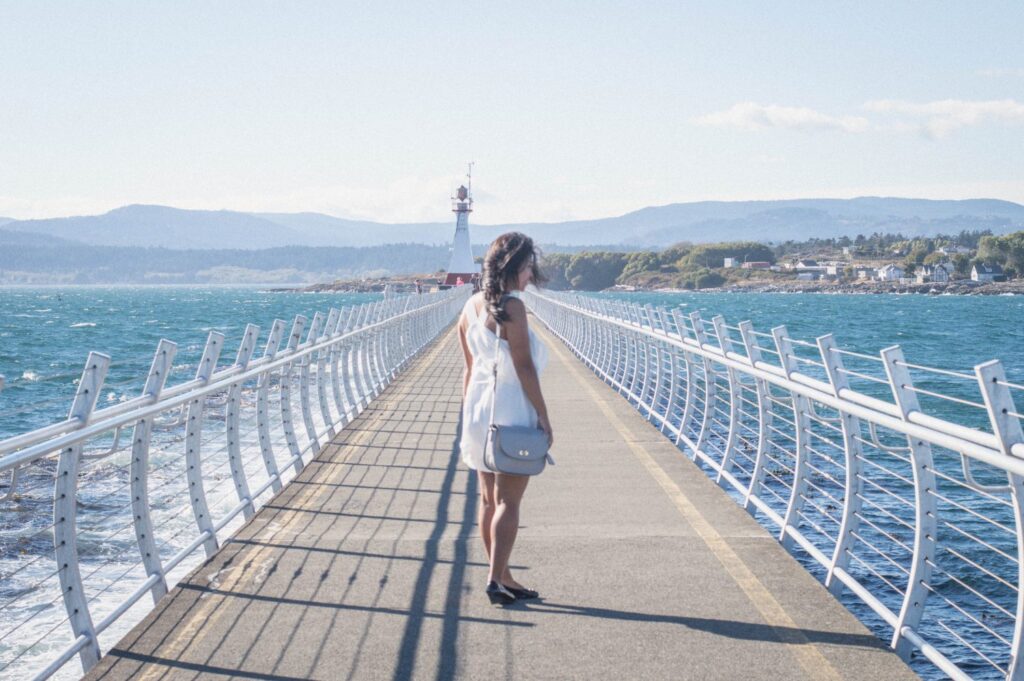
Bring a universal adapter
Power sockets in most European countries have two round holes and if you’re visiting from overseas, odds are you’ll need an adapter for your plugs to fit.
I’d strongly recommend buying a universal adapter like this one if you don’t have one already. Not only is it good for the standard round hole outlets, but it can also work for the three prong plugs in the UK, Malta, and Cyprus.
It’s cheap, can be re-used for every trip, and covers you in all situations. Definitely some of the best money I’ve ever spent!
Use packing cubes to organize and compress your clothes
I am such a packing cubes fangirl.
These beauties are a magical way to keep all your goods organized, while saving space in your bag as well. Gone are the days that you rummage through your entire pack for a particular t-shirt!
Not all packing cubes have to be expensive either. There’s plenty of affordable options on Amazon, like this blue set from Amazon Basics , but you definitely get what you pay for.
PS: I’m a total packing cube nerd and once bought a bunch of different brands to compare. See my full packing cube showdown for more.

Pack a re-usable bag for purchases
Single use bags are slowly getting phased out in Europe, so I find it’s always a good idea to bring an extra bag or two whenever I travel, whether to stash my souvenir haul for the day or to carry around snacks.
So, when in doubt, pack a tote or two! They can be such lifesavers.
DIY your own travel sized toiletries
This is a very basic packing tip I always recommend, but rather than buy the bottles of toiletries which give you like, three good squeezes of shampoo, I find it’s easier (and more eco-friendly) these days to buy small reusable bottles that you can fill with your own toiletries of choice.
This allows you to bring your favourite products with you, and saves needless one-use toiletries from ending up in the landfill.
Need help picking the right one? Read my guide to reusable toiletry bottles for more info.

Final Europe Travel Tips to Know Before You Go
Alright, before I let you get back to… your real life, friends, and family, here are some final random Europe travel tips to keep in mind.
Having cash is important
With the exception of Northern Europe and some parts of the UK, cash is still important to carry around, whether for small purchases or for essentials like using the washroom. Keeping coins is also a good idea.
So, don’t forget that cash is still king in many parts of Europe!

Claim VAT refunds at the airport
Taxes are generally built into the price in Europe, so many travellers don’t realize they are paying up to to 20% in VAT (Value Added Tax) for everything they purchase.
The good news is, when it comes to goods that you are buying and taking home (e.g. clothes, gifts, etc.), non-residents of Europe are eligible for a refund on this VAT that you pay.
VAT refund rules vary from country to country, but usually there’s a minimum spend amount in one single location (around 175 EUR in most cases).
So, keep this in mind and you can get a good chunk of change back. To get the step by step process, Google your destination + VAT refund, as the process does differ country to country.
Floors start at zero so don’t get confused
If you’ve seen Emily in Paris you’ll already know this one.
The floor system in European buildings tends to differ from North America.
Whereas in North America, the ground floor is often the 1st floor, the ground floor is considered its own separate entity in most countries (i.e. Floor 0) and then the next one above that would be the 1st floor.
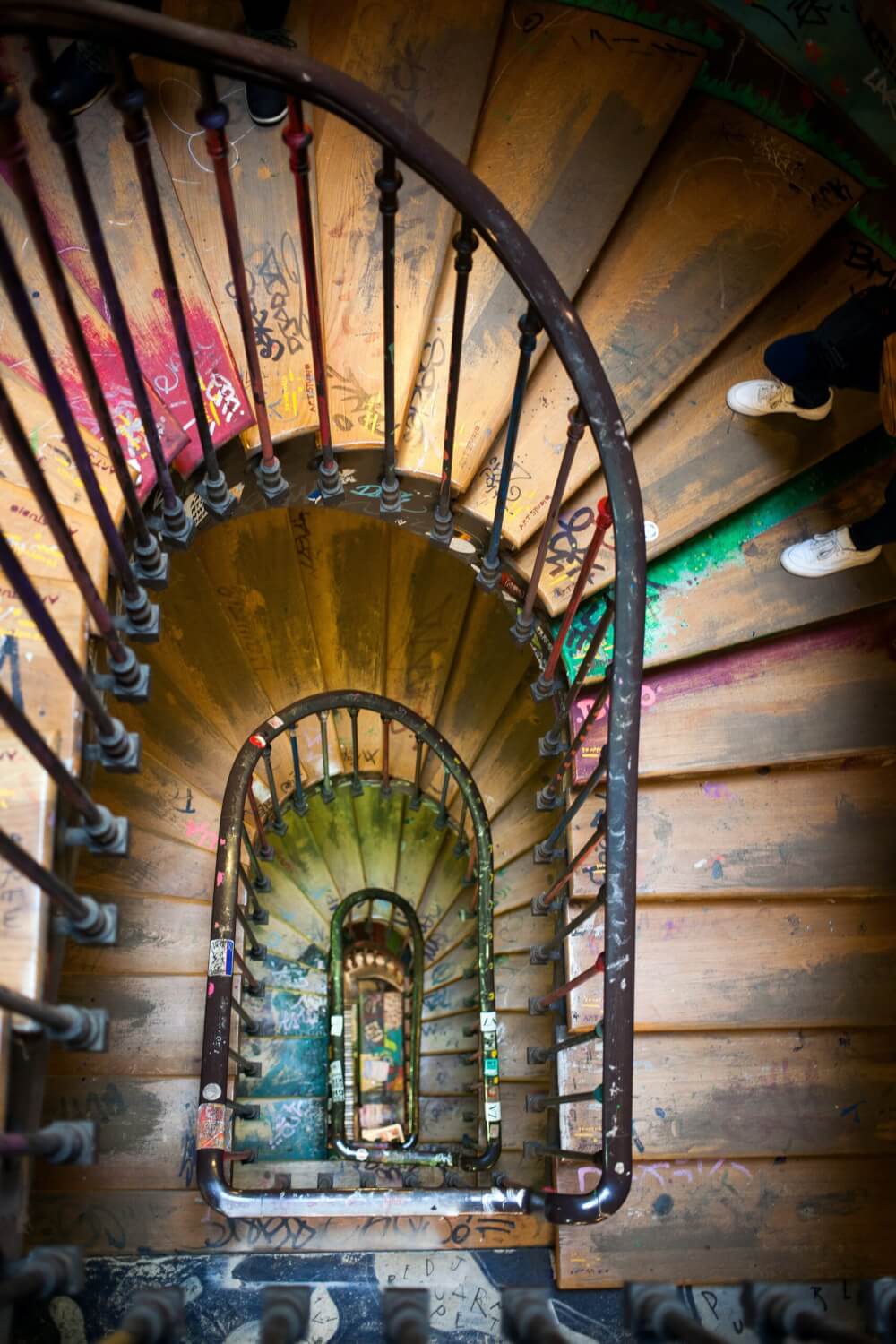
Prepare for beds to be different
Bed sizes in Europe tend to be smaller, and doubles can often just be two single beds pushed together (so romantic, I know).
Depending on where you go, the pillows and comforters can be different as well, like in Germany where they’ve randomly decided that the optimal shape for a pillow is square. *shudder*
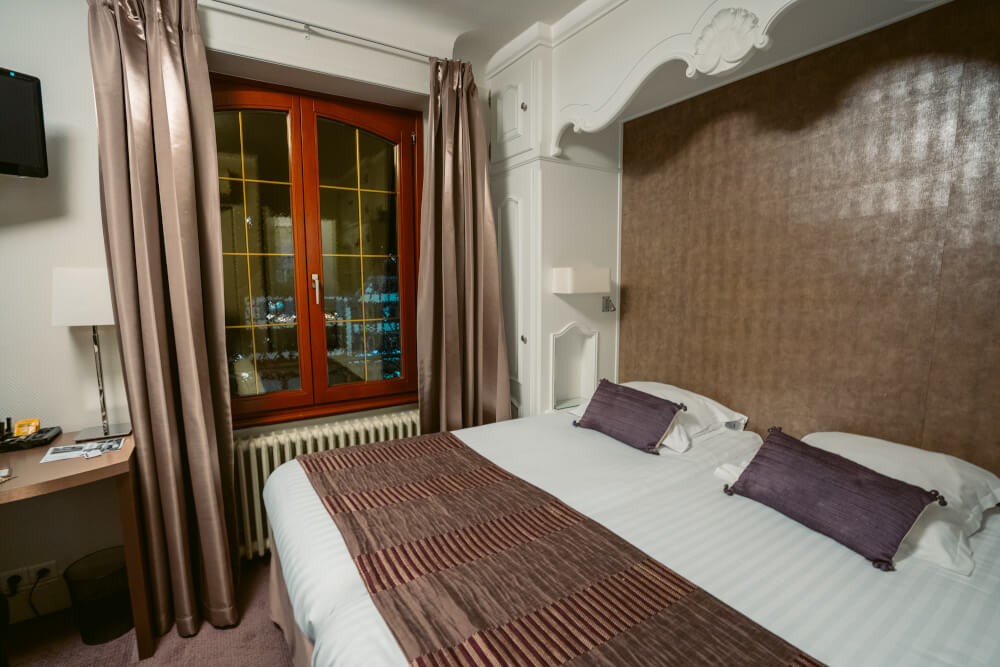
Beware of words you know that may mean a different thing in other languages
For example, a menu for North Americans is a list of dishes you can order, but a menu in France means a set meal or combo.
Similarly, entrées in North America are the main course, when in France, it means appetizer.
Use Google Maps to save spots you want to see
Google Maps is an amazing resource not just for navigating a new city, but also for saving spots you might want to visit in the future.
One of my favourite travel hacks is starring every location I deem interesting on Google Maps. You can do this by pressing the Save button when you search up that spot.
This allows you to have a visual map of all the cool cafes, street art murals, attractions, restaurants, etc. that you’ve saved during your research, which means you can easily organize your itinerary/sightseeing.
I love doing this because I’ll often end up in new areas during my explorations, and I can just look at my map to see if anything interesting I read about happens to be nearby. Saves a lot of planning!
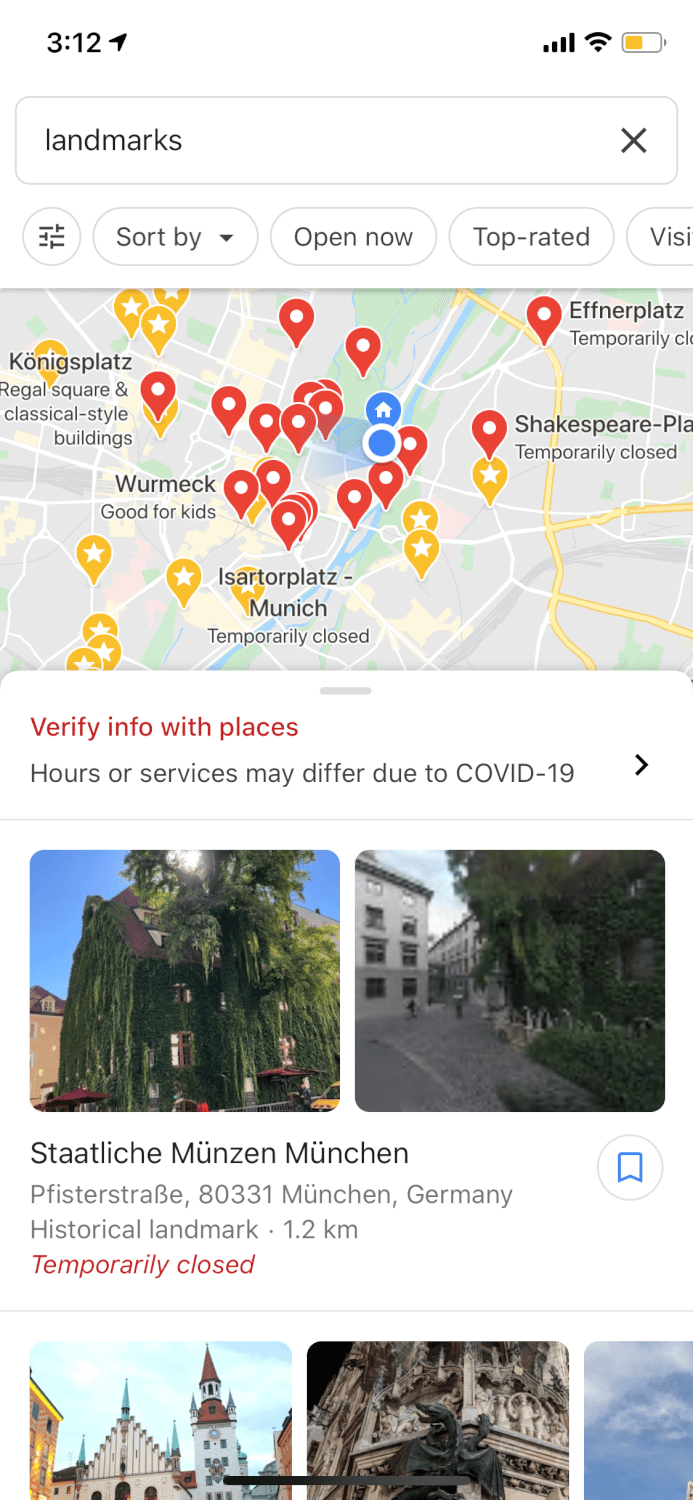
Need customer support? Hop on Twitter
Don’t ask me why this is, but if you need to get ahold of customer support during your trip (e.g. an airline, a train company, etc.), usually the quickest response time will be through Twitter.
The best way to tell if you’ll get a reply on Twitter is by checking the official accounts’ replies – if there are recent replies to Tweets, odds are good that there’s a dedicated staff member monitoring the account.
This of course works in non-travel settings as well!
Get crowdless photos by using this cool photo hack
For iPhone users, there’s a super easy way to get cool photos in crowded places without getting a bunch of people in the shot.
Simply follow these steps:
- Turn on Live photo
- Pose for your photo, making sure to stand still
- Get your photographer to snap a few photos of you standing still
- Edit the photo by going in the upper left corner, click on the LIVE button with the downwards arrow, and turn on Long Exposure
- The crowds walking around you should now be blurry, with you still in focus
Binge on movies set in your destination before your visit
You know, I could binge travel quotes all day but nothing will put me in more of a wanderlusty mood that a good movie set somewhere beautiful.
So, if you binge travel movies set in your destination, I promise your trip will be 1000000x times more enjoyable when you recognize the sights that you’re seeing. Trust me.
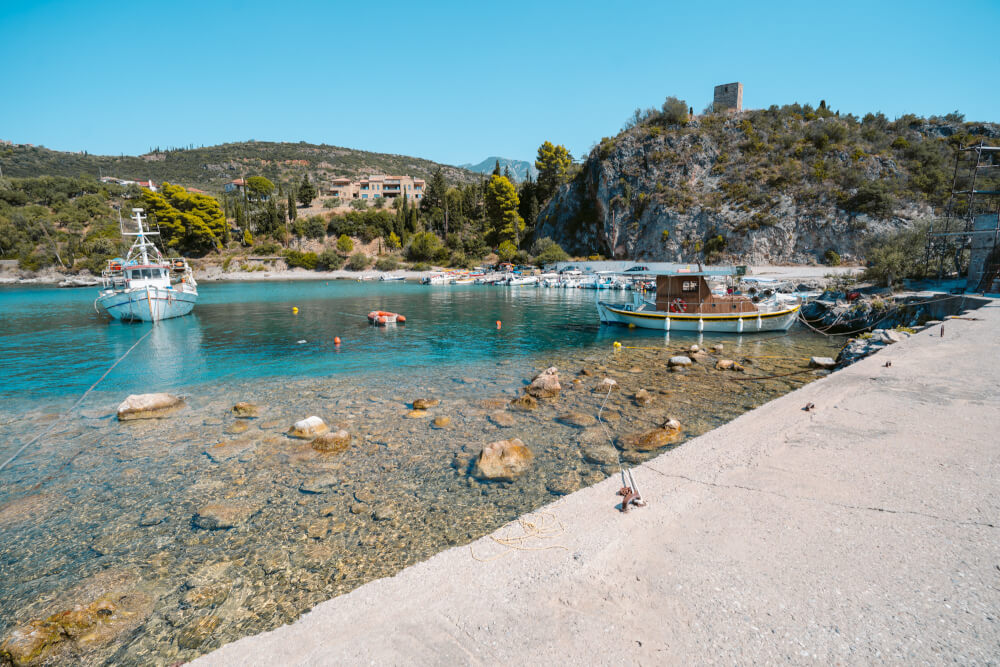
Consider learning the Cyrillic alphabet
If you are travelling somewhere that uses the Cyrillic alphabet, it can be very beneficial to learn how to read it.
This is because sometimes destination names at train/bus stations are written only in the local alphabet, which can lead to a lot of confusion if you’re unfamiliar with it.
European countries that use the Cyrillic alphabet include…
- North Macedonia

Remember: Europe is more about the experience than it is about seeing a million sights
Last but not least, I have to say… Europe is beautiful, yes. It’s packed to the brim with gorgeous museums, architecture, natural beauty, etc. BUT at the end of the day, what you need to focus more is on the experience of just being present and enjoying every moment.
Don’t stress yourself out too much with a heavy itinerary and trying to cram as much as possible in.
Enjoy it! Because your trip will go by far quicker than you think.

I hope this list of Europe travel tips was helpful!
If you’ve made it this far, wow. I applaud the stamina. And patience! This ha admittedly been a VERY long list of tips for Europe, but if you have any more questions, let me know in the comments… and be sure to read my list of unconventional travel hacks if you’re eager for more.
My Go-To Travel Favourites:
🧳 Eagle Creek: My favourite packing cubes
💳 Wise: For FREE travel friendly credit cards
🍯 Airalo: My go-to eSIM
🏨 Booking.com: For searching hotels
📷 Sony A7IV: My (amazing) camera
✈️ Google Flights : For finding flight deals
🌎 WorldNomads: For travel insurance
🎉 GetYourGuide: For booking activities
Leave a Comment Cancel reply
By using this form you agree with the storage and handling of your data by this website. *

- Switzerland
- The Netherlands
- National Parks
- Affording Travel
- Photography
- Responsible Travel
- Worldschool
- Wanderlust Guides
- Travel Planning
- Work with Us
Europe , Travel
How to travel europe like a pro: 50 europe travel tips you need to know before you go.

Before you go to leave, be sure to read these 50 essential tips for traveling to Europe that you help you travel Europe like a pro!
Europe travel tips: 50 things you should know before going to europe.
Europe is my favorite place to travel. Despite having traveled extensively around the world, it’s still the place I return to again and again. We travel Europe at least once a year, and even lived there for an entire year!
But you don’t have to stay for an entire year to get a feel for this amazing continent. Even just one week in Europe at any of these incredible destinations is enough to make you fall in love!
There are so many incredible places to go in Europe with so many different countries and cultures to explore without actually traveling very far! Traveling through Europe can seem a little overwhelming if you’ve never been before, so I wanted to share a few things you should know before going to Europe. This will make your first visit much more enjoyable.
If you’re traveling with kids, be sure to read these 10 tips for taking kids to Europe.
1. Budget for Your Trip
Before you even purchase tickets to Europe, sit down, like a responsible adult, and plan a budget for your trip to Europe. Make sure it’s realistic and make sure it’s something that you can afford right now. While I love to rack up credit card points by using them on travel, it’s important to be reasonable. The good news is that Europe can be done fairly inexpensively, in fact, we actually spent less money traveling Europe for a year than we did staying home!
How much does it cost to travel Europe?
That answer really depends on how many people are in your party, what style of travel you like, and how budget you’re willing to go. You can travel Europe cheap if you’re smart about it, but I would plan on $1,000/person for each week just to be safe.
The cheapest way to explore Europe is to plan ahead and shop around for the best deals on accommodation, transportation, and airfare because there are tons of Europe travel deals out there on the internet! If you want to know how to travel Europe cheap, you can read about how we actually spend less money living there for a year than we did at home.
Be sure to read my guide to planning financially for a vacation, which includes a Europe travel budget calculator so that you can find out just how much your trip will cost.
2. Save for Your Trip
Now that you have your budget set in place for visiting Europe you can start saving! These are some easy ways that I save money for travel. You don’t need to turn over your whole paycheck, but you’ll need to make saving for travel a priority so you don’t go into crazy debt to be able to afford it. Credit cards definitely have their place and can be useful for earning points, but be sure you pay it off each month! If you can’t afford to do so, maybe don’t spend it. This is why having a travel fund is so important. When those travel deals pop up you’ll be ready to jump with your special savings!
3. Check Europe Travel Visa Requirements
Americans traveling to Europe won’t need a Visa to travel to most countries on the continent. Europe travel visas are a little complicated, but you can learn more about them here. If you’re looking to stay in Europe for more than 90 days, read this.
Beginning in 2023, US citizens and citizens of other previously non-visa countries coming to the EU will now need a ETIAS Visa. Read here for what that means for you.
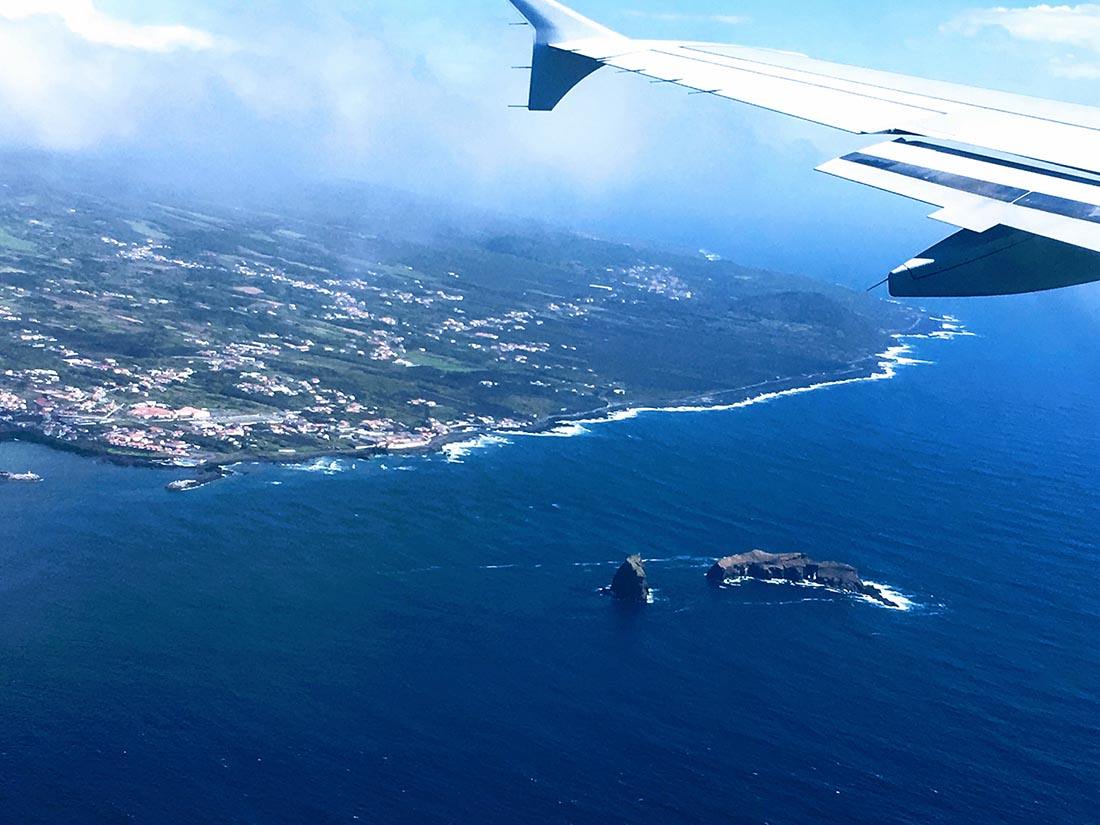
4. Buy Flights Early
You can usually get the best deals to Europe by booking early. Start keeping an eye out for cheap flights as early as possible. Read my guide to finding cheap flights to be sure you’re getting the best deals!
5. Read Books About your Destinations
Once you decide where you’re going in Europe, find books to read about it. I don’t mean guide books, although those can be great. I love these ones. I mean books, both fiction and nonfiction, that tell a story set in Europe. It can make your trip so much more meaningful when you have some connections.
You can read this awesome list of 100+ books organized by continent that will inspire you to travel.
6. Pack Light
Pack light, especially if you’ll be traveling around Europe and taking public transportation. There’s nothing more frustrating than trying to haul heavy luggage around on trains! I promise!
Make a packing list, then take less than you think you’ll need. If you’re going to Europe for more than one week, pack for one week, then plan on washing and/or re-wearing what you’ve brought. There’s nothing shameful about washing your laundry in a tub or sink or even spending some time with the locals at the laundromat! It could be an adventure!
If you want to wash your own clothes more efficiently, consider getting one of these awesome laundry wash bags that make laundry day way easier and more fun!
7. Bring Melatonin to Beat Jetlag
Consult your doctor before taking any medication. I am not a doctor, but this is what works for me. I buy the gummy melatonin (because I have kids) and take it with me every time I travel. Sleeping in a new bed is hard enough, but add a 6 hour time difference once you’re in Europe and it’s all over! When you’re ready for bed, take about 3-10 mg of melatonin which will help you shift your internal clock. Melatonin is an over the counter sleep aid and can be purchased at any drug store or grocery store. I really like this one because it tastes delicious and is 5mg (a good amount for adults) and this one for kids or smaller people since it’s only 2.5 mg (which is hard to find in stores).
Be sure to pull down the shades and make it as dark as possible. I like to use this amazing eye mask to achieve complete darkness! I love that it leaves space for your eyelashes, which is a huge selling point for me! And yes, it does look like a bra for your eyes!

8. Don’t Try to See it All!
This is probably one of my best Europe travel tips! T raveling to Europe for the first time will be so exciting and you’re going to want to see as much as you can. Europe is filled with so many bucket list destinations screaming to be visited! Unless you’re staying in Europe for a year, don’t try to see it all in one trip! Europe is huge and each country is so different. Just one city could honestly keep you busy for a lifetime!
Even though it’s so easy to travel around Europe, don’t spend all of your time on a train, plane or car! Plus, just more reasons to come back right?! I would stick to 2-3 cities in one visit depending on the length of your trip. The best way to travel Europe is slowly! Take your time, you can always come back.
If you only have one week, these 20 One-Week Europe Trip Itinerary Ideas will help you decide which cities to visit.
9. Book Your Accommodations as Early as Possible
Once you know where you’re going in Europe you can book your accommodation. The sooner you book your accommodation in Europe the better! You’ll have more options and lower prices.
We like to use this website to easily search for our desired accommodations. I like it because you can enter specific parameters like hotels with pools, good for kids, a certain number of beds, etc.
Also, consider using VRBO instead of staying in a hotel. It can significantly increase your savings! Staying in a VRBO also allows you to see your destination as the locals do.

10. Learn How to Travel Around Europe
Before arriving in any city, be sure to do some research and learn how to get around using public transportation or a rental car. Each city has its own rules that can be complicated to say the least. Using public transportation in a foreign country can be a great way to experience cities like a local but can also be intimidating. Be sure to do your research ahead of time so you know how to use each public transportation system. If you’re going to London, read my guide to getting around London here and my guide to train travel in Italy here .
11. Travel Europe by Train
I think the train is the best way to travel Europe!
Train travel in Europe is an efficient and inexpensive way to get around within the countries and between them. You may want to consider getting a Rail Pass train tickets . When you travel Europe by train, be sure you know the rules for each country.
If you’re going to Italy, read about how to use the train system in Italy here.
12. Get an International Drivers License
Be careful when renting cars in Europe that you check to see if an international drivers license is required. Obtaining one is quick and easy. You can make an appointment at any AAA. You’ll need 2 pictures of yourself and your drivers’ license. Read this to learn more.
13. Call Your Credit Card Company
Before leaving for your trip to Europe, call your bank and/or credit card company and tell then where and when you’re traveling. I can’t tell you how many times I’ve had my card put on hold from forgetting to do this!14 . Take a Credit Card, Debit Card, and Cash
In Europe they have this thing called “Chip and Pin” that the US hasn’t seemed to catch onto for some reason. Because of this, your credit card might not work sometimes, so be sure you have a debit card and/or cash on hand.
15 . Have Cash with You
I recommend using an ATM to withdrawal the local currency as it will use your bank’s exchange rate, which will most likely be lower than the foreign transaction fees of the currency exchange booths at the airport.
You’ll also want to have cash as some places may not accept cards. This is especially true for many gelaterias in Europe! You want to be sure to have cash for those important things like gelato!!! Some small towns in Europe may not even accept cards at restaurants, so you’ll want to have a decent chunk of cash hidden away.
16. Know About the Currency of Each Country
When I went to Europe as a little girl, before the EU was formed, every country had a different currency. It was really fun to collect the coins, but a nightmare when you were road tripping through Europe!
Now, most countries in Europe use the Euro, but some countries still use their own currency. Here is a list of countries who use the Euro:
- Netherlands
All other European countries that don’t use the Euro use a local currency. You can see a complete list here.
17. Leave the Majority of Your Cash in the Hotel
While it’s important to have cash available during your trip to Europe, you don’t want to be carrying around hundreds of Euros/Pounds/Franks/etc. every day. Leave the majority of your cash in your hotel room or Airbnb. Be sure to put it away so it’s not visible.
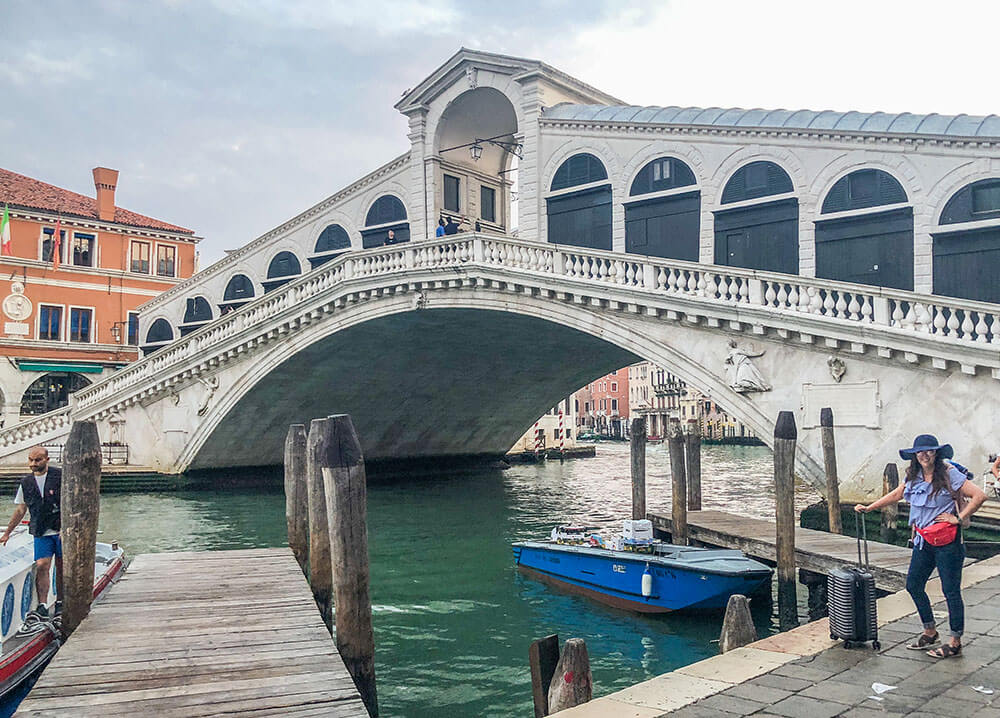
18. Wear Your Cash
I like to carry cash close to me in one of these carriers or in my favorite travel accessory ever… a fanny pack (bum bag for non-Americans). How did I ever live from age 10-30 without one of these?! Why did I stop wearing them? They’re literally the best invention!
I own several, including this beautiful one from Fawn Design , but I love these ones as well, and they come in 12 different colors. They are a perfect size to put your phone and wallet in. I even have this larger fanny pack that actually holds my Sony camera! I like it because you can turn it into a purse if you feel so inclined, but honestly, why would you want to?! Everyone get on the fanny pack train with me ok?! Please!
19. Spend Your Coins
I’m not used to pulling out coins to pay for things in the US unless I’m buying gum! But in Europe you’ll be getting a lot of 2 Euro coins that add up quickly. Be sure you spend your coins as well as your cash. Also, if you’re exchanging any leftover currency at the airport before you go home, they do not accept coins! I usually give my kids all my leftover coins to go to town at the airport gift shops!
20. Know How to Stay Safe
This is probably one of the most important travel tips for Europe.
Europe is pretty safe in general. But just like anywhere in the world, it is best to be on your guard and be away of risks and threats around you. Be especially careful in highly touristy areas where there are large crowds in small spaces. I highly recommend wearing a fanny pack instead of a backpack. And if you have a backpack, don’t keep your wallet in the front pocket where it’s accessible to pickpockets.
Don’t walk alone at night down dark alleys. Basically, take the same types of precautions that you’d take at home.
Also beware of scammers asking for you to sign a petition, mothers with children asking you for money, or people posing as train company employees offering to help you buy tickets. These are pretty well-known scams around Europe, so just keep an eye out and know what you’re up against.
21. Travel Insurance Europe
It’s always a good idea to have travel insurance when you travel to Europe. I think the best travel insurance for Europe is World Nomads. They are a reputable company that has been around for a long time. You can check their rates here. I also really like Allianz because kids are free! You can check their rates here.
22. Register with the State Department
For safety reasons, it’s a good idea to register your location and dates with the State Department. Especially if you’re travelling alone in Europe. It’s easy and only takes a few minutes. If anything were to happen, the Embassy would know to find and help you! You’ll see why I feel so strongly about this in my next tip…
23. Always Carry Your Passport
I feel like this is a highly debated topic, but I’m just giving you my personal opinion. We keep our passports with us at all times in Europe. We were in Paris on the day of the attacks a few years ago. If anything had happened to us it would have been essential for us to have our passports, especially if we couldn’t get back to our Airbnb. You just never know what could happen and it’s always better to be prepared for anything.
24. Book Attraction Tickets in Advance
With travel becoming more and more popular and overtourism becoming a real problem, popular attractions like the Eiffel Tower, Vatican, London Eye, and Colosseum require advanced booking or you risk not being able to visit them. This happened to us on one of our visits to Paris with the kids and it was a total bummer. You can book almost any attraction in Europe here , including skip-the-line tours.
25. Don’t Over-Plan
While it’s important to plan out your trip, especially for major attractions, be sure to leave some unscheduled time in your European itinerary for downtime and also for wandering aimlessly, which is one of my very favorite European vacation pastimes!
26. Get Off the Beaten Path
Definitely visit those top sites that you’ve been dreaming of seeing (there’s really no comparison to the Eiffel Tower), but don’t be afraid to get off the beaten path a bit and explore some alternative destinations and sites around Europe. With over 15 million tourists each year, Europe can get crowded, especially during peak season. Don’t be afraid to leave the tourists’ path and try something new and different.
27. Stay Connected Abroad

I don’t know about you, but I literally cannot live without my phone. It’s not because I’m addicted to technology (ok maybe I am) But seriously, maps, UBER, etc…so hard to live without those things, especially when traveling! Stay connected by either getting a local SIM Card (most airports will have kiosks where you can rent or buy one, or you can just buy one online here ) or use a Portable WiFi device like Skyroam.
Also use Express VPN. Learn more about why you need a VPN here.
28. Learn a few words of the local language
Knowing just a few words in the local language can be hugely helpful. Just knowing how to say please, thank you, yes, no, and excuse me can be crucial. Lucky for us language-lacking Americans, most people in Europe’s city centers will speak passing English and be able to understand what you’re saying at least. The farther out from the cities you get, the more difficult this becomes. You’ll also want to be sure you have the Google Translate app installed on your phone with the languages of the European countries you’re traveling to.
29. Wake Up Early
This may seem basic, but it’s probably one of my best Europe travel tips! Make use of those early morning hours and wander the streets before the rest of the tourists descend. This is especially true for Venice, Paris, and Rome, which can be magical places in the morning light. It’s the only time you’ll be able to experience these cities without the hoards.

I like to wake up around 5:30 or 6 and walk out the door right around the time the sun comes up, which will vary depending on the season you visit. Then we usually have an early lunch and go back to our Airbnb or hotel for a rest during the hottest and busiest hours of the day so we can recharge, and go out again around 3 or 4 for more exploring. Then we have dinner after the sun goes down to take advantage of all the daylight hours.
30. Shop at the Grocery Stores
One of my favorite things to do when visiting Europe is to shop at the grocery stores! I know it seems really silly, and non-vacation-like, but I get pretty sick of eating out and I love to discover the different products in foreign countries.
If you visit Paris, Monoprix is my favorite store. In London, I love Marks & Spencer. At these stores, you can also usually find premade salads, sandwiches, and pre-cut and packaged fruits and vegetables which make for really convenient picnic food or just a meal on the go. It’s also a great way to save money while traveling in Europe.
Pay attention to the opening hours because some shops close in the afternoon for lunch and a nap!
31. Shop at the Markets
Be sure to spend some time shopping at the local markets around Europe. You never know what you’ll find. Most markets are not just a touristy thing to do, but places that locals come to get their weekly or daily groceries. Try something you’ve never tried before. You never know what you might fall in love with. Some of my favorite European foods are ones that I’ve tried at a market. Check out the best European markets here.
32. Know How to Find Authentic Restaurants
When you’re looking for a great authentic and affordable place to eat in Europe, get AWAY from the main tourist attractions at least several blocks before considering anything.
Avoid places with pictures of food and a million things on the menu and no prices. Good restaurants will have only a small selection of food and no pictures!
Look for locals! If you don’t see a lot of tourists eating there, but it’s packed with locals, then you’re good!
33. Be Aware of the Coperto
Be aware of the coperto , which is basically a charge for sitting down to eat. Some people in Venice have recently been scammed and charged several hundred dollars for the coperto! It’s rare, but just beware and don’t be afraid to ask. Most menus will have the coperto price listed in really small print somewhere.
When eating out in Europe you may have to be a little more forthright with your waiter. Only in America do the waitstaff check on you every 5 minutes! Since tipping is not as expected in Europe as it is in the US so you won’t receive the level of butt-kissing that you may be used to. Don’t be afraid to signal them for attention if you need something and you’ll probably need to ask for the check when you’re done.
If you’re visiting a pub in the UK, you’ll need to order your food at the bar, then find a seat. We’ve learned these lessons the hard and embarrassing way, so please take my advice!
34. Know About Tipping in Europe
Tipping is pretty expected in Europe, but not the 15-20% like in the US. It’s hard for me to let this one go, but the customary tip is usually the small change if you’re paying cash. I’ll be honest I still leave a pretty good tip, especially if I had a great waiter who was patient with me and walked me through the menu and made suggestions. If you can afford it, I think it would make someone’s day to give a good tip, especially if they’re deserving, however, it’s not required or expected.
If you’re paying for dinner with a card, you’ll most likely need to bring cash for a tip! The card machines in most restaurants in Europe do not allow for you to leave a tip on your card.
Also, when paying with a card, your waiter will bring the card machine to the table. This is something I wish they’d do in the US as well. I don’t like the idea of someone walking off with my card!
35. It’s OK to Drink the Water
Most of the water in Europe is safe to drink from the tap. In most restaurants, you will not be given tap water without asking for it, especially if you’re American, but don’t be afraid to ask!
If you’re skeptical about drinking the tap water you can always order bottled water or use a filtered water bottle or life straw.
36. Eat at McDonald’s
I know…this seems like the most ridiculous bad-tourist thing to do! But eating at McDonald’s in Europe is a really fun experience. Every country has its own spin on the fast food chain. France has Croque Monsieur, Italy has mozzarella sticks, etc. Plus, my kids tell me that the toys in a Happy Meals are better in Europe…in case you were wondering!
37. Take a Bus Tour
Take a bus tour. Taking the HOHO bus (hop on hop off) on your first day in a new city can be really helpful. It allows you to get a good overview of the major European cities quickly so you’ll be prepared to take it on by foot!
38. Take an UBER Tour
Many cities in Europe offer UBER tours where you can book a driver for an hour and they will take you around the city. It’s great to have a local who drives the city for a living taking you to all their favorite spots. We did this in Rome and it was one of our favorite experiences!
39. Take Free Walking Tours
Many European cities offer free walking tours, which can be a great way to learn about a city. We like to use Guru Walk . Be sure to tip your guide well since your tour was free!
40. Rent a Bike
Renting a bike is a great way to see areas of Europe. I love biking in Paris especially. You can also book bike tours that provide a guide.
41. Book Airbnb Experiences
In an effort to be a more sustainable traveler, we’ve started doing more and more Airbnb Experiences that benefit the locals rather than larger tour companies. If you’re looking for a really authentic experience with a local, book a tour or class through Airbnb. We have done cooking classes, food tours, and photography tours through Airbnb and they’ve all been great! It’s a great way to connect with a local and really enrich your trip.

42. Visit Museums
No one does museums better than Europe! Maybe because there is so much history there, they seem to be masters at preserving and displaying artifacts and also making it really fun and educational at the same time.
Take advantage of the many museums in Europe. If you’re traveling to Europe with kids, they will especially benefit from this as they are free in most museums. Don’t be afraid to try the smaller lesser-known museums, as well, as these can be real hidden gems. Check out the awesome museums just in London here.
43. Attend Theater or Concerts
Take advantage of all the culture and talent in Europe. It can really enrich your experience to see a show or a concert. We love seeing shows in the west end in London, ballets in Paris, operas in Vienna, and orchestra concerts in Venice!
44. Take Advantage of Free Activities and Sites
Keep an eye out for free things to do in Europe. Many of the sites are free and looking for activities that don’t cost you a thing can help you branch out and try new things!
45. Know How to Use the Restrooms
Many European bathrooms will charge you to use them. Some cities, like Paris, have little toilet huts (I don’t know what else to call them) in the city center that require some coins to enter. Other bathrooms will have turnstiles to enter the bathrooms, others will have a bathroom attendant who collects your money and keeps the bathroom tidy.
There are all sorts of restroom situations in Europe, so just be prepared for anything and always have coins on you. I’d say the average bathroom fee is 50 Euro cents.
46. Keep a Travel Journal
When I was little and taking my first trip to Europe, my grandma made me keep a travel journal. I hated it! But now, of course, I look back on that journal and love reading it! Keep a small, simple journal with you and write about each day. I love this travel journal because it has writing prompts included.
47. Talk to the Locals
The best way to get to know a destination is to get to know its people. Don’t be afraid to talk with the locals. Learn their stories. They have probably lived in the area for a long time and can tell you the best places to eat and spend time. We’ve made some lifelong friends that we still keep in touch with this way.
48. Be a Responsible Tourist
Overtourism is becoming a real problem in Europe. With so many tourists visiting each year, cities are getting more and more crowded and more and more polluted. When you travel to Europe, be responsible. Remember that you are a guest in another country. Please behave as if you were visiting a distant relative. Don’t litter, don’t be too loud or obnoxious, and respect their rules.
Also, be mindful of the environment. Limit plastic usage by bringing a reusable water bottle from home and avoiding plastic straws. You can learn more about sustainable travel here.
49. Volunteer
If you find an opportunity to volunteer when you travel through Europe, this can be a great way to make an impact and a memorable way to spend your trip. Check out JustServe.org for volunteer opportunities around the globe.
50. Expect Problems and Roll with the Punches
Expect problems on your first trip to Europe. It’s only natural that not everything will go to plan. For as many times as I’ve been to Europe, I have yet to have one trip go smoothly. One time I almost got robbed, another time a Taxi driver drove off with ALL my bags, once my husband missed a train while I had 4 little kids and all the luggage.
Traveling is just like life. There will always be hiccups along the way, but this makes travel exciting and memorable! The hiccups are all part of the experience. The trick is to enjoy the ride and make the most of any situation. Don’t let the setbacks ruin your trip.
BONUS 51. Have Fun!
I hope this one is a given. It’s nearly impossible not to have fun while traveling in Europe. Now that you’re armed with all these tips, I hope you’re ready to book your flights!
Do you have any other tips for visiting Europe? I’d love to hear them! You can get in touch with me via Instagram of Facebook.
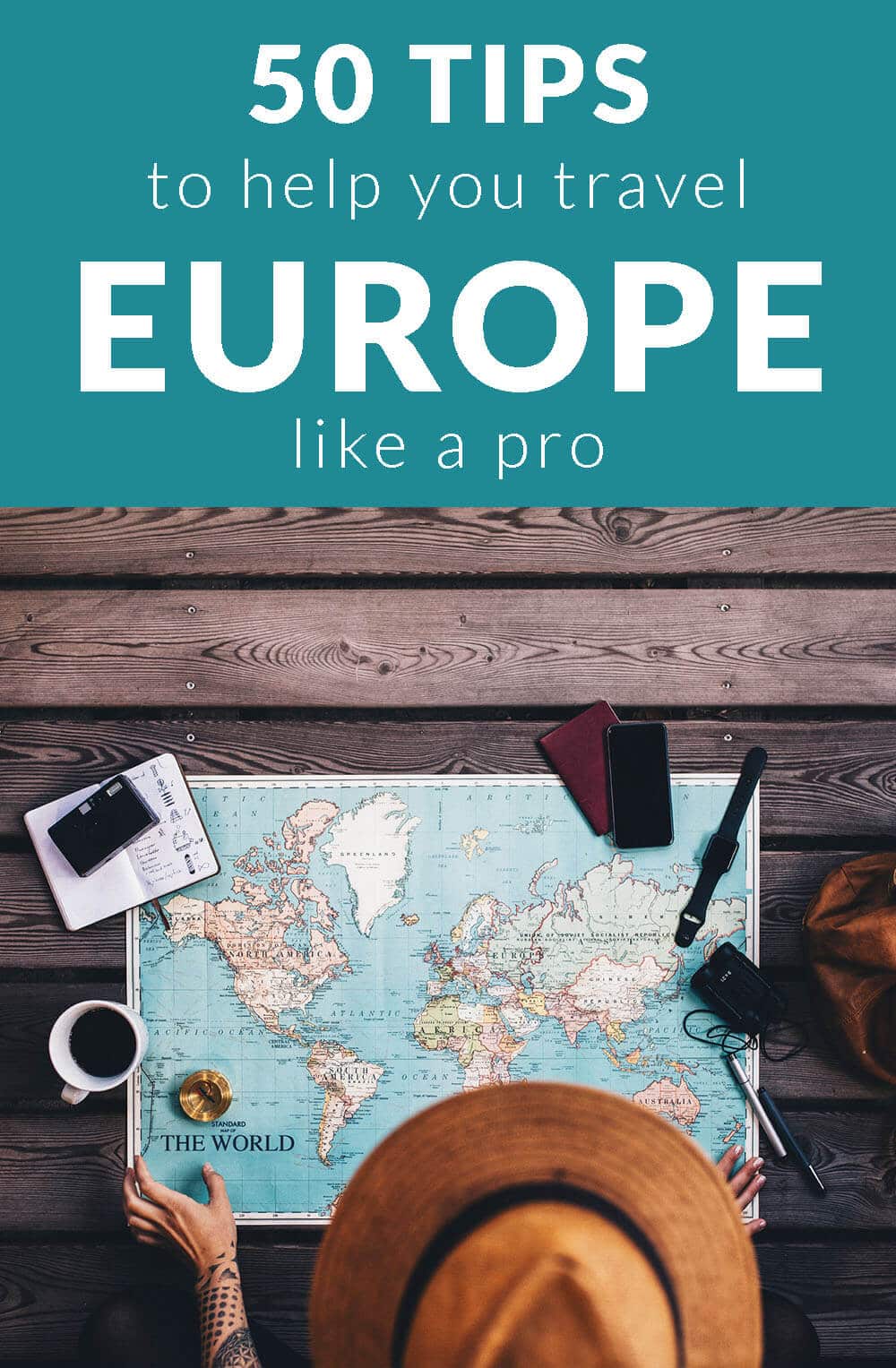
Practical Tips for Booking your Trip
Book Your Flight s and Car Find a budget airlines by using Skyscanner . This is my favorite way to search for flights because they crawl websites and airlines around the globe, so you always know you’re getting the best deal. Learn more tips for finding the best flight deals here. For cars, I like to use Rental Cars because they have good filters and its easy to search for multiple companies.
Book Your Accommodation My preferred way to stay around the world is VRBO . I find it usually gives you a unique local experience in any destination. If you want to stay in a hotel, use Booking , as it consistently gives the cheapest rates for guesthouses and hotels. I use them both all the time.
Always Get Travel Insurance Travel insurance protects you and your family against illness, injury, theft, and cancellations. It’s peace of mind in case anything goes wrong. I never travel without it. I’ve been using World Nomads for the last few years and love how easy it is to use. I have also used Allianz . Compare rates to see which is best for the coverage you need.
Looking for ways to save money on travel? Check out my resource page for the companies I use for traveling! I share everything I use to save me time and money.

Wanderlust Crew
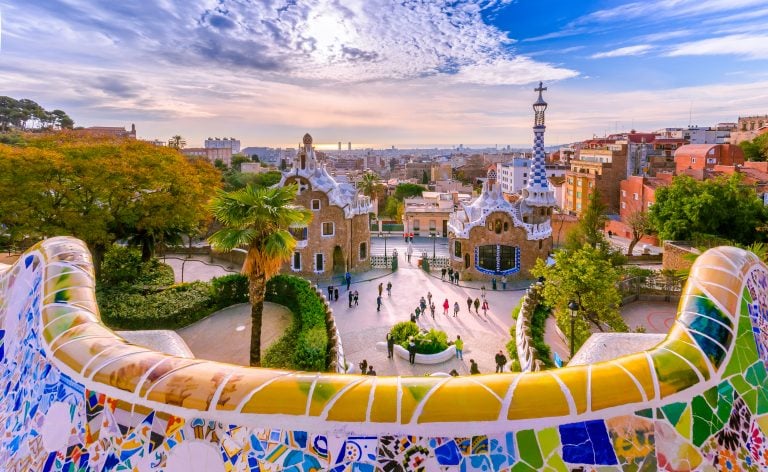
The Ultimate Europe Bucket List: 75 Fun Things to Do in Europe
Curious about the best things to do in Europe–and wondering what exactly to put on your personal Europe bucket list? We have you covered!
We’ve been traveling Europe for years, and every day, week, and month spent traversing the continent seems to result in us crossing several experiences and destinations of our personal European bucket list… only to add twice as many spots to our wish-list for the future along the way.
While we have plenty of guides to planning a practical trip to Europe here on Our Escape Clause (more on that below), this giant list of what to do in Europe is decidedly not that.
If you’re looking to do a little dreaming, on the other hand, this bucket list for Europe–based on a combination of our lived experiences and future travel dreams–is for you.
This list is admittedly incomplete, and always will be: it’s a living document, one that we’ll continue to update as we explore. However, this list of bucket list European tourist attractions and travel destinations is still enough to keep most travelers busy for years.
Here are the best things to do in Europe!
Table of Contents
Once You Narrow Your Europe Bucket List Down…
Unmissable tourist attractions in europe, european bucket list experiences, more fun things to do in europe.
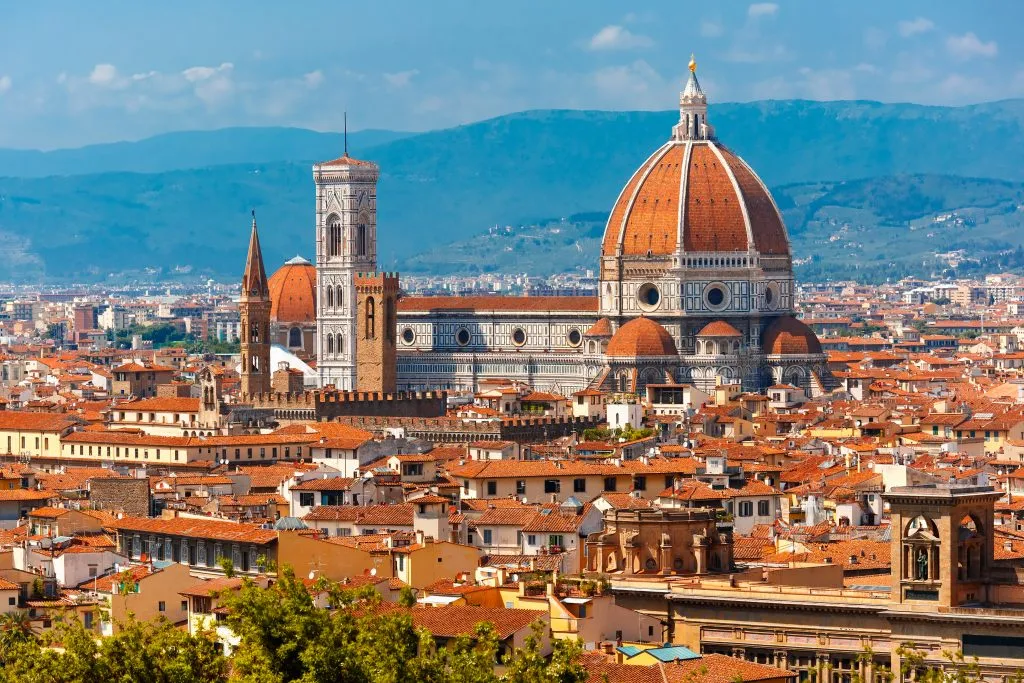
Some links in this post may be affiliate links. If you make a purchase through one of these links, we may earn a small commission at no extra cost to you. Please see our disclosure policy for more detail.
Obviously, no one European vacation could possibly cover all of the tourist attractions, bucket list experiences, and incredible destinations listed here (believe me, if there was a way, we’d be all over it).
Once you’ve narrowed your wish list down ever-so-slightly, we recommend hopping over to our Europe itinerary guide to start finalizing your destinations and putting your trip together!
We also recommend reading this list of essential Europe travel tips before you go, as well as our in-depth guide to traveling Europe by train .
To get your packing list in order, check out our complete guides to packing for Europe in the summer , fall , and winter , as well as our suggestions for what to bring on a long haul flight (knowledge gained through many uncomfortable experiences in the air).
To read more detailed travel tips, guides, and itineraries for the specific countries you’re planning to visit, head to our destinations page .
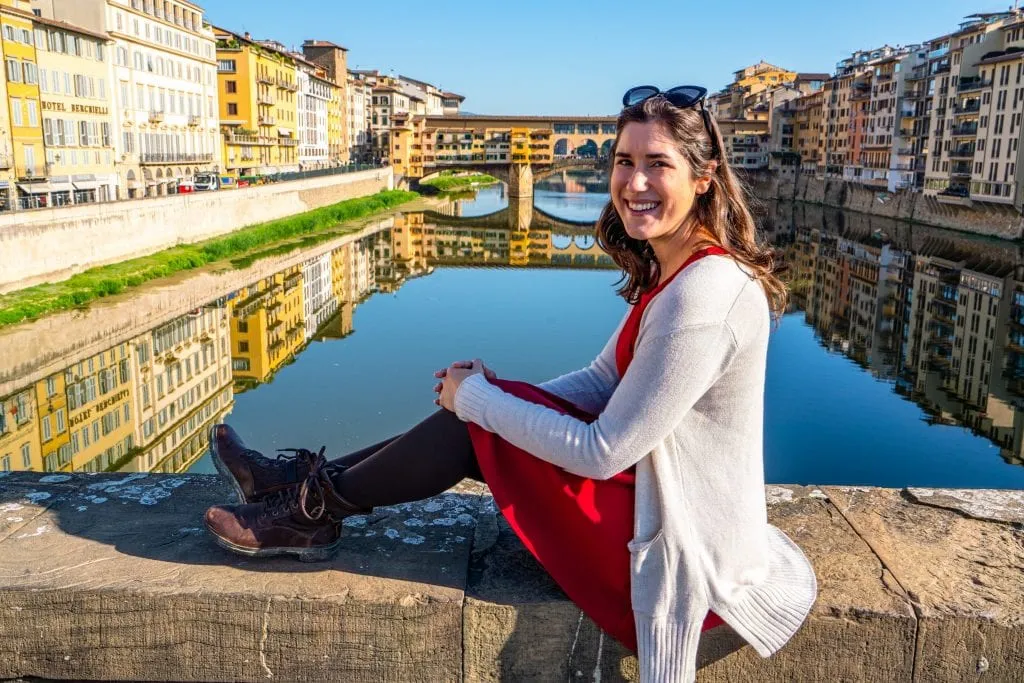
Every one of the Europe bucket list attractions in this section is incredibly famous… but definitely not worth skipping.
Admire the Eiffel Tower from the Trocadero Gardens.
Without a doubt, this is one of the most iconic views on the continent, and enjoying it is one of the best things to do in Europe!

Admire the magnificence of the Sistine Chapel.
As the crown jewel of (and final stop on) a visit to the Vatican Museums, Michelangelo’s stunning Sistine Chapel is far more incredible in person than any photograph could convey.
Just be prepared to share the view with hundreds of others, and to avoid the temptation to photograph it during your trip to Vatican City .
Tour the Acropolis in Athens.
The center of cultural life in ancient Athens is still an incredible sight to behold today, and visiting is part of any Athens itinerary !

Visit Stonehenge in England.
Mysterious, beautiful Stonehenge is the most intricately built prehistoric stone circle on Earth–and its mysteries have been captivating visitors for thousands of years.
As far as experiences in England go, it may be touristy–but that doesn’t mean you should skip it.
Marvel at the Colosseum in Rome.
I’ll never forget the first time that I saw the Colosseum in person: the sheer size of it is incredible, and stepping inside is even more magnificent.
If you book a tour, you can even tour the Colosseum’s underground area beneath the arena.

Take a selfie with the Leaning Tower of Pisa.
Yep, it’s incredibly cheesy… but if you make it out to this town about 30 minutes west of Florence, don’t pass up the chance to have fun being silly!
Admire views of Oia in Santorini.
The picturesque white-and-blue village of Oia more than lives up to the Santorini of so many fantasies.

Check out Big Ben.
London’s iconic clocktower is not to be missed during a trip to the city–and neither is the chance to stay in a memorable London hotel !
Explore the Louvre.
The most-visited museum in the world more than lives up to the hype: packed with art and artifacts spanning thousands of years, no trip to the Louvre could possibly cover it all (and that’s part of the fun).

Marvel at the incomplete La Sagrada Familia in Barcelona.
We all know intellectually that the great cathedrals of European history took decades or centuries to build–but at the incomplete La Sagrada Familia, you can see a modern version of the process in action!
And, if you climb one of the cathedral’s towers, you can even enjoy the view from one of the most striking Barcelona viewpoints at the top!
Visit the ruins of Pompeii.
… and don’t forget to visit the city of Herculaneum, too, which was buried in the same eruption of Mount Vesuvius that Pompeii was.
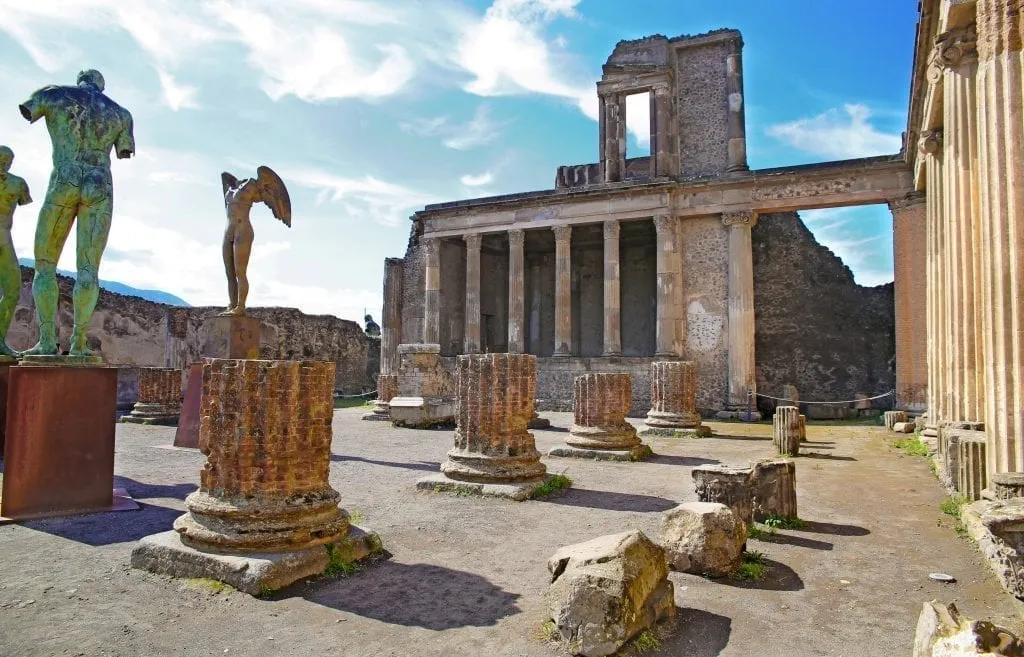
Stand in awe of Skogafoss waterfall in Iceland.
There is no shortage of truly epic landscapes to add to your Iceland bucket list , but perhaps none is as popular or iconic as the incredible Skogafoss.
You can find Skogafoss just off of Iceland’s iconic Ring Road –no hike required.
Be sure to bring a raincoat with you, as that mist is even more powerful than it looks!

Admire views of Florence from above.
Whether you climb Brunelleschi’s dome at the Duomo or admire the stunning cathedral from afar at the Palazzo Vecchio, Piazzale Michelangelo, or one of the other best viewpoints in Florence , admiring the Cradle of the Renaissance from above is one of the best things to do in Europe.
Stroll across the Charles Bridge in Prague.
Built starting in 1357, the ornate Charles Bridge is the oldest bridge in Prague, and for centuries was the only bridge in the city to cross the Vltava River.
The bridge links, among many other things, Prague’s central Old Town with its massive castle complex, both among the best things to see in the city.
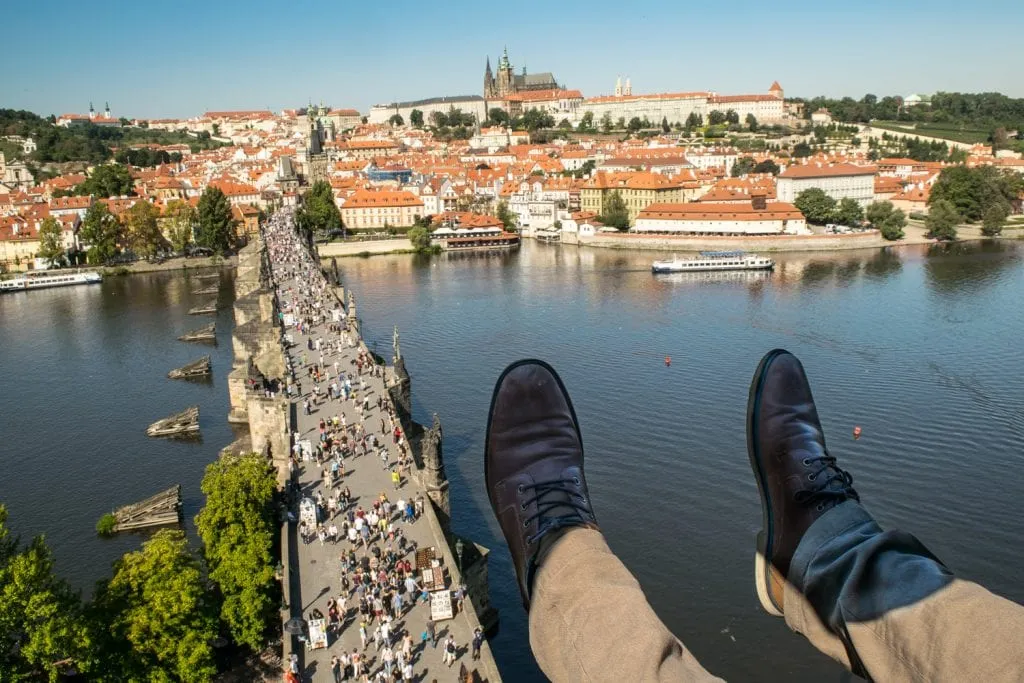
Hike the Path of the Gods along the Amalfi Coast.
Between the villages of Bomerano and Nocelle along the Amalfi Coast runs one of the most beautiful hiking trails in Europe.
The main portion is only about 4 miles, but you’ll be in for quite the workout if you decide to finish by descending from Nocelle to Positano by foot. The views, however, are worth the effort.
Meander through Amsterdam’s historic center.
Riding a bike in Amsterdam can be a bit intimidating, true–but whether you choose to walk or ride, getting lost among the city’s canals is definitely one of the best things to do in Europe!
We highly recommend stopping into a cheese shop or six along the way.
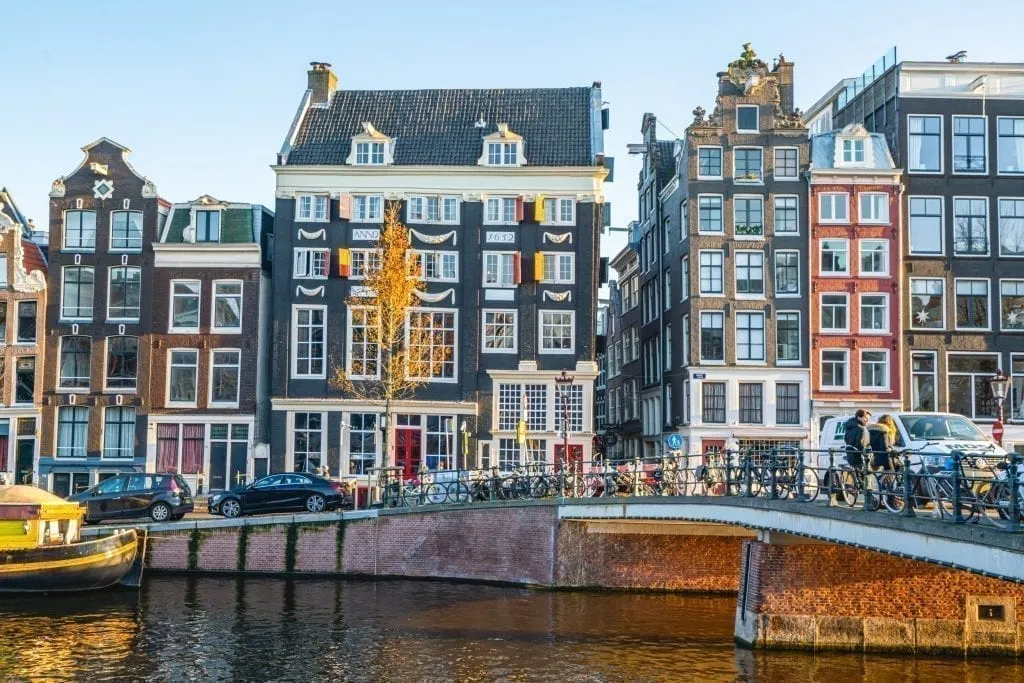
Experience the thermal baths in Budapest.
There are dozens of incredible things to do in Budapest , but few are as unique to the city as the enormous number of thermal baths located right in the city center!
The Szechenyi Thermal Baths in City Park and Gellert Thermal Baths in Hotel Gellert are among the most popular with visitors, and both are worth a visit.
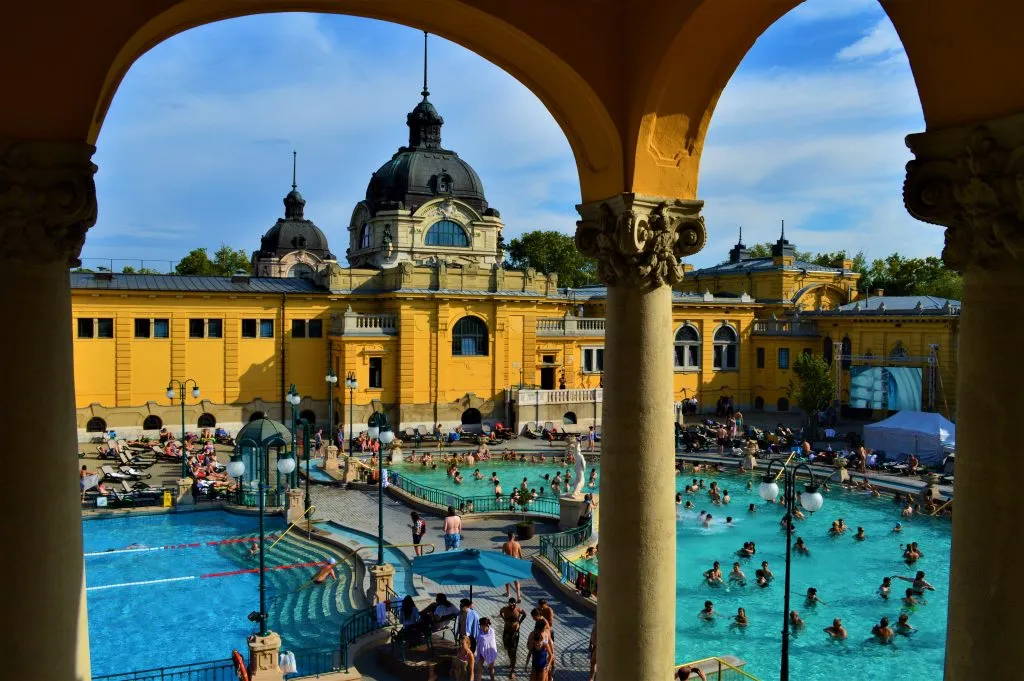
Enjoy a gondola ride in Venice.
Touristy? Absolutely. Expensive? Without a doubt.
There’s no doubt, though, that’s there something magical–not to mention downright iconic, about a gondola ride in Venice !
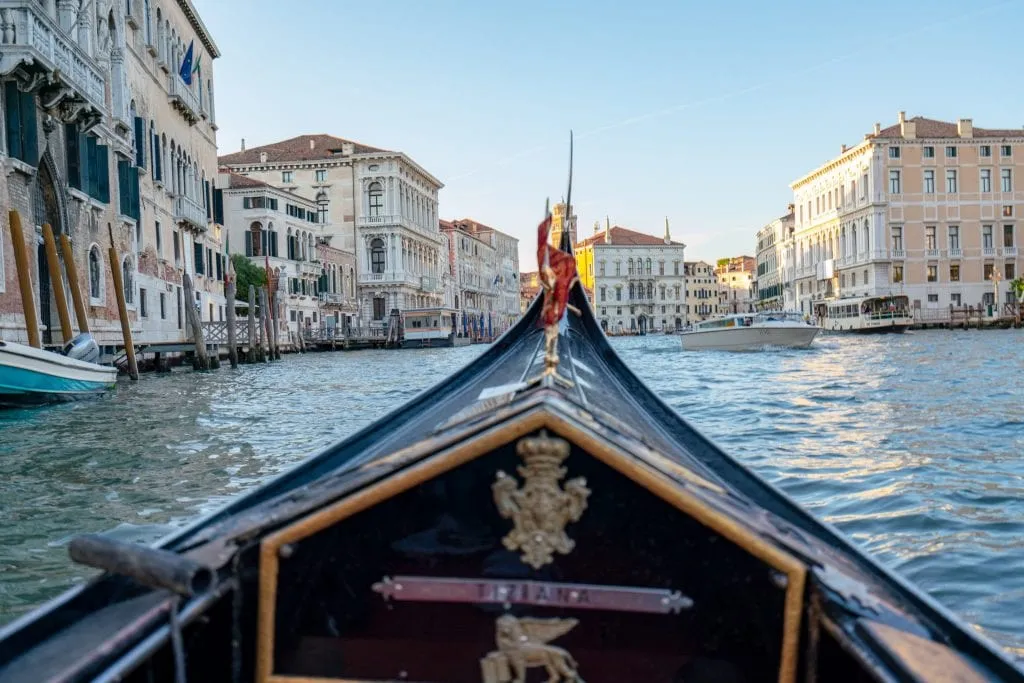
Walk along the Cliffs of Moher.
These beautiful cliffs on Ireland’s Wild Atlantic Way are unforgettable.
While you can hike all the way from Doolin to the cliffs, most travelers start at the Cliffs of Moher Visitor’s Center.
From there, consider walking to Hag’s Head (which should take a bit over an hour each way) to ditch the crowds and enjoy more peaceful views of the Cliffs of Moher .

Order coffee or a meal in the local language.
Sure, you’ll probably mispronounce something the first time, and in popular European tourist destinations you won’t necessarily “need” to speak anything other than English to get by… but there is something incredibly gratifying about learning to speak even a tiny bit of the local language on your trip, and restaurants and cafes are the perfect places to start!
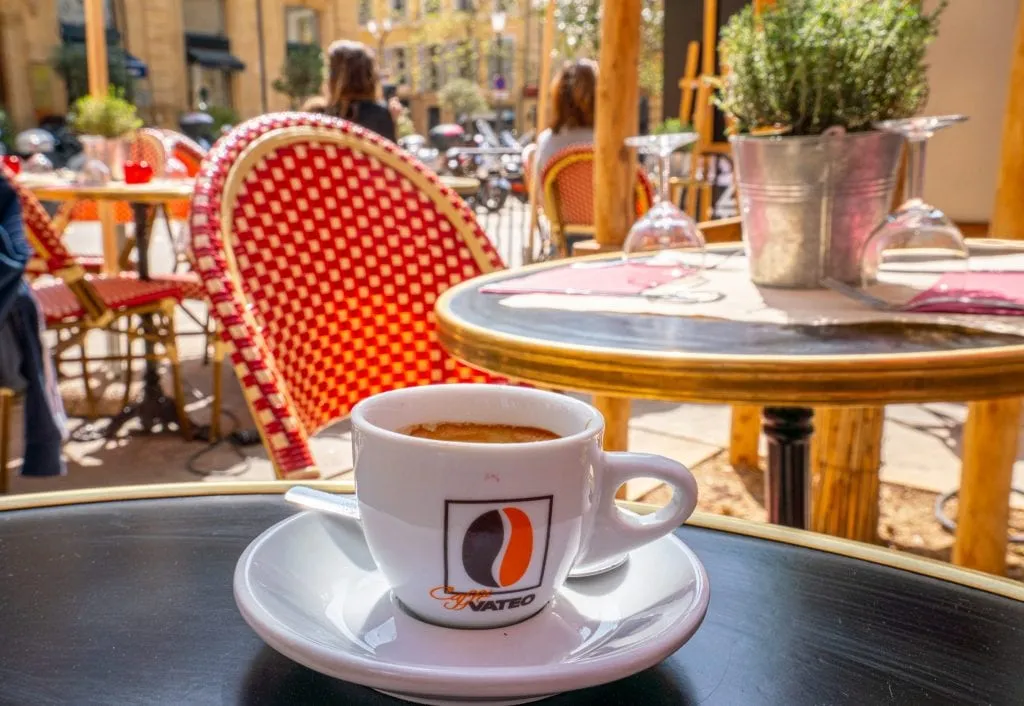
Go dog sledding in Lapland.
For a winter paradise in Europe, you can’t beat dog sledding in Lapland.
Jump into the Blue Lagoon in Malta.
The tiny country of Malta has no shortage of rocky swimming locations, but none are quite as spectacular as the Blue Lagoon of Comino, one of the most popular day trips from the main island and one of the best things to do in Malta .
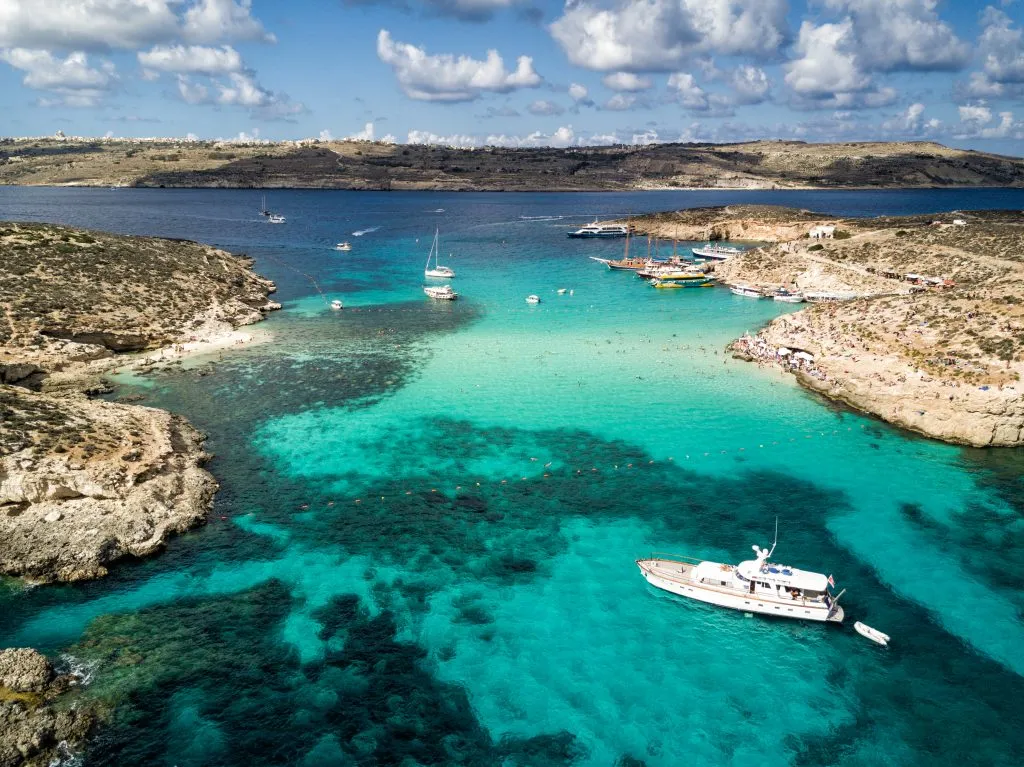
Walk the walls of Dubrovnik.
It’s hard to decide which view from the defensive city walls surrounding Dubrovnik’s Old Town is more incredible: the view looking into the city or the view looking out at the sparkling Adriatic Sea.
Either way, there’s no doubt that this walk is one of the absolute best things to do in Europe, and worth prioritizing when deciding what to do in Dubrovnik .
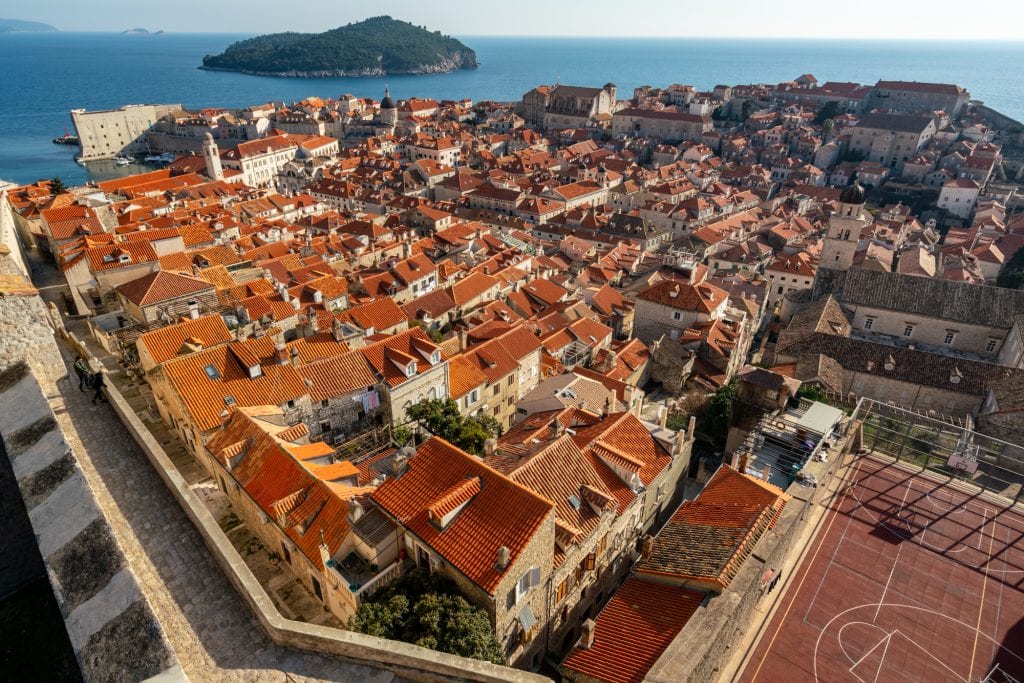
Walk the Camino del Santiago.
True, this Europe bucket list item is at least a week-long commitment (several weeks if you want to do the whole thing rather than just the last 100km), but there’s a reason this ancient pilgrimage attracts more than 200,000 travelers each year.
Drive Germany’s Romantic Road.
From views of the (rightfully) popular Neuschwanstein Castle to the beauty of villages like Rothenburg ob de Tauber and cities like Augsburg, driving Germany’s Romantic Road is one of the best ways to explore the country.
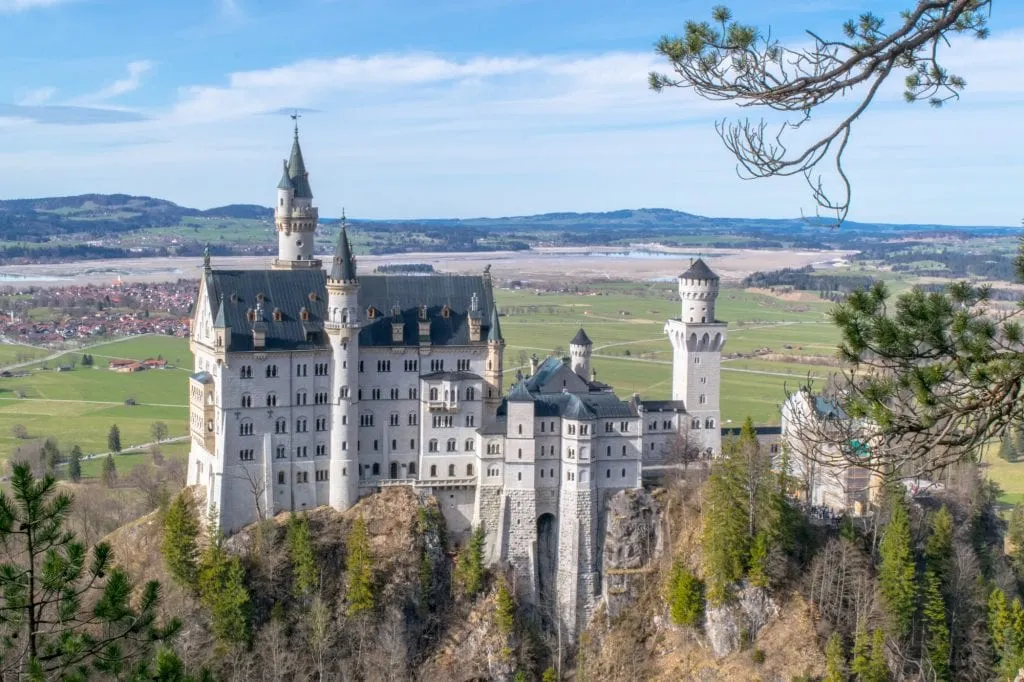
Snorkel between two tectonic plates.
In Iceland’s stunning Silfra Fissure, you can snorkel between the Eurasian and North American tectonic plates–the only place on the planet where you can do so!
Get all of our Silfra snorkeling tips here .

Go wine tasting in Tuscany.
There are European bucket list-worthy level wine regions across the continent, of course, but none has captured the imagination of travelers from across the pond like Tuscany.
Admiring the golden light of the Tuscan countryside from a stone villa while drinking a glass of local wine definitely lives up to the hype!


Soak in the beauty of the colorful harbor of Nyhavn in Copenhagen.
The picturesque, historic harbor Nyhavn may be touristy–but like many tourist attractions in Europe, there’s a good reason for that!
Be sure to add this beautiful spot to your Copenhagen itinerary .
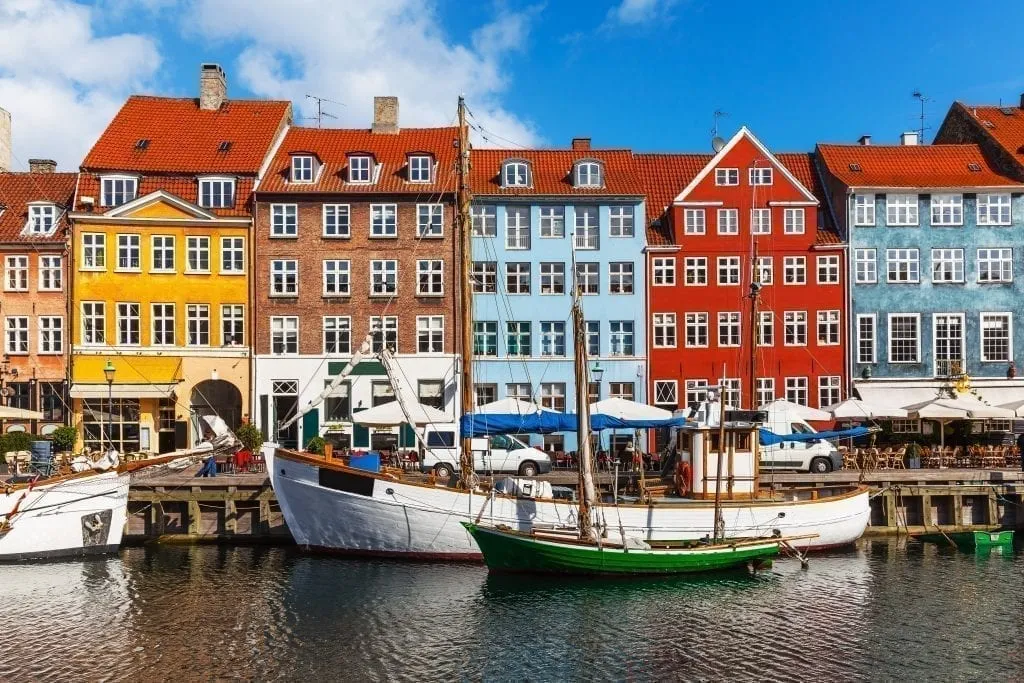
Enjoy afternoon tea in London.
British afternoon tea is a delightful ritual, and nowhere does it quite like London!
Whether you’d like to stick to something traditional in a restaurant or hotel or go all-out with a themed afternoon tea in London (Alice in Wonderland and Harry Potter are both options, as is a tea served on one of London’s iconic double-decker buses), enjoying a full afternoon tea definitely belongs on your list of what to do in London.
Admire the sweeping lavender fields of Provence.
No matter how much lavender you’ve seen in your life, it’s impossible not to be enchanted by the sheer scale of the lavender fields of Provence.
Come summer, you can truly find places in southern France that are coated with fields of purple as far as the eye can see.

Ride a historic tram through Lisbon.
Lisbon, Portugal has many reasons that it is compared to San Francisco, but at the top of the list is definitely its hills… and the charming trams that were built to help citizens contend with them!
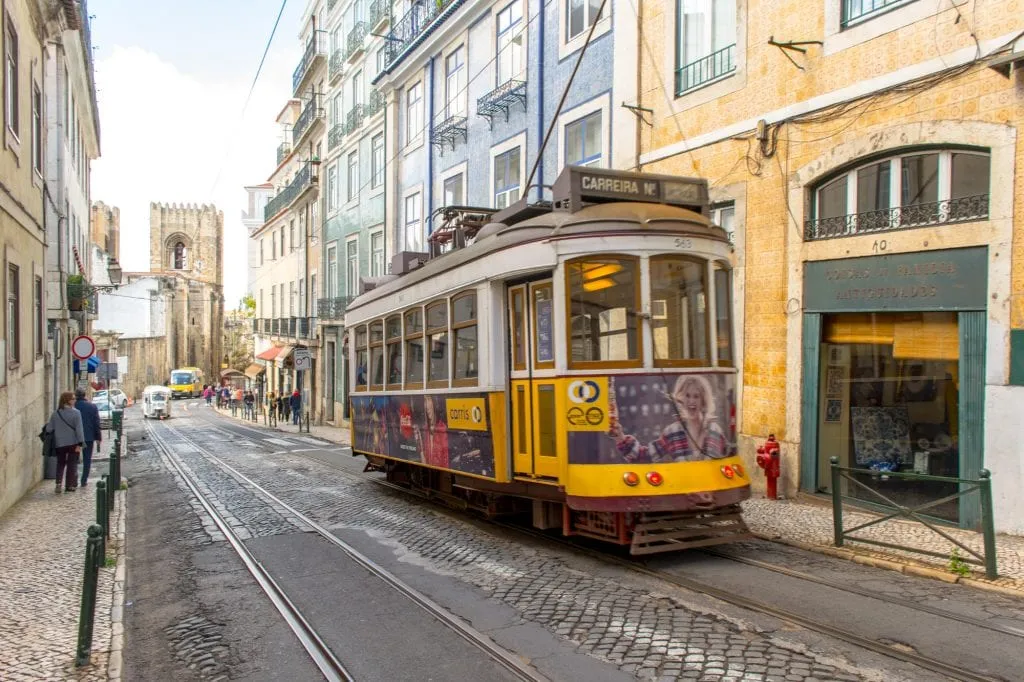
Gamble in Monaco.
It doesn’t have to be a lot of money, of course, but there’s something exciting about stepping into the legendary casinos of Monaco!
Experience European Christmas markets.
Mulled wine, handcrafted gifts, Christmas carols, tasty food, and if you’re lucky (and choose the right city), maybe even a little bit of snow: the best Christmas markets in Europe are truly magical.

Enjoy a drink in an Irish pub.
The cities have some lovely options, but for us, nothing beats a night spent with an Irish beer, some pub food, and live music in a tiny village that is tucked away in a quiet corner of the Emerald Isle.
Marvel at the tulips in the Netherlands.
Intricately organized rows of brightly colored tulips that seem neverending, maybe even interrupted by a picturesque windmill in the background: views like these are worth traveling to the Netherlands for!
The popular Keukenhof Gardens are one of the most common places for travelers to start their tulip-spotting, but there is no shortage of places to admire the flowers each April .

Toss a coin into Rome’s Trevi Fountain.
As legend has it, throwing a coin into the fountain will ensure your return to Rome.
Buy a picnic at an outdoor market, and enjoy it outside!
Cured meats in Italy, cheese in France, olives in Spain (or let’s be real, all three, everywhere), and beyond–outdoor markets are a fantastic part of many European cultures, and shopping for your own picnic adds a fun project that makes exploring them more meaningful and fun.
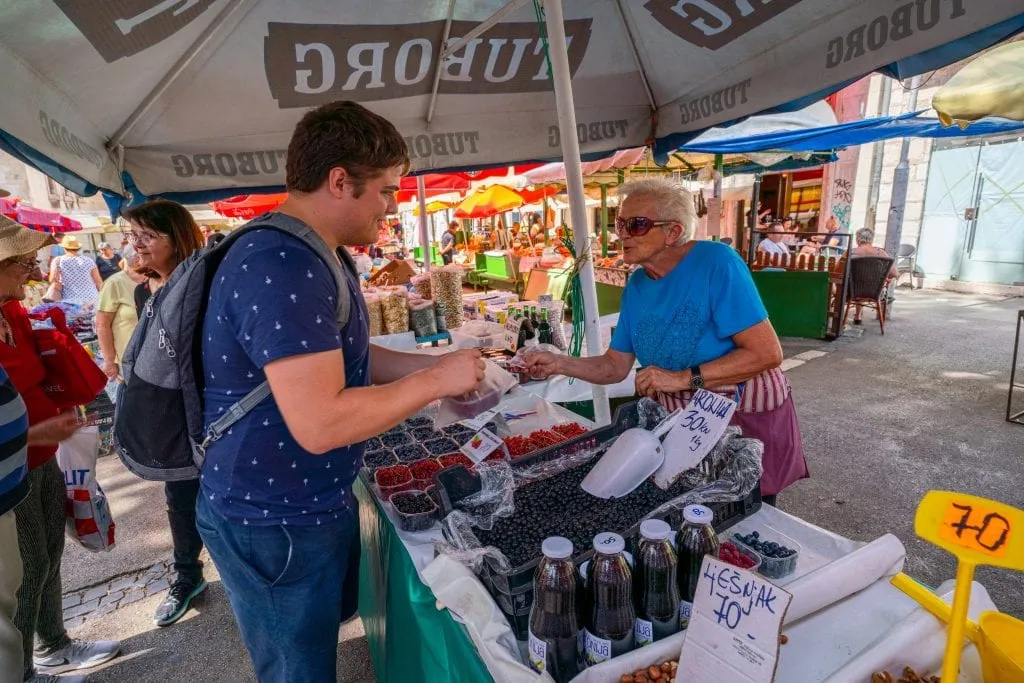
See an opera.
Vienna is the classic travel destination for checking an opera off your bucket list for Europe, but most major European cities boast a stunning opera house that’s worth seeing a show in–even if you’re not the biggest fan of opera.
Visit the fairytale village of Lauterbrunnen in Switzerland.
Overlooked by the towering Staubbach Waterfall, Lauterbrunnen looks like one of those towns that are simply too magical to be real (though, to be entirely fair, quite a bit of Switzerland looks like that!).
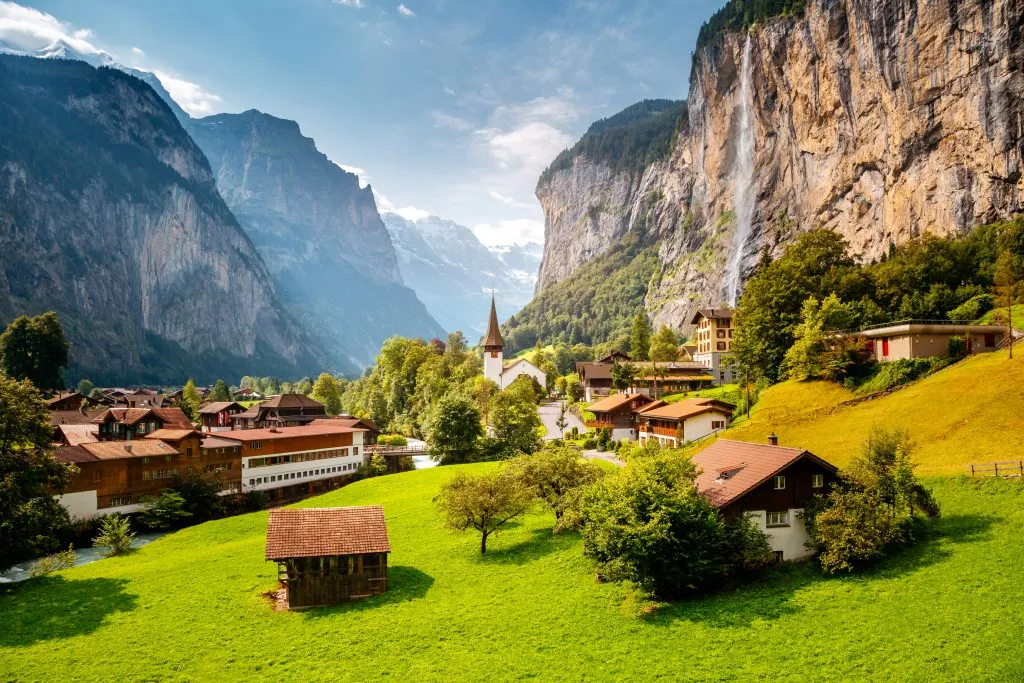
Go island hopping in Greece.
Whitewashed villages, stunning sunsets, the sparkling sea, and positively scrumptious food are just a few excellent reasons to enjoy Greece’s island life!
Despite their many similarities, Greek islands vary dramatically in culture and things to do–a trip to Santorini or Mykonos is not remotely the same as one to Crete or Zakynthos.
Hike to San Giovanni Fortress in Kotor, Montenegro.
The climb to San Giovanni Fortress rewards hikers with sweeping views of both the town and Bay of Kotor, and it’s both one of the best things to do in Kotor and a fantastic way to spend a morning in Montenegro.
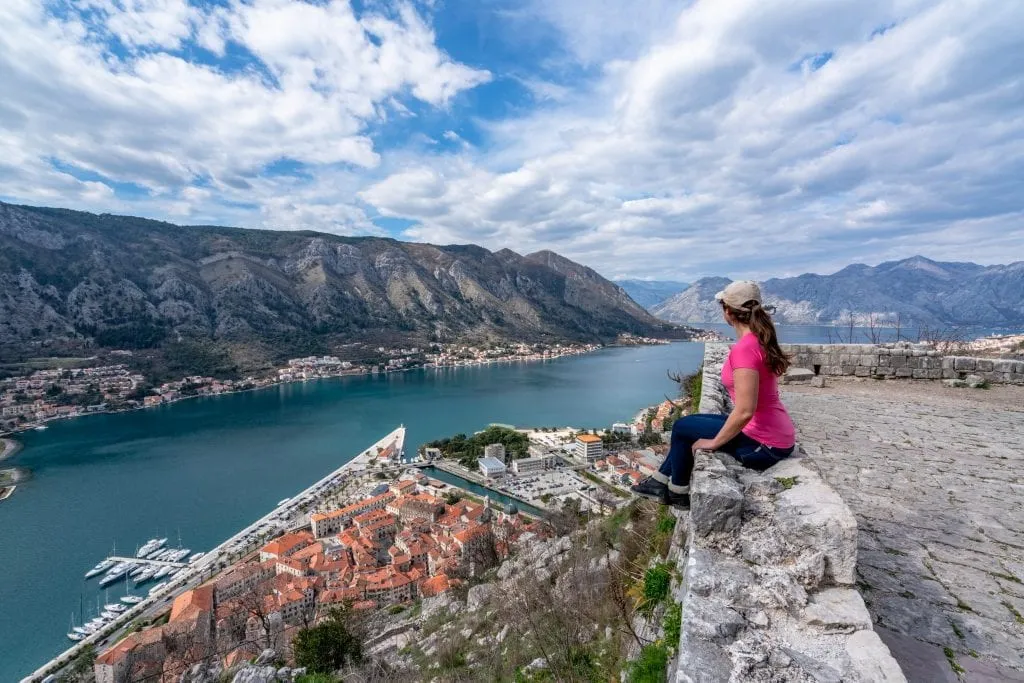
Step inside a beautiful church.
Whether it’s one of the most famous churches in London , Paris, or Rome, or a quiet community church in a small town, the art, architecture, and history you can experience throughout the churches of Europe is not to be missed.
Take a European road trip.
Deciding which of the best road trips in Europe is right for you is a near-impossible challenge… but no matter which destination (or destinations!) you choose, it’s sure to be unforgettable.
Some of our favorite bucket list European road trips so far have been in Tuscany , Provence , Sicily , Ireland , Southern Spain , and Croatia –but there are many more to come in the future.
A Norway road trip in the summer, a Transylvania road trip, and a Scottish Highlands road trip are all at the top of our wish list!
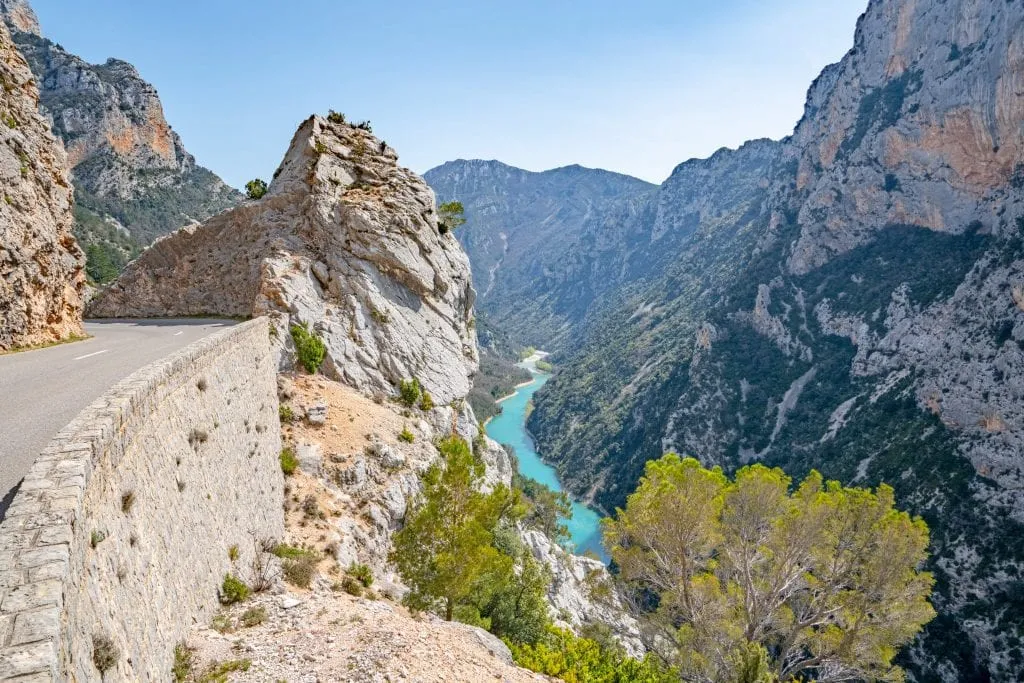
Attend Oktoberfest in Munich.
There’s nothing like the gigantic–and let’s be real, overwhelming–Munich Oktoberfest!
With 16 enormous (and distinct) tents to experience and a whole new lingo and culture to learn, it’s worth donning lederhosen or a dirndl to experience this over-the-top festival.
Eat street food.
A crepe in Paris, a waffle in Belgium, a kebab just about anywhere: the food itself doesn’t matter nearly as much as the experience of ordering and enjoying it!

See the northern lights.
Whether it’s in Iceland , Sweden, Norway, Finland, or even Scotland, the northern lights are a magnificent spectacle that belongs on your European bucket list.
Enjoy the beaches of Sardinia.
This isolated island off the coast of Italy is one of the most distinct regions in the country–and, despite the fact that it is rarely visited by tourists from outside of Europe, it’s home to some of the most stunning beaches on the continent!
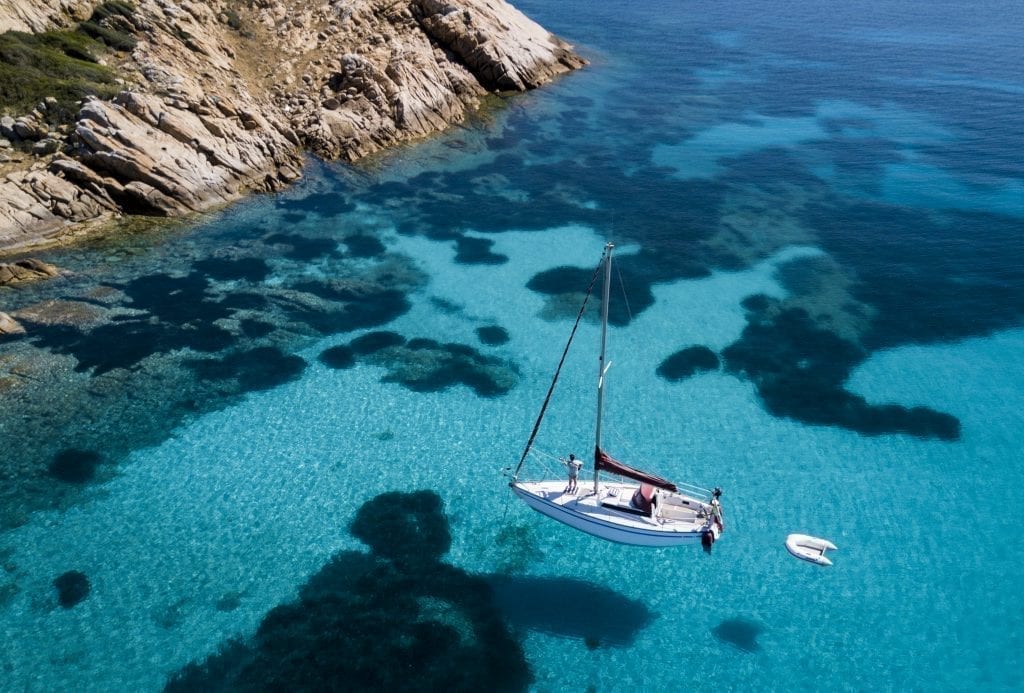
Take public transportation.
Not only is it often the easiest way to get around, but it’s also a fantastic way to learn about the place you’re visiting!
… and an overnight train.
Sure, it may not be the most comfortable sleep you’ve ever had, but there’s something exhilarating about overnight travel via train.
If you’ve never tried it, consider crossing it off your European bucket list on your next trip (plus, it’s better for the environment than flying, anyway).

Take a canal cruise in Bruges.
The city of Bruges, Belgium looks exactly like what a non-European tourist expects Europe to look like before arriving–in other words, like an ancient city worthy of being the setting of a fairytale.
With a description like that, it’s no surprise that Bruges is one of the most romantic cities in Europe .
And, there’s no better place to appreciate the city’s beauty than from the water!
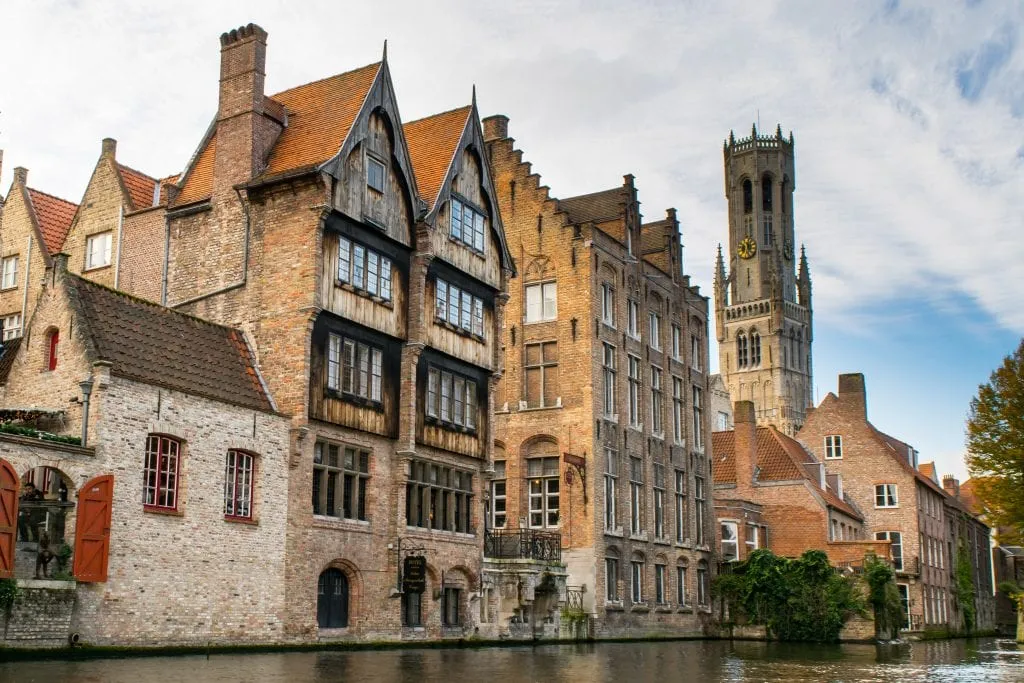
Explore the villas of Lake Como.
From Bellagio to Lecco and beyond, the towns and cities dotting the edges of Lake Como are known for their stunning views and opulent villas.
Road trip the Scottish Highlands.
Whether you’re inspired by Outlander, Harry Potter, the temptation of a good glass of scotch whisky, or simply the sweeping landscapes of northern Scotland, road tripping the NC 500 will take you to some of the most beautiful–and in the case of the sparkling turquoise beaches, unexpected–corners of Europe.

Take a food tour.
We’re big believers in food tours: not only will you be able to participate in what is usually a fascinating walking tour of the city in between meals, but you’ll also have a chance to try several different local dishes… without having to commit to ordering a whole portion.
Over the years, in European cities as diverse as Rome , Istanbul, Palermo, and Athens , we’ve discovered new favorite dishes and city streets on food tours!
… and a cooking class.
Looking for something even more hands-on than a food tour? Try a cooking class!
Italy and France are popular choices for these, of course, but you’ll find them all across the continent.

Row to Bled Island.
Tiny, beautiful Bled Island, perched in the center of Lake Bled, is one of the best places to visit in Slovenia .
The best way to check visiting this island off your list of fun things to do in Europe? Row your way across the lake!
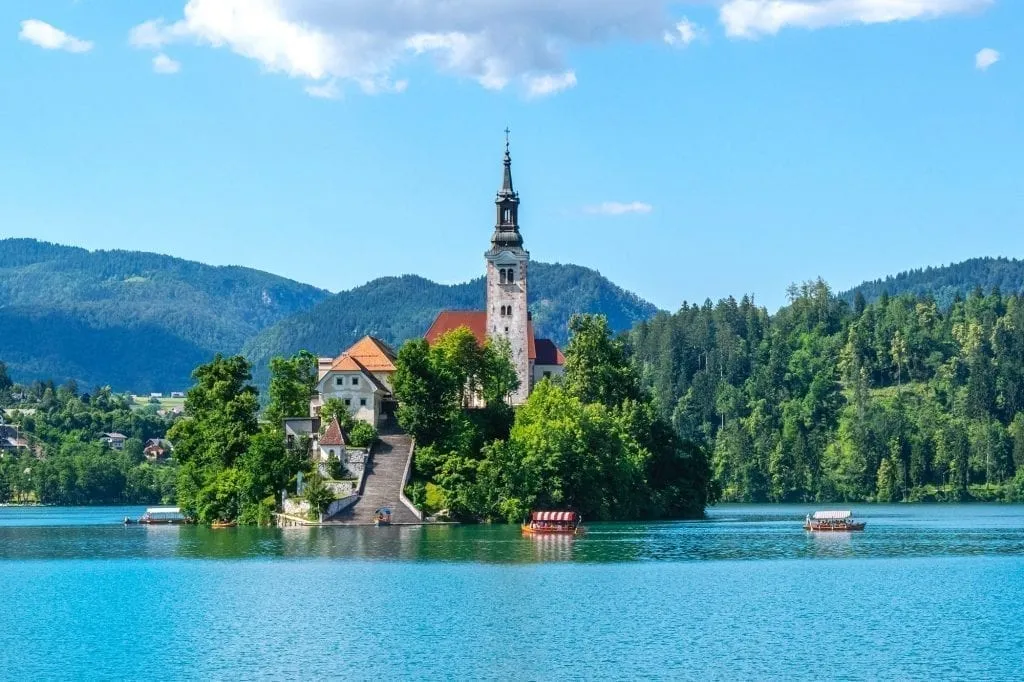
Explore Mont Saint-Michel.
Set on an island off the coast of Normandy, Mont Saint-Michel was once famous for only being able to be reached at low tide.
That changed with the completion of a bridge to the island in 2014, however, the charm of the compact island featuring a monastery dating back to the 8th century is still absolutely present.
Visit the tiny country of San Marino.
Landlocked by Italy, San Marino styles itself as the oldest independent republic in the world–and it also happens to be incredibly beautiful.
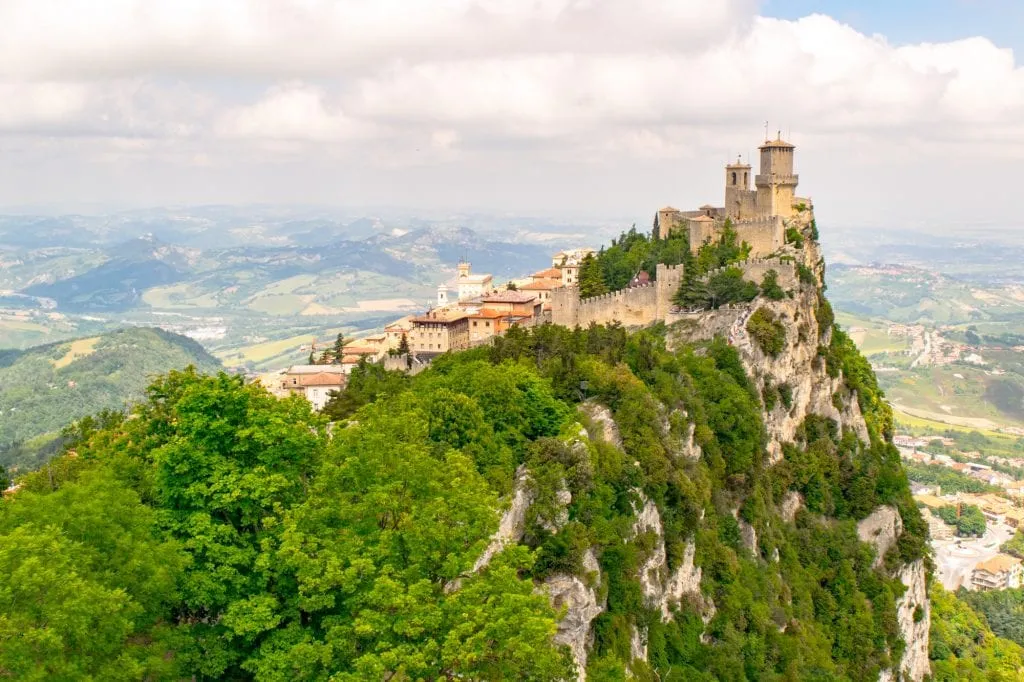
Set sail to Svalbard.
The isolated Norwegian archipelago of Svalbard is known for its glaciers, its arctic landscape, its incredible beauty, and–above all–its polar bears.
It’s far from the easiest (or cheapest) European bucket list destination to check off your list, but it’s also absolutely unforgettable.

Experience a sauna in Finland.
The Finnish take their cultural tradition of sauna extremely seriously, and taking part in the sauna experience is one of the many fun things to do in Europe (just make sure to check your modesty at the door).
Tour the catacombs of Paris.
Six million skeletons may not be the first thing you think about when planning what to do in the City of Light, but you’ll never forget visiting the catacombs in Paris !

Soak in the beauty of Hallstatt.
The small town of Hallstatt, Austria is often considered one of the most beautiful small towns in Europe–and looking at it, there’s no mystery as to why!
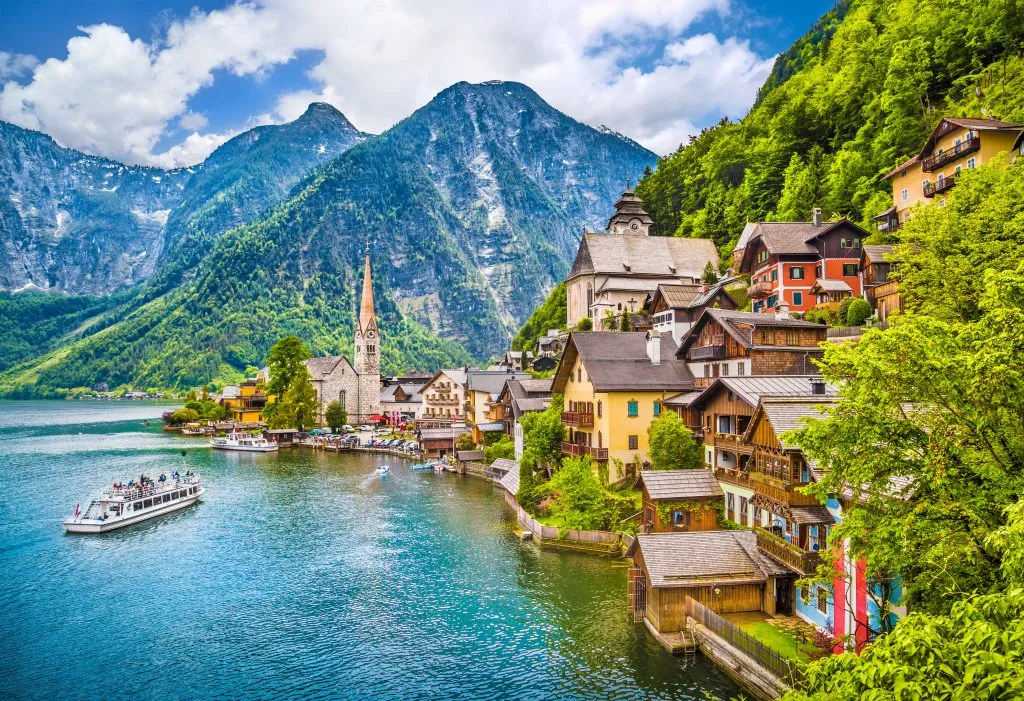
Go for a hike in Croatia’s Plitvice Lakes National Park.
Plitvice Lakes National Park happens to be one of my favorite national parks on the planet, and in my opinion, it belongs on any list detailing what to do in Europe.
Made up of 16 interconnected lakes that are knitted together by a series of stunning waterfalls, it’s hard not to fall in love with these beautiful turquoise lakes.
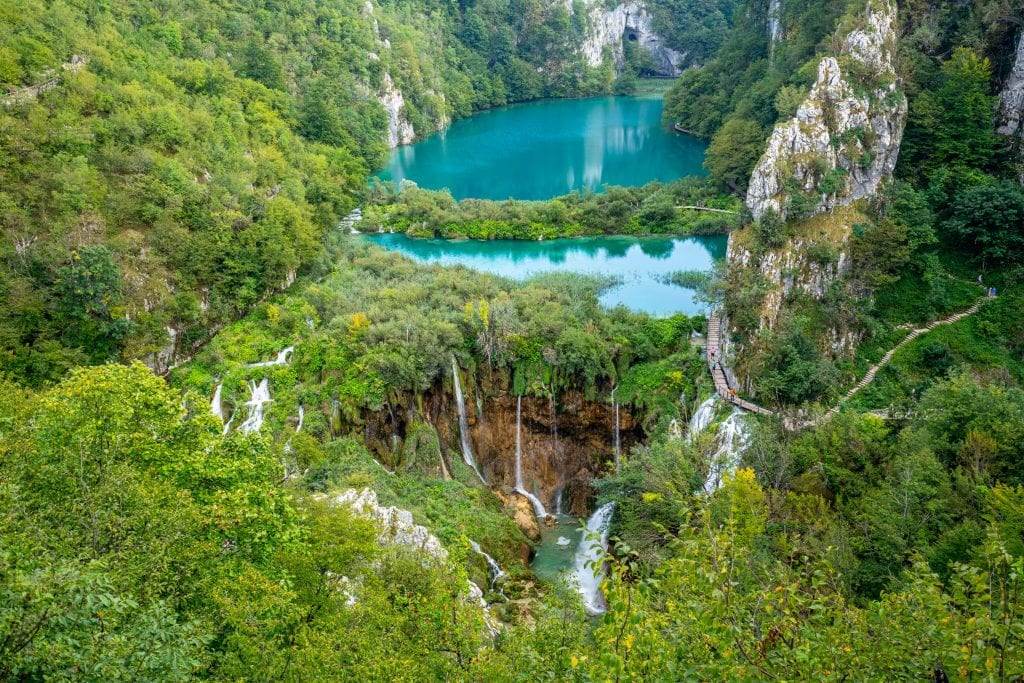
Take a sunrise stroll through your favorite city.
Whether it’s Paris or Rome, Budapest or Istanbul, there’s some magical about a European city at dawn–consider walking to some of the city’s best tourist attractions to see them both bathed in beautiful early morning light and without crowds!
Explore the castles of Transylvania.
The gorgeous Romanian region of Transylvania lends itself to legend–helped, along, of course, by its association with Dracula.
While the Dracula story is based on Vlad the Impaler, the majority of the legend is of course firmly in the realm of fiction.
However, that doesn’t take away from the magic of visiting Bran Castle, as well as other stunning Transylvanian castles like Peles Castle and Corvin Castle.
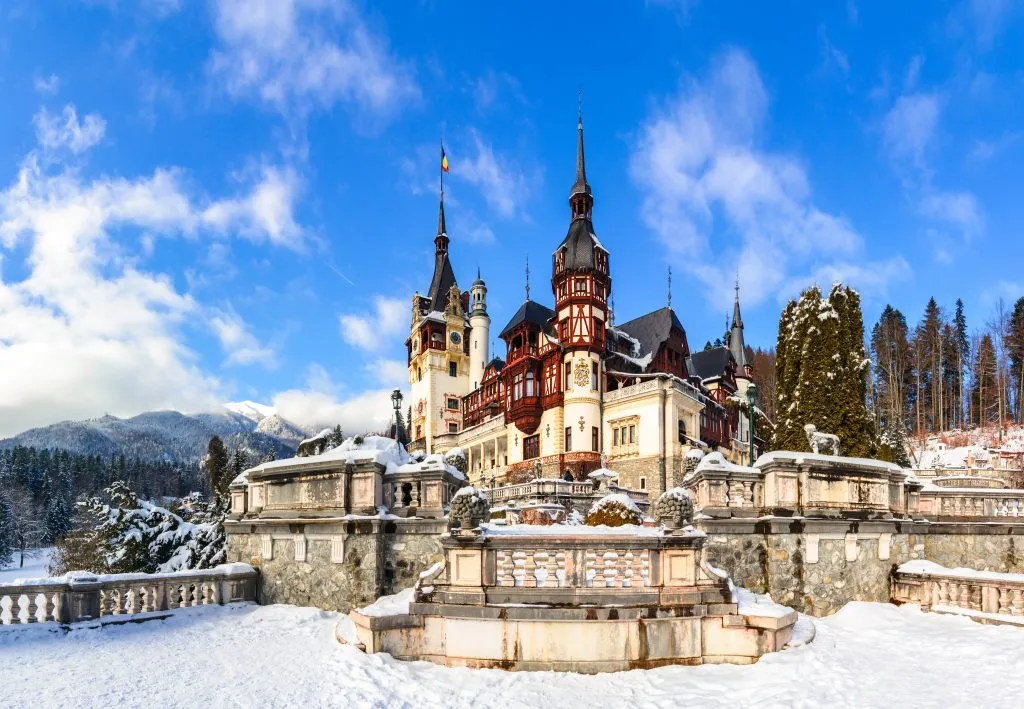
Take a tour of one of the world’s best museums.
Even if art history isn’t exactly your subject of choice, taking an organized tour of one of Europe’s great museums absolutely belongs on your Europe bucket list!
Visiting museums like the Uffizi, the Louvre, the Vatican Museums, and the Prado independently can be lots of fun, but there’s something incredibly special about having the history and context of various works brought to life with a live guide.
You don’t necessarily need to book a tour for every museum you visit–but once in a while, it’s definitely worth the splurge.

Take a day trip to Asia.
A quick ferry ride across the Bosphorus Strait in Istanbul is all you need in order to take a day trip to Asia from Europe!
Eat pizza in Naples.
There’s a reason that pizza in Naples is widely considered to be some of the best in the world!
Absolutely delicious, with a delightfully chewy crust and a focus on very fresh, but minimal, ingredients, tucking into a true Napoli-style pizza in Naples is an experience that can’t quite be recreated anywhere else.

Get off the beaten path with a visit to the Faroe Islands.
Stunningly beautiful, the isolated Faroe Islands are one of the least-visited corners of Europe… but their dramatic landscapes make it well worth the effort.
… and the Azores.
Sometimes referred to as the “Hawaii of the Atlantic”, this archipelago of Portuguese islands makes for an unforgettable adventure.
Hike on a volcano, visit some incredible lakes, tour historic forts, and get underground at stunning caves during your Azores adventure.
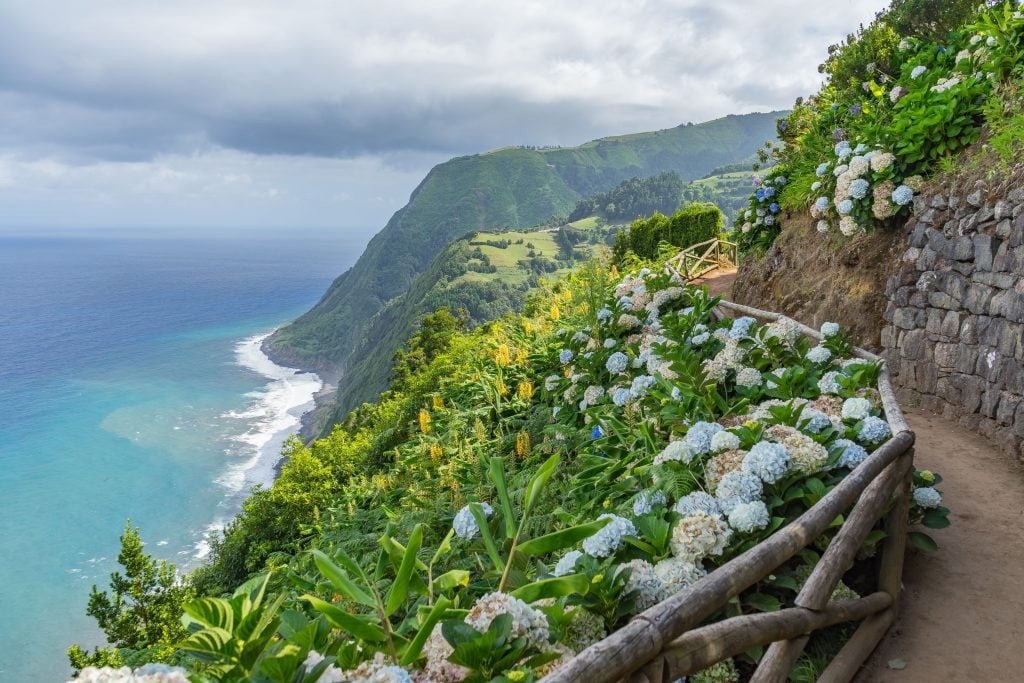
Tour a church decorated with bones.
From the mummies of Sicily to the Capuchin Crypt of Rome, and from the Sedlec Ossuary in the Czech Republic to the Capela dos Ossos in Portugal, there is a startling amount of artwork in Europe constructed with human remains–most of it in or underneath churches or monasteries.
Though quite unsettling on the face of it, these places are also incredibly interesting.

Eat tapas (and churros) in Madrid.
Madrid is well-known for its late-night culture, where bars and clubs often stay open until dawn.
Want to enjoy Madrid’s nightlife in a different way? Enjoy several plates of tapas at various bars, and follow it up with a late-night serving of churros!
They’re amazing year-round, of course, but churros con chocolate are a particular highlight of visiting Madrid in winter !

Explore the villages of Alsace.
Of all the storybook-worthy towns in Europe, it’s arguable that the villages of Alsace, France are among the most picturesque.
Tucked in a corner of northeastern France and home to a distinct culture that blends French and German influences, Alsace is known for its wine, its food, and its Christmas markets.
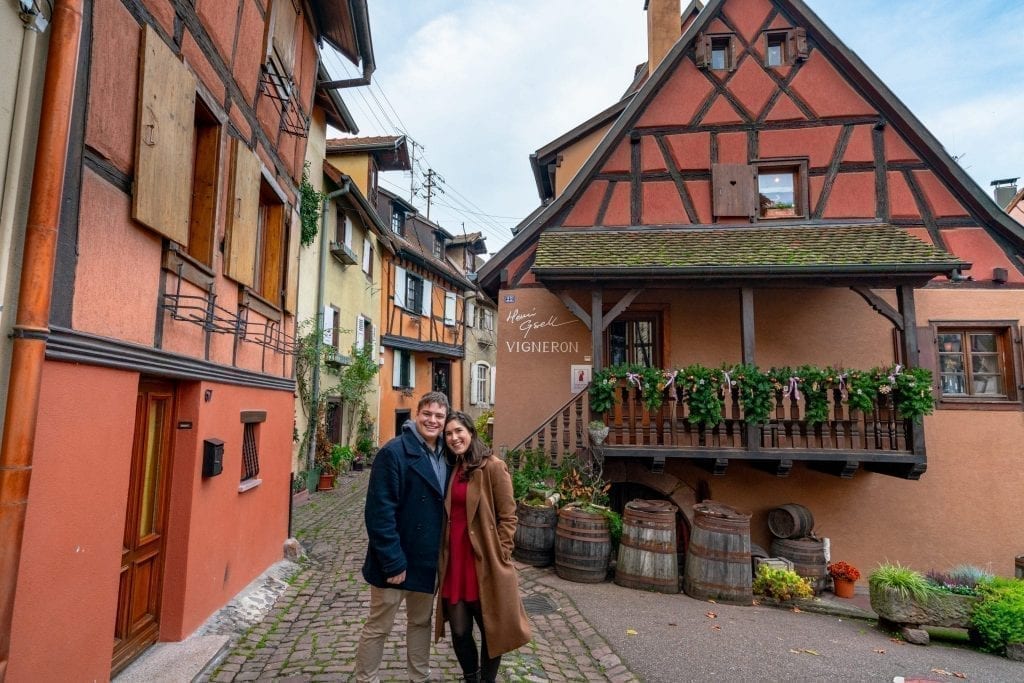
Spend the night in a castle.
From Ireland to France and beyond, there are plenty of opportunities to sleep in beautiful, historic locations–but none are quite as worthy of a Europe bucket list as the idea of sleeping in a castle!
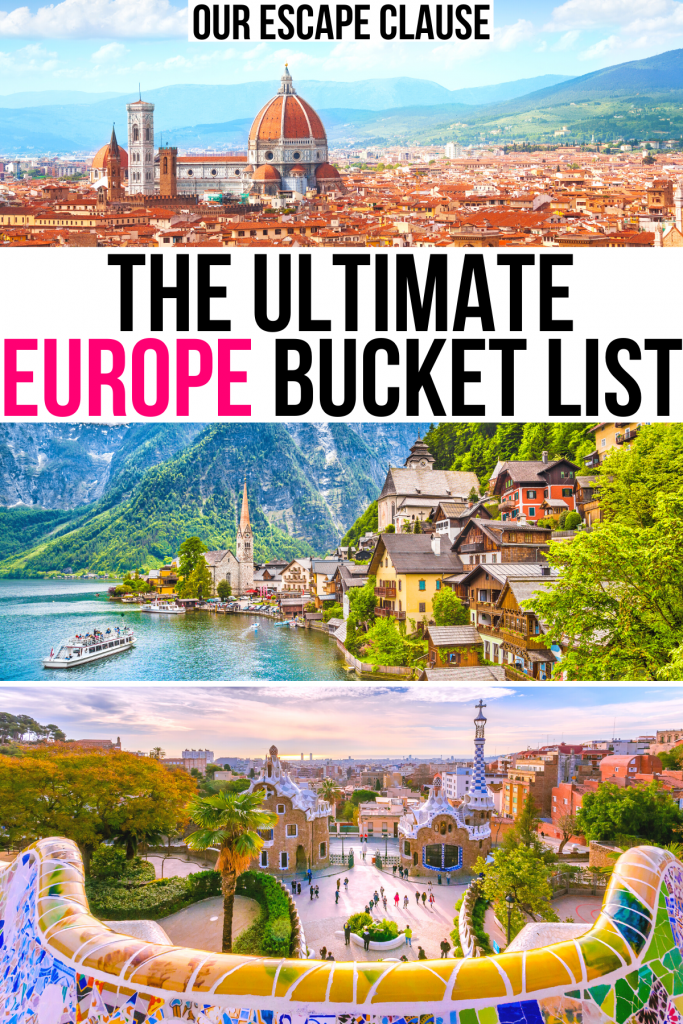
About Kate Storm

In May 2016, I left my suburban life in the USA and became a full-time traveler. Since then, I have visited 50+ countries on 5 continents and lived in Portugal, developing a special love of traveling in Europe (especially Italy) along the way. Today, along with my husband Jeremy and dog Ranger, I’m working toward my eventual goal of splitting my life between Europe and the USA.
3 thoughts on “The Ultimate Europe Bucket List: 75 Fun Things to Do in Europe”
Thanks for this Kate, I had a blast! Very informative too. Nice to know you lived in Portugal. Godspeed.
amazing and sooo true! i’ve been to most of the places and agree 100%!! so when you recommend places and things that i haven’t done, i truly know you are an expert & have added them to my list! thanks so much! i was looking for something like this to plan our upcoming trip!!!
Thanks so much, Nicky! Happy travels! :-)
Leave a Comment Cancel reply
Finding the Universe
Travel tales, photography and a dash of humor
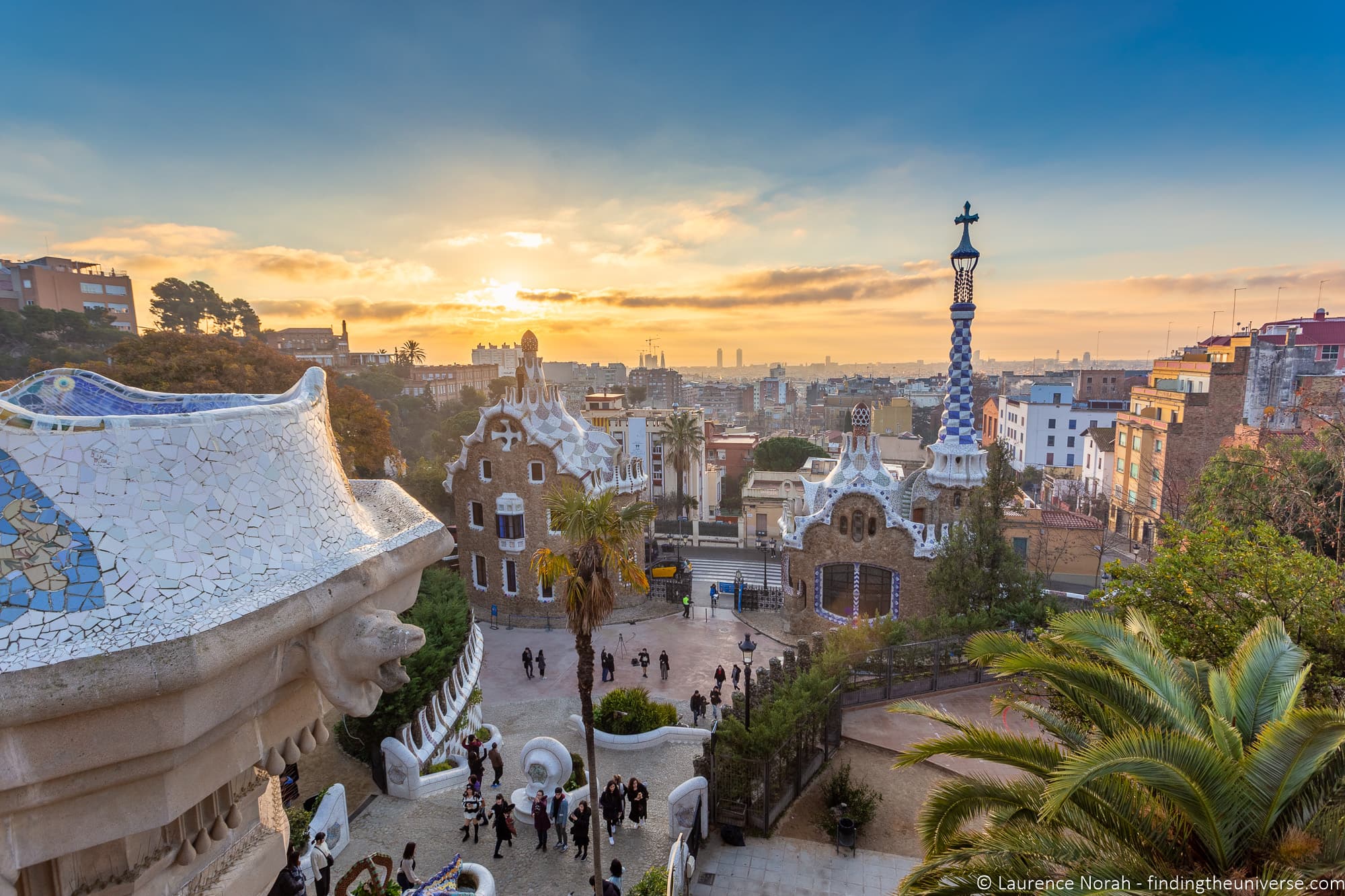
2 Weeks in Europe – The Perfect Europe Itinerary
Last updated: January 28, 2024 . Written by Laurence Norah - 30 Comments
Are you visiting Europe and looking for the perfect itinerary? Well, you’re in the right place! We’ve travelled extensively in Europe, and based on our experiences, we’ve put together a detailed 2 week Europe itinerary to help you plan.
This Europe itinerary will take you to many of the highlights that we think first time visitors to Europe will want to see and explore for themselves. These include many of our favourite destinations that we’ve visited multiple times over.
This itinerary is aimed at those of you visiting Europe for the first time, or those of you looking for an easy itinerary to follow that covers some of the major highlights of Western Europe. It’s not overly rushed as we think you will get more from your experience if you focus on a few major locations rather than trying to see everything in one go.
The trip as outlined is for 14 days in Europe, but you could make it longer or shorter depending on how much time you have. For example, with 10 days in Europe, you could clip off a day or two in some of the cities, and maybe even skip one of the cities to make it a more comfortable experience.
As well as the itinerary, we’re also going to share everything you need to know to help you plan the perfect European trip. Tips about currency, what to pack, where to stay, how to get around and other considerations.
Hopefully this guide will give you everything you need to know to plan your own perfect European adventure, and of course, we’re always happy to answer your questions in the comments. Now, let’s get started!
Table of Contents:
2 Week Europe Itinerary
This two week itinerary has you visiting four European countries and five cities. We think these cover some of the top highlights of Europe.
The destinations on this itinerary are all cities, so this trip is aimed more towards those of you looking to explore the cities, which are all full of cultural highlights, fantastic restaurants, and plenty of photo-worthy sights!
But if have your eye more on smaller towns, secondary cities, and rural locations, this might not be the best itinerary for you.
If you’d prefer to focus on one country, take a look at our two week UK itinerary , and our 10 day Italy itinerary for some inspiration.
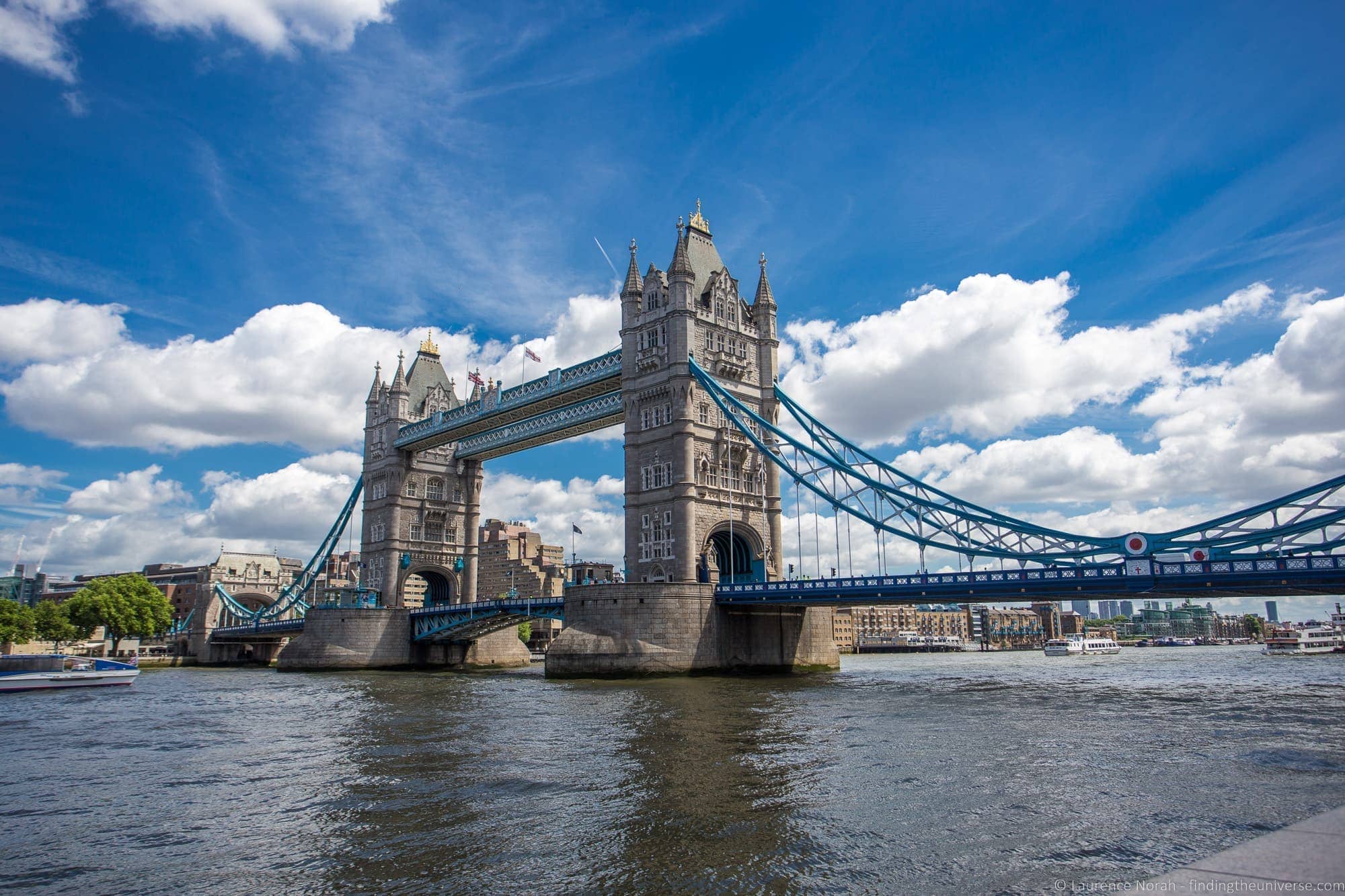
Days 1 – 3: London
We’re going to start your European adventure with 3 days in London . London makes a great starting point for your European itinerary. It has a number of international airports to choose from, so getting here is easy, and there are a wealth of sights and cultural attractions to immerse yourself in. I lived in London for a number of years, and it’s still one of my favourite cities in the world.
If this is your first overseas trip and you are coming from an English speaking country, London is a good place to ease yourself into the experience. You can acclimate yourself to the time difference and get used to travelling in a new country, without having a language barrier to work with as well.
We think 3 days is a good amount of time to spend basing yourself in London. We’d suggest spending at least two days exploring the capital, and perhaps one day trip outside of London. This might look as follows.
On your first day in London, we’d suggest seeing the major sights around Westminster. This includes the Houses of Parliament , Westminster Abbey , Trafalgar Square, Covent Garden, the Churchill War Rooms , Buckingham Palace and the London Eye .
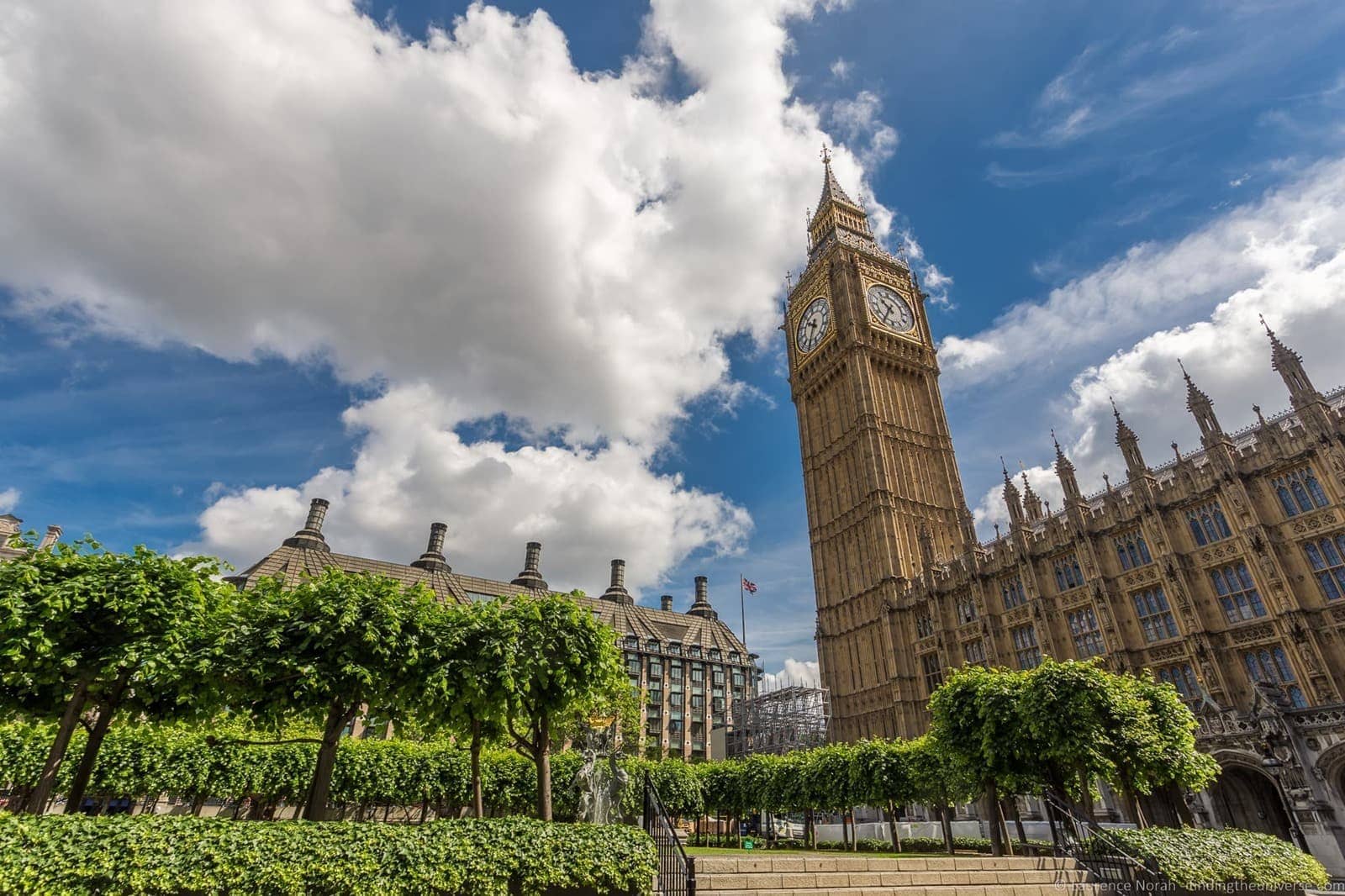
On your second day, which will be a full day, we’d suggest starting at the Tower of London . Get here when it opens to avoid the crowds if you can. Included on the London Pass , or y ou can buy a ticket online in advance here . Using our link saves you some money on the adult admission price for the Tower of London, meaning these discounted Tower of London tickets are some of the best value we’re aware of.
We also recommend checking prices via GetYourGuide here , and on the official website here , as pricing can vary. You can also see opening times and other information for your visit on the official site.
Once you are done with the Tower of London, you can see more sites in the area like Tower Bridge , Borough Market (a London Harry Potter filming location ), St. Paul’s Cathedral , the Tate Modern , Shakespeare’s Globe and the Shard .
You certainly won’t run out of things to occupy your time! For some more inspiration, see our guides for 2 days in London and 3 days in London . We also recommend picking up a two day London Pass to save money on your sightseeing while in London. You can do that here .
On your third day in the UK, we recommend taking a day trip out of the city. This could be to somewhere like Windsor Castle or Hampton Court Palace , neither of which are too far.
If you really want to get out a bit further, we can recommend perhaps taking a trip to Stonehenge, the Cotswolds, Bath or Oxford. There are a variety of companies who offer easy day trips from London which include a number of these highlights like this or this , or you could do it yourself.
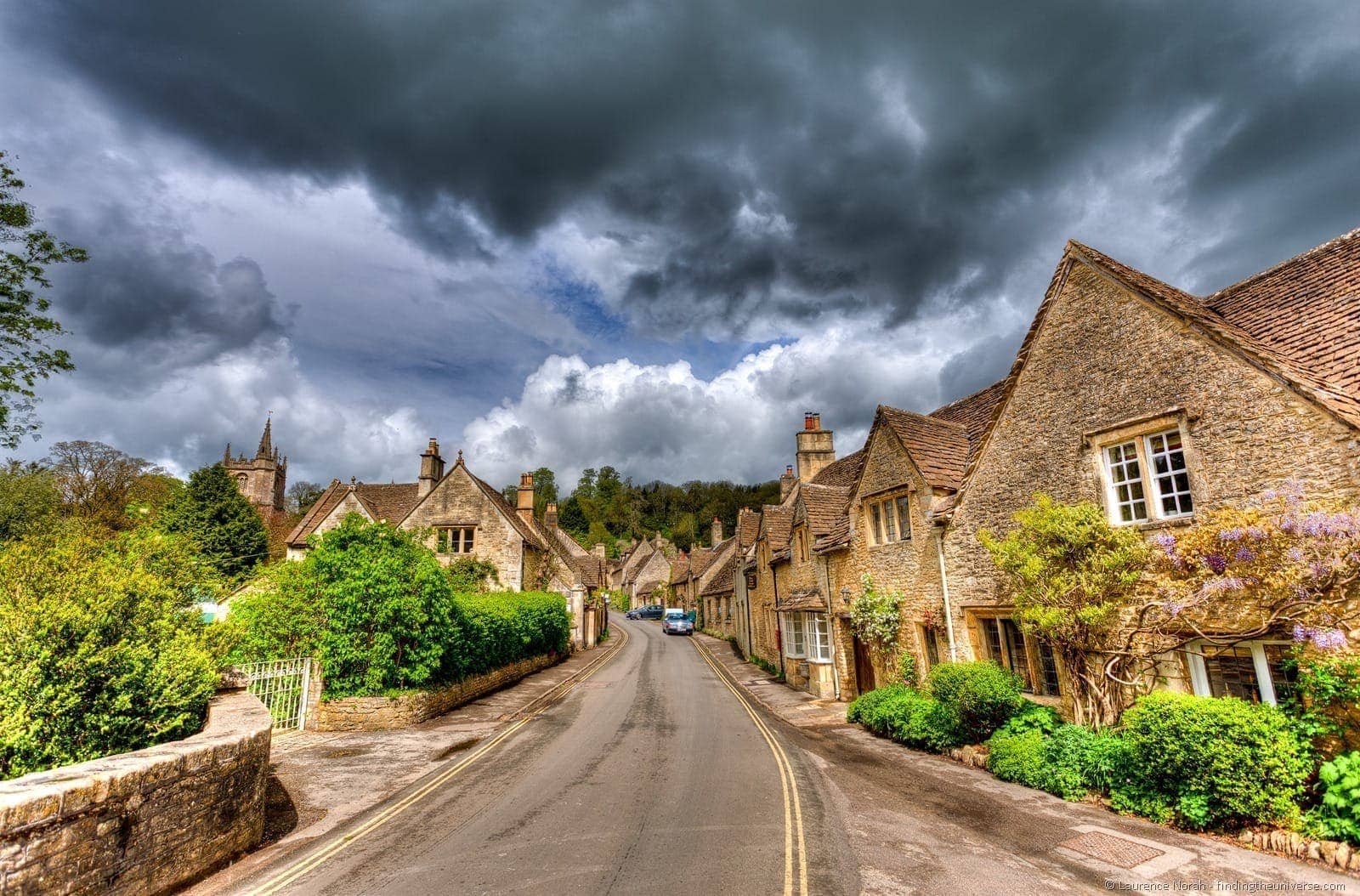
See our guide to taking a day trip to Stonehenge and a day trip to Oxford for some inspiration. If you’re a Harry Potter fan, then you may instead consider a trip out to the Harry Potter Studios where the films were made.
Of course, you will want to adjust this schedule depending on when you arrive and depart London. Our suggestion would be to take the day trip on your last day, overnight in London, and then take an early morning train to Paris.
Whilst you’re in London, we recommend getting around by public transport. It’s the most cost effective and also generally the most efficient way to get around. See our guide to public transport in London for some tips, as well as our overview of how to pay for public transport in London .
If you enjoy walking tours, there’s no shortage of options to choose from in the city. We love taking a walking tour when we first arrive in a new city – it can be a good way to get familiar with the city, plus you can ask your guide for local tips on places to eat and less well-known attractions.
If you do decide to take a walking tour, we suggest Take Walks for small group tour (tours range in length from a couple of hours to full day tours), and Context for private tours. We’d specifically recommend this full day walking tour with Take Walks as a possible option to consider.
You’ll most likely be arriving into London by plane, into one of London’s major international airports. London actually has six airports, but you’re most likely to land in either Gatwick or Heathrow. Whichever one you do land at, we have a guide to how to get from the airport to London .
Well, that’s your time in London covered. Now we’ll suggest a few places for you to stay, before giving you some tips on getting from Paris to London.
Where to stay in London
Some of our favourite hotels, from budget to luxury, in London are as follows:
- The Walrus Bar and Hostel – A well reviewed centrally located hostel
- The Z hotel in Shoreditch – Excellent value in a popular part of London with great dining options
- Point A Hotel – We’ve stayed here; the rooms are tiny but clean and it’s a great budget option.
- Lime Tree Hotel – A well reviewed boutique hotel, around nine minutes walk from London Victoria
- The Resident Victoria Hotel – A well reviewed and centrally located hotel offering excellent value for money. The room we stayed in was quite compact, but it had everything we needed
- The Savoy – true luxury as close to the city centre as you can get!
If you prefer an apartment, then we recommend Plum Guide .
Plum Guide doesn’t have quite so many choices as some other UK based websites , but they carefully curate their listings so their options tend to be of a very high quality whilst still being available at a range of price points. We’ve used them on a number of trips and always had a great experience. See their listings for London here .
If you can’t find what you want on Plum Guide or you want some new options to try out, we wrote a whole post on the best alternatives to AirBnB which you should check out!
How to get to Paris from London
We’d recommend taking the Eurostar train service from London to Paris. This departs multiple times a day, and the journey takes 2 hours and 16 minutes.
This is a lot quicker than flying, especially once you consider you’ll have to get to and from the airport on either end. The Eurostar will take you directly to Gare Du Nord. Get your tickets for that journey in advance here .
We also have a guide to getting from London to Paris which lists all the options you have.
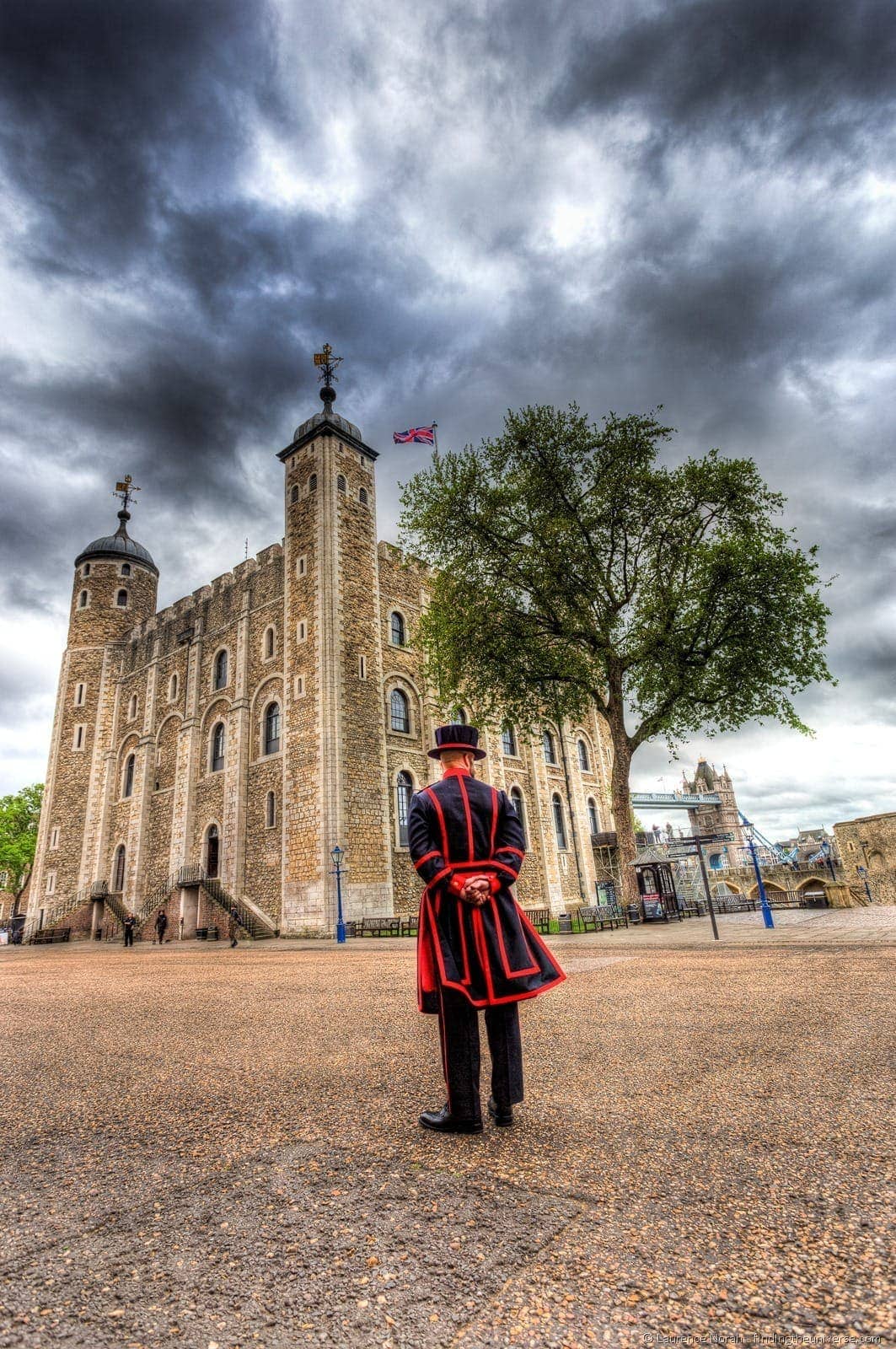
Days 4 – 6: Paris
Welcome to Paris – the city of lights and love! We’re going to suggest three full days exploring Paris, as the city has so much to offer.
After you’ve dropped your bags off at your hotel (or at a luggage storage location ), it’s time to start sightseeing. As with London, the plan is to see the major sights in the city.
We’re going to start off with the Eiffel Tower . This is without doubt Paris’s most famous landmark, and a must-visit when you come to Paris. You can either enjoy the views from below or head up inside the tower to one of the various stages.

If you do decide to go up the Eiffel Tower, we highly recommend you book your tickets in advance. The best place to do this is on the official website . There are often huge lines for tickets on site, and you don’t want to waste time unnecessarily. For a lot more tips for your visit, see our complete guide to visiting the Eiffel Tower .
From the Eiffel Tower, we suggest taking a cruise on the River Seine , which will let you see many of the highlights of the city from the river. You can book a discounted Seine River cruise which departs from near the Eiffel Tower with our link .
Alternatively, you might prefer to do an evening Seine River dinner cruise , in which case this will happen later.
After the cruise, you might consider a walking tour of Paris or a Hop on Hop off bus trip. Alternatively, consider visiting the Musee d’Orsay .
On your second day in Paris, we suggest you start bright and early with a visit to spectacular Sainte Chapelle , one of Paris’s prettiest churches. The stained-glass windows here have to be seen to be believed. Just be sure to turn up at or just before opening time, as the lines get very busy.
From here, you can pop across to Notre Dame if you want. Due to the fire in 2019 this is undergoing significant reconstruction work, so do keep that in mind. From Notre Dame, head across to the Louvre , one of the most famous art museums in the world.
There’s a huge amount to see here, including highlights such as the Mona Lisa and the Venus de Milo. You could spend a whole day here, but you may want to limit yourself to 2 – 3 hours so you can see more of the city! Book your tickets online in advance here .
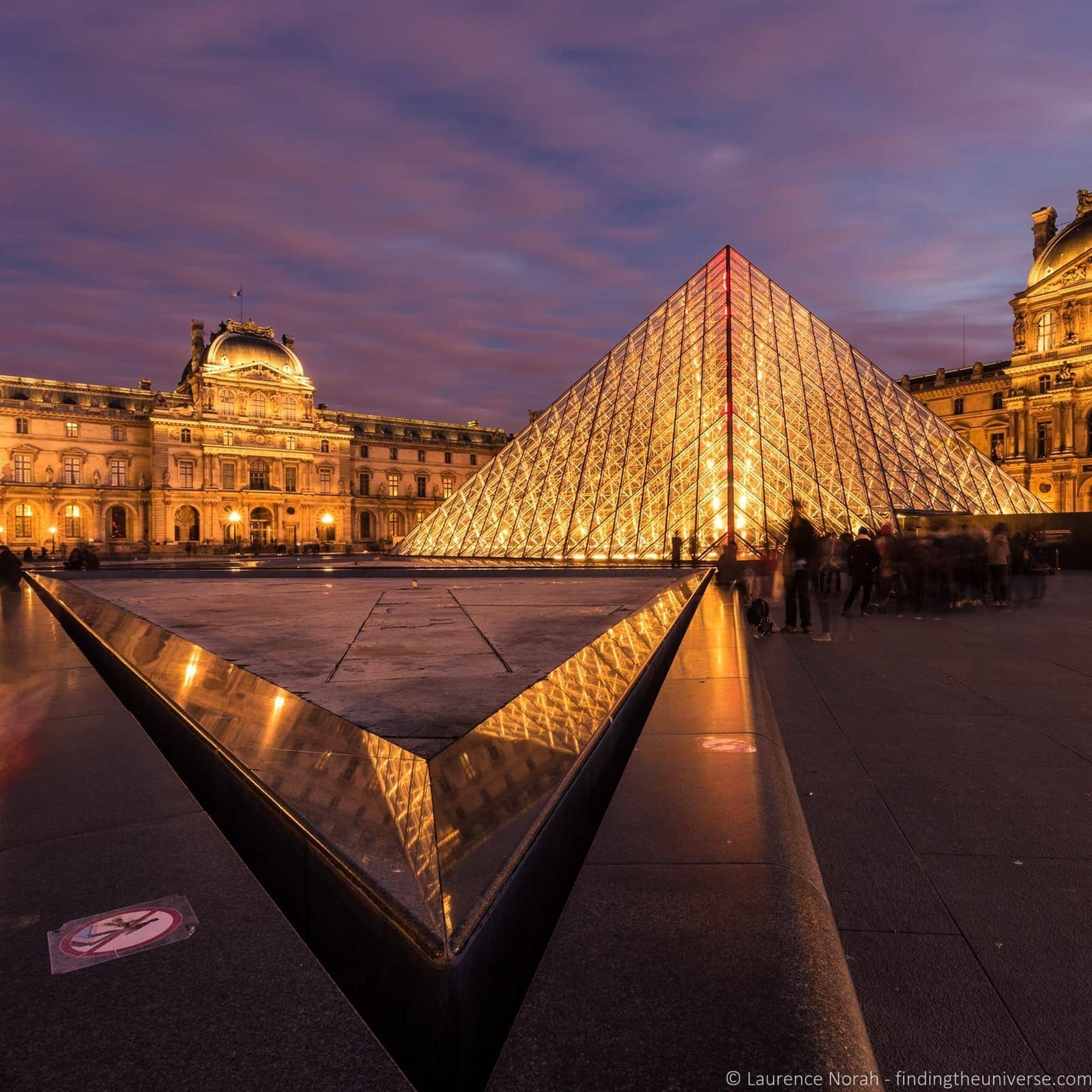
From the Louvre, if you have time, you might consider sneaking in a wine tasting session , or going for afternoon tea in Paris . From here, it’s time to head up the most famous shopping street in Paris, the Champs Elysees, where you’ll finish up at the Arc de Triomphe .
This massive archway stands in memory of those who died in the French Revolution and the Napoleonic Wars. The view from the top is one of our favourite views in Paris, so do head to the top if you have the time.
For your final day in Paris, our suggestion is that you head out to Versailles . This was the palace of French royalty, and is a stunning place to visit. You can book your tickets for Versailles in advance here .
Between exploring the palace and the extensive gardens, there is more than enough to do here to fill from half a day to a full day, which is why we suggest allocating most of the day to it. Then perhaps plan a nice dinner or show for your final evening.
We can recommend the evening show at the Moulin Rouge, and you can read about our experience at the Moulin Rouge here , and book tickets here .

And that’s all your sightseeing for your time in Paris on our European itinerary! For more detailed inspiration for your time in Paris, see our itinerary for 3 days in Paris and 2 days in Paris , which should give you lots more ideas.
For your visit in Paris, we recommend either the Paris Pass , or the Paris Museum Pass . The former includes a number of activities like the hop on hop off bus tour, guided Eiffel Tower climb, and Seine River cruise, as well as all the museums and sights included on the Paris Museum Pass. These both include most of the attractions we’ve listed, including Versailles.
You can buy the Paris Pass on the official site here , and the Paris Museum Pass here .
Again, for those of you who enjoy walking tours, we recommend Take Walks and Context . The former offer small group walking tours, whilst the latter primarily focus on private tours. We’ve taken tours with both companies in cities around the world and are always happy to recommend them.
As an example tour, check out this full day Paris tour , which includes a Skip the Line Louvre Tour, Eiffel Tower, Montmartre & Seine River Cruise.
As with London, the easiest way to get around Paris is to take public transport. Specifically, the Metro is likely going to be the fastest and most cost-effective way to get around.
We have a full guide to how to get around Paris , which should help you plan your transport in the city.
Now, we’re going to share some tips on where to stay in Paris, as well as how to get to the next city on your itinerary of Europe – Barcelona.
Where to stay in Paris
Our itinerary has you spending 2 nights in Paris, arriving by train on the morning of the first day, and departing either by plane on the evening of the third day. We suggest the following options for accommodation in Paris.
- 3 Ducks Hostel . A well-rated boutique hostel just 2 minutes from the nearest metro and a 22 minute walk to the Eiffel Tower
- Hotel Dress Code & Spa , A highly reviewed centrally located 4 star hotel
- Hotel Ekta Champs Elysees – a well rated 3* hotel just off the Champs Elysees
- Hôtel Eiffel Turenne , A well rated 3* hotel within a ten minute walk of the Eiffel Tower
- Ateliers de Montmartre , An apartment in Montmartre with views of the Sacre Coeur
- Vintage Paris Gare du Nord by Hiphophostels , A hostel located just next to Paris Gare du Nord
- George V – A fabulous centrally located 5* hotel, an excellent luxury pick
We’ve also stayed in Paris with Plum Guide in a gorgeous apartment with Eiffel Tower views. See their listings for Paris here .
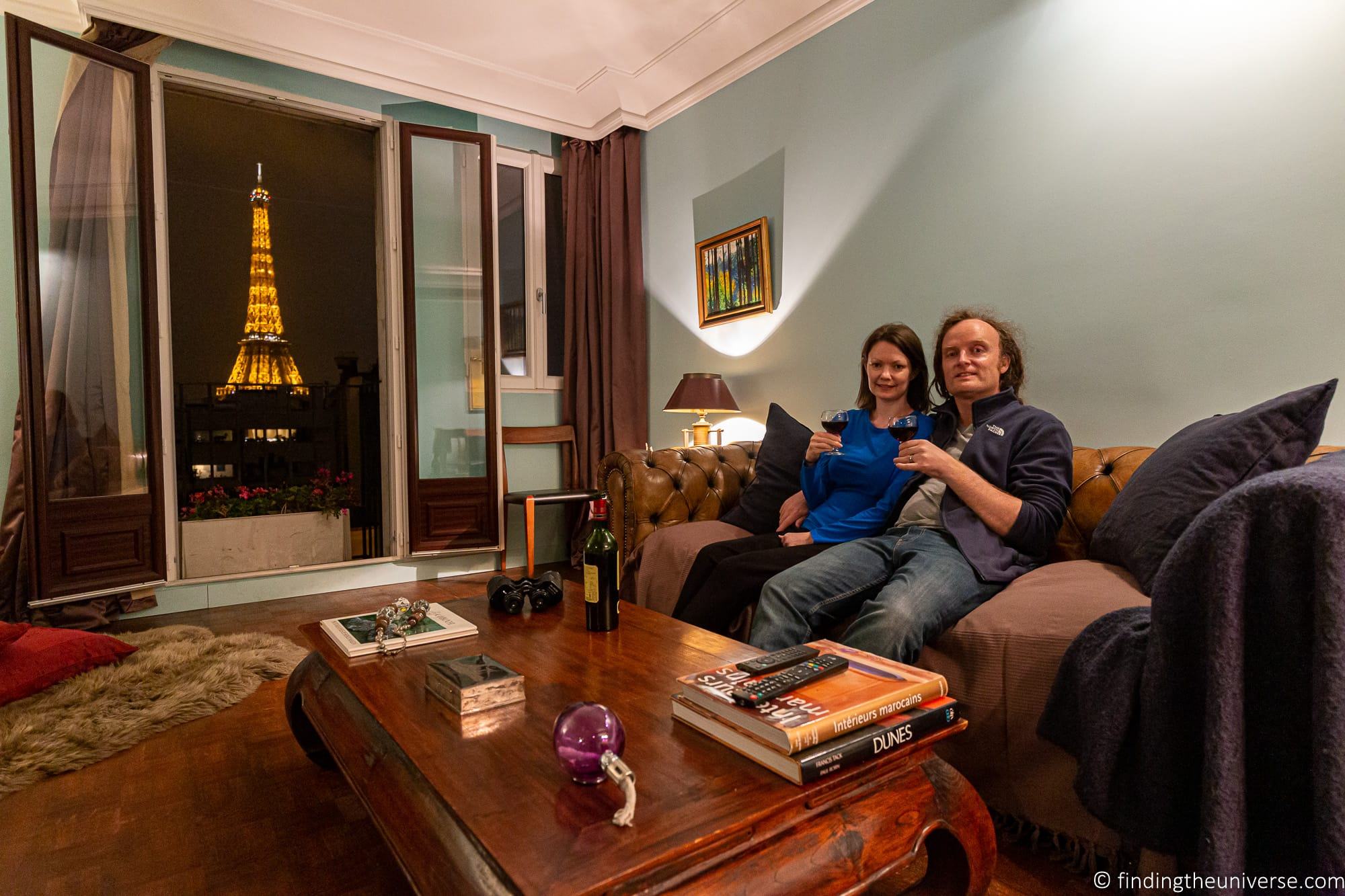
How to get from Paris to Barcelona
You have two main options for travelling from Paris to Barcelona, you can take the train, or you can fly.
There used to be a direct night train from Paris to Barcelona, but this was discontinued in 2013. So you can take a train in the daytime (around 6.5 hours journey time) or you can travel by a slower overnight train (around 13 hours).
We think flying is likely going to be the easiest option. There are a number of direct evening flights from Paris to Barcelona, taking just under two hours. Just try to book a flight from Paris Orly or Paris Charles de Gaulle. Many budget airlines operate from Paris Beauvais, which is quite a long way outside the city, and requires a lengthy coach journey.
Check flight times and prices online here . If you’d prefer to take the train, you can check train times and prices here .
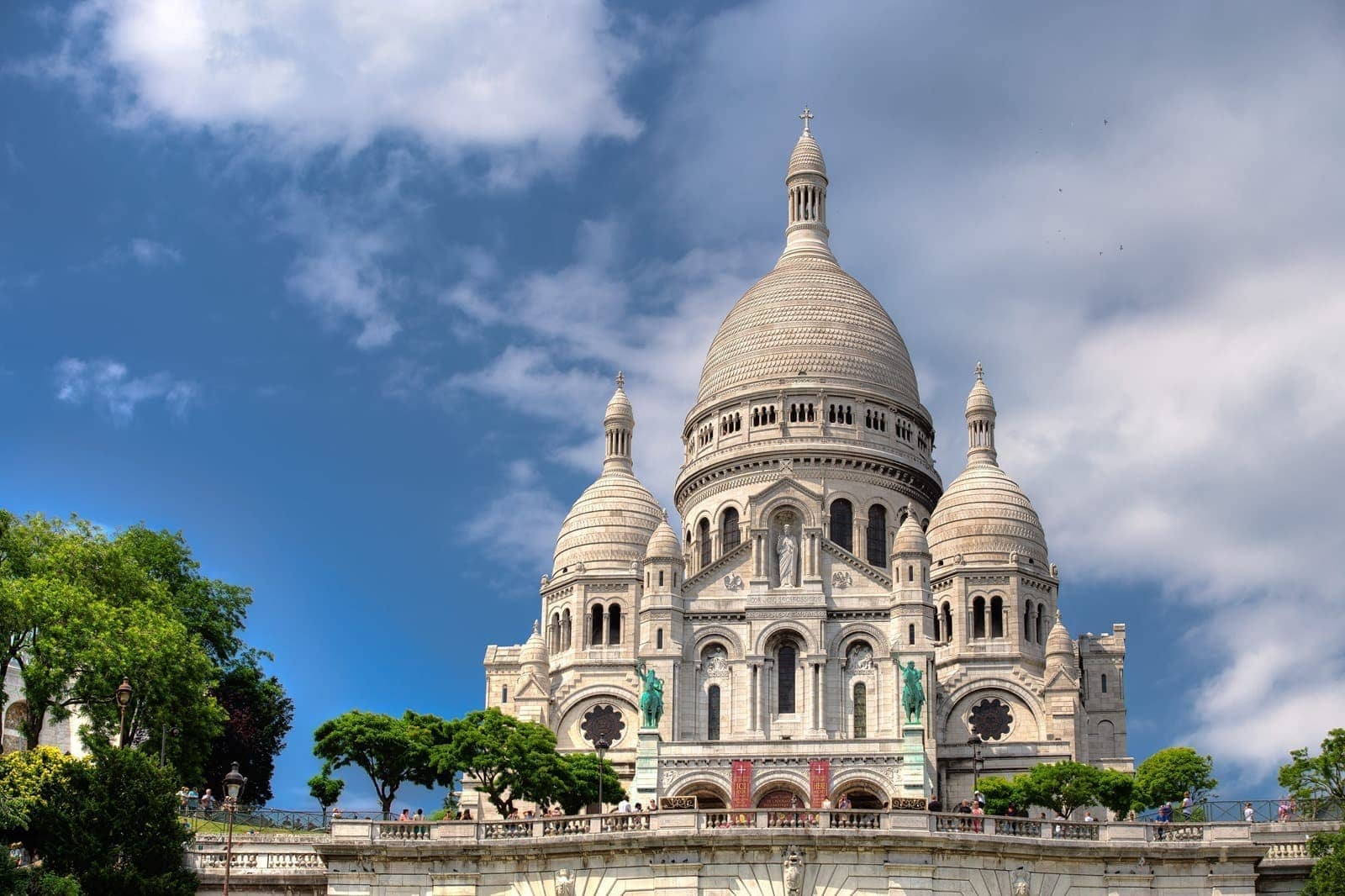
Days 7- 9: Barcelona
It’s time for the third city on your European adventure – Barcelona! Barcelona is full of incredible sights, including architectural gems from Antoni Gaudi, a gothic city center, and even a beach!
Again, we think you’ll need 3 days to do justice to all the sights in Barcelona. We’re also going to suggest a day trip from the city to explore some of the surrounding highlights. Here’s how your three days in Barcelona might look.
We suggest starting your first day with a trip to the Sagrada Familia . This was master architect Antoni Gaudi’s final work, and whilst construction was started in 1882, he didn’t live to see it completed. It’s getting there now, but still has some way to go!
The Sagrada Familia is a very popular attraction and they operate a timed entry system. It’s vital that you reserve your timeslot in advance, as otherwise you will end up in a very long queue, and at busy times of year, tickets sell out far in advance. You can reserve your tickets online here .
We also have a detailed guide to visiting the Sagrada Familia which we recommend reading in advance of your visit.

After spending a couple of hours at the Sagrada Familia, we recommend heading across to the nearby Recinte Modernista Sant Pau , a beautiful Art Nouveau style hospital building which has UNESCO world heritage status.
After the Recinte Modernista Sant Pau, continue on to Park Güell . This is a large public park which was also designed by Anton Gaudi, and there’s a lot to see here. Again, this is a popular spot with timed entry, and we highly advise booking this online in advance here .
Near Park Güell is the Gaudi Experience , where you can learn a bit about the man behind some of the wonderful architecture you have been experiencing. You can get tickets for that here if you are interested.
From the Gaudi Experience, you have a few options depending on your interest. If you are using the hop on hop off bus to travel around Barcelona (included on the Go Barcelona Pass ), it continues from Park Guell on to a number of other attractions.
These include the hill top fairground Tibidabo , the stunning Monastery of Pedralbes , and Camp Nou , the home of Barcelona’s football club.

We’re sure one or more of those will be of interest!
For your second day in Barcelona, we suggest starting with a visit to some of Gaudi’s famous houses near the city centre – Casa Batlló , and Casa Milá . These are popular, so try to get here by opening time so as not to have to queue for too long.
Then, continue your day by exploring the oldest part of Barcelona – the Gothic Quarter. Here you can visit the incredible Barcelona Cathedral , the UNESCO world heritage listed Palau de la Musica Catalana , and the Picasso Museum .
For your third day, you could continue to explore Barcelona. You could visit the beach, Barcelona Zoo , the attractions on Montjuic Hill – the list goes on! See our 3 day Barcelona itinerary for more ideas.
However, we think you might enjoy heading out of the city on a day trip to explore a bit of Catalonia, the region which Barcelona is capital of.
A popular day trip from Barcelona is a visit to Girona and Figueres, two lovely towns which are rich in history. Girona is home to stunning medieval architecture, and Figueres is known as the birthplace of surrealist artist Salvador Dali .
You can see our guide to visiting Girona and Figueres in a day here . In terms of tours, we suggest this full day tour which includes Girona and the coast, or this full day tour which includes Girona and time to visit the Dali Museum in Figueres.
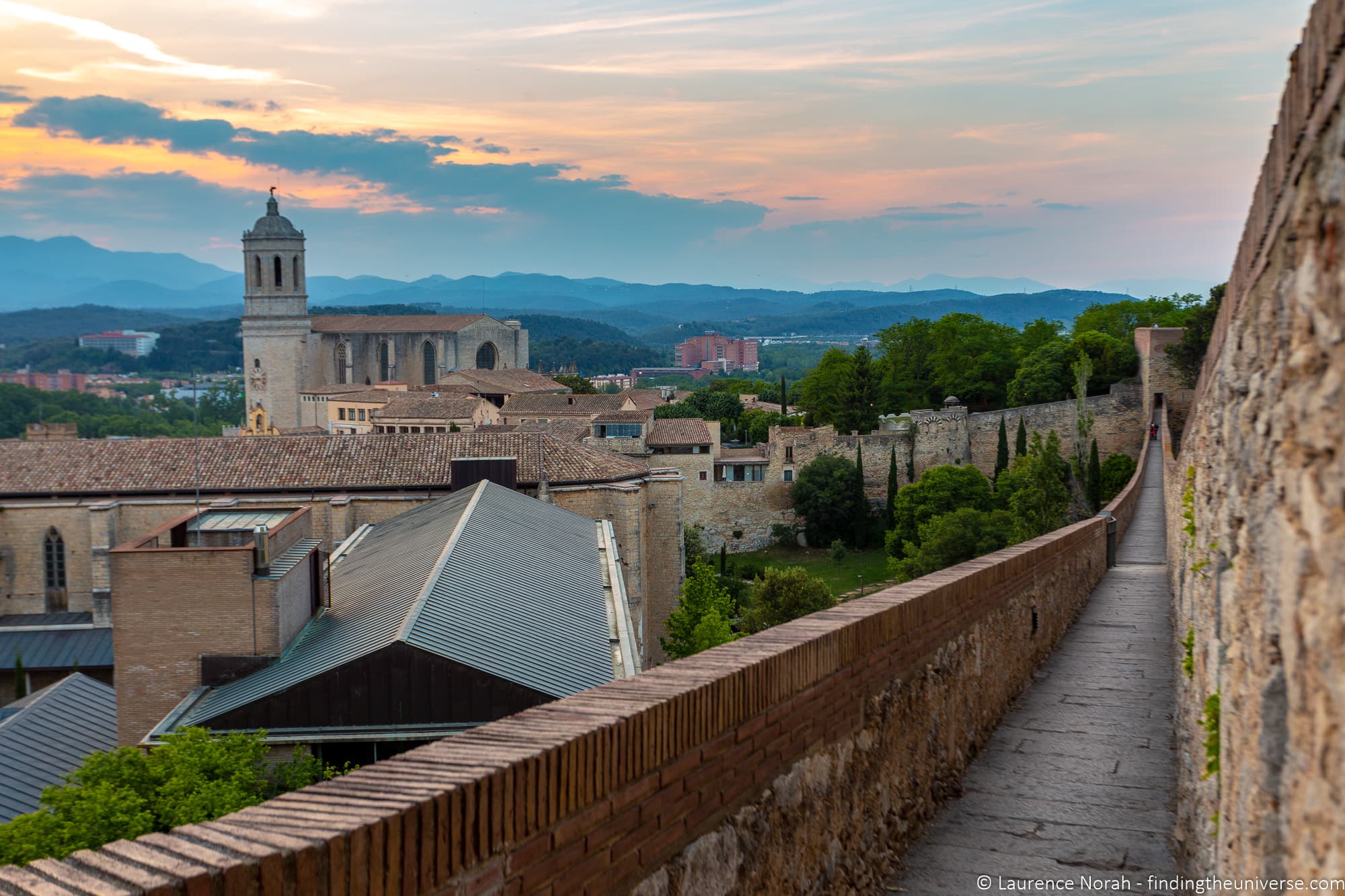
The other popular option is to visit the spectacular monastery and mountains of Montserrat, around an hour from Barcelona. You can see our guide to visiting Montserrat here for all the tips you need to do that.
Of course, there are lots of other tour options. You could go hot air ballooning , visit the Vall de Nuria , go skiing (if you visit in winter), go hiking in La Garrotxa , visit the Montserrat monastery – the list goes on!
That just about wraps up our suggestions for what to see and do with your three days in Barcelona.
To further help you with your planning for Barcelona, we have some guides we think you’ll find useful. See our itinerary for 3 days in Barcelona , our guide to Gaudi sites in Barcelona , and our favourite photography locations in Barcelona to get you started.
There are a few city passes for Barcelona, including the Barcelona City Pass , the Barcelona Card , and the Go Barcelona Pass . These work slightly differently, and so one or the other might be better for you. See our full break down and review of all the passes in our comparison of the Barcelona Discount Passes .
For most visitors we think the Go Barcelona Pass will offer the best value as it includes the main attractions like the Sagrada Familia, Park Guell and hop on hop off bus tour. We also have a full review of the Go Barcelona Pass to help you decide if it’s going to save you some money.
Finally, it’s worth bearing in mind that Barcelona has a bit of a poor reputation when it comes to petty crime, specifically around pick pockets, and items like phones being swiped off cafe tables. We have not personally experienced this, but have heard firsthand accounts from readers and friends who have.
We have more on this in our section below with tips for safety when travelling in Europe, but just try to keep your valuables out of sight all the time, ideally in zipped and secured pockets.
Now, let’s look at some options for where to stay in Barcelona, before planning how to get to the next city in your Europe itinerary.
Where to Stay in Barcelona
Here are a few options for your stay in Barcelona across a variety of price points, including a number of hotels we’ve personally stayed in and can recommend.
- Hotel Barcelona Catedral – A 4* property in Barcelona in the heart of the Gothic Quarter. We’ve stayed here, and enjoyed the roof top pool and incredible central location.
- Hostel One Ramblas – A very well reviewed and very central hostel option
- The 8 Boutique B&B – A highly rated and well located bed and breakfast
- Duquesa de Cardona – A 4* property on the waterfront with a roof top bar
- Leonardo Hotel Barcelona Las Ramblas – Part of the good value Leonardo chain, this 3* property is a few moments from Las Ramblas. We enjoyed our stay here, and the breakfast in particular was excellent.
- Ohla Barcelona – A very central 5* property with a roof top pool and excellent reviews.
How to Get from Barcelona to Venice
From Barcelona, the next stop on the trip will be Venice, Italy. If you are travelling for less than two weeks, you might want to skip Venice, and head straight to the last city on this itinerary, but for two weeks in Europe, we think Venice is a great addition.
The main option you have for getting from Barcelona to Rome is to fly. Of course, you could take the train, but as the average journey is around 22 hours and requires a number of changes, we’d suggest a flight is going to make more sense.
A direct flight from Barcelona to Rome is just under 2 hours. You can either go on your evening of your final day in Barcelona or the morning of the following day, it’s up to you. We think travelling in the evening makes more sense so you don’t lose time sightseeing in the morning.
Check times and book your flights here .
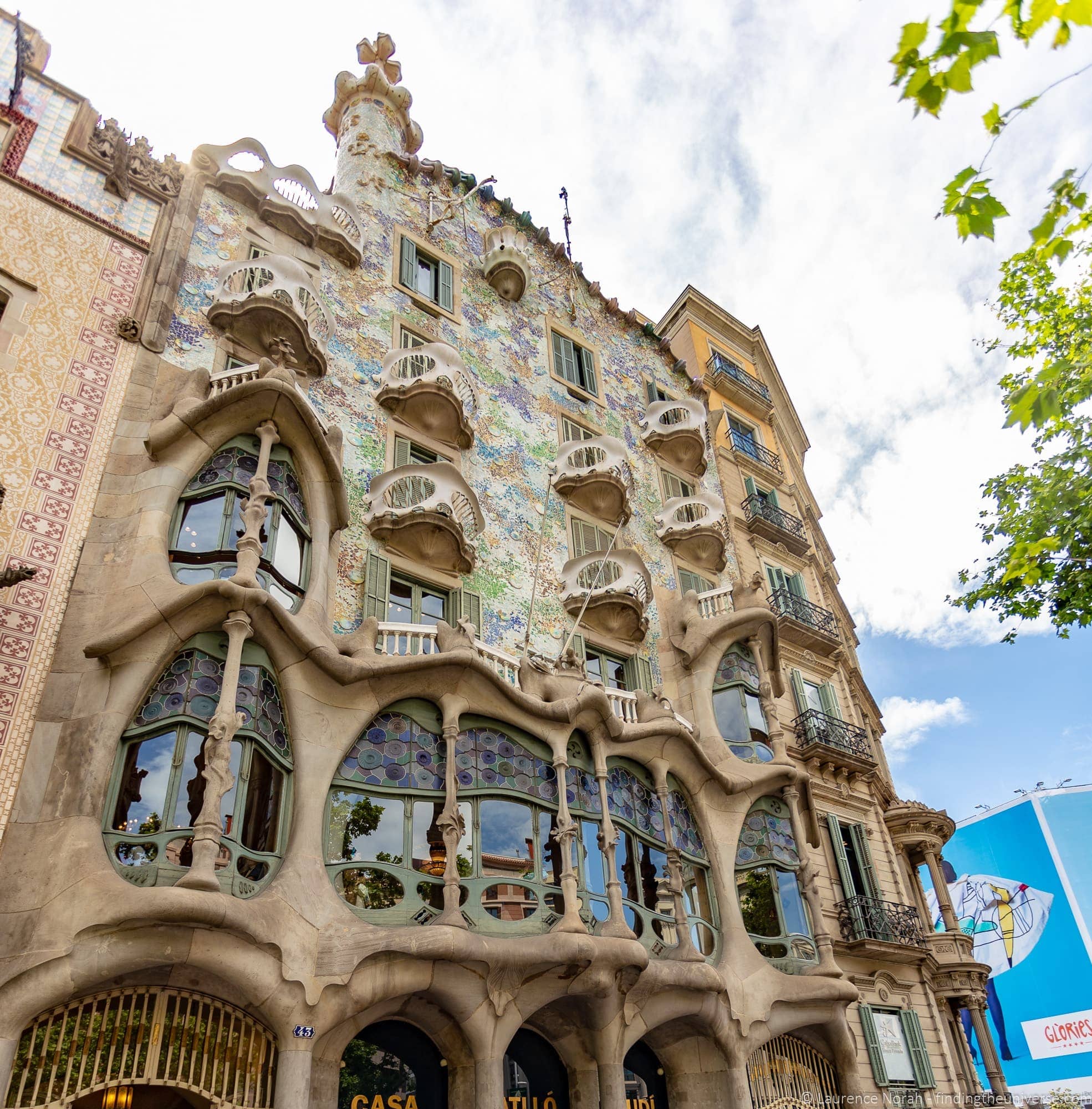
Days 10 – 11: Venice
You’ve arrived in the fourth and final country of your 2-week European itinerary – Italy! Home to amazing gelato , delicious coffee , and oodles of history.
We’re going to visit two cities in Italy on your European itinerary, both of which are favourites with visitors to Italy – us included! Of course, it’s hard to pick a second city in Italy from all the amazing options, but we think Venice is a must. Naturally, this will be followed by Rome.
We’ve put Venice ahead of Rome for the simple reason that it’s relatively easy to fly to Venice from the rest of Europe, but a little bit harder to fly onwards from Venice to international destinations. Ending the itinerary in Rome should make it easier for you to travel onwards to international destinations.
Anyway, we’re getting ahead of ourselves.
The next city on your European adventure is the beautiful city of Venice. This car-free city is famous for being built across a number of islands, with waterways and boats replacing roads and cars.
Venice is definitely one of our favourite cities in Europe, and was where we had our wedding ceremony with friends and family. So it’s definitely a city that is close to our hearts.
We’re going to recommend you spend two days in Venice. Many people visit the city for a day, which is do-able of course, but to really get a feel for Venice, we think you’ll enjoy spending two days here.
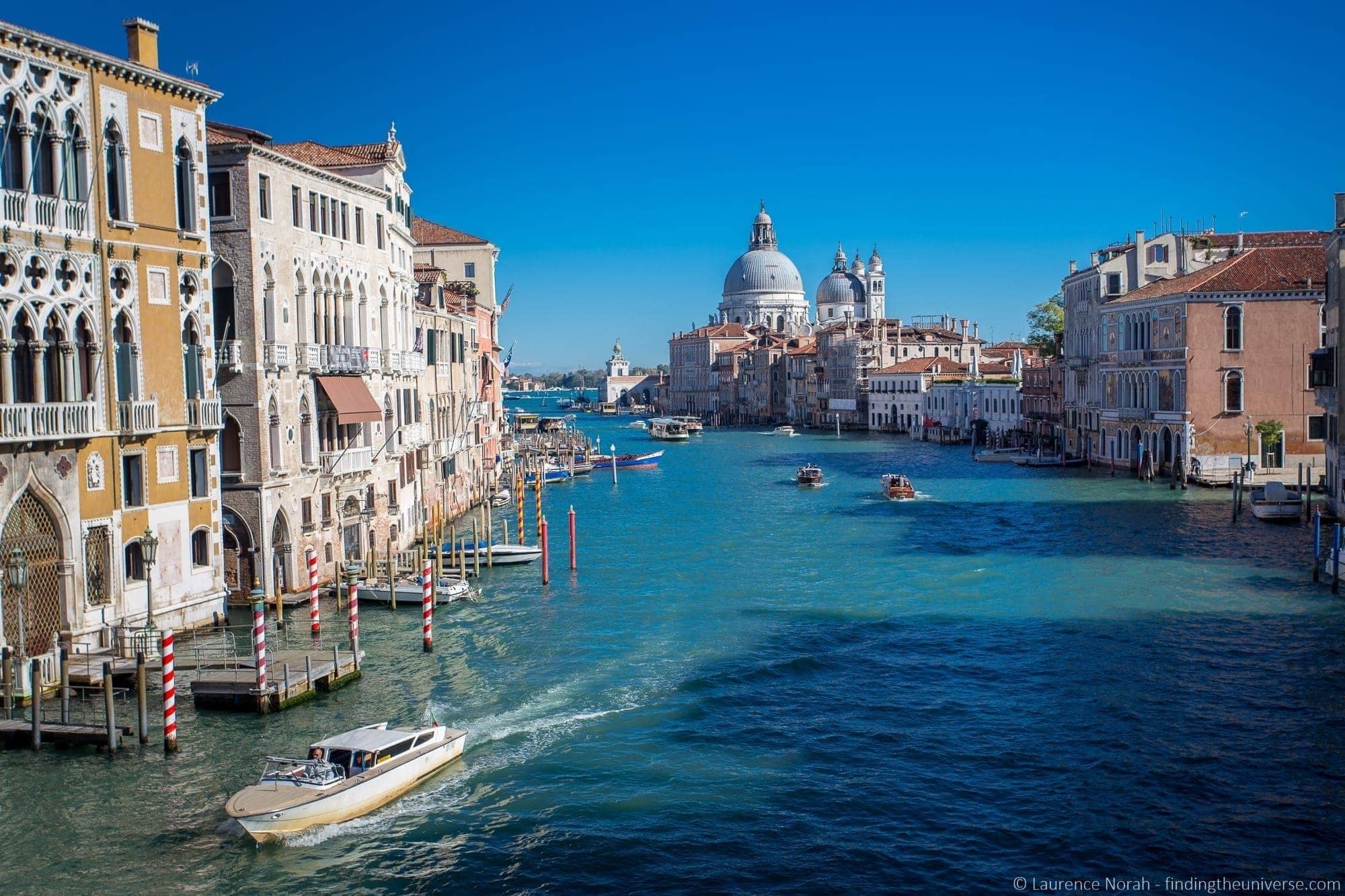
Our recommendation for your two days in Venice is to spend the first day exploring the highlights of the city – places like St. Mark’s Square, the Doge’s Palace and the Rialto Bridge. Take a Gondola ride , listen to musicians playing in the cafes, and get lost down the countless winding alleyways.
For your second day, we recommend taking a boat out to one of the islands around Venice, like Murano or Burano. These are much quieter with a different vibe to Venice itself, and we think you’ll enjoy this as a way to finish off your grand European adventure.
For more inspiration on what to do in Venice, see our guide to spending a day in Venice . We also recommend reading our guide to visiting the Doge’s Palace and St. Mark’s Basilica .
Of course, if you would prefer to visit another city in Italy other than Venice, you could spend these two days in any number of destinations, including the Amalfi Coast, Cinque Terre, Naples or Florence . You could even do a one day stopover in Florence on your way to Rome, rather than spending the two days in Venice. It’s entirely up to you, and depends on the flights you can find.
Where to Stay in Venice
Venice has a great many options for accommodation. Just be aware that many of the properties are old (as is much of the city!), and so elevators are not always standard. In addition, there are no vehicles allowed, so to get to your hotel from the train station you’ll need to take a ferry boat, water taxi, or walk.
- Casa Cosmo – a great value well rated budget option, five minutes walk from St. Mark’s Square and the Rialto Bridge. Rooms are air conditioned and are en-suite
- B&B Bloom Settimo Cielo – A highly rated and good value B&B breakfast, 10 minutes from St. Mark’s Square and the Rialto Bridge. Individually designed rooms have en-suite facilities, and there’s a rooftop terrace
- Leon Bianco on the Grand Canal – this historic property with Grand Canal views is where we stayed for our wedding ceremony in Venice. The views are fantastic, and it’s amazing value for the location
- Hotel Saturnia & International – a lovely 4* hotel just moments from Saint Mark’s Square, this turn of the century hotel offers en-suite rooms, a terrace with views, and an on-site restaurant.
- The Gritti Palace – a 5* luxury property right on St. Mark’s Square – this is the place you stay if you want to be in the middle of everything
How to Get from Venice to Rome
The best way to get from Venice to Rome is to take the train.
As always, you’ll get the best prices if you book your tickets in advance. You can check train times, prices, and book online here .
There are also flights, but by the time you have gotten to the airport, checked in, and then collected your baggage at the other end and gotten from Rome airport to the city center, you might as well have taken the train!
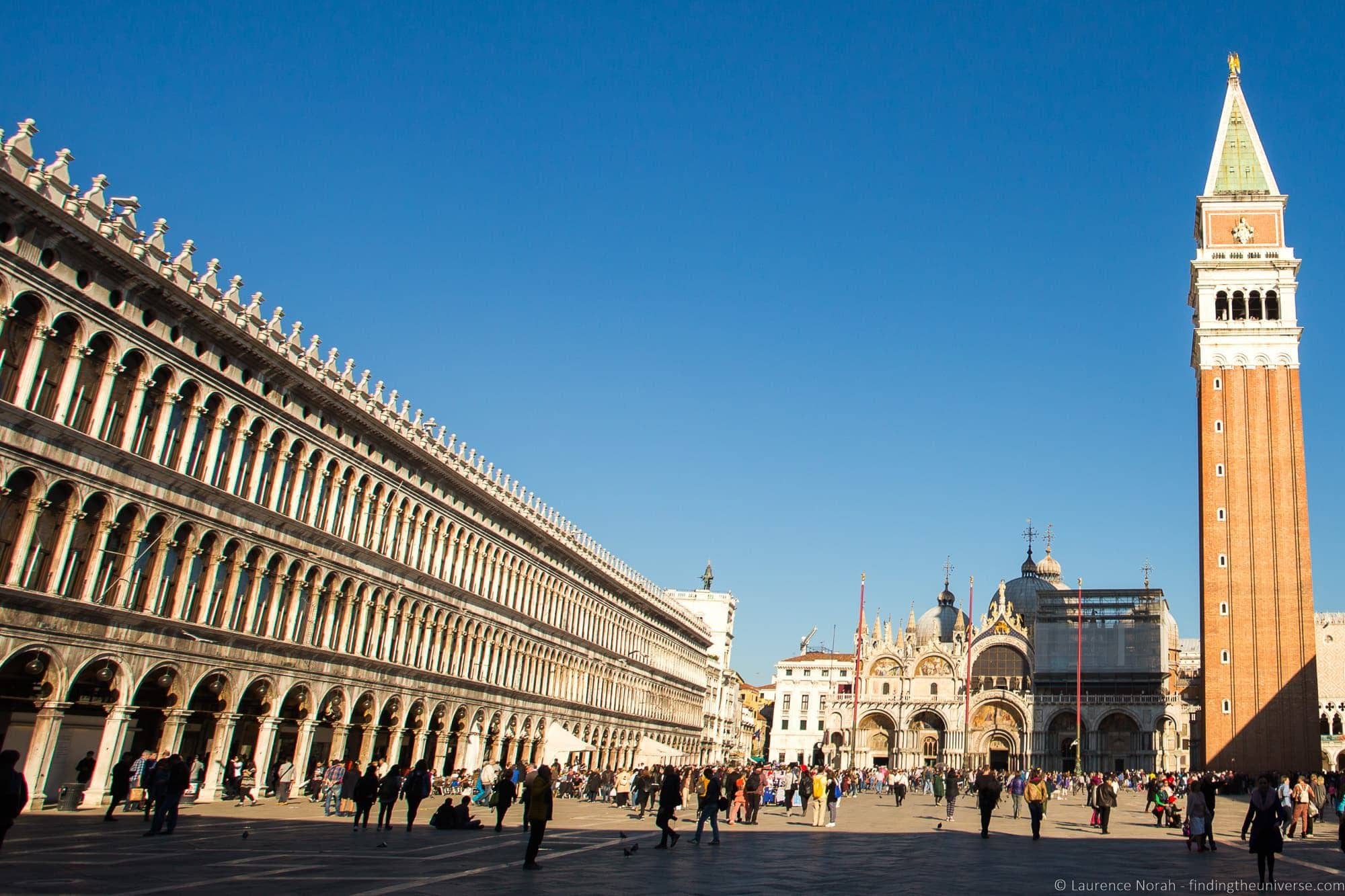
Days 12 – 14: Rome
Your next stop in Italy, and the last stop on your Europe itinerary, is the Italian capital of Rome. Founded almost 3,000 years ago, Rome is absolutely stuffed full of historical wonders and attractions.
We think that to do Rome justice, you should spend three days here. Here’s how those days might look.
Start your first day with a visit to the Colosseum . Built during the height of the Roman Empire, and nearly 2,000 years old, this is the largest amphitheatre in the world. It’s a must when in Rome.

Do be aware that like many of the other popular attractions in our itinerary, the Colosseum operates a timeslot system for entry, and you absolutely need to book in advance. See our complete guide to visiting the Colosseum for more on that.
After the Colosseum, we recommend visiting the Roman Forum, which is next to the Colosseum, and usually included on the Colosseum entry ticket. This was the heart of the Roman Empire, and is also a must when visiting Rome.
You’ll likely already be half way through your first day already. We suggest spending the rest of the day exploring the historic city center, with attractions like the Spanish Steps, Pantheon, and Trevi Fountain.
For your second day in Rome, we recommend you head to the Vatican City. This is a city-state inside Rome itself, and is home to the Vatican Museums and St. Peter’s Basilica. The Vatican Museums are home to world renowned works of art as well as the Sistine Chapel – a masterpiece of Renaissance art.
Both these attractions are very popular, and you will want to plan in advance to ensure you don’t waste time standing in line if you are visiting at a busy time of year. You have a few options.
First, you can take a guided tour which includes the Vatican and St. Peter’s Basilica like this one .
This will give you loads of information about what you are seeing and ensure you don’t waste time standing in line.
Another option is to invest in a pass which includes skip the line entry or a tour of these attractions. We would suggest looking at the Rome Tourist Card which includes skip the line access to the Vatican, Colosseum, and St. Peter’s Basilica.
You can also consider the Omnia Vatican and Rome Card , although this doesn’t currently include skip the line access to St. Peter’s Bascilica.
Finally, you can book individual tickets here for the Vatican via their official website (or here on GetYourGuide , which is easier to use in our experience).
As of early 2023 St Peter’s Basilica doesn’t actually have an entry fee, but nor does it have skip the line tickets (skip the line tickets used to be an option and we hope they come back soon!). So the best option if you want to skip the line is to invest either in a tour or a pass which includes a tour like the Rome Tourist Card .
You can also book Vatican tickets here , using our link gives you 5% off their usual price for Vatican tickets. It’s a little more expensive than the official website but somewhat more user friendly in our experience.

We recommend allocating at least half a day to explore the Vatican Museums, Sistine Chapel and St. Peter’s Basilica.
For lots more information on visiting the Vatican City and its attractions, see our complete guide to the Vatican , which has everything you need to know, including all the highlights, tips for visiting, how to buy tickets and lots more.
From here, head along to the Tiber River, and explore Castel Sant’Angelo (get tickets here ). Afterwards you can head back towards the city center, and visit locations like the Piazza Popolo.
If you have time and are interested you could also visit the Borghese Gallery. Note that this is also a timed entry system – see our guide to visiting the Borghese Gallery for more.
For your last day in Rome, we recommend spending some time exploring the Appian Way. This was one of the major routes in and out of the city, and is home to a number of ancient Roman ruins, as well as catacombs. A stop at the Baths of Caracalla on your way out of the city is also recommended.
Another option for your last day in Rome (or your first day, depending on how you decide to structure your itinerary) is to take a walking tour.
We’ve taken a number of walking tours in Rome with both Take Walks and Context , and enjoyed them all. As an example, see this introduction to Rome which includes gelato tasting!
For more inspiration for your visit to Rome, see our itineraries for 3 days in Rome , 2 days in Rome and a day in Rome .
In terms of saving money, there are a number of passes available for sight-seeing. For 3 days, our recommendation would be the Omnia Rome and Vatican Card. This includes public transport in Rome, a hop on hop off pass, and skip the line entry with timed reservations at the major attractions.
There are other passes as well, including the Roma Pass , the Rome Tourist Card and the Best of Rome All Access pass . Which is best for you will depend on how many sites you are interested in visiting, and whether you plan on using the specific features they offer.
That pretty much finishes up the itinerary section of this post. We’ll share with you our tips for where to stay in Rome, before moving on to some practical information to help you plan this trip perfectly.
Where to Stay in Rome
We recommend the following hotels in Rome. The first three are near the main train station, which will make for an easier transfer when you arrive from Venice.
- Gioberti Art Hotel – 50 yards from Termini Station, a well rated excellent value 4* hotel
- NH Collection Palazzo Cinquecento – Awesome value 5* hotel just a few steps from the train station
- Hotel Valentino Palace – a fantastic mid-range 3* property, just 150 yards from the train station
- The Navona Theatre Hotel – a well reviewed and very centrally located 3* hotel
- The Mimosa Pantheon Hotel – an excellent value budget hotel just around the corner from the Pantheon
- The Hotel Navona – a well reviewed 3* hotel next to the Pantheon
- Di Rienzo Pantheon Palace – a centrally located well reviewed boutique hotel within walking distance of Rome’s highlights
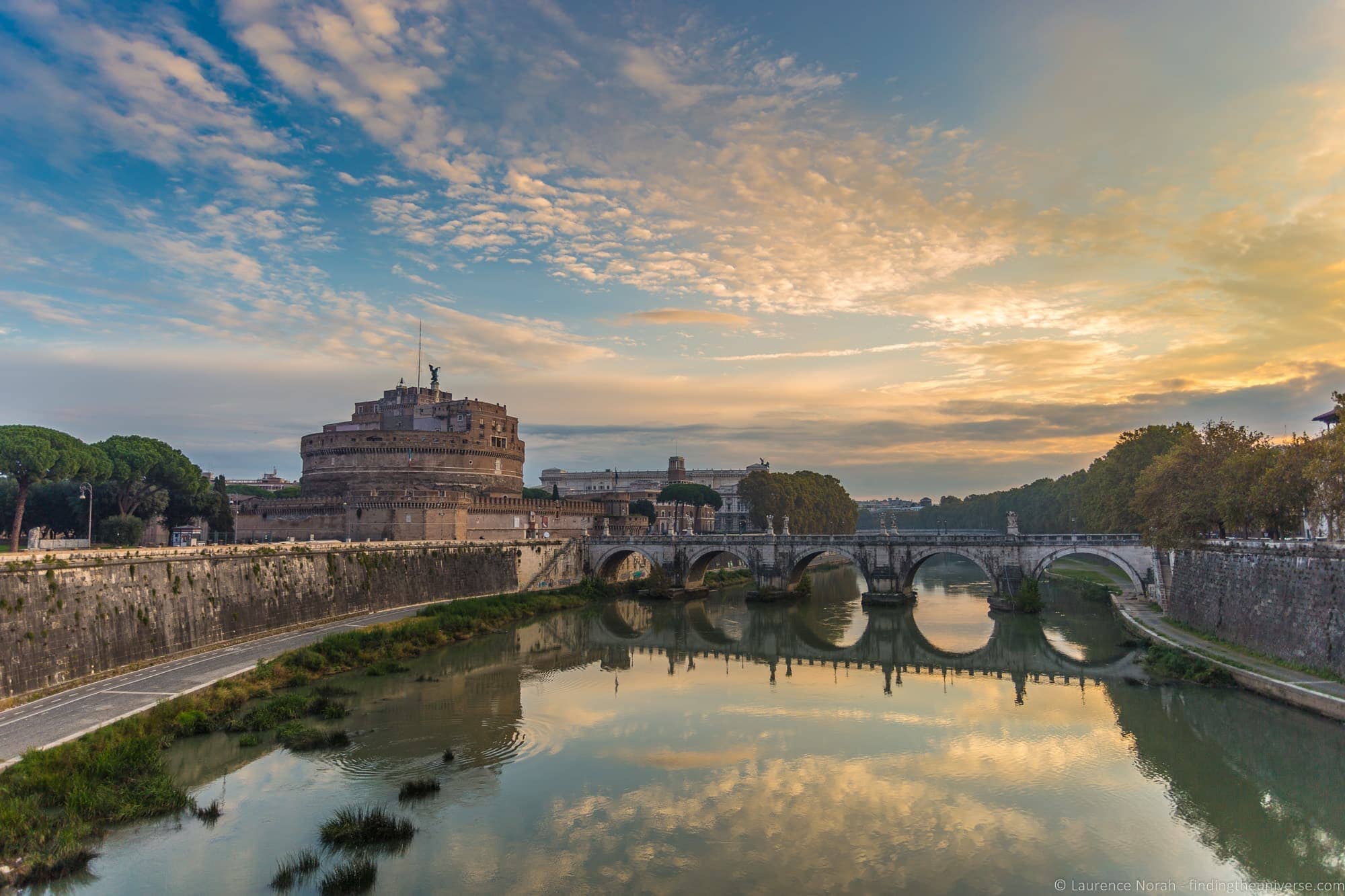
2 Week Europe Itinerary Map
To help you visualise this itinerary, we’ve put together this overview map of the stops and route.
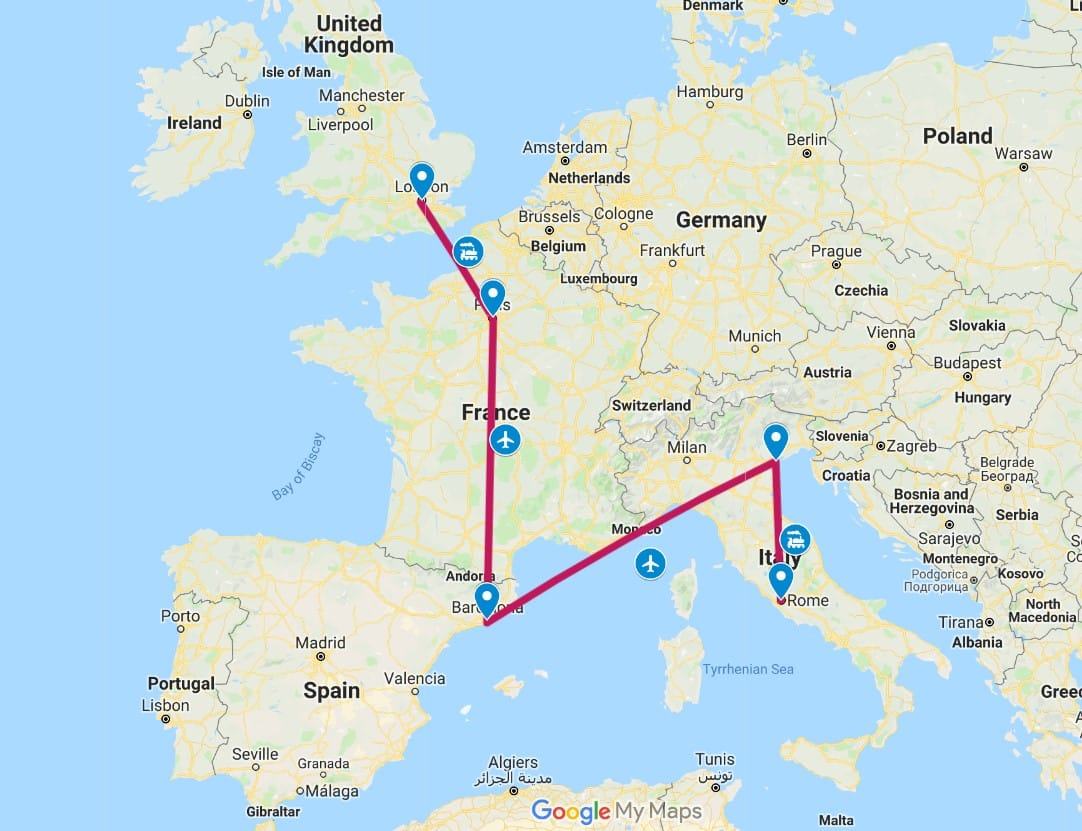
2 Week Europe Itinerary Summary:
- Day 1: London. Houses of Parliament, Westminster Abbey, Trafalgar Square, Covent Garden, Churchill War Rooms, Buckingham Palace and the London Eye .
- Day 2: London. Tower of London , Tower Bridge, Borough Market, St. Paul’s Cathedral, the Tate Modern, Shakespeare’s Globe and the Shard.
- Day 3: London. Windsor Castle, Hampton Court Palace, Stonehenge
- Day 4: Paris. Eiffel Tower, Seine River Cruise, Musee d’Orsay, Walking tour
- Day 5: Paris. Saint Chapelle, Notre Dame, Louvre, Arc de Triomphe
- Day 6: Paris. Versaille, Moulin Rouge
- Day 7: Barcelona. Sagrada Familia, Recinte Modernista Sant Pau, Park Güell, Gaudi Experience, Camp Nou
- Day 8: Barcelona. Casa Batlló, Casa Milá, Barcelona Cathedral, Palau de la Musica Catalana, Picasso Museum
- Day 9: Barcelona. Girona & Figueres
- Day 10: Venice. St. Mark’s Square, Doge’s Palace, Rialto Bridge, Gondola ride
- Day 11: Venice. Murano, Burano
- Day 12: Rome. Colosseum, Roman Forum, Spanish Steps, Pantheon, Trevi Fountain.
- Day 13: Rome. Vatican Museums, St. Peter’s Basilica, Castel Sant’Angelo, Piazza Popolo, Borghese Gallery
- Day 14: Rome. Appian Way, Baths of Caracalla
How to Get Around Europe
Europe has no shortage of transportation options to get you from place to place. For this itinerary, we would suggest you primarily use the train to get from city to city.
The high speed trains in Europe run frequently, are very comfortable, and are more environmentally friendly than short hop flights. If you book in advance they can also be cost effective. They also have the advantage that there are fewer baggage restrictions, and train stations tend to be in the city center – unlike airports.
Of course, not every segment of this trip would suit a train. For example, from Barcelona to Venice would take at least 24 hours by train. Also, Paris to Barcelona is a fairly lengthy journey. There is the option to take an overnight train, however it isn’t direct so it takes a while. It does save you the cost of a hotel night though.
For train travel across Europe, it’s important to book your tickets in advance as this will get you the best prices. We recommend thetrainline which supports booking tickets in all the countries visited on this itinerary.
For flights, we suggest you try Kiwi , which includes the major low cost airlines as well the more traditionally priced carriers.
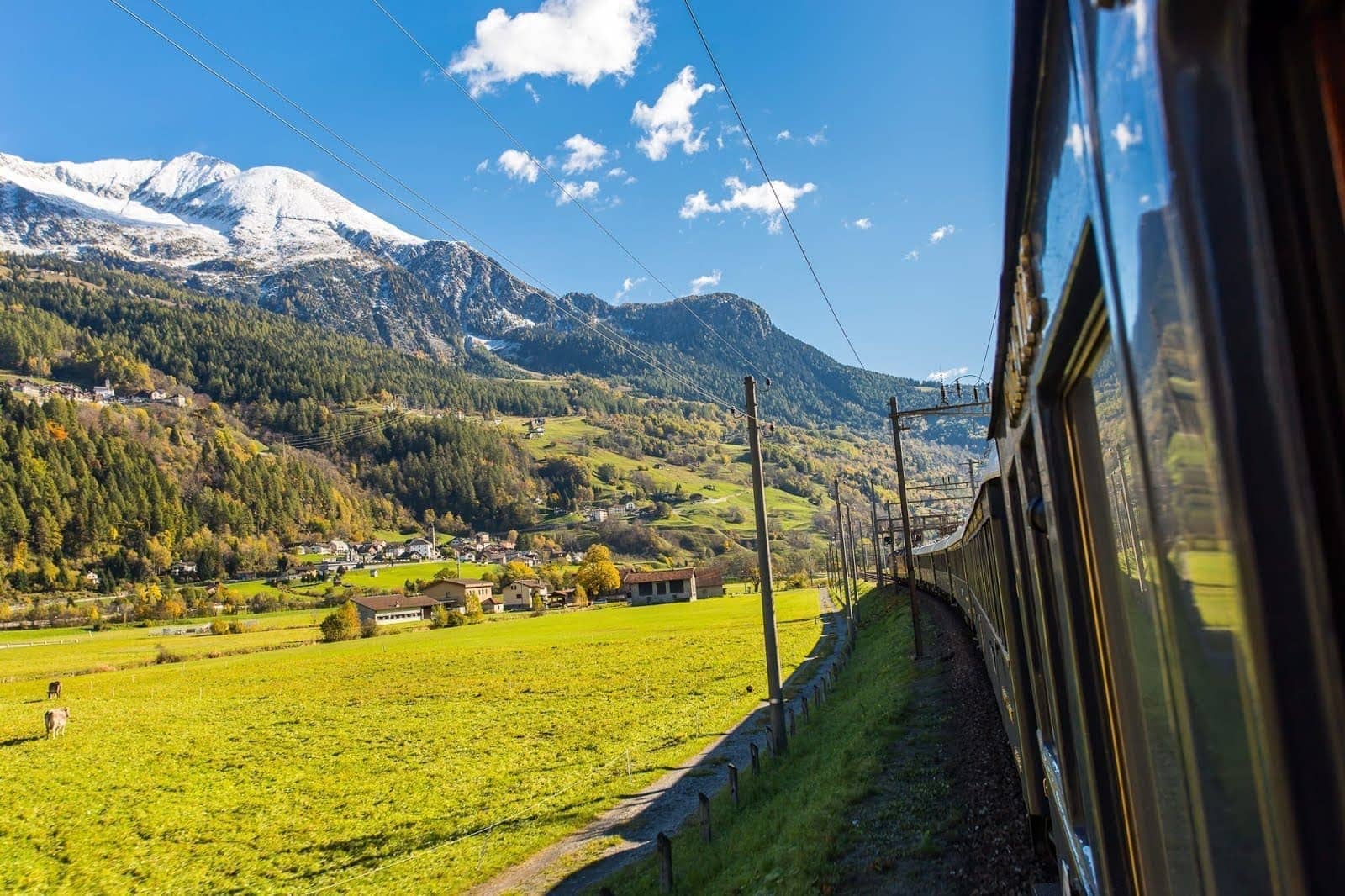
When to Visit Europe
You can certainly visit Europe year-round, although visiting at different times of year will give you different experiences.
For the most part, summers in Europe are quite warm, with temperatures likely to be between 25C & 32C (77F – 90F) on average. Whilst the weather is going to be most reliable in the summer months of June through August, this is also going to be the busiest time of year to visit.
The cities in particular are very popular with visitors, and lines for attractions can be long at these times of year. We wouldn’t say you shouldn’t visit at this time of year, but you should definitely plan ahead and arrange all your entry tickets so as to make the most effective use of your time.
Our favourite time to travel in Europe is the shoulder months of April / May, and September / October. These months tend to offer a combination of reasonable weather and less busy attractions.
We’ve also travelled extensively throughout Europe in the cooler winter months, from November through to March. It never gets much below freezing during this time, so as long as you dress appropriately, we think you will have a great time.
See our guide to what to pack for London to give you some ideas of what you might want to bring along.
We don’t think there’s a bad time of year to travel in Europe. It’s just a question of planning and preparing properly in advance. It is also worth checking if there are any events happening in the city when you visit that might cause it to be busier.
For example, Venice has a major Carnival celebration near the start of the year, and the city is always busier at this time. Other cities also have events, and if you visit during them you will find accommodation prices will be higher, and the city will be busier.
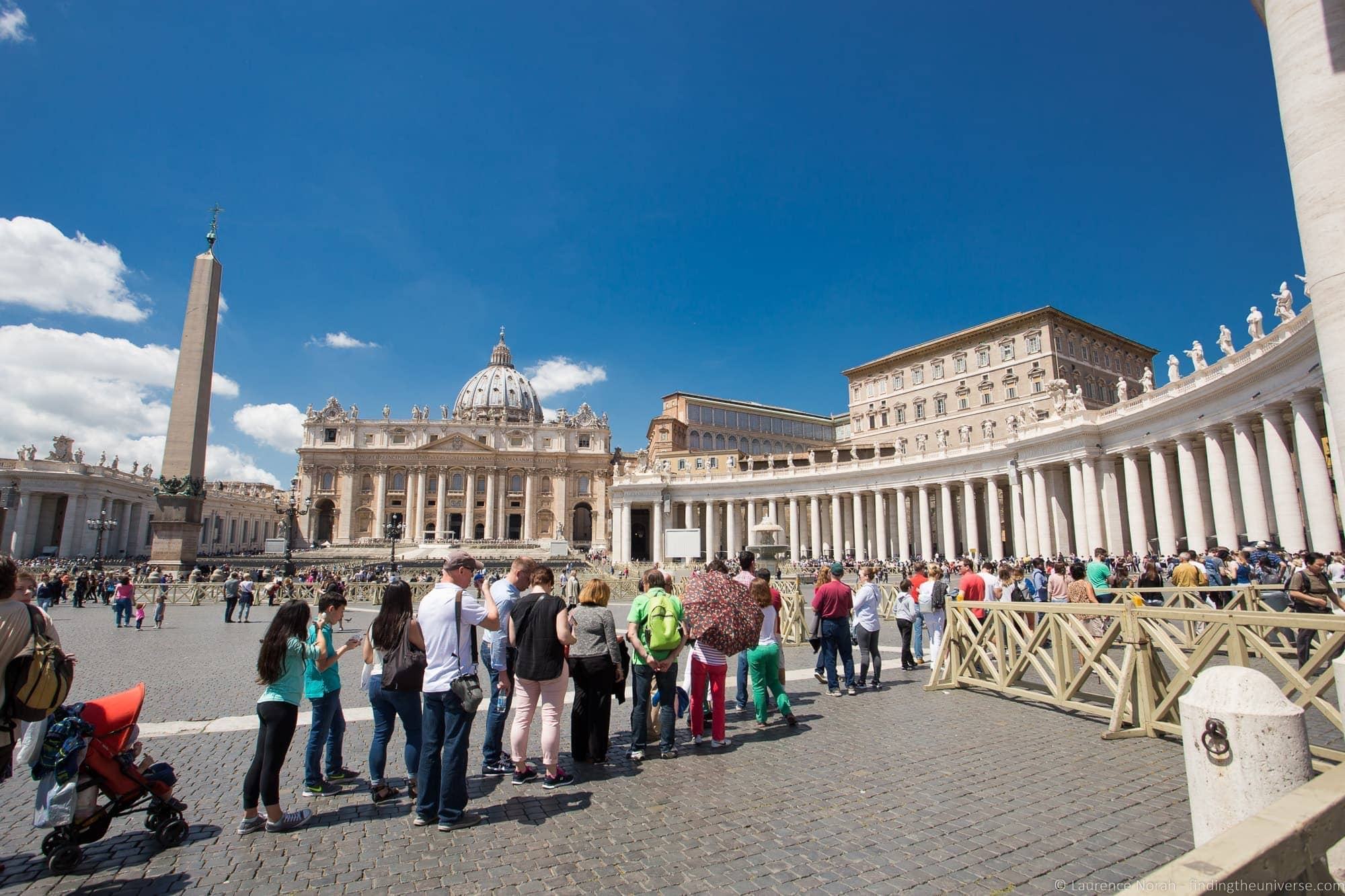
Practical Advice for Travelling in Europe
Europe uses a 220-240V electrical system, so if you are travelling from the USA, Canada, or any other country that uses a 110V system, you will need to check that your electrical items are compatible.
In our experience, lower power items like laptops and smartphone charges are compatible from 110V – 240V, but higher power items like hair dryers and hair straighteners are usually not. The power rating and acceptable voltage should be marked on the device somewhere.
It’s really important you don’t plug a device into a voltage it doesn’t support, as it will damage it. Its best to leave non-compatible items at home and purchase a dual voltage appliance if you need it during your trip, such as a dual voltage hair straightener .
In addition, the UK and continental Europe have two different plug types. Mainland Europe generally uses a two pin system with round holes, whilst the UK has a three pin system with rectangular holes.
For travel, therefore, you will need a travel adaptor like this which will let you plug your devices in. Note that most travel adaptors are not voltage convertors. You would need something like this to convert the voltage.
Internet in the form of free WiFi access is fairly easy to get access too across all the cities mentioned in our article. In addition, since the EU has abolished roaming charges, if you buy a SIM card in one EU country, you should be able to continue to use it in other countries without any additional charges.
Depending on the device you are travelling with, you will have a number of options for accessing the internet when you travel, from picking up a local SIM, to renting a WiFi hotspot, to just using WiFi as you go.
We have a detailed guide to getting online when you travel to help you figure out which is best for you.
The two currencies that you’ll need for this trip are the pound sterling (GBP) and the euro (EUR). The UK (London in the case of our itinerary) uses the pound sterling and the rest of the European destinations on our itinerary use the Euro. Euros from one country can be used in any of the other countries.
In our experience, you should be able to pay for the majority of your travel spending using a credit or debit card. We’d advise getting one of these that doesn’t impose foreign transaction fees if that is an option. Ideally it will also support contactless technology, which will make using it for smaller payments easier.
We would also suggest you always have some cash in the local currency on you for small purchases, tips, and places that don’t accept credit cards (or if there is any issues with your credit card).
There are cash machines available in all the major cities on this itinerary where you will be able to use your bank card to withdraw a local currency. Depending on the policy of your bank at home, you might be able to withdraw cash from these without a fee, but do check in advance of your travel so you don’t pay fees unexpectedly. Some ATM’s also charge a fee.
If there is a fee from your bank for withdrawing cash, you might find it is more cost effective to order some money at home before you leave – or to find a bank account that lets you withdraw cash fee free.
All the cities that we have listed are relatively safe, but of course you should take the same safety precautions when travelling that you would at home. Avoid walking alone at night in unfamiliar areas and don’t leave valuables lying around where they could be easily snatched.
It’s also a good idea to read up on some of the common scams that you might encounter in each city – for example, we wrote a guide to common scams in Paris to give you an idea of what to look out for.
We’d also suggest keeping your valuables locked in your hotel safe when possible, and to avoid carrying large amounts of money on you. We’d also suggest having a good travel insurance policy. Basically, just apply the same safety principles that you would at home to your personal belongings and safety, and you should have a safe trip!
Drinking Water
Unless otherwise indicated with a sign, the water in the taps in all of the cities on our list is safe to drink. In some cities, you’ll also found water fountains where you can refill your water bottle.
The water in Barcelona does have a slightly strange taste due to the high mineral content, and many local people prefer to drink bottled water. However, the tap water is safe to drink unless otherwise noted.
We very much recommend that you travel with a high quality reusable water bottle like this and fill it up as you go. This will be friendlier to the environment, and save you having to spend money on a resource that is available for free.
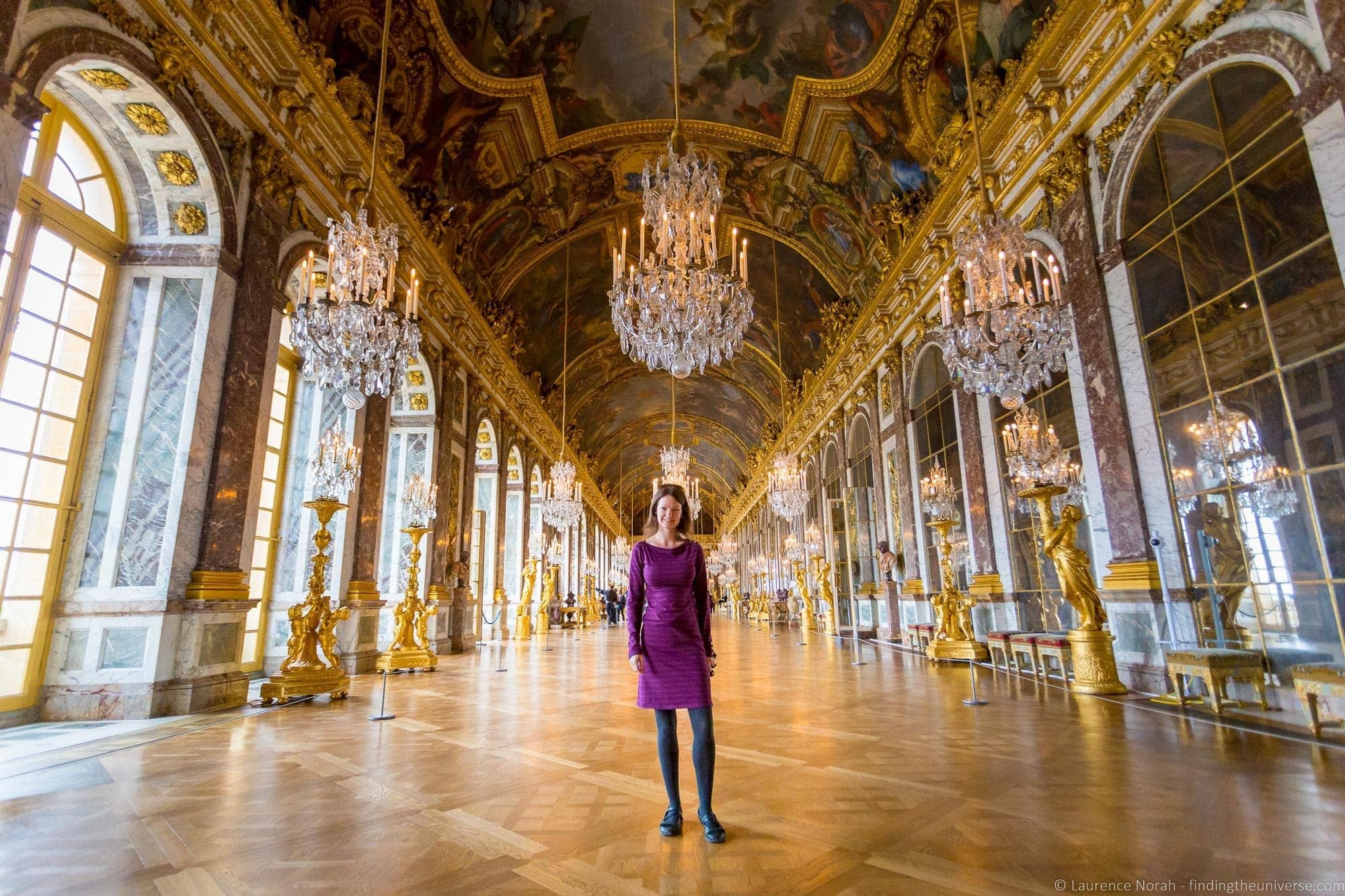
Walking Tours in Europe
One of our favourite ways to explore a new city is to take a walking tour. It’s a great way to get oriented, learn about the city, its sights and its culture, plus get local tips on places to eat, drink and see from the guide.
We’ve taken walking tours in cities around the world, and we nearly always use one of two companies – Take Walks , and Context . Both of these companies offer small group walking tours in all the cities we’ve covered.
Take Walks offers tours with groups of up to around 14, whilst Context offers more private and semi-private tours. Here are some example tours to consider for the various cities in this itinerary.
- This London In a Day tour visit the highlights of London in one day, including the Tower of London, Westminster Abbey & Changing of the Guard.
- This introduction to London Tour which includes many of the highlights of the city
- This tour of the Chruchill War Rooms in London
- This full day tour of Paris which includes a Skip the Line Louvre Tour, the Eiffel Tower, Montmartre & a Seine River Cruise
- An introduction to Paris Tour , which includes the Louvre, Opera Garnier and the Champs-Elysees
- A full day tour of Barcelona which includes a visit to La Sagrada Família, Casa Milà & the Gothic Quarter
- This Rome In A Day Tour which includes a guided visit and skip the line entry to the Vatican, the Colosseum & a tour of the Historic Center of the city
- A full day tour of Venice which includes St. Mark’s Basilica, the Doge’s Palace, & a Gondola Ride
Of course, this is just a sample of some of the many tours available, which vary in length from a couple of hours to a full day. We suggest taking a look at all the walks on Take Walks here and Context here . Note that all bookings through our Context links save you 10% on the tour price automatically.
Finally, there are of course a multitude of other options for walking tours. If you would like more options, we suggest looking at the listings on either GetYourGuide or Viator. These two sites have tour options from a wide range of companies, and you can read reviews from other travellers prior to booking to decide if it’s a good option for you.
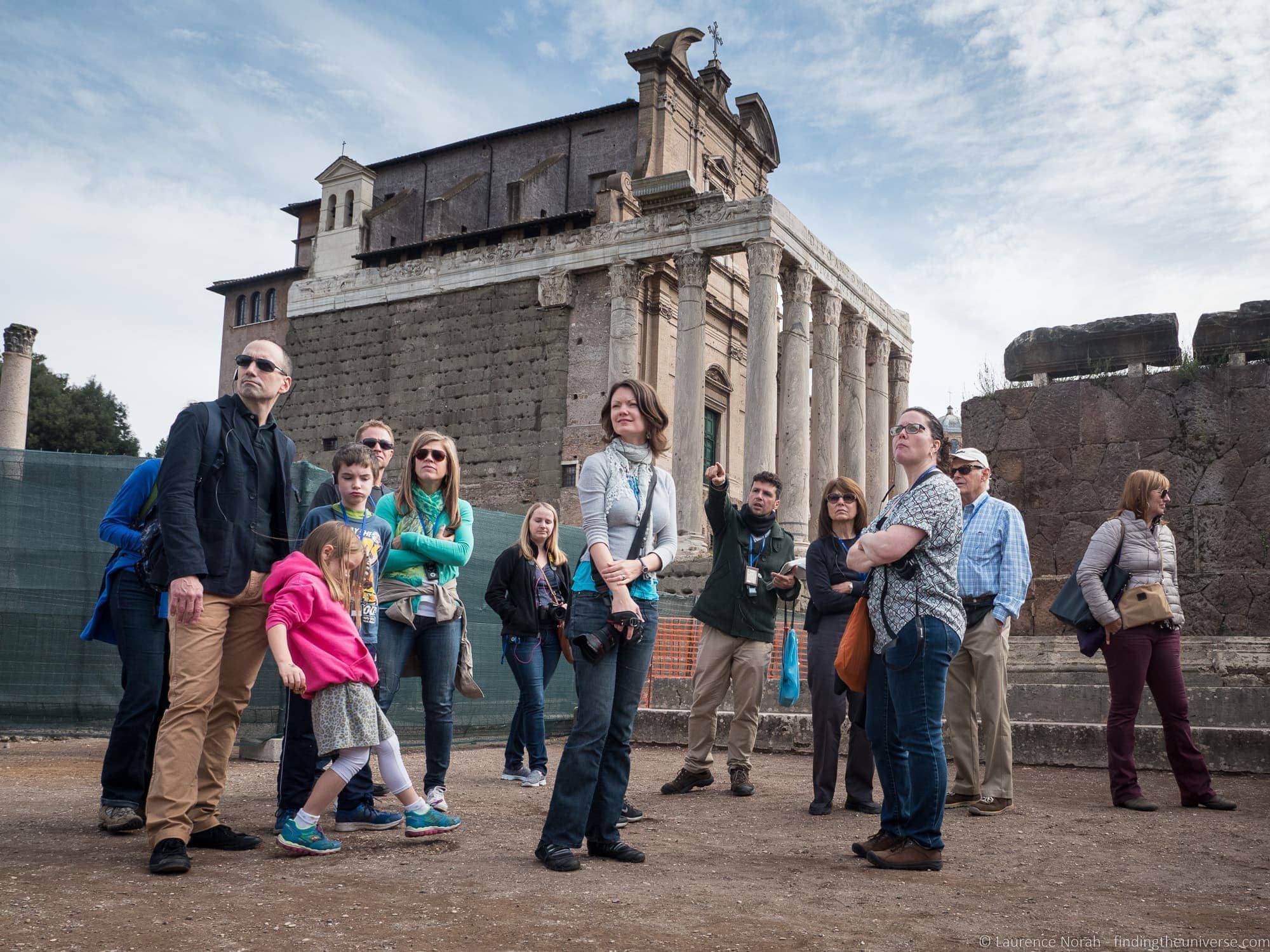
Saving Money in Europe
Europe, and western Europe in particular, is not exactly known for being a budget destination. The cities in particular are fairly expensive. Your main costs on this trip are likely to be the flights (biggest cost for most), accommodation, attraction entry, transport between the cities, and eating out.
To help you control these costs, we wanted to share some of our tips from years of experience travelling in European cities, so you don’t spend money unnecessarily. Even if you’re not on a tight budget, there’s no need to waste money when you don’t have to!
Use City Passes
All the cities in our itinerary have one or more city passes to choose from. City passes generally include either free or discounted admission to the major attractions in the city, and may also include other benefits.
These other benefits will vary, but will generally include things like fast track entry to some attractions, inclusive public transport, hop on hop off bus tickets, and discounts on meals and other activities like walking tours, wine tastings, and so on.
We have used a number of city passes during our travels in the cities in this itinerary, and our recommended passes for you to consider are as follows:
- For London: The London Pass. Available in durations from one to ten days, covers all the major attractions in London. See our full review of the London Pass here , and buy yours here .
- For Paris: The Paris Pass or the Paris Museum Pass. The Paris Pass includes entry to most of Paris’s major museums, plus includes attractions like a HOHO bus and Seine River Cruise. The Paris Museum Pass just covers attraction entry fees. See our full review of the Paris Pass here , and buy your Paris Pass here . We also have a full review of the Paris Museum Pass here, and you can buy it here .
- For Barcelona: The Go Barcelona Pass , Barcelona City Pass and Barcelona Card . These vary in what they cover, and whilst we suggest you pick up at least one of them, the best one for you will depend on your interests. See our full comparison of the Barcelona City Passes for more information.
- For Rome: The Omnia Rome and Vatican Card or the Roma Pass . Both these passes include free public transport in Rome, as well as free and discounted admission to attractions across the city. The Omnia Rome and Vatican Card also includes skip the line access to the Vatican Museums, St. Peter’s Basilica, as well as other Vatican attractions. It also has a hop on hop off bus.
- For Venice : We have never used a discount card in Venice. However, there is a Venice Pass which includes many of the museums and churches that is well worth checking out.
If you are planning on seeing a number of sights in each city you visit, a city pass can definitely save you money. Some of them will also save you time, as they offer skip the line benefits. However, we do recommend doing a little bit of reading on each pass to make sure it makes sense for your specific trip.
Note that city passes are often not as good of a value for children (especially young children) and those who are eligible for discounts at many attractions (seniors, disabled, EU university students), so do check if you qualify for any discounts before buying a pass.
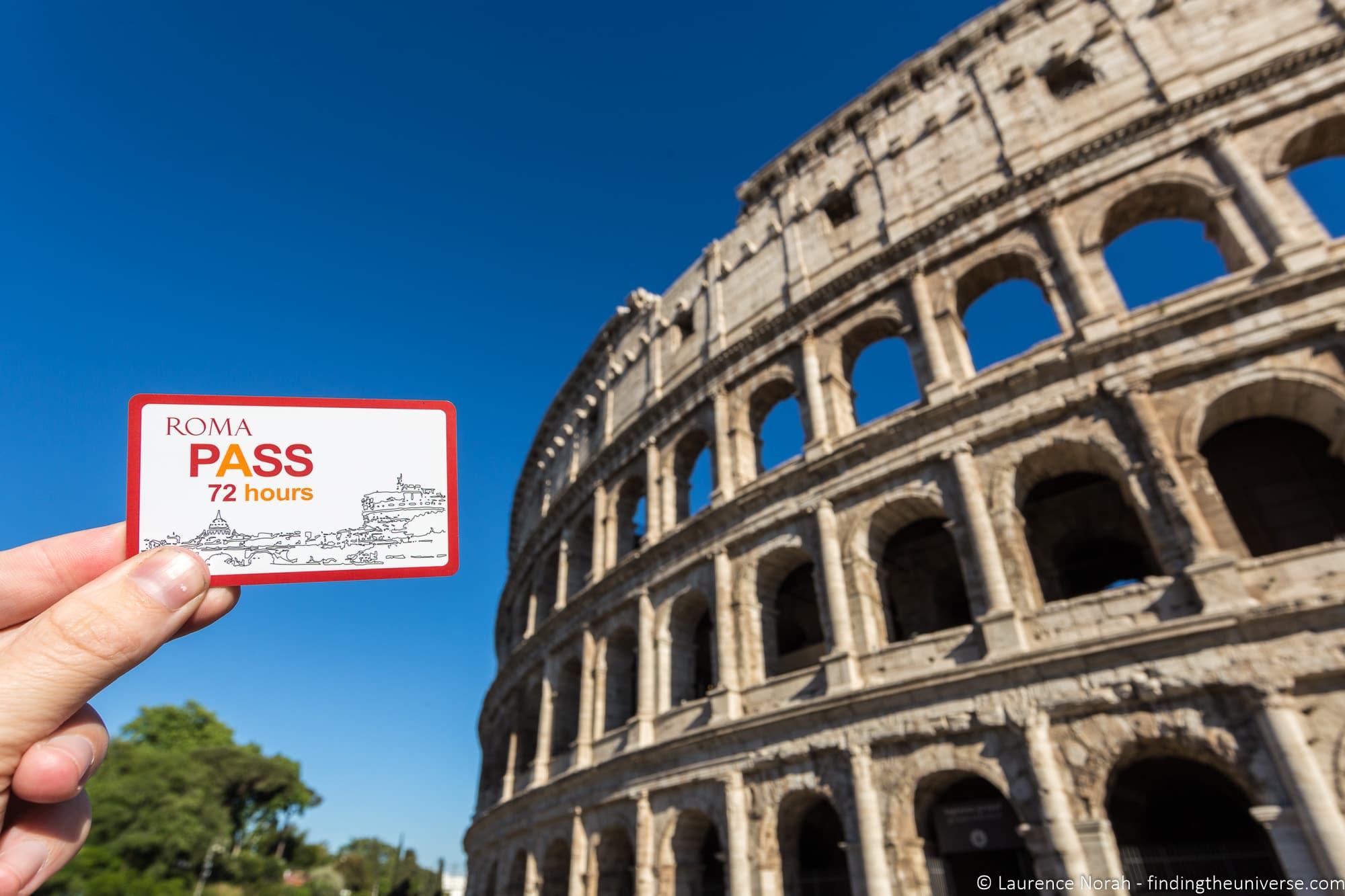
Book accommodation and transportation in advance
The two major costs on your trip are likely to be accommodation and transportation. Our major tip for both of these is to book them in advance.
For transport in Europe, the best deals are nearly always to be had if you book as far in advance as possible. The cheapest tickets on flights and trains always sell out first, and then the prices will increase.
We recommend you check your flights and book in advance here , and your trains here .
Accommodation is not quite so straight forward, as prices can dip and rise depending on demand. However, in our personal experience, prices tend to be lower if we book further in advance. Plus, you can often take advantage of free cancellation policies, and re-book if the prices drop.
Also, don’t forget to look at accommodation options beyond hotels. Short term apartment rentals can be very cost effective, plus they will allow you to prepare some of your own meals if you want, which will also save you money.
We generally use booking.com for booking our hotels, and they also include apartments. We also use Plum Guide regularly. There are plenty more options though – see our guide to some AirBnB alternatives to give you some ideas.
Invest in a Guidebook
We recommend investing in a guidebook, especially if this is your first trip to western Europe.
Investing $15 to $25 in a guidebook can save you much more in time and money. A guidebook can cover much more in-depth information than we can in this blog post, and means you’ll have all the information you need at your fingertips.
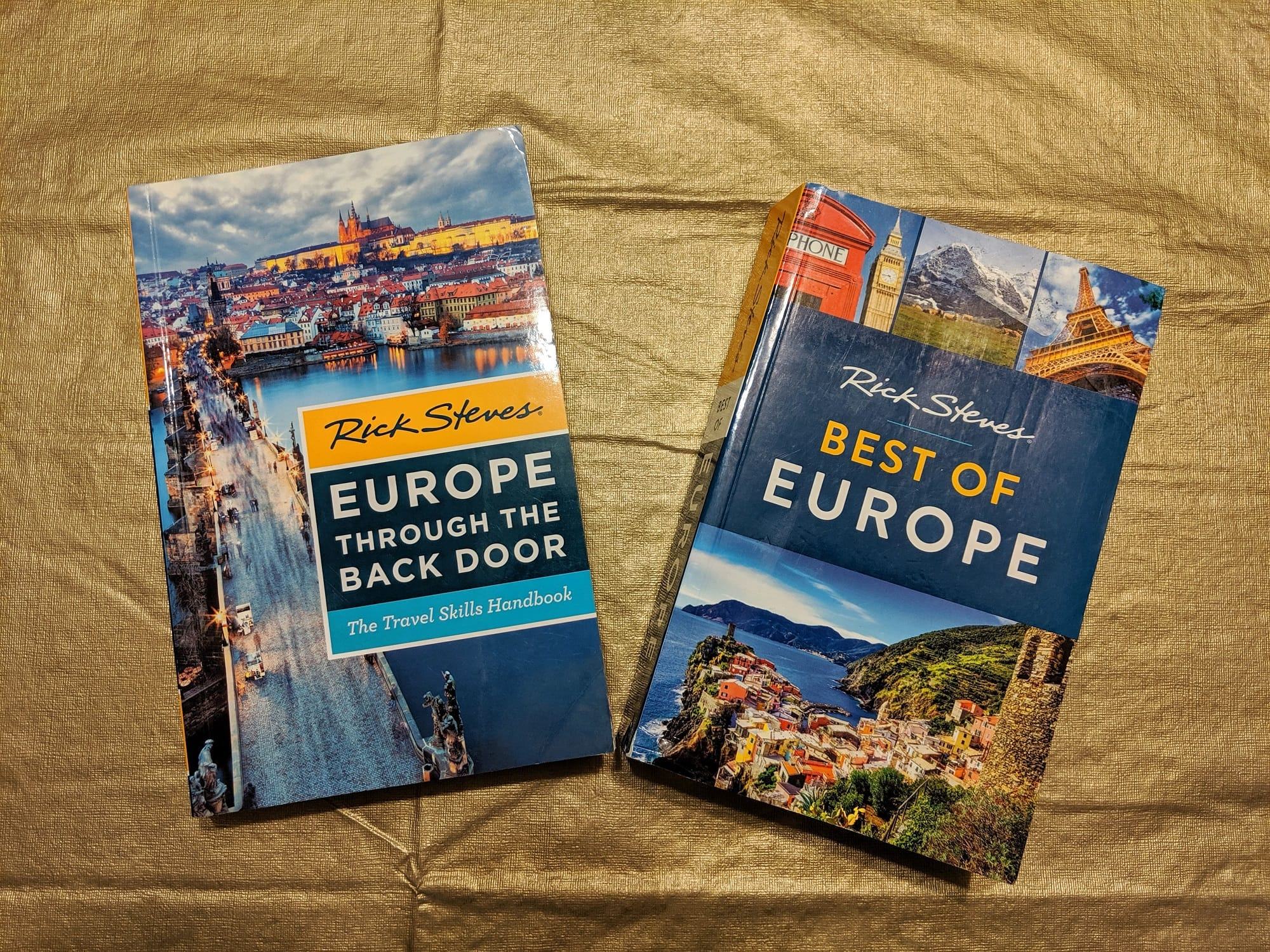
For this trip, we recommend the Rick Steves Best of Europe guide . If you had to pick one guide book, that would be our favourite – it covers all the destinations in this itinerary (plus many more!) and has lots of practical information, tips and advice to help you plan. We use and love it.
If you have room in your bag, we can also recommend the Europe through the Back Door book , which has a lot of general travel advice for Europe.
Other options to consider include Lonely Planet’s Western Europe guidebook and/or the Insight Guide to Western Europe .
Be sure to purchase a recently edited/updated version of the guidebook. So make sure it was updated in the last year or so. Most guidebooks are updated every year or two to make sure the information is as up to date as possible.
If you are not sure which guidebook may be best for you, you might want to browse in your local bookshop or library before picking one.
Use Public Transport Effectively
The cheapest and most effective way to get around the cities listed in this post is to take public transport (well, after walking of course!).
Each city has its own public transport network, with various fares and ticket options. Learning how to use these properly will save you money.
For example, in London, it’s possible to buy individual tickets using cash. However, this can be twice as expensive as using an Oyster Card or Contactless bank card for your travel. In Paris, you can buy tickets individually, or you can save money by buying booklets of ten tickets.
In addition, many of the city passes we recommend come with some sort of travel card, which can also save you money.
Basically, each transport system has its own quirks, and having a handle on these will likely save you money. We also recommend always checking to see how far your destination is on foot before taking public transport.
The public transit maps are unlikely to match up to the reality of geography, and you might find it will take the same amount of time to walk somewhere as it would have to take a bus or metro, plus walking is free!
Find restaurant deals
Our final tip covers the last major expense, which will be eating out. Of course, eating out is a major part of travelling, but the costs can quickly add up.
The good news is that you can also save money on eating out. The secret is to figure out when the restaurant deals are likely to be happening.
For example, in France and Spain, it’s very common for lunch time menus to be offered. These are usually two or three course meals, which sometimes include wine, bread and coffee, and which are usually priced under €20 per person.
For Paris, see our guide to some of the best Michelin starred restaurants for lunch deals .
In London, these aren’t as common, however, many restaurants offer theater deals. These are special priced menus offered either late in the afternoon (5pm – 7pm generally) or late in the evening (10pm and onwards), designed for theatre goers who want to get a meal before or after the show.
Of course, you don’t have to be going to the theatre to take advantage of these deals!
Other options for saving money on dining out include taking advantage of street food, picking up “meal deals” at supermarkets like M&S in London, putting together picnics from markets in Paris – the list goes on. It is certainly possible to eat on the cheap quite easily if you make a little bit of effort to do so.
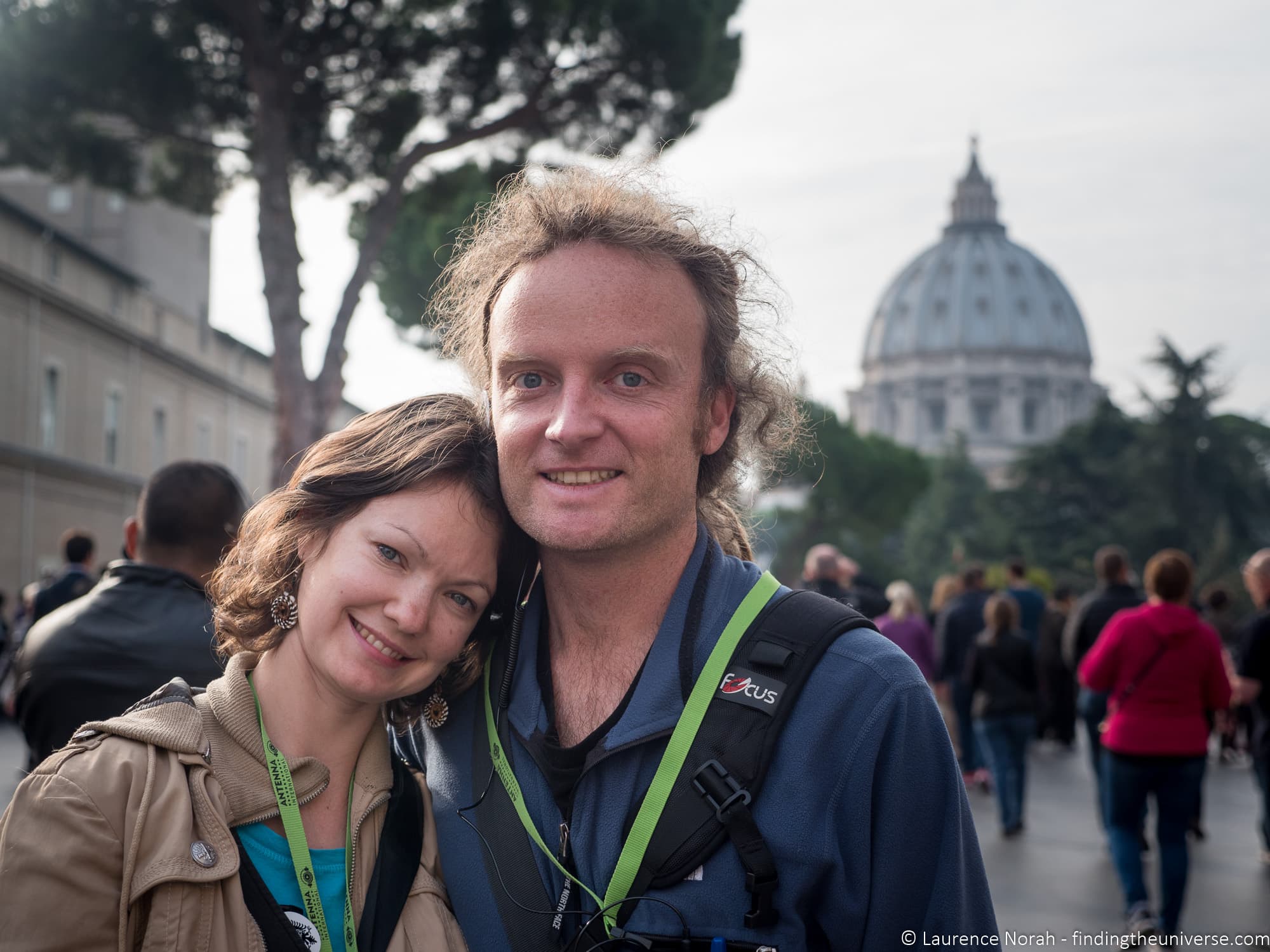
Further Reading for your Trip to Europe
Well, that’s pretty much the end of this post to help you plan your own perfect Europe itinerary and trip.
As you can see from the links shared throughout the post, we have a lot of content to help you plan your own trip to Europe. To make it easier for you, I wanted to put some of the most useful content here, for easy reference. I’ve also included some third party resources you might find useful in planning.
- For London , we have a guide for a day in London , 2 days in London , 3 days in London and 6 days in London
- We have a guide to the London Eye , Tower of London , Harry Potter filming locations in London , Winston Churchill locations in London , London’s War Museums , London’s UNESCO sites and tips on taking a walking tour in London
- We also have a guide to public transport in London , a guide to getting from the airport to London , a guide to what to pack for London , a guide to the cost of travel in the UK and a review of the London Pass
- For Paris , we have a guide to a day in Paris , 2 days in Paris and 3 days in Paris
- We have a guide to the best photography locations in Paris , afternoon tea in Paris , thoughts on the best Seine River cruises , a guide to making perfume in Paris , and advice for visiting the Moulin Rouge
- We also have a review of the Paris Pass , a review of the Paris Museum Pass , a guide to visiting the Eiffel Tower
- For Barcelona , we have a guide for 1 day in Barcelona , 2 days in Barcelona and 3 days in Barcelona .
- We have a guide to the best photography locations in Barcelona , the Anton Gaudi sites in Barcelona , and the Sagrada Familia
- We have a review of the Go Barcelona Pass and a comparison of the major Barcelona city passes
- For Rome, we have a guide to things to do in Rome , a day in Rome , 2 days in Rome and 3 days in Rome
- We also have a guide to the best gelato in Rome , the best cafes in Rome , visiting the Borghese Gallery in Rome, visiting the Colosseum in Rome and our thoughts on taking a walking tour in Rome
- For Venice , we have a guide to spending a day in Venice
- We also have a guide to visiting the Doge’s Palace & St. Mark’s Basilica , as well as our thoughts on a tour of Casanova’s Venice
- Investing in a guidebook can help save you time and money on your trip and help you be prepared. For this trip, we recommend the Rick Steves Best of Europe guide , Lonely Planet’s Western Europe guidebook and/or the Insight Guide to Western Europe
And that’s it for our guide to spending 2 weeks in Europe! As always, we’re open to questions, comments and feedback – just pop them in the comments section below, and we’ll get back to you as soon as we can!
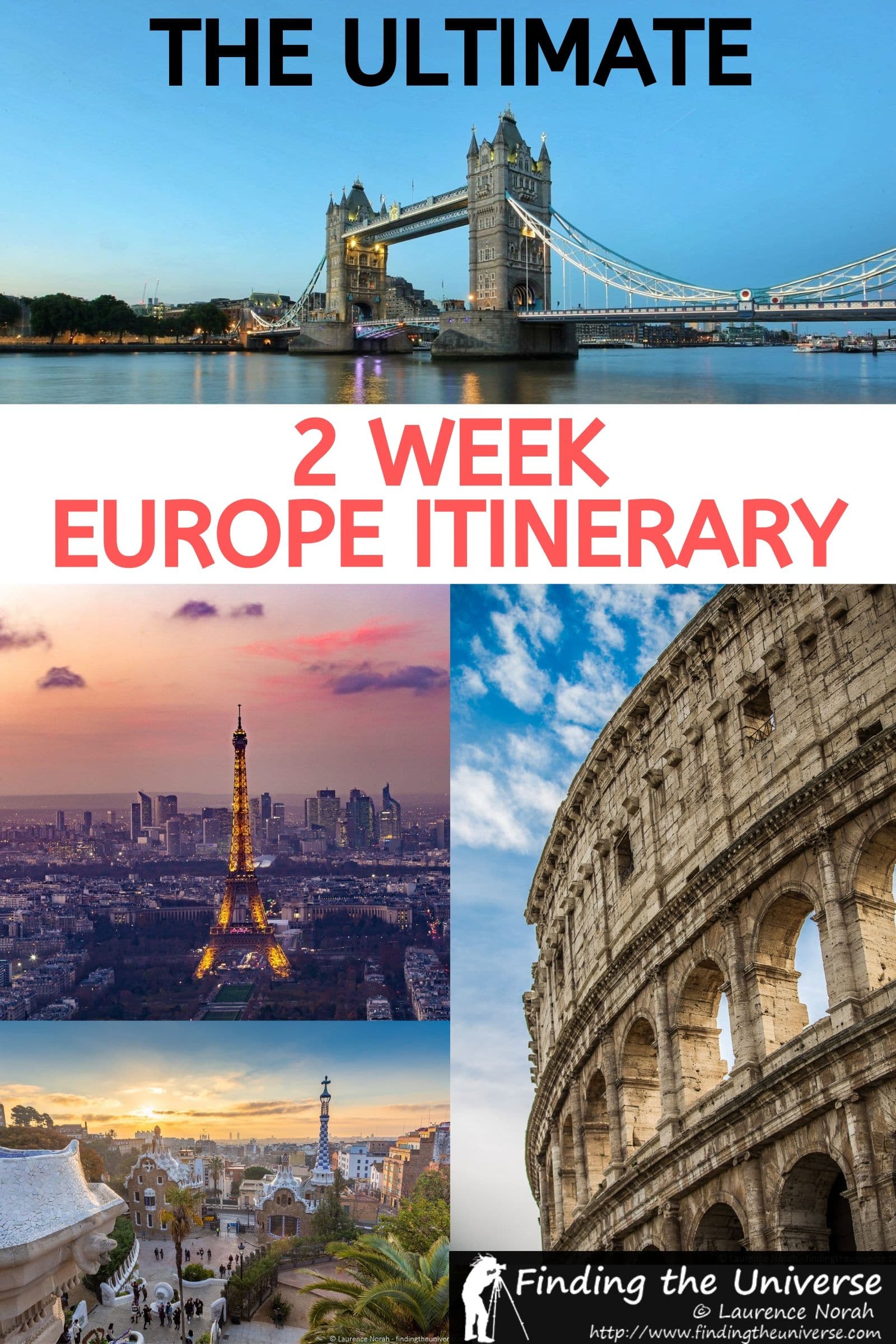
Enjoyed this post? Why not share it!
There are 30 comments on this post
Please scroll to the end to leave a comment
Kirsten says
1st April 2023 at 1:43 am
We just came back from this exact trip on 3/26/23. We followed your itinerary and most of your suggestions on what to do in each city. Thank you so much for putting this together. My husband and I aren’t the best planners and this step by step guide was so helpful and perfect for us! We really couldn’t have done it without you. Thank you!
Laurence Norah says
2nd April 2023 at 10:33 pm
Hi Kirsten!
Thank you so much for taking the time to stop by and share your experience! I’m delighted to hear you guys had a great time in Europe and that we were able to help with your trip planning, it really means a lot to know that our content is helpful 🙂
Safe travels!
Laurence & Jessica
12th February 2023 at 3:08 pm
This is an awesome itinerary. Thank you so much for sharing! We hope to make our first trip to Europe in the future.
12th February 2023 at 4:18 pm
My pleasure Sara, I hope you get to visit Europe soon and do let me know if you have any questions when you start to plan your trip!
6th February 2023 at 12:20 am
Hello, Thank you for great posts on Europe trip. Really help a lot when I’m trying to plan for mine. Do you mind sharing apartment name you stayed in Paris, the one with Eiffel tower view? Im looking for nice apartment to stay with Eiffel tower view for my honeymoon this year. Really appreciate it if you could share. Thank you 🙂
9th February 2023 at 8:15 am
Thanks very much. So the apartment was this one which we booked via Plum Guide. I’m not sure it’s still bookable, although there is an option to message the host. I’d also recommend the Eiffel Tower guide we have here , as that as a selection of accommodation options with good views. We’ve also stayed at the Pullman Paris hotel which has excellent Eiffel Tower views for example.
Have a great trip to Europe!
19th January 2023 at 4:05 pm
I’ve subscribed, but still cannot gain printing access…please help – thank you!
23rd January 2023 at 2:17 pm
Sorry for the slow response, we’re travelling in Uganda and Internet access has been sporadic! I can see you are an active subscriber, does it still not work when you put your email address in on the print page? If not, if you could let me know what device and browser you are using and I’ll see if I can figure out what is going on!
2nd July 2022 at 3:39 am
This was a great blog. I am trying to put together a surprise trip for my wife’s 40th next year. I am gonna try to do it myself based off all the deals y’all have given. Bless
2nd July 2022 at 10:58 am
My pleasure Wayne, have a great trip and do let me know if you have any questions 🙂
alex47_in_downtown says
8th February 2022 at 2:16 pm
This was the most detailed, informative & hence the most helpful travel blogpost I’ve ever read… 🙂 Perfect itinerary for first-timers (like me)…! Lots of love from India <3
10th February 2022 at 12:11 pm
Thanks very much Alex, I was delighted to be of help! I hope you have a great time in Europe, and do let me know if you have any questions!
Ashley Salgado says
8th October 2022 at 7:19 pm
Why not have a pdf versión to be able to print. Tried to print this but it’s a whopping 100 pages with all the ads and comments. Great info I’d love to print and read with time not on a screen.
8th October 2022 at 11:23 pm
Thanks for your message! Every post is available in printable format, if you look at the bottom of the post on mobile, or the side on desktop, there is a little print icon. If you press that you can go through the steps to access a printable version without ads, comments or images. You can then print it to PDF, most devices these days let you save a webpage as a PDF from the print option.
Have a great time in Europe!
Michelle says
2nd November 2021 at 1:49 am
I’m so glad I found this blog. This is so helpful and fantastic. It really gives us a clearer picture on how to plan our first trip to Europe (16 days) and it hits the cities we want to start off with and we plan on doing. Thank you!!!
2nd November 2021 at 11:06 am
My pleasure Michelle! Have a wonderful trip across Europe, and do let me know if you have any questions!
Penny Hampton says
2nd January 2021 at 2:42 pm
Loved your blog on traveling to Europe. We have never been to Europe so this would be our first time. What you write is exactly what we are looking for. Great advise on everything from where to go-where to stay and where to visit. If Covid ever dies down, we will try to make the trip.
2nd January 2021 at 2:46 pm
Thank you so much Penny! I certainly hope you get to take a trip sooner rather than later 🙂 If you have any questions when it comes to the planning, just let me know. Happy 2021!
20th February 2020 at 4:03 am
Hi Lawrence and Jessica,
Thank you so much for this article, it has been very helpful as I try and plan out our first trip to Europe. I will be taking my sons ages 24 and 18 this summer and are hoping to say about 18 days. We are planning to go to every location except Barcelona, and would like to add a city in either the Netherlands, Belgium or Switzerland. Which would you recommend? Also we are planning to travel at the end of July/early August, so I’m sure our costs will be quite high. Any thoughts on how much I should expect a 2 week trip to cost? I know that may be a difficult question to answer, but even if it’s a broad ballpark it would be very helpful.
20th February 2020 at 12:43 pm
Our pleasure, sounds like you have a great trip coming up! So yes, this is a really hard question to answer 😉 I would suggest taking a look at our suggested costs for a UK trip here , which should help with your planning. Prices in continental Europe are fairly comparable to the UK. Everyone has a different travel style and budget, and idea of what is expensive or acceptable, so it’s hard to know. There would be a huge difference depending on if it was hostel accommodation of 5* 😉 Just be aware that capital cities tend to be more expensive as a general rule of thumb.
In terms of saving, definitely check out apartment rentals which might work out cheaper as you are in a group. Also, booking transport well in advance (planes and trains) will make a huge difference to the cost. Flexibility in timing is also useful.
In terms of adding another city, Amsterdam is obviously nice but busy. Ghent and Bruges are lovely in Belgium. We’ve actually just come back from Switzerland. There’s a lot to choose from and a great transport network, but Geneva is a good starting point.
Let me know if you have any more questions, I’m happy to try and help!
12th February 2020 at 4:36 pm
I’ve sent this to my wife, this looks amazing! I think ill try to see if we can get an overnight Rail between the far trips however, this looks fantastic! and Exciting!
It will be our 1st trip to the EU, so hitting up all these locations at once will give us a great taste of so many locations!
12th February 2020 at 5:38 pm
Thanks Ryan! I hope you guys have a great trip, and do let me know if you have any questions!
10th December 2019 at 4:46 pm
Amazing article! You have inspired me to explore Europe soon! Thanks!
10th December 2019 at 4:58 pm
Thanks very much – I hope you get to visit soon and have a great trip when you do!
19th November 2019 at 4:03 pm
Loved this article and found it very useful. I’m in the process of trying to plan a trip for next year with my 18 and 19 year olds. I can’t quite committ to exactly where I want to take them. This will be our first trip overseas and I’ve been driving myself crazy googling different locations and ideas. This article has been one of the best as I feel like I really need a step by step guide to create and book whatever vacation I decide to go with. Any tips on what you think would be a great trip for that age bracket would be very appreciated.
20th November 2019 at 3:06 pm
Awesome, delighted to have been able to help. So I think this itinerary will work for your family, the only thing might be to tweak the attractions you visit based on your interests and the interests of your family. So if they aren’t into lots of museums, or art, then maybe cut those back a bit. Perhaps they’d be more interested in food tours or more interactive things like that. The best option would definitely be to just have a chat with them and find out what they might like to do, and then you can try to make everyone happy 😉 Communication is definitely key, and if they feel they have input and control then I think everyone will have a better time.
I hope this helps a bit!
Have an amazing trip and don’t hesitate to reach out if you have any more questions!
Natasha says
4th October 2019 at 1:19 pm
I might suggest taking skipping at least Barcelona. It’s not that it’s not beautiful, it definetly is. The city can’t handle all the tourist coming its way…Please do some research beforehand. I might opt for a longer stay in one city than trying to do too much. Or focus on one region. You probably wouldn’t do New York, California, Chicago and Grand Canyon in 2 weeks… It may not look like it on the map, but these aren’t such small distances.
4th October 2019 at 7:40 pm
Hi Natasha,
Thanks for your feedback. I’d disagree about Barcelona as I think it’s a beautiful city (we have visited many times – this article is based on our experiences not research). We would agree that folks should try and spend longer in each place rather than moving too fast for sure, and slower travel is something we prefer ourselves. That said, not everyone has the luxury of longer vacations, and wants to see quite a few places, hence we’ve put this itinerary together. Compared to some itineraries, we think it’s actually pretty relaxed and achievable 🙂
Thanks again for taking the time to comment!
14th September 2019 at 4:57 pm
Thanks for this detailed itinerary and plans. I really liked reading this. We are planning for a Europe trip on coming December. Do you think the itinerary you mentioned can be a difficult one to choose because of weather in December?
14th September 2019 at 5:47 pm
I think the itinerary is do-able at any time of year. December is a good month for visiting Europe as you have the pretty Christmas lights and Christmas markets. Obviously it will be colder and there’s more chance of rain, but appropriate clothing will solve that issue!
Have a great trip and let me know if I can be of any more help 🙂
Leave a Reply Cancel reply
Your email address will not be published. Required fields are marked *
Let me know when there's a reply to my comment (just replies to your comment, no other e-mails, we promise!)
Subscribe to our monthly Newsletter where we share our latest travel news and tips. This also makes you eligible to enter our monthly giveaways!
We only ask for your e-mail so we can verify you are human and if requested notify you of a reply. To do this, we store your data as outlined in our privacy policy . Your e-mail will not be published or used for any other reason other than those outlined above.

2 Weeks in Europe: 6 Itineraries
DISCLAIMER: This post might have links to travel services and products that we enjoy. We might make a commission from it at no extra cost to you.
Europe is a continent consisting of 44 countries with diverse languages, climates, and cultures . It has numerous world-famous landmarks preserved from years upon years of history.
Spending 2 weeks in Europe will cover plenty of amazing places. It’s not much, but a good start, especially if it’s your first time here.
Another great thing about Europe is that the places are close to each other, you can reach most of them via train, buses, and driving. Land borders separate the countries. However, many of them practice free movement across borders.
This continent has peninsulas, islands, and varied landforms, as well as seas, lakes, and other bodies of water. There are infinite fascinating places to see, foods to taste, and activities to try out during your 2 weeks in Europe.
NOTE : Originally, we had a section for things to know before visiting or planning your Europe trip. Since this post grew to 8,000 words, we decided to move that section to a separate post to make it easier for you to read and scan the post. Go to our How to Plan a Trip to Europe for 2 weeks to see tips on when to go, what to budget, transportation, and more.
TRAVEL SITES AND SERVICES TO BOOK YOUR NEEDS
Top places in europe (pinned map).
Click the icon on the top right to enlarge the map. Credit: map data: Google
2 WEEKS IN EUROPE ITINERARIES
I will show you six itinerary options to choose from for your 14 days in Europe. Covering multiple countries and featuring famous attractions that are historical, cultural, and outdoor activities.
Deciding where to spend your 2 weeks in Europe can be hard. Should it be in Spain or Portugal? How about both? Should you visit Rome or Paris ? When unsure, there are a few things you can do to see which places are more suitable for you.
For example, Rome would be ideal if you love historical sites such as ruins. Perhaps you like history, but in the form of art, then Paris is the one. For food lovers, don’t miss visiting France, Spain, Italy, and Greece.
Itinerary #1 South Europe: Spain and France or France and Italy
We have two sub-options in our first itinerary for your 2 weeks in Europe. This includes either Spain and France or France and Italy. Spain is well-known for its lively culture, flamenco, arts, and literature, as well as its wines, beaches, and, of course, football.
If you feel like this itinerary is a little too expensive, you can instead go to Portugal. Take a look at how to spend 2 weeks in Portuga l or even just a few days in Lisbon. Spending 14 days in Southern Europe is a good place to do your first trip to this continent.
France, on the other hand, is well-known for macarons, wine, champagne, great pastries, as well as fashion, museums, and other historical sites. You could also do many water activities in France or if you plan to come during winter, you can head to the Alps for some skiing.
Italy is loved for its opera, its art cities, unique scenery, and good food. They are also among the four fashion capitals, with luxury brands, and of course, who could forget the Vespa?
If you have never been to Italy, make sure you visit Venice, Rome, Florence, and the southwest coast, where you can visit Naples for Amalfi and Sorrento. You can also consider 2 weeks in Greece for this itinerary. Not to mention, the south is a famous region to spend honeymoon in Europe .
Spain for 7 days
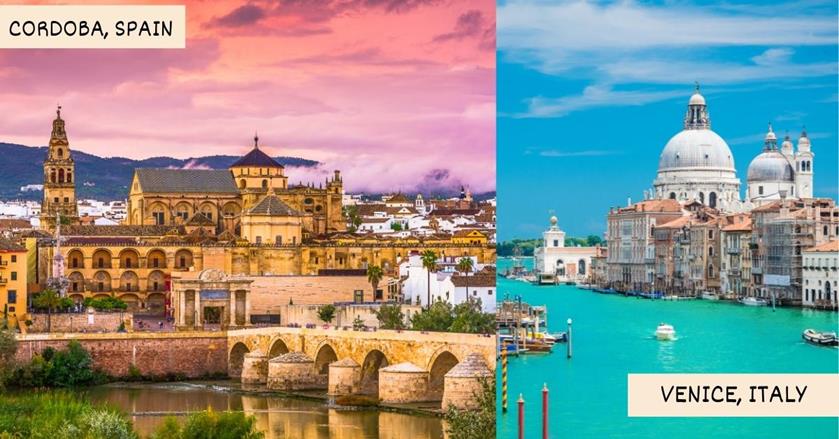
Spain is one of the most popular destinations in Europe, not only for foreign visitors but also for other European nations. With its stunning beaches, yummy food, and very welcoming culture, Spain is undeniably a must-visit when you come to Europe for 2 weeks.
Most people go to Madrid, the capital of Barcelona, a coastal city. However, if you want to get away from big crowds, head to Seville, Valencia, or even Zaragoza. For young travellers who love to dance and party, Ibiza is a top spot, while Palma, Tenerife, and Gran Canaria are awesome islands to explore and spend your vacation in.
We have a specific 2 weeks in Spain itinerary , which might help you plan a trip there if you decide to spend your trip in one European country only.
Here are some of the top-rated attractions in Spain :
- Alhambra and Generalife in Granada
- Palacio Real in Madrid – get your ticket in advance
- El Escorial near Madrid
- Aqueduct of Segovia – north of Madrid
- Sagrada Familia and Gaudi Sites in Barcelona – check tour prices
- Great Mosque in Cordoba, near Seville
- Guggenheim Museum in Bilbao
- Beaches of Gran Canaria
France for 7 days
Some of the options to reach France from Spain include flying, taking a train, riding the bus, using rideshare or driving. The most recommended option is to ride a plane, but if you have plenty of time, you should consider renting a car and driving on your own. We have an article with 3 different itineraries on how to spend 2 weeks in France .
France is a country famous for many reasons. The food is great, it is rich in culture, the abundance of historical sites, and thousands of wineries to explore. France is also known for Tour de France and is a great holiday destination any time of the year. You should geat a hop-on hop-off bu s that will take you to the top attractions of Paris.
Paris is an obvious place to visit, but if you don’t like big cities or have been here before, you can consider other places. For history buffs, head to Calais, Dunkirk, and Normandy. For those who love the outdoors, check out Lyon, Marseille, Nice, and Bordeaux (aka the Basque region).
Here are some of the top attractions n France:
- The Louvre in Paris – book a guided tour
- Cathédrale Notre-Dame de Chartres near Paris
- Eiffel Tower in Paris – get your skip-the-line ticket in advance
- Chateau de Versailles in Paris – visit with a garden access
- Mont Saint Michel
- Loire Valley Chateaux
- Côte d’Azur aka French Riviera in the South
- Provence for lavender fields
- Chamonix-Mont-Blanc for skiing in the Alps
Italy for 7 days
To reach Italy from France, you could either take the train or fly but taking the train is preferred by most tourists and locals alike because you’ll be able to reach your destination in less than five hours anyway. There are tons of routes to choose from if you want to see some interesting scenery and plan to drive instead.
2 weeks in Europe have to include Italy. It is loved for its dishes to die for, beautiful castles, amazing hiking trails, and warm culture. Just like in Spain and France, wine in Italy is world-class and their historical sites are well preserved.
Before you book anything, decide where you want to go. Rome and Venice are the top places to visit in Italy. But if you have been there, it’s time to explore Florence, Milan, Bologna, and Genoa in the north. For the south, head to Naples, Sicily, and all the way to Palermo. Check out our 4 itineraries for 2 weeks in Italy .
Some of the top tourist attractions in Italy include :
- Colosseum in Rome – get your ticket in advance to skip the very long queue
- Spanish Steps in Rome
- Trevi Fountain in Rome
- Venice Grand Canal – don’t skip the romantic gondola ride
- Gode Palace and St. Mark’s Basilica in Venice – explore with a tour guide and secure a ticket
- Leaning Tower of Pisa
- Vatican City near Rome; Basilica of St. Peter, Sistine Chapel & Vatican Museums – you can visit this in one go
- The Uffizi Gallery in Florence
- Cathedral of Santa Maria del Fiore in Florence
- Lake Como near Milan
- Cinque Terre
- Amalfi Coast
- Pompei and Mount Vesuvius in Naples – visit this and the entirety of Naples on a day trip from Rome
Travel cost
These three destinations are one of the most expensive places in Europe. Budget around $2,000 for a 2-week trip around Spain, France, and Italy not including the flights from your location and back. Accommodation will be the most expensive cost while food is quite affordable in these places.
Of course, if you want to travel with luxury, you can easily spend $3,000-$5,000 which will allow you to stay at 4-5 star hotels, dine at fancy restaurants, and take a private car with a driver anywhere.
For those on a tight budget, $1,500 is possible , however, you will likely stay at youth hostels and share a room with other people in dorm/bunk rooms or even look at Couchsurfing. You can also save more money by looking at ready-to-eat meals at grocery stores or cooking in the hostel is possible. Join a free walking tour where you will be expected to give a tip based on the tour guide and the tour itself.
Itinerary #2 Central Europe: Germany and Poland
For this next itinerary, we’ll be covering 2 weeks in Central Europe, which consists of the countries Germany, Poland, Switzerland, Liechtenstein, Austria, Czechia, Slovakia, and Hungary. However, in this itinerary, we’ll only be covering Germany and Poland.
Germany is well-known for its cathedrals, castles, palaces, and colourful architecture, as well as its sausages and beers. It has many historical sites relating to World War I and II. Berlin is loved for being vegan-friendly, but meat-eaters shouldn’t have a problem finding their way around restaurants either.
Conversely, Poland is famous for its food, stunning geography, folklore, history, and friendly locals. In Poland, you’ll find Europe’s most ancient forest, Medieval Castle, the infamous Auschwitz-Birkenau Camp, amazing museums, and more.
Apart from that, you can also visit theme parks in Poland, such as Engerylandia Theme Park, Rabkoland, and Aquapark Sopot.

Germany for 8 days
Germany has so many things to offer that it would take 8 days to satiate your curiosity, and even then, you would barely scratch the surface. Don’t overwhelm yourself trying to see everything in 8 days. If you want t visit Germany only, we have these 2 weeks in Germany itineraries .
Most people will go to Berlin or Munich, but there are also other cities such as Hamburg, Frankfurt, Nuremberg and Cologne to name a few. I highly recommend you rent a car to move around easier, but taking a domestic flight or the train is also easy and affordable.
If you’re going to Berlin, the best way to see all the top attractions is by buying a hop-on hop-off bus with live a tour guide .
Here’s a list of the top attractions in Germany:
- Brandenburg Gate in Berlin
- Berlin Wall
- Cruise the River Spree – book a 2.5-hour boat tour
- Museum Island in Berlin
- Sachsenhausen Memorial – visit with a tour guide
- Neuschwanstein Castle near Munich
- Linderhof Palace near Munich – book a combo tour with Neuschwanstein Castle
- Marienplatz in Munich
- Pay respects at Dachau Concentration Camp – join a tour from Munich
- Kölner Dom in Cologne
- The Black Forest, Baden-Württemberg, near Stuttgart
- Miniatur Wunderland at Port of Hamburg
- Bamberg and the Bürgerstadt near Nuremberg
Poland for 8 days
There are tons of modes of transportation from Germany to Poland, including boarding a plane, using rideshare cars, trains, buses, or driving. Flights between these two countries are frequent and affordable.
Poland has a dark history, but the country is more than that. It has stunning lakes, UNESCO sites, and rather interesting cuisine, and it is in the top 20 safest countries in the world – a great place to discover if you are travelling alone.
Poland also has the biggest castle in the world, and many believe that vodka originated in Poland. In winter, you can ski in Poland, which is more affordable than France, Switzerland, and even Italy.
Many foreigners get confused and think Krakow is the capital of Piland, but it’s actually Warsaw. Apart from these two cities, you can also visit Gdansk, Wroclaw, Katowice, and Lublin. Most of the cities are connected via buses and trains hence moving around during your 2 weeks in Europe shouldn’t be a problem.
>>TIP: Check out our 2 weeks in Poland post if you prefer to explore that country on a single trip. There are two itineraries to choose from.
Here are some of the top tourist attractions in Poland:
- Wieliczka Salt Mine near Krakow
- Auschwitz- Birkenau Camps near Krakow – book a guided tour or combine it with the Wieliczka Salt Mine tour
- Oskar Schindler’s Enamel Factory in Krakow
- Wawel Royal Castle in Krakow
- Warsaw Old Marketplace
- Lazienki Park in Warsaw
- Malbork Castle near Gdansk
- Morskie Oko Lake and Hot Bath Pools near Zakopane – check tour prices
- Crooked Forest near Szczecin
Travel cost:
Central Europe in general can be costly, but only if you plan to visit Germany, Austria, and Switzerland. Poland and Czechia are both affordable destinations compared to their neighbouring countries. $2,000 will take you a long way if you choose one expensive place to spend a week and the other one is a more affordable country (e.g Germany and Poland or Switzerland and Czechia).
You can save even more money if you focus on Poland or Czechia only or book a trip to Switzerland just for 2-3 days instead of an entire week.
$5,000 will be a great budget for a luxury trip . This is suitable for couples who are on their honeymoon or retiree travellers. For young visitors and backpackers, you can probably get away with $1,000 to $1,500 for the 2 weeks trip .
Accommodation in Germany, Switzerland, and Austria is costly but affordable in Poland and Czechia. Rely on using public transportation in all countries, such as buses and trains, instead of renting a car or flying.
Itinerary #3 Baltics: Lithuania, Latvia, Estonia
The Baltics are one of the most affordable regions in Europe. Although it has its fair share of tourists, the streets and attractions don’t get too busy, even during the summer season. It’s an awesome place to spend your 2 weeks in Europe vacation without being surrounded by a big crowd.
Lithuania is famous for its natural scenery, including forests, lakes, flatlands, and other landscapes. There are also historical spots here to visit, and you must try their local ciders. I personally loved their local food, especially beetroot. If you’re a foody, check this Vilnius food guide for a list of must-try dishes.
Conversely, Latvia is known for its UNESCO World Heritage Sites and art nouveau architecture. It’s on the coast, hence if visiting during summer, don’t forget to dip your toes.
Last but definitely not least is Estonia, which is famous for its dense woods, thousands of uninhabited islands, and rich history. It experienced a boom in tourism recently since it implemented a digital nomad visa.
Estonia is among Europe’s most linguistic nations, is one of the countries with the cleanest air in the world, and half of the country is made up of forest, which probably explains the great air quality. We also have two itineraries specifically for 2 weeks in the Baltics only or 2 weeks in Eastern Europe itineraries .
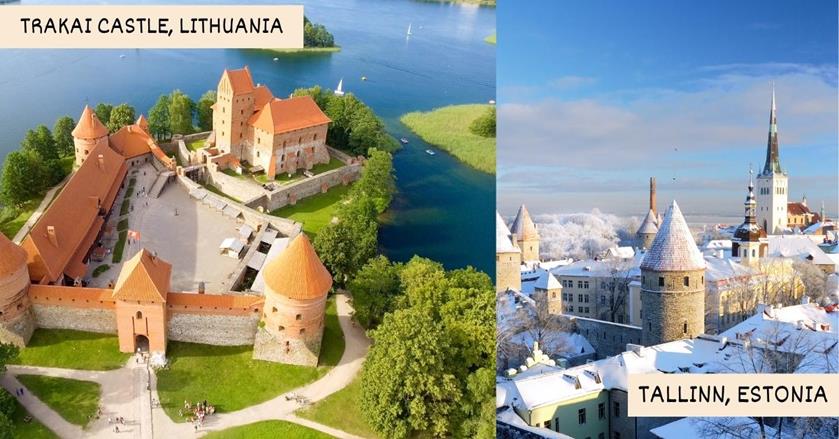
Lithuania for 5 days
Lithuania is rich in cultural preservation, so much so that UNESCO considered their folk dance as one of the intangible cultural heritages. They also have one of the oldest languages, even older than Greek, German, and Celtic, and the oldest tree in Europe could be found here as well.
With five days in Lithuania, you can do and see a lot of things. You can cover at least two major cities; the capital city Vilnius, and the cultural art city of Kaunas. If it’s warm enough, head to the coast and visit Klaipeda.
Here is a list of the best places to see in Lithuania:
- Gediminas Castle Tower in Vilnius
- Vilnius Cathedral Square
- Hot Air Balloon Flight – over Vilnius or Trakai Castle
- Energetikos ir technikos muziejus in Vilnius
- Museum of Occupations and Freedom Fights and A.Mickiewicz Memorial Museum in Vilnius
- MO Muziejus in Vilnius
- Gates of Dawn in Vilnius
- Three Crosses Monument in Vilnius – join a full-day tour from Vilnius
- Walk around Uzupis
- Trakai Castle near Vilnius
- Kaunas Castle
- Devils’ Museum in Kaunas
- Hill of Crosses near Šiauliai
Latvia for 4 days
You can go to Latvia from Lithuania by driving, riding a bus, plane, or taking the train. The most recommended option is through riding a bus as it is the cheapest and fastest. Latvia is also a great destination during summer. You can take a swim on its sandy beaches, lakes, and rivers.
You can either spend the entire 4 days in Riga, the capital city or take day trips to see Gauja National Park and Turaida Museum Reserve for example. You can also explore Riga on a segway tour .
Here are some of the top tourist attractions in Latvia :
- House of the Black Heads in Riga – get your ticket in advance
- Riga Cathedral
- Three Brothers, Latvian Museum of Architecture
- St. Peter’s Church
- The Freedom Monument in Riga
- Shop souvenirs at Riga Central Market – join a food-tasting tour
- Gauja National Park outside of Riga
- Rundale Palace and Museum ner Jelgava
Estonia for 4 days
To reach Estonia if you’re coming from Latvia, you could board a plane, ride a bus, take the train, or drive. The most recommended option would be to ride a plane as it’s the fastest, but the cheapest option would be to take the bus.
Estonia is very unique, they have islands but are inhabited – and that makes it interesting to visit. There, you can go fishing, sailing, canoeing, kayaking, and for those who love birds, birdwatching is a popular thing to do in Estonia.
Tallinn, the capital, is obviously the most popular destination. However, with 2 weeks in Europe, around the Baltics, you can also head to Parnu and Tartu – both are located in the south of Estonia. Go to Haeska, Kabili, and Matsalu for birdwatching and wildlife experiences.
Here are some of the sights to see in Estonia :
- Tallinn’s Old Town
- Lennusadam Seaplane Harbor in Tallinn
- Lahemaa National Parl – sign up to a day trip
- Patarei Prison Exhibition/Communism Prison in Tallinn
- Parnu’s Beaches
- Alpakafarm near Parnu
- Estonian National Museum in Tartu
- Tagurpidi Maja (Peapeal OÜ) / Upside Down House in Tartu
- TYPA Letterpress and Paper Art Centre in Tartu
- Kuressaare Castle in Saare
- Join a 3-hour food tour
Travelling around the Baltics is one of my favourite destinations and one I recommend if you’re on a budget. You will still experience the European culture, walk through the alleys and paves with cobbled stone, and eat delicious meals.
It’s honestly possible to travel here for around $1,000 for those on a budget . You will stay in a hostel and consume street food or grocery store meals. The tours also don’t cost that much. Accommodation is around $25 to $35 a night, but transportation is cheap.
$2,000 is the average cost where you get to have a private room and try out a few local restaurants. For a luxury trip, $3,000 will get you very comfortable.
Itinerary #4 East Europe: Hungary and Croatia or Romania and Bulgaria
East Europe is a massive region. You will have to choose 2-3 countries to cover during your visit and perhaps next time, you go to new places. Right now, we’ll only cover 4 destinations for your 12-day in Europe itinerary; Hungary and Croatia or Romania and Bulgaria.
Croatia has so much to offer, but in the last few years, being the filming location of Game of Thrones, this country attracted more tourists. Aside from that, they also have stunning waterfalls and gorgeous Adriatic Islands, among other landscapes.
Hungary on the other hand is famous for its ruin bars, paprikas, and goulash. It also has sought-after outdoor and public thermal bars and great nightlife. Outside the city, Hungary has a lot of nature preserves and can be an affordable ski destination in winter.
Bulgaria is the oldest country in Europe and has tons of hot springs. It’s undeniable how affordable Bulgaria is as a travel destination. It also sits right on the Black Sea, a popular spot during summer.
Nightlife in Bulgaria is another reason tourists come here for its affordability. Speaking of cuisine, the traditional Bulgarian food is something of a must-try.
Romania is famous for its Carpathian Mountains, Salt Mines, and Medieval Fortresses. Just like Bulgaria, it’s also located on the Black Sea. One might want to visit Romania since it’s famous for being the home of Dracula.
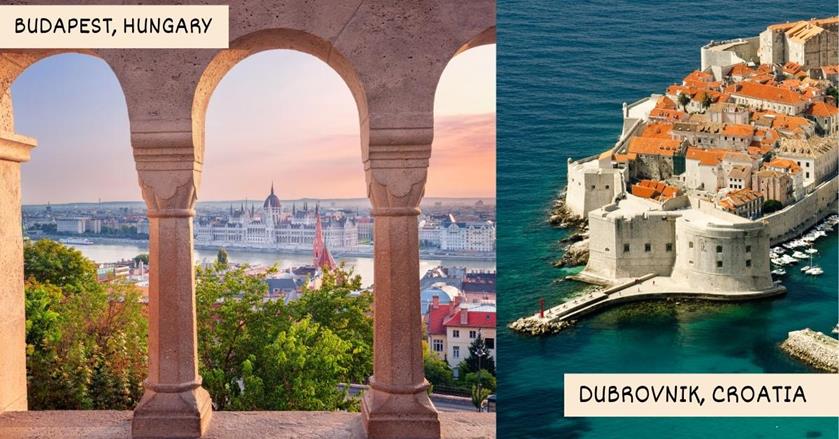
Hungary for 7 days
Hungary, like many other European countries, is a landlocked country. But it doesn’t mean you can’t enjoy summer in Hungary. This country has over 1,000 natural springs water, hence, the popularity of its thermal baths.
Budapest is not the only city worth visiting in Hungary, you should also consider Debrecen and Szeged. While Balaton Uplands National Park is the spot to you want to go hiking, join wine tours, and be around nature.
Here are some of the top tourist attractions in this country :
- Hungarian Parliament Building in Budapest
- Budapest’s Széchenyi Thermal Bath – book a full-day spa
- Buda Castle
- Buy souvenirs at Central Market Hall
- Take a boat cruise Danube River in Budapest – check cruise prices
- Matthias Church in Budapest
- Esztergom Basilica
- The Caves of Lillafured near Miskolc
- Lavender field at Tihany
Croatia for 7 days
It is relatively easy to travel to Croatia if you’re coming from Hungary as they are neighbouring countries. You could travel by bus, by train or by driving. Any option is fine, but the cheapest option would be to ride the night bus.
As mentioned before, Croatia is now popular for being the filming location for Game of Thrones, but there are other places to see in this magnificent country. Just like its neighbouring country of Italy, Croatia is also a fantastic beach destination and so much more affordable.
Zagreb is the capital of Croatia and a must-visit, then you can go to the coast. The most popular city is Split and Dubrovnik, but Zadar, Hvar, and Pula are an equally stunning area for swimming and other water activities.
Want to spend 14 days in Croatia ? Our guide has three itineraries you can check out and see which one suits you best.
Some of the top tourist attractions in this country include :
- Dubrovnik’s Old Town Walls – join a walking tour
- Trsteno Arboretum, Trsteno near Dubrovnik
- Dubrovnik’s Lovrijenac Fort
- Visit Game of Thrones filming locations – book a tour
- Nikola Tesla Technical Museum in Zagreb
- Diocletian’s Palace in Split – enjoy a walking tour with a local guide
- Blue Cave, near Split – book the 5 island boat tour
- Krka Waterfalls, near Split – visit on a boat tour
- Plitvice Lakes National Park near Zadar
- Kornati National Park near Zadar
- Euphrasian Basilica in Porec
- Pula’s Roman Arena
- Swim at Galebove Stijene in Pula
- Explore Brijuni/Brioni National Park near Pula
- Mulini Beach in Rovinj
Romania for 7 days
A massive country in East Europe, Romania has a lot to offer. From national parks, vibrant cities, historical sites, and beach access to the Black Sea. Bucharest is known for great nightlife, but apart from that, it’s also rich in cultural and historical spots.
Other than Bucharest, you have to go to the Transylvanian region, known as the home of Dracula. If it’s warm enough, head to Constanza, while Brasov and Cluj-Napoca are the areas to go to during winter for skiing and other winter activities.
Here are some of the places you could visit once you reached Romania:
- Romanian Athenaeum in Bucharest
- Grigore Antipa National Museum of Natural History in Bucharest
- National Museum of Romanian History in Bucharest
- Dimitrie Gusti National Village Museum in Bucharest
- Vaser Valley Forestry Railway
- Bran Castle aka Dracula’s Castle in Transylvania – book a tour combo with Peles and Brasov trip
- Sighisoara Historic Center
- Covered Stairway in Sighisoara
- The Clock Tower in Sighisoara
- The Black Church in Brasov
- Peles Castle near Brasov – book a 2-day tour from Bucharest to visit Brasov, Sibiu, and Sighisoara
- Bucegi Natural Park near Brasoc
- Transylvanian Alps
Bulgaria for 7 days
Just south of Romania, you can reach Bulgaria by train, bus, or driving. The quickest option would be to drive, which would take you more or less five hours, but the cheapest option is by riding a train.
Another country with the best nightlife, Bulgaria is popular with young tourists. But it doesn’t mean non-partygoers cannot enjoy Bulgaria. This country is a great place to explore the outdoors. There are many hiking trails and to ski here, you don’t have to spend too much.
Head to the capital city, Sofia, but for winter sports, you can go to Bansko, Borovets, and Pamporovo. If you are coming during the warm months, you can still go to the Black Sea by heading toward Varna.
Some of the top spots in Bulgaria are:
- National Palace of Culture in Sofia
- Sofia History Museum
- Rila Monastery – visit with combo tour to Boyana Church
- Seven Rila Lakes – check tour price from Sofia
- Tsarevets Fortress in Veliko Tarnovo
- Belogradchik Rocks
- Prohodna Cave in Karlukovo
- Krushuna Waterfalls
- The Rose Valley near Kazanluk
- The Ancient Theatre of Philippopolis in Plovdiv – join a tour of Plovdiv, Asen’s Fortress, and Bachkovo Monastery
- Pirin National Park near Plovdiv
- Thracian Tomb of Sveshtari near Shumen
East Europe is one of the most affordable regions in Europe. The accommodation alone can range between $20-$30 while food and the use of public transportation are also very affordable.
It’s easy to travel on a budget in eastern Europe, around $800 is feasible for backpackers and young travellers. If you want to be comfortable, $1,000 will be great and get you your own private room and dine at restaurants. $2,000 can easily be a luxury trip in this region for a 2-week adventure.
Itinerary #5 Nordic: Iceland, Norway, and Denmark
The next option would be the Nordic countries, which consist of Norway, Iceland, Sweden, Finland, and Denmark. However, in this itinerary, we will only cover Norway, Iceland, and Denmark.
Norway is also known as the Land of the Midnight Sun. It is famous for its fjords, lakes, and magical skies (Aurora Borealis), as well as Viking culture and folklore.
Iceland is also famous for a lot of natural wonders such as geysers, active volcanoes, and glaciers. You could also see the Northern Lights here. Iceland is relying 100% on renewable energy; hydropower, and geothermal.
Last but definitely not least is Denmark, which is well-known for its coastal towns, architecture, Royalty, and cuisine. Copenhagen is a must-visit. If you find yourself with extra time, you can hop on a train and head to Sweden.
You can also just visit Denmark, Norway, and Sweden using our 2 weeks in Scandinavia itinerary .

Iceland for 4 days
Iceland is the land of fire and ice, and you might be wondering why. They have glaciers but have volcanically heated pools at the same time, where you could swim all year round. That’s pretty fascinating.
Aside from that, it is also a literary-focused country. In fact, one out of ten Icelanders will publish a book even at least once in their lifetime.
Iceland is not a big country, but spending four days here is plenty. Most tourists love staying in Reykjavik, but you don’t have to. If you want to save money, you can stay outside the city and rent a car instead. You can easily move around in your own car, which means it doesn’t matter if your hotel is not in the city.
We have a complete guide and itinerary for 2 weeks in Iceland .
Top attractions in Iceland:
- Drive the Golden Circle
- Blue Lagoon – get your ticket in advance including Kerid Volcanic Crater
- Gullfoss Falls
- Seljalandsfoss
- Silfra – snorkel between 2 tectonic plates between North American and Europe
- Þingvellir National Park
- Jökulsárlón
- Chase the Northern Lights – join a tour to find the best spot
- Icelandic Phallological Museum
- National Museum of Iceland
- Reykjanesfólkvangur
- Whale Watching near Reykjavik – book a cruise
- Eystri-Fellsfjara / Diamond Beach
Norway for 6 days
You will need to ride a plane to reach Norway if you’re coming from Iceland. The fastest route takes more or less 6 hours. However, the journey would be worth it because there are so many sights and sceneries once you reach Norway.
This includes the world’s longest road tunnel and the world’s most remote island, among others. This is also an amazing place to ski during winter.
Many tourists usually go to Oslo and Bergen, but you can also add Stavanger, Kristiansand, and Tromso to your itinerary of 2 weeks in Europe.
If you want to see Fjords, you have to head west; from Trondheim all the way down to Stavanger. Check our 2 weeks in Norway itinerary list if you only want to see this country.
Here is a list of some of the best places to visit in Norway:
- Bygdoy Peninsula in Oslo
- Vigeland Sculpture Park in Oslo
- Viking Ship Museum in Oslo
- Naeroyfjorden
- Akershus Fortress in Oslo
- Oslo’s Fjords – check tour prices or a cruise to Nærøyfjorden, Flåm, and Stegastein
- Hanseviertel Bryggen in Bergen
- Sognefjord near Bergen
- Osterrjod and Mostraumen near Bergen – join a cruise
- Pulpit Rock (Preikestolen), in Stavanger
- Lofoten Islands
- Geirangerfjord
- Arctic Museum in Tromso
- Find the Northern Lights from Tromso – book a guided tour
- Atlantic Ocean Road
Denmark for 4 days
To reach Denmark from Norway, the best would be to take a plane. There is also a car ferry service, but with a limited time, it’s not ideal. Denmark has the oldest Monarchy in Europe.
Denmark is a small country but popular not only in Europe but around the world. For many years, it has been voted the happiest country in the world. It’s also known for being safe for tourists, the home birth of lego, and has the oldest monarchy in Europe and the oldest flag in the world.
Naturally, visitors will go to Copenhagen, but since the country (excluding Greenland and the Faroe Islands) is not that big, 4 days in Denmark is plenty
You can explore the entirety of Copenhagen and even have time to go to Odense, where the famous children’s book author Hans Christian Andersen was born. You can actually get to the city centre from Copenhagen airport in just 13 minutes – a great way to save time.
Here is a list of some of the best attractions in Denmark:
- The Little Mermaid (Den Lille Havfrue) – explore Copenhagen in a day
- Freetown Christiania
- The King’s Garden
- Amalienborg
- Rosenborg Castle
- Tivoli Gardens – get your ticket in advance
- Botanical Garden
- The Round Tower
- Memorial Anchor
- Copenhagen Opera House
- Walk around Strøget
- Ny Carlsberg Glyptotek
- Christiansborg Palace
- Danish Architecture Centre
- Ofelia Plads
- Legoland in Billund
- Hans Christian Andersen’s Childhood Home
- H. C. Andersens House
Nordic and Scandinavia is undeniably the most expensive place to travel around Europe. Accommodation alone could run $100, and dining and consuming alcohol are costly as well. But taking the bus and train is a little bearable.
To ensure that you will enjoy your 2 weeks in Europe around this region, plan to spend about $2,000 . If you are on a budget, you can probably do it for $1,700 but no less. But for l uxury, your trip cost will really skyrocket up to $5,000 .
Itinerary #6 West Europe: The UK, Netherlands, and Belgium
The last itinerary option for your 2 weeks in Europe includes the countries the UK, Netherlands, and Belgium, also known as the west of Europe.
The UK is popular for many things, including its monarchy, culture, history, and performers. Being the home of four different countries; England, Scotland, Wales, and Northern Ireland, you can easily say that it’s worth a visit. From bustling cities, amazing hiking trails, pubs to check out, and castles to explore.
There are tons of iconic places in the Netherlands despite it being a small country. The Netherlands is famous for many things . Here, you’ll be able to see windmills, cheese markets, bulb fields, and earthenware, among others. The Netherlands also have plenty of historical spots to discover including Anne Frank’s House.
The last country on our list is Belgium. They have high-quality chocolates, hence the name Belgian chocolate. This country is also well-known for waffles and beer and is the home to NATO headquarters.

The UK for 6 days
There are many things to see in the UK, and six days is definitely not going to be enough. But don’t panic. If this is your first time here, list the attractions you really want to see first. The world-famous Big Ben, London Eye, and River Thames can all be found here, and that’s just in London.
If you have been here before, perhaps, you can now explore less popular areas. Perhaps, you can focus on hiking instead of being in the city or just spend 14 days in England only, especially if it’s your first time.
It’s undeniable that the UK has the most famous monarchy in the world. London alone has a lot of attractions related to the British Monarchy and historical places. In order to make the most out of your trip, the recommended duration of stay is at least five days.
ALSO READ: 2 weeks in the UK , 2 weeks in England , and 2 weeks in Ireland and Northern Ireland itineraries.
List of some best places to see in the UK :
- Tower Bridge
- Stonehenge – book a combo tour with Windsor Castle and Bath
- Buckingham Palace
- The British Museum
- Tower of London and Crown Jewels Exhibition – buy your ticket in advance
- Kensington Palace
- Madame Tussauds – get your skip-the-line ticket
- Shakespeare’s Globe
- St. Paul’s Cathedral
- Book a Harry Potter tour – Warner Bros. Studio
- Scotney Castle
- Bodiam Castle
- Warwick Castle
- Lake District National Park
- Dean Village
- Edinburgh Castle – book a skip-the-line tour
- Palace of Holyroodhouse
- Loch Ness, Glencoe, and the Scottish Highlands – check the tour price from Edinburgh
- Loch Lomond & The Trossachs National Park
- Titanic Belfast – join a guided tour
- Crumlin Road Gaol
- Giants Causeway – visit with a stop at Dark Hedges, Dunluce, and Belfast
- Free Derry Corner
- The Derry Walls
The Netherlands for 4 days
You could either ride the train or drive if you want to reach the Netherlands from the UK. Once you reach the Netherlands, you could experience the biggest ice skating tour in the world, or join a cycling tour. You can also know more about world-famous painters like Van Gogh and Rembrandt.
Four days sounds too little but you can actually do a lot while in the Netherlands. You can of course explore Amsterdam, and head to The Hague, Rotterdam, and Groningen.
Some things to see and do in The Netherlands:
- Jordaan and Amsterdam’s Canals – book the famous canal cruise
- Anne Frank House
- Rijksmuseum
- Mauritshuis
- Van Gogh Museum – enjoy with an audio guide
- The Windmills of Kinderdijk
- Hoge Veluwe National Park
- Valkenburg Castle Ruins
Belgium for 4 days
To reach Belgium, you could ride the train, ride a bus, use rideshare, or drive. The cheapest option would be to use rideshare and the most recommended option would be to ride the train. It would take you almost 3 hours to reach your destination.
The popular cities in Belgium are Brussels which is the capital, Ghent, Antwerp, and Bruges. You can take buses, trains, or rent a car to travel between cities. Don’t forget to go try different beers and waffles which are two of my favourite part of my visit.
Popular attractions in Belgium:
- Grand Palace
- Atomium – get your entry ticket in advance
- Sign up for the famous Hungry Mary’s beer and chocolate tour or join chocolate making class
- Manneken Pis
- Day trip to Bruges and Ghent – enjoy with a tour guide
- The Canals of Bruges
- Battlefield in Flanders
- Belfry of Bruges
- Basilica of the Holy Blood
- Bruges Beer Experience
- Sint-Salvatorskathedraal
- Gravensteen
- Museum Aan de Stroom
- The Rubens House
What I enjoy about travelling in western Europe is how it’s honestly a pricey place but it can be done on a budget. If you think you can stay on your feet for long hours and walking around is not a problem, you can easily cut costs by taking the bus or taxi. The accommodation will surely get you, but dining can be affordable.
The street food in all these countries is fun, globally diverse, and easy to find. For budget travellers, $1,700 is required for your 2-week trip and most likely requires you to stay in a youth hostel. $ 2,500 offers comfort and a bit of luxury where you can dine at nice restaurants. $4,000 means you can stay in hotels right downtown and near the top attractions, With this budget, you can even hire taxis during your entire trip.
SUMMARY OF 2 WEEKS IN EUROPE
There are so many countries to choose from if you plan to visit Europe. Fortunately, Europe has amazing transportation between cities and countries, making it easy to travel around even with limited time.
When planning your 14-day itinerary for Europe, don’t try to cram it too much. It’s better to travel a bit slower, see fewer places, but be able to enjoy and process everything you have seen and experienced. Europe is not going anywhere, you can always visit again and check out a new place.
I hope that you found these 2 weeks in Europe itineraries helpful in planning your own.
TO SAVE THIS ITINERARY, PIN THIS IMAGE BELOW:


Traveling Without a Passport

30 Days in Europe: Travel Tips & Itinerary Ideas
Discover Europe in 30 days with our tips and itinerary ideas for a diverse and enriching adventure
A budget-friendly journey blending adventure and culture awaits
Welcome, willkommen, bienvenue to Europe, one of the most diverse continents on the planet. Steeped in history, culture and tradition, Europe is famously abundant with art, antiquity, and ornate architecture –there’s good reason why the Grand Tour was a rite of passage for the 18th-century aristocracy– and a 30-day tour offers a chance to experience more than a brief snapshot of its character and beauty.
With 44 countries spanning nearly four million square miles (10m sq. km), Europe is a vast yet surprisingly connected continent. In a month, you can beach hop around the Mediterranean, trek through the Tatra Mountains, and see Amsterdam through Rembrandt’s lens with ease.

Spending 30 days in Europe costs less than you think. While it’s relatively cheap and straightforward to fly between major cities, exploring by road or rail is the most popular – and best – way to see Europe. Whether you want to scale the lofty Eiffel Tower in Paris, explore Rome’s ancient Colosseum, or see the gargantuan dome of the Hagia Sofia in Istanbul, a well-thought-out itinerary can be accessible to all budgets.
One of the most logical, convenient, and time-savvy ways to see Europe is on an organized adventure, where all the planning, logistics, and hard work is done for you. Whether you’re on a backpackers’ budget or want a once-in-a-lifetime holiday, here’s how to get the best out of Europe in just 30 days .
Top tips for planning your itinerary
1. don’t try to see everything.
Rome wasn’t built in a day. And Europe can’t be seen in a month, but you can scratch more than the surface on a 30-day traveling budget. Whether you want to tick off the top sights or spend your time more leisurely and get to know the vibe of a city, research, and planning is always the key to a successful trip.
Feeling free and easy? Why not leave the itinerary to the professionals and book an organized adventure? With many trips starting in London, the adventures begin as soon as they hit the rails or road, traveling through key cities across Europe, including Barcelona, Amsterdam, Paris, Berlin, and Budapest.

2. Schedule in plenty of downtime
So many cities, so little time can be the death knell of fun when you’re traveling. While it’s tempting to pack your 30 days in Europe to the brim, it’s important to remember it’s a holiday, not a challenge. Let go of the FOMO and factor in some downtime on the beach or in the mountains to rest and recharge.

3. Pick your top destinations
Whether you want to island hop around Greece, bathe in Iceland’s Blue Lagoon or embark on a Game of Thrones pilgrimage to Dubrovnik, take time to choose what you really want to get out of your 30 days in Europe. Have a wish list as a baseline and work your itinerary and budget around it.
There are dozens of 30-day organized adventures available across Europe, many of which combine the big-hitting city stops like Amsterdam, Paris and Berlin, along with lesser-known destinations like Kotor, Tirana and Delphi.
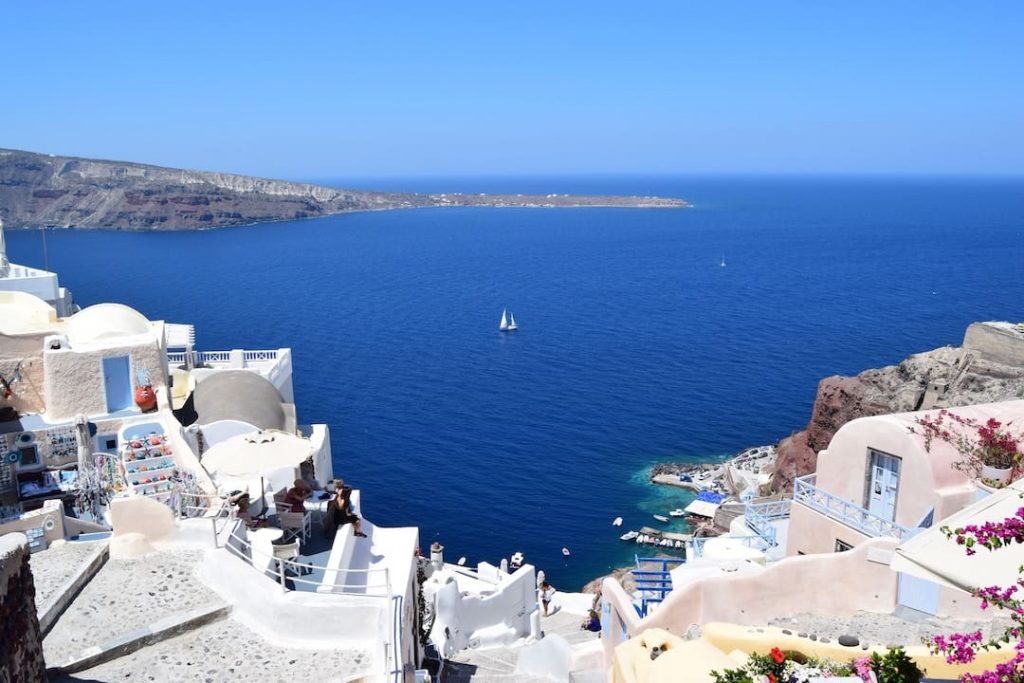
How to get around Europe
Although vast, Europe is an accessible continent and you can cover plenty of distance in 30 days. Depending on your budget and what you want to achieve, flying is usually the quickest way to hop between major cities; however, you do lose much of the charm you get from seeing Europe from ground level.
Traveling by train is one of the best ways to explore the continent. Europe has an extensive cross-border rail network which is reliable, efficient, and reasonably priced. Eurail offers interrailing passes that fit a 30-day budget and allow more freedom to explore on your own timetable.

If keeping costs down is a major factor, low-cost coach and bus services such as FlixBus and Infobus can be good options, having routes to more than 1200 destinations in 24 countries.
Alternatively, booking an organized adventure will really make the most of your 30 days on the continent. There are dozens of brilliant itineraries covering all interests and budgets –almost always including travel, accommodation, and the services of a tour leader– it’s a great way to travel around Europe with like-minded people.
See Also: The Seven Most Scenic Train Rides in Europe
30 days in Europe: Where to go and what to do
With 30 days to play with, Europe really can be your oyster. Amsterdam to Antwerp, London to Ljubljana, Zurich to Zagreb, you can easily check out 10 countries or more on a 30-day budget. Classic Europe itineraries include Paris, Amsterdam, Barcelona, while the more unique itineraries include destinations like Pamplona, Liechtenstein, and the Rhineland. Focus on one or two regions and get stuck into seeing the best of it on a 30-day European holiday.

See Also: 50 Fabulous and Free Things to Do in Europe
Western Europe
From Anne Frank Huis in Amsterdam to the Zurich opera, most classic pan-European tours focus on the big hitters – Paris, Berlin, Rome, Venice, Barcelona – where there’s enough culture and history to fill 300 days, let alone 30.

Some organized adventures will take a deeper dive into western Europe, starting in London and winding through 18 or 19 destinations, including Biarritz and Madrid, the French Riviera and Monaco, Florence, Venice, and Rome, while others will include a river cruise through the Rhineland, a tour of Cologne and the last few days enjoying Amsterdam.
Southern Europe
Sweeping across from Spain to Serbia, the southern Europe region incorporates Portugal, Italy, Greece, Turkey, Croatia, Albania, Slovenia and more. From the temples of ancient Greece, the ruins of Rome to the beaches of Spain, Cyprus, and Albania, southern Europe is great for combining culture and kick-back time.

For something a little different from the classic European Grand Tour, book an organized adventure that takes in the most fascinating destinations along the Mediterranean and Dardania route. Several 30-day itineraries have options that start in Tirana, Albania, and wind across the length of southern Europe, including overnights in Naples and Pompeii, Durmitor National Park in Montenegro, Sarajevo, Belgrade and Budapest.
Central and Eastern Europe
From the emerald-hued Plitviče Lakes in Croatia and the bohemian nightlife of Sofia, to the Gothic architecture and beer taverns of Prague, there are a million and one reasons to include central and eastern regions on your 30-day European trip, not least because these affordable cities will make a tight budget stretch even further.

Whether you start in Vienna or Vilnius, there are a number of organized adventures that explore central and Eastern Europe’s most captivating cities, including Bucharest, Sofia, and Plovdiv. Alternatively, choose an itinerary that ventures into the rugged landscape of the High Tatra Mountains between Poland and Slovakia.
Northern Europe
With its design-centric cities, glacial fjords and stark arctic wilderness, Northern Europe can feel like an entirely different planet, compared to the rest of the continent. From the geothermal waters of Iceland’s Blue Lagoon, and the pop culture museums of Stockholm to the fjords of Norway, there are plenty of reasons to head north on your adventure.

From Copenhagen and Oslo to Stockholm, you can have some incredible Nordic adventures on these 30-day itineraries across northern Europe. Several include overnight cruises from Stockholm to Helsinki or crossing over the Arctic Circle to Rovaniemi in Finnish Lapland.
For more inspiration — or to book a hassle-free holiday and travel with a group of like-minded people — check out our full range of 30-day Europe tours.
See Also: The Best Places to Travel Alone in Europe

Tracey Davies
Tracey Davies is a Brighton-based travel writer, journalist and editor of 101 Singles Holidays, as well as a former co-host of “The Carry On” travel podcast.
Related Articles
- Tips & Tricks
- United Kingdom
Visit These Gloomy Destinations for a Great Time
Enough about sun-drenched beaches and clear blue skies. It’s time you...
- Destinations
Top Countries You Haven’t Been (Yet!)
Ever felt like you're being fed the same destination over and...
- Central America
Is Costa Rica Safe to Visit Right Now?
Costa Rica, known for its stunning beaches, lush rainforests, and abundant...

Scotland Is Calling: 3 Reasons Why You Need to Visit
Get unlimited access to the world's best travel stories. subscribe now., privacy overview.
10 Days in Europe: 21 Amazing Itineraries
Disclaimer: This article includes affiliate links to the products we earnestly love and recommend, meaning at no extra cost to you, we might make a teeny-weeny commission if you click on the link and decide to buy something. The money will be used to sustain this little cozy blog we call our virtual home.
Are you planning a 10 day Europe trip and are confused about where to go and how to craft a perfect Europe itinerary? Here are 20 best Europe itinerary ideas for spending 10 days in Europe based on the recommendations of travel experts.
Whether you are looking for a multi-country itinerary or you want to explore just one European country at a time, you are sure to find an itinerary for Europe that suits your travel style, budget, and season.
Learn More: How to Plan a Trip to Europe
Europe in 10 Days: Best Europe Itineraries
1. london + paris + rome: the classic first timer’s route.
Itinerary Route: London – Paris – Rome Days spent in each city: 4 days in London, 3 days in Paris, and 3 days in Rome

This itinerary combines the charm and beauty of the most loved cities in the world – London, Paris, and Rome. Packed with iconic sights and bucket-list experiences , this is probably the best 10 day Europe itinerary for most first-time visitors to Europe as it makes for a great introduction to Europe.
Itinerary Overview:
Day 1: London ⦿ Arrive in London ⦿ Buy London Oyster Card ⦿ Stroll the charming streets of Notting Hill Day 2: London ⦿ Join a guided London sightseeing walking tour that includes all of London’s famous landmarks ⦿ Boat cruise on the River Thames ⦿ Afternoon tea at Harrods Tea Rooms Day 3: London ⦿ Harry Potter Studio Tour Day 4: London ⦿ Day Trip to Cotswolds Day 5: Paris ⦿ Take a Eurostar to Paris ⦿ Buy Mobilis Pass ⦿ Visit the iconic Eiffel Tower ⦿ Enjoy the Seine River cruise Day 6: Paris ⦿ Join a Walking + Metro tour that includes all the Paris’s famous landmarks ⦿ Take a baking & patisserie class at the Parisian Boulangerie Day 7: Paris ⦿ Day trip to historic Mont Saint Michel Day 8: Rome ⦿ Catch a flight to Rome ⦿ Stroll through the cobbled piazzas of Rome ⦿ People watch at Piazza Navona ⦿ Throw a coin into the Trevi Fountain ⦿ Enjoy the sunset view from Terrazza del Pincio ⦿ Taste the Italian gelato from one of the many gelaterias Day 9: Rome ⦿ Guided Colosseum, Roman Forum, and Palatine Hill walking tour ⦿ Guided Sistine Chapel, Vatican Museums, and St. Peter’s Basilica tour Day 10: Rome ⦿ Fly Back Home
Best time of the year to follow this itinerary: London, Paris, and Rome are incredibly popular destinations and thus, remain crowded all through the year. The best months to follow this itinerary are April, May, September, and October because the crowds are bearable and the weather is mild.
What’s special about this itinerary: What are the essential ingredients to prepare a perfect recipe for an unforgettable Europe trip? Paris, London, and Rome! This itinerary lets you explore the most beautiful cities, the most iconic sights, and the best food cities in the world.
Where to stay: The Resident Covent Garden in London, Le Bristol Paris in Paris, and Hassler Roma in Rome
2. Prague + Vienna + Bratislava + Budapest: The Charm of Central Europe
Itinerary Route: Prague – Vienna – Bratislava – Budapest Days spent in each city: 2 days in Prague, 3 days in Vienna , 1 day in Bratislava, and 4 days in Budapest
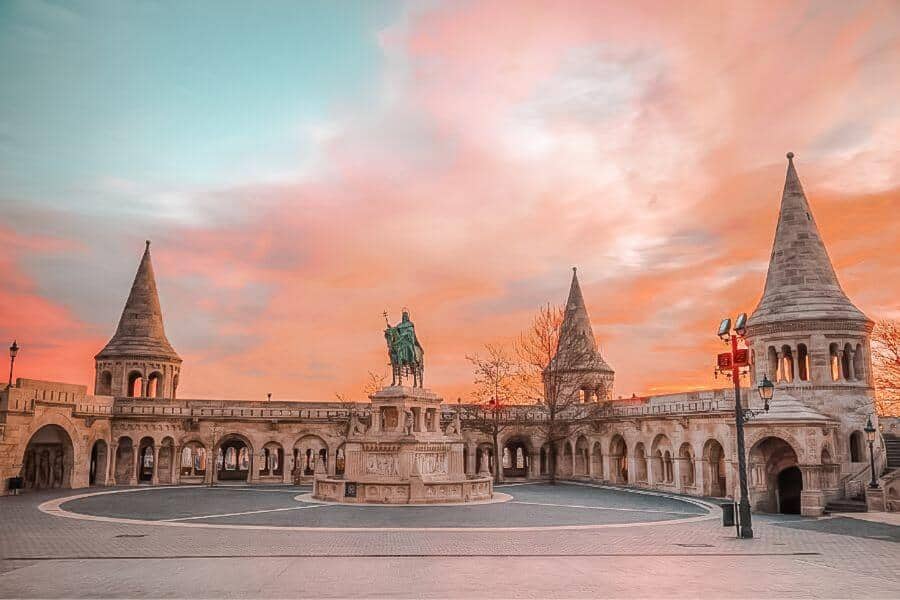
This Central Europe itinerary includes Europe’s 3 epic cities – Prague, Vienna , and Budapest along with 1 lesser-known yet awesome city – Bratislava . All the cities are brimming with cultural, historical, and architectural attractions.
Day 1: Prague ⦿ Arrive in Prague ⦿ Day at Leisure Day 2: Prague ⦿ Join a Guided Walking Tour of Prague that includes all the best attractions, a 1-hour boat cruise on the Vltava River, and a traditional Czech lunch. Day 3: Vienna ⦿ Drive to Vienna ⦿ Explore Brno on the way Day 4: Vienna ⦿ Join a Guided Walking tour of Vienna City Center ⦿ Explore Schönbrunn Palace ⦿ Enjoy the panoramic views of Vienna from Prater Giant Ferris Wheel Day 5: Vienna ⦿ Take one of the best day trips from Vienna to Wachau Valley Day 6: Bratislava ⦿ Drive to Bratislava ⦿ Take a walking tour of Bratislava that includes a visit to Bratislava Castle ⦿ Marvel at the gorgeous Blue Church Day 7: Budapest ⦿ Drive to Budapest ⦿ Explore the attractions of Buda ⦿ Relax at Széchenyi Thermal Bath Day 8: Budapest ⦿ Explore the attractions of Pest Day 9: Budapest ⦿ Day trip to Lake Balaton Day 10: Fly back home
Best time of the year to follow this itinerary: The spring (March, April, and May) and fall (September, October, and November) are the best seasons to follow this itinerary. It’s when the weather is pleasant and the tourist crowd is low.
What’s special about this itinerary: This itinerary is a perfect medley of some of the most elegant cities of Europe that are rich in history, culture, and beauty.
Where to stay: The Julius Prague in Prague, Rosewood Vienna in Vienna, and The Ritz-Carlton in Budapest
Suggested Read Where to Stay in Vienna Best Places to Visit in Hungary 7 Days in Hungary Itinerary
3. Copenhagen + Oslo + Stockholm: Scandinavian Capitals
Itinerary Route: Copenhagen – Olso – Stockholm Days spent in each city: 4 days in Copenhagen, 3 days in Oslo, and 3 days in Stockholm
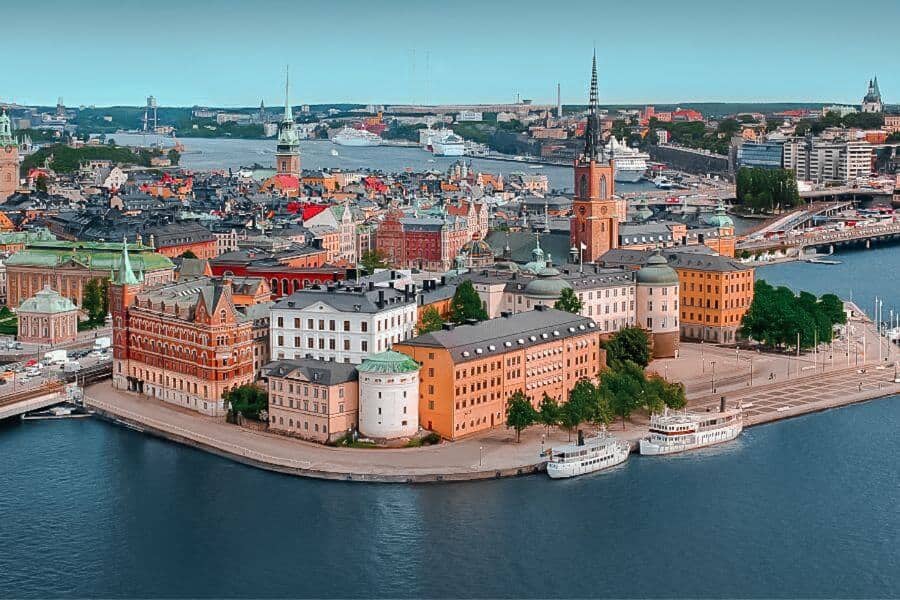
Scandinavia is different from the rest of Europe. It has a distinct charisma. This itinerary lets you
Day 1: Copenhagen ⦿ Arrive in Copenhagen ⦿ Day at Leisure Day 2: Copenhagen ⦿ Stroll Nyhavn ⦿ Enjoy a Canal Tour ⦿ Admire the Gorgeous Marble Church ⦿ Attend a Changing of the Royal Guard Ceremony at Amalienborg Palace ⦿ Lunch at Torvehallerne ⦿ Shop at Stroget Day 3: Copenhagen ⦿ Explore Frederiksberg Palace and Gardens ⦿ Check out Assistens Cemetery ⦿ Relax at Superkilen Park ⦿ Visit Experimentarium Day 4: Copenhagen ⦿ Take a day trip from Copenhagen to Dragor ⦿ Tivoli Gardens Day 5: Oslo ⦿ Fly to Oslo ⦿ Visit Munch Museum Day 6: Olso ⦿ Explore Royal Palace ⦿ Spend some time appreciating the Oslo Opera House ⦿ Visit Akershus Fortress ⦿ Check out Nobel Peace Center Day 7: Oslo ⦿ Admire the unique sculptures at Vigeland Sculpture Park ⦿ Check out one of many amazing museums like Viking Ship Museum, Fram Museum, Kon-Tiki Museum, or Norwegian Museum of Cultural History Day 8: Stockholm ⦿ Fly to Stockholm ⦿ Stroll the Old Town (Gamla Stan) ⦿ Stop by Stortorget, Stockholm Cathedral, Noble Prize Museum, and Royal Palace Day 9: Stockholm ⦿ Enjoy a canal cruise ⦿ Explore one of the museums on Museum Island (Djurgården) ⦿ Visit Drottningholm Palace Day 10: Stockholm ⦿ Experience Swedish Fika at Café Pascal ⦿ Fly back home
Best time of year to follow this itinerary: Scandinavia is magical all through the year. Summer brings the magic of neverending days while winter promises the coziness of hygge , mysa , and koselig .
What’s special about this itinerary: The vibrant capitals of Scandinavian are brimming with breathtaking urban spaces, magnificent royal palaces, state-of-the-art museums, quaint waterways, and rich ancient history, and culture. Not to mention, a trip to Scandinavian capitals offers a perfect introduction to Viking History.
Where to stay: Scandic Palace Hotel in Copenhagen, Karl Johan Hotel in Oslo, and Hotel Skeppsholmen in Stockholm.
Suggested Read Where to Stay in Copenhagen Where to Stay in Oslo
4. Prague + Munich + Vienna: A Christmas Market Route
Crafted by: Jenn from ThoseJohnsonBoys.com Itinerary Route: Prague – Munich – Vienna Days spent in each city: 3 days in Prague, 3 days in Munich, 3 days in Vienna (plus 1 travel day)
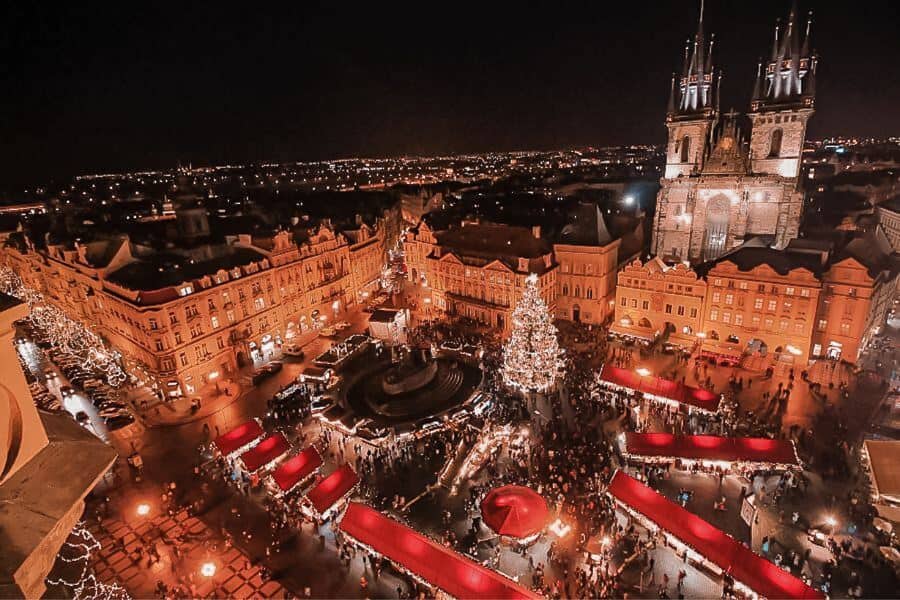
What better way to bring the magic of Christmas to life than a stroll through the European Christmas markets? On this route, you’ll find some of Europe’s best Christmas markets , while still being able to enjoy the famous sights in each of these cities. Want to extend your trip? You can easily add in a stop in Salzburg —If you do, check out this detailed itinerary .
Itinerary overview:
Day 1: Prague ⦿ Arrive in Prague ⦿ Check out the Náměstí Republiky Christmas Market Day 2: Prague ⦿ Take a photo by the Prague Astronomical Clock ⦿ Walk across Charles Bridge (tip: explore the city early in the morning, and you’ll be able to walk across the bridge with almost no other tourists!) ⦿ Visit Prague Castle ⦿ Go to the top of Old Town Tower at night for an amazing view of the Old Town Square Christmas Market Day 3: Prague ⦿ Take the funicular up to Petřín Lookout Tower ⦿ Eat a trdelník at Wenceslas Square Christmas Market Day 4: Munich ⦿ Take the train to Munich ⦿ Eat dinner at Münchner Stubnnear the hotel Day 5: Munich ⦿ Take a hop-on hop-off bus tour (don’t miss the Christmas market at the Residenz) Day 6: Munich ⦿ Explore the English Gardens ⦿ Go to the Christmas market at Marienplatz ⦿ Eat dinner at Hofbräuhaus Day 7: Vienna ⦿ Take the train to Vienna (go to the Wien Mitte Station if staying at the hotel listed below) ⦿ Visit St. Stephen’s Cathedral Day 8: Vienna ⦿ Walk through the Hofburg ⦿ Check out the Christmas market at Rathausplatz (tip: avoid the crowds by visiting during the day) Day 9: Vienna ⦿ Visit Schönbrunn Palace ⦿ Go to the Belvedere Palace at night to enjoy the Christmas market Day 10: Vienna ⦿ Fly home (you can take a train or fly back to Prague or fly out of Vienna)
Best time of year to follow this itinerary: The perfect time to follow this itinerary is early December through Christmas. For a special celebration, make sure to plan your trip around St. Nicholas Day on December 6 th .
What’s special about this itinerary: The Christmas spirit, of course! Follow this Europe trip itinerary 10 days for an unforgettable Christmas vacation.
Where to stay: Prague Marriott Hotel in Prague, Courtyard by Marriott Munich City Center in Munich, and Vienna Marriott Hotel in Vienna. Each of the hotels listed is within walking distance of the train stations in each city, so you can do this entire trip by train.
Read More: Best Winter Destinations in Europe
5. Amsterdam – Brussels – Paris: Canals, Museums, and Palaces
Crafted by: Kenny from Knycx Journeying Itinerary Route: Amsterdam – Brussels – Paris Days spent in each city: 3 days in Amsterdam, 1 day in Brussels, and 6 Days in Paris
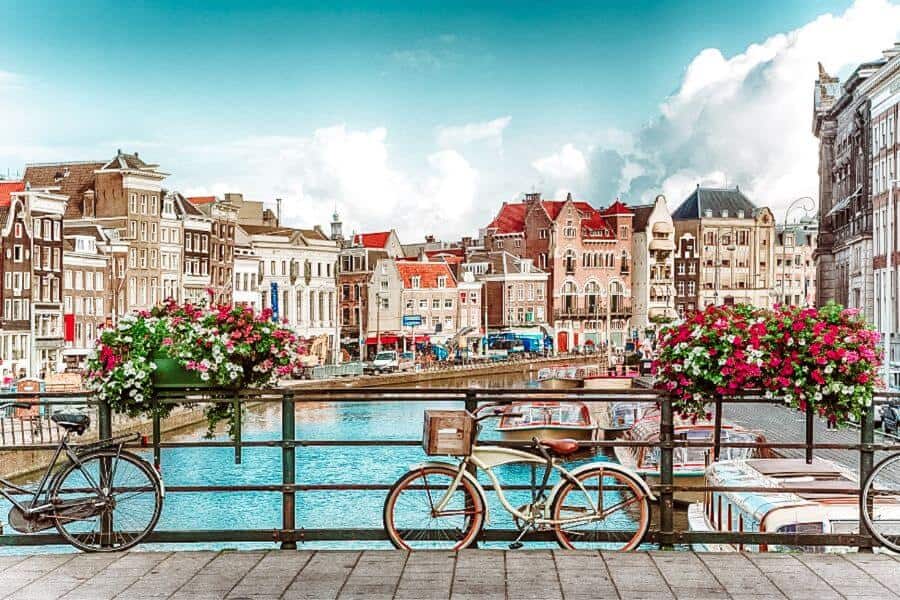
This is a classic Western Europe itinerary that covers three capital city of three distinct culture that has a deep impact on the world’s history, the three cities are conveniently connected by direct trains over a short distance, with no lack of world-class museums, landmarks, attractions, and amazing culinary experiences.
Itinerary Overview:
Day 1: Amsterdam ⦿ Arrive in Amsterdam ⦿ Explore Amsterdam’s city center ⦿ Hop on a classic canal cruise and sail past the city highlights and narrow housing along ⦿ Go cheese tasting at Reyepnaer or the Cheese Market ⦿ Explore Anne Frank House, Van Gogh Museum, or the Royal Palace ⦿ Head to Red light street for dinner and visit a Brown Café. Day 2: Amsterdam ⦿ Visit the Keukenhof garden ⦿ Take pictures with the Zaanse Schans Windmills ⦿ Rent a bike and ride along the beautiful flower fields Day 3: Amsterdam ⦿ Visit Rijksmuseum and check out “The Night Watch by Rembrandt” before taking a train to Brussels Day 4: Brussels ⦿ Take a city walking tour and explore the city highlights, from the Grand Palace, Mannekin Pis, and Grand Place, while hunting for all the iconic frescoes of cartoons on Brussel’s comic book route Day 5: Paris ⦿ Take a walk in Montmartre and visit the Basilica of Sacré Coeur ⦿ Have dinner on a Seine River Cruise Day 6: Paris ⦿ Day trip to Versailles Day 7: Paris ⦿ Chill on a lawn at Le Jardin du Luxembourg ⦿ Visit Musée d’Orsay ⦿ Enjoy coffee and crepe at Breizh ⦿ Have a walk on the Cite Island and check out the Notre-dame and Sainte Chapelle Day 8: Paris ⦿ Spend a day in Le Louvre and seek the three “must-see” exhibits in the museum: Mona Lisa Venus de Milo and Winged Victory of Samothrace ⦿ Admire Monet’s Nymphéas in Musée de l’Orangerie Visit Centre Pompidou in the late afternoon and have a drink at its rooftop bar at Le Georges Day 9: Paris ⦿ Climb to the summit of the Eiffel Tower and enjoy the panoramic view of Paris ⦿ Have a French Toast at Laduree ⦿ Visit the Arc de Triomphe ⦿ Stroll and Shop along Champs-Élysées Day 10: Paris ⦿ Fly Back Home
Best time of the year to follow this itinerary: The best time to follow this is during springtime from March to May because of its pleasant weather, especially for Keukenhof because it’s the tulip season.
What’s special about this itinerary: The three capital cities are distinctly different with a rich culture and history, the cities are filled with museums and landmarks and it ticks a lot of boxes for first-time travelers. There are great options in each city for you to fill in the gaps and replan your itinerary, making it as customized as possible for different needs. Furthermore, the transport connection is perfect and a lot of wonderful travel destinations are in between for extending the trip with outskirt visits and day trips, from Rotterdam, Bruges, Antwerp, Lille, Fontainebleau, to more. Not to mention the vibrant food scene from cheese, beer, chocolate, and waffles, to French fine dining.
Where to stay: Kimpton De Witt Amsterdam in Amsterdam, Pillows City Hotel Brussels Centre in Brussels, and Hôtel Crayon Rouge by Elegancia in Paris
6. Austria + Lichtenstein + Switzerland: Alpine Splendor
Crafted by: Paul D’Souza from Paulmarina Itinerary Route: Innsbruck – Lichenstein – Switzerland Days spent in each city: 2 days in Innsbruck, 1 day in Lichtenstein, 1 day in Grindelwald, 1 day in Wengen, 2 days in Lauterbrunnen, 1 day in Mürren, 1 day in Bern, and 1 day in Zurich
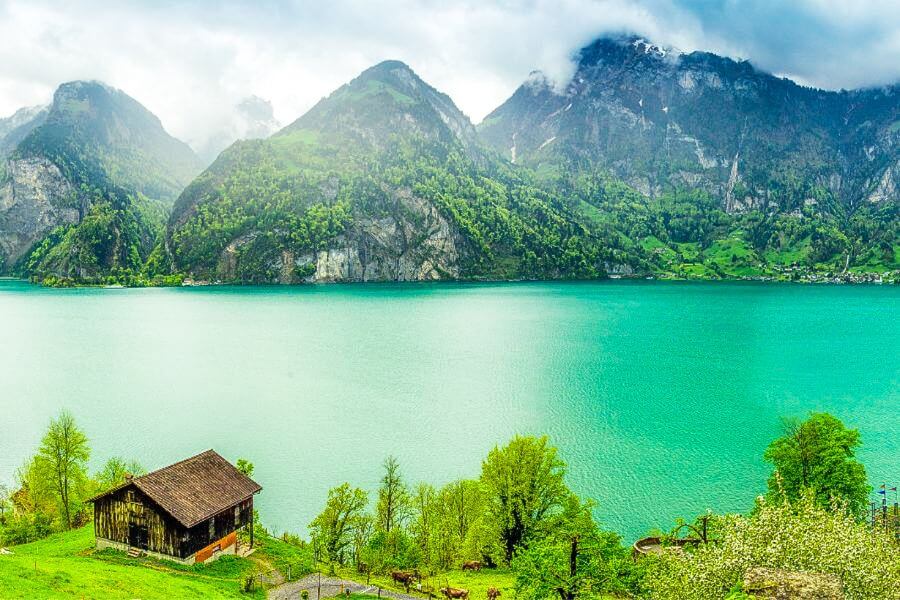
A road trip across the Austrian Alps, to Lichtenstein and Switzerland, should be on your bucket list if you love mountains, authentic alpine towns, and crispy fresh air. Explore some of the most beautiful corners in this region and get to know the local traditions on this cultural trip.
Day 1: Innsbruck ⦿ Arrive in Innsbruck ⦿ Visit the Tyrolean state museum and court church ⦿ Go for Lunch at the ski jump Bergisel Restaurant ⦿ Visit Ambras castle and gardens ⦿ Stroll around the medieval old town and discover the golden roof Day 2: Innsbruck ⦿ Visit Swarovski World in Wattens ⦿ Visit Rattenberg, the smallest medieval city in Austria ⦿ Visit the medieval town of Hall in Tirol ⦿ Dine at the Knight’s medieval experience restaurant, Ritterkuchl, in Hall Day 3: Lichtenstein ⦿ Travel to Lichtenstein ⦿ Visit the Lichtenstein art museum in Vaduz ⦿ Get a Lichtenstein stamp into your passport ⦿ Stroll around Vaduz and admire the street art Day 4: Grindelwald ⦿ Travel to Grindelwald in Switzerland ⦿ Take a stroll through the town ⦿ Have a cheese fondue with a view Day 5: Wengen ⦿ Take the cogwheel train and cable car to Jungfraujoch top of the world ⦿ Travel to Wengen over the Kleine Scheideg by cogwheel train ⦿ Enjoy the view and stay in Wengen Day 6: Lauterbrunnen ⦿ Do some shopping in Wengen ⦿ Take the cogwheel train down to Lauterbrunnen ⦿ Go up to the Lauterbrunnen waterfall Day 7: Mürren ⦿ Travel up to the Schilthorn Piz Gloria ⦿ Have breakfast in the turning restaurant at the peak ⦿ Do the thrill walk in Birg ⦿ Discover Mürren village and stay overnight Day 8: Lauterbrunnen ⦿ Take the cogwheel train the next morning to Lauterbrunnen ⦿ Visit the Trümmelbachfälle ⦿ Enjoy your last day in the mountains with a Swiss cheese platter Day 9: Bern ⦿ Travel to Bern ⦿ See the bear pit ⦿ Visit the art museum ⦿ Stroll around the old town and do some gift shopping Day 10: Zürich ⦿ Travel to Zürich ⦿ Fly Back home
Best time of the year to follow this itinerary: All through the year
What’s special about this itinerary: Discover the Austrian and Swiss alps and one of the smallest countries, Lichtenstein, in the world. Get a good mix of culture, nature, and travel experiences out of this road trip!
Where to stay: Altstadthotel Weißes Kreuz – In der Fußgängerzone in Innsbruck, Residence Hotel in Vaduz, Eiger Selfness Hotel in Grindelwald, Beausite Park Hotel in Wengen, Hotel Silberhorn in Lauterbrunnen, Hotel Eiger in Mürren, Hotel Savoy in Bern, and AMERON Zürich Bellerive au Lac in Zürich
Related Read: The Very Best Things to do in Austria
7. Slovenia + Croatia + Montenegro + Bosnia: Best of the Balkans
Crafted by: Cosette from KarsTravels Itinerary Route: Ljubljana – Zadar – Dubrovnik – Kotor – Mostar Days spent in each city: 2 days in Ljubljana, 2 days in Zadar, 2 days in Dubrovnik, 2 days in Kotor, and 2 days in Mostar

Get a good feeling for each country with these cities. Ljubljana with its baroque style, Zadar for its fabulous sunset celebration, and Dubrovnik for its walls. Kotor has the most beautiful bay and Mostar has the famous bridge.
Day 1: Ljubljana ⦿ Arrive in Ljubljana ⦿ Visit Tromostovje + Prešeren Square ⦿ Stroll over the Central Market Day 2: Ljubljana ⦿ Take the funicular ⦿ Visit Ljubljanski Grad ⦿ Hike down ⦿ Wander around Tivoli Park Day 3: Zadar ⦿ Drive to Zadar ⦿ Explore the Museum of Ancient Glass ⦿ Eat a Jumbo pizza at Crazy Pizza ⦿ Enjoy the sunset celebration Day 4: Zadar ⦿ Wander around the Old Town ⦿ Listen to the Sea Organ ⦿ Dance on the Greeting to the Sun Day 5: Dubrovnik ⦿ Drive to Dubrovnik ⦿ Have lunch on the Stradun ⦿ Sea kayak around Dubrovnik Day 6: Dubrovnik ⦿ Tour the walls ⦿ Take a Game of Thrones tour ⦿ Take the cable car and watch the sunset Day 7: Kotor ⦿ Drive to Kotor ⦿ Wander around the old town ⦿ Have dinner with a view at Restoran Vidikovac Day 8: Kotor ⦿ Hike the walls to the Castle of San Giovanni ⦿ Pay a visit to the cat museum Day 9: Mostar ⦿ Drive to Mostar ⦿ Walk over to Stari Most ⦿ Have tea in the old town Day 10: ⦿ Fly Back Home
Best time of year to follow this itinerary: Summer time, the weather is warm and everything is open to exploring.
What’s special about this itinerary: You’ll be exploring 5 incredible cities with lots of history. Each city has its own vibe and either a fort, walls, or bridge that stands out.
Where to stay: Tromostovje apartments in Ljubljana, Krišto Apartment in Zadar, Apartments Olaf in Dubrovnik, Apartments Wine House Old Town in Kotor, and Hotel Eden in Mostar
Suggested Read 7 Days in Slovenia Itinerary Best Places to Visit in Slovenia Best Places to Visit in Montenegro Best Things to do in Montenegro
8. Vilnius + Riga + Tallinn: The Charming Baltics
Crafted by: Leta from The Nerdy Me Itinerary Route: Vilnius – Riga – Tallinn Days spent in each city: 3 days in Vilnius, 3 days in Riga, and 3 days in Tallinn

The Baltic region is a real hidden gem of Europe yet to be discovered by the world. Here you can discover one of the best-preserved medieval cities in Europe, learn about the dark Soviet history, and spend some time outdoors exploring impressive national parks and sandy beaches.
Day 1: Vilnius ⦿ Arrive in Vilnius ⦿ Walk around the old town (don’t miss Literature or Stiklių streets) ⦿ Visit the Palace of the Grand Dukes of Lithuania ⦿ Hike to Gediminas’ Castle Day 2: Vilnius ⦿ Wander around the Užupis district ⦿ Have an afternoon cake break at Liu Patty ⦿ Walk up the Hill of Three Crosses ⦿ Check out the MO museum Day 3: Vilnius ⦿ Take a train to Trakai Castle as a day trip ⦿ Rent a water bicycle to sail around the castle ⦿ Visit the museum inside the castle ⦿ Taste kibinai at Senoji Kibininė Day 4: Riga ⦿ Take a bus to Riga ⦿ Explore the old town ⦿ Climb up the tower of St. Peter’s Church for a panoramic view Day 5: Riga ⦿ Day trip to Sigulda ⦿ Visit Sigulda Medieval Castle ⦿ Hike to Krimulda Castle using a cable car to cross the valley ⦿ Admire the Turaida Castle Day 6: Riga ⦿ Take a quick train to Jurmala and enjoy some beach time Day 7: Tallinn ⦿ Take a bus to Tallinn ⦿ Explore the Old Town ⦿ Visit city walls ⦿ Take beautiful photos from the Patkuli viewing platform Day 8: Tallinn ⦿ Explore the creative Kalamaja neighborhood ⦿ Visit the Telliskivi Creative City ⦿ Walk along the city’s harbor ⦿ Discover the Patarei Prison ⦿ Visit the Seaplane Harbour Museum ⦿ Explore the Linnahall ⦿ Grab a meal at Balti Jaama Turg Day 9: Tallinn ⦿ Tour to Lahemaa National Park Day 10: ⦿ Fly Back Home
The best time of the year to follow this itinerary : May, June, and September because the weather is amazing and the crowds are smaller than in the peak season.
What’s special about this itinerary: You’ll get to explore the lesser-visited part of Europe that is rich in history, culture, and delicious local cuisine. Also, if you are looking for a budget-friendly European trip option, the Baltics is considered one of the cheapest regions to visit.
Where to stay: Holiday Inn in Vilnius, Hotel Garden Palace in Rīga, and Kalev Spa Hotel & Waterpark in Tallinn
9. Central and Southern Italy: Italian Renaissance, Italian Appennino, and Italian Seaside Towns
Crafted by: Tori from Tori Pines Travels Route: Florence – Tuscany – Rome – Amalfi Coast Days spent in each city: 2 days in Florence, 2 days in Tuscany, 3 days in Rome, and 3 Days on the Amalfi Coast

Italy is a traveler’s dream. The country is filled to the brim with history, beautiful architecture, nature, delicious food, and unlimited wine. Central Italy is the best option for first-time visitors as it hits most of the most popular tourist destinations while also exploring the back alleyways of the quaint villages. Itinerary Overview :
Day 1: Florence ⦿ Arrive in Rome ⦿ Take the Train to Florence ⦿ Have Lunch at Mercato Centrale ⦿ Stroll the cobblestone streets and visit the free sights including the Porcellino, The David replica, and Piazza Della Repubblica ⦿ Take an Evening Food Tour Day 2: Florence ⦿ Take a Market Tour and Cooking Class ⦿ Climb the Duomo ⦿ Explore the Uffizi Gallery ⦿ Watch the Sunset at Piazzale Michelangelo ⦿ Dinner at Parione Day 3: Pisa + San Gimignano (Tuscany) ⦿ Rent a Car and Drive to Pisa ⦿ Visit the Leaning Tower of Pisa ⦿ Drive to San Gimignano ⦿ Lunch and Wine Tasting at Tenuta Torciano ⦿ Wander the Streets of San Gimignano ⦿ Eat World Famous Gelato at Dondoli Day 4: Siena and Saturnia (Tuscany) ⦿ Drive to Siena ⦿ Take a Walking Tour of Siena ⦿ Eat Lunch in Siena ⦿ Drive to Saturnia ⦿ Swim in the Hot Springs ⦿ Drive to Rome ⦿ Drop off Rental Car ⦿ Eat Dinner at Roscioli’s Salumeria con Cucina Day 5: Rome ⦿ Tour the Roman Colosseum and Roman Forum ⦿ Lunch at Pane e Salame ⦿ Take a Free Audio Tour of Ancient Rome to See Pantheon, Spanish Steps, Piazza Navona, and More ⦿ Aperitivo at The Court Bar ⦿ Dinner at Mimì e Cocò Day 6: Day Trip to Vatican City from Rome ⦿ Breakfast at the Vatican Tickets ⦿ Explore the Vatican Museum ⦿ Street Food Lunch in Trastevere, Casa Manco Pizza, and Trapizzino ⦿ Walk the Streets, Shop, and Eat Gelato ⦿ Dinner at Trattoria Da Enzo al 29 Day 7: Pompeii + Positano (Amalfi Coast) ⦿ Take the Train to Naples ⦿ Hire a Private Driver to Positano with a Stop at Pompeii ⦿ Take a Guided Tour of Pompeii ⦿ Arrive in Positano and Grab a Quick Lunch ⦿ Explore the Town, Sit on the Beach, and Shop ⦿ Aperitivo at Blu Bar ⦿ Dinner at La Tagliata Day 8: Bomerano (Amalfi Coast) ⦿Take the Bus to Bomerano ⦿ Hike the Path of the Gods ⦿ Eat a Picnic Lunch Along the Hike ⦿ Rest and Freshen-up Before Dinner ⦿ Dinner at Chez Black Day 9: Capri ⦿ Take a day trip to Capri ⦿ Wander the Island ⦿ Have Lunch at Da Paolino ⦿ Arrive Back at Positano ⦿ Aperitivo at Bar Franco ⦿ Dinner at Il Tridente Day 10: ⦿ Hire a Private Driver from Positano to Naples ⦿ Take the Train to Rome ⦿ Fly back home Best time of the year to follow this itinerary: Shoulder season is the best time in Italy. Visit April, May, September, or October for the best weather and smaller crowds. September is especially perfect for the Amalfi coast as the water has warmed up all summer and is perfect for a swim.
What’s special about this itinerary: It’s the perfect blend between popular tourist destinations and small-town experiences in Italy. You’ll get to enjoy all of the things you dream of in an Italian getaway just by visiting the central part of the country. It’s easy to get around, you’ll appreciate the landscape, taste all of the delicious food and wine, and meet all of the incredible locals.
Where to stay: The Westin Excelsior in Florence, book a VRBO for a unique city apartment or rural agriturismo experience in San Gimignano, The Pantheon Iconic Rome Hotel in Rome, and rent a VRBO for the most reasonable prices, views of the water, and local experience in Positano
🚘 Looking for reliable & affordable car hire in Europe?
We trust and recommend Discover Cars , a leader in online car rental bookings! It promises transparency, security, convenience, and incredible savings.
10. Northern Italy: Canals, Lakes, and Art
Crafted by: Maddalena from Venice Travel Tips Itinerary Route : Venice – Verona – Milan – Lake Como – Turin Days spent in each city: 3 days in Venice, 2 days in Verona, 2 days in Milan, 1 day in Lake Como, and 2 days in Turin

The itinerary starts from Venice, also known as the romantic city of canals and bridges, home of St. Mark’s Square and Basilica, the Doge’s Palace, and the Rialto Bridge. Verona is a lovely city, known for one of the best-kept Roman amphitheaters and Juliet’s balcony, whilst Milan for its museums, the stunning Duomo, and the best Aperitivos. Finally, spend a day in Lake Como, one of the most beautiful lakes in the world, before moving towards the vibrant city of Turin.
Day 1: Venice ⦿ Arrive in Venice ⦿ Gondola Ride near the Rialto Bridge ⦿ Visit St. Mark’s Square, Basilica, and Doge’s Palace ⦿ Climb the St. Mark’s Campanile ⦿ Have a glass of wine at Bacareto da Lele Day 2: Venice ⦿ Visit the Accademia Galleries ⦿ Stroll around Campo Santa Margherita and San Polo ⦿ Enjoy a fabulous view over the city from the Fondaco Dei Tedeschi rooftop ⦿ Try the traditional Cicchetti Day 3: Venice ⦿ Join a guided tour of the islands of Murano, Burano, and Torcello ⦿ Get lost in the Castello neighborhood ⦿ Visit the original bookshop Acqua Alta ⦿ Visit the Jewish Ghetto Day 4: Verona ⦿ Take a train to Verona ⦿ Visit the Arena of Verona ⦿ Take pictures of Juliet’s balcony ⦿ Have a romantic dinner on the top of Verona’s hills at the San Mattia Osteria Day 5: Verona ⦿ Walk around the market in Piazza delle Erbe ⦿ Cross the beautiful Ponte di Pietra ⦿ Visit Castelvecchio Day 6: Milan ⦿ Take a train to Milan ⦿ Marvel at the beauty of the Duomo ⦿ Visit the Sforzesco Castle Day 7: Milan ⦿ Discover the Museo del Novecento ⦿ Explore the Pinacoteca di Brera ⦿ Explore the modern Gae Aulenti Square ⦿ Stroll around the Navigli Day 8: Lake Como ⦿ Take a train to Lake Como ⦿ Admire the most breathtaking views of the Como Lake ⦿ Visit the Gothic Duomo of Como ⦿ Take a boat trip from Como to the villages of Bellagio and Lugano ⦿Relax in Piazza San Fedele Day 9: Turin ⦿ Take a train to Turin ⦿ Marvel at the Mole Antonelliana ⦿ Stroll around Piazza Castello Day 10: Turin ⦿ Explore the Egyptian Museum ⦿ Take a walk around Piazza San Carlo ⦿ Visit the Superga Basilica ⦿ Travel back home
Best time of the year to follow this itinerary : Spring or autumn because the weather is pleasant with a higher chance of getting sunny days, and there are not many tourists moving around as during the summer.
What’s special about this itinerary : This itinerary includes world-famous Italian cities like Venice and Milan and lesser-known places like Turin and Lake Como. Many people travel directly from Venice to Lake Como but where would the fun be in that? Thanks to this tour, you’ll be able to visit the most important places based in Northern Italy and visit iconic attractions like St. Mark’s Square, the Arena of Verona, the Duomo of Milan, and the Mole Antonelliana in Turin. Every city offers a wide range of things to do and gives you a chance to try unique traditional dishes and go deeper into the local atmosphere by learning more about their culture.
Where to stay : Il Palazzo Experimental in Venice, Bue Nero Suites Verona in Verona, Sonder Missori in Milan, and Rapanus Suites in Turin
11. Spain: Sun Kissed Holiday in Andalusia
Crafted by: Cristina Reina of My Little World of Travelling Itinerary Route : Malaga – Nerja and Frigiliana – Granada – Seville – Cordoba Days spent in each city: 2 days in Malaga, 1 day in Nerja and Frigiliana, 2 days in Granada, 2 days in Seville, and 2 days in Cordoba

The region of Andalusia, located in the south of Spain, has plenty of things to offer – from important historical buildings and different types of landscapes to delicious gastronomy and lively festivals. In this itinerary , you will discover some of the most popular cities in 10 days.
Itinerary Overview :
Day 1: Malaga ⦿ Arrive in Malaga ⦿ Visit Malaga’s Cathedral ⦿ Explore the Alcazaba de Malaga and the Roman Theatre ⦿ Eat at El Pimpi ⦿ Go to Picasso Museum ⦿ Stroll through Malaga Park and enjoy the sunset at Muelle Uno or Gibralfaro viewpoint Day 2: Malaga ⦿ Have breakfast at La Bella Julieta ⦿ Visit Museo Carmen Thyssen ⦿ Eat tapas at Atarazanas Market ⦿ Go to Gibralfaro Castle Day 3: Nerja and Frigiliana ⦿ Travel to Nerja ⦿ Go to Nerja Caves ⦿ Take photos at the Balcon de Europa viewpoint ⦿ Travel to Frigiliana ⦿ Enjoy a meal at La Tahona ⦿ Explore Frigiliana Old Town Day 4: Granada ⦿ Arrive in Granada ⦿ Visit the Alhambra ⦿ Go to Carrera del Darro ⦿ Enjoy the city views from the San Nicolás viewpoint Day 5: Granada ⦿ Have breakfast at Casa Ysla ⦿ Go to the Cathedral of Granada ⦿ Have some tapas ⦿ Relax at the Arab Baths or visit Sacromonte (a neighborhood famous for flamenco) Day 6: Seville ⦿ Arrive in Seville ⦿ Visit Seville Cathedral ⦿ Discover Real Alcazar ⦿ Have dinner at Bar Antojo Day 7: Seville ⦿ Have breakfast at Bar Alfalfa ⦿ Go to Plaza de España ⦿ Explore the Triana neighborhood ⦿ Visit Casa Pilatos ⦿ Watch the sunset at Setas de Sevilla Day 8: Cordoba ⦿ Arrive in Cordoba ⦿ Visit the Mosque-Cathedral of Cordoba ⦿ Wander the Jewish Quarter ⦿ Check out Puente Romano in the evening Day 9: Cordoba ⦿ Explore Alcázar of the Christian Monarchs ⦿ Go to Palacio de Viana to see traditional Andalusian courtyards Day 10: Cordoba ⦿ Fly back home
The best time of the year to follow this itinerary : Late spring and autumn because the weather is pleasant, flight tickets and accommodation are cheaper and you will experience fewer crowds. Avoid summer because it is too warm and prices significantly increase.
What’s special about this itinerary: You will be able to visit some of the most beautiful cities and white villages in Andalusia and have a taste of what life is like in the south of Spain. By visiting these cities, you will fall in love with the south of Spain and its culture.
Where to stay: Room Mate Valeria in Malaga, Hotel Balcón de Europa in Nerja, Hotel Casa 1800 in Granada, Hotel las Casas de la Judería in Seville, and Hotel Soho Boutique Capuchinos & Spa in Córdoba
12. Central Portugal: Fairytale Palaces, Castles, and UNESCO World Heritage Sites
Crafted By: Or from My Path in the World Itinerary Route: Lisbon – Sintra – Obidos – Tomar – Coimbra – Porto Days spent in each city: 3 days in Lisbon, 2 days in Sintra, one day in Obidos, one day in Tomar, one day in Coimbra, and 2 days in Porto

Central Portugal is a fantastic area for travelers to immerse themselves in the history and culture of the country while also enjoying scenic natural landscapes.
Day 1: Lisbon ⦿ Arrive in Lisbon ⦿ Visit the Carmo Convent ⦿ Stroll through the districts of Baixa, Chiado, and Bairro Alto ⦿ Watch a Fado show Day 2: Lisbon ⦿ Visit the Sao Jorge Castle ⦿ Wander the streets of Alfama ⦿ Enjoy the views from Miradouro das Portas do Sol ⦿ Photograph the Lisbon Cathedral ⦿ Watch the sunset at Praça do Comércio Day 3: Lisbon ⦿ Check out the Tower of Belem ⦿ Admire the Monument to the Discoveries ⦿ Visit the Jeronimos Monastery ⦿ Try some Pastéis de Belém ⦿ Visit the Coach Museum Day 4: Sintra ⦿ Drive to Sintra ⦿ Wander through Sintra’s city center ⦿ Visit the Pena Palace and National Palace of Sintra Day 5: Sintra ⦿ Visit Quinta da Regaleira and the Monserrate Palace ⦿ Stop at Cabo da Roca (Europe’s westernmost point) before driving to Obidos Day 6: Obidos ⦿ Admire the Castle of Obidos ⦿ Climb the town’s walls ⦿ Roam Obidos’ enchanting medieval alleys ⦿ Try the local cherry liqueur Ginja de Óbidos ⦿ Drive to Tomar Day 7: Tomar ⦿ Visit the Convent of Christ ⦿ Stroll through the city center ⦿ Visit the Matchbox Museum ⦿ Drive to Coimbra Day 8: Coimbra ⦿ Visit the University of Coimbra ⦿ Visit the Old Cathedral of Coimbra ⦿ Stroll through the botanical gardens ⦿ Watch a Fado de Coimbra show Day 9: Porto ⦿ Drive to Porto ⦿ Take a port wine tour in Vila Nova de Gaia ⦿ Admire the Luís I Bridge ⦿ Wander around the district of Ribeira ⦿ Visit the Bolsa Palace ⦿ Admire the Porto Cathedral Day 10: Porto ⦿ Climb the Clérigos Tower ⦿ Visit Livraria Lello ⦿ Stroll through the Crystal Palace Gardens ⦿ Fly back home
Best time of the year to follow this itinerary: May, June, September, and October are the best months to follow this itinerary because the weather is ideal and the number of tourists is manageable.
What’s special about this itinerary: You’ll be able to visit some of the most beautiful and historic places in Portugal. From famous Portuguese landmarks and enchanting medieval streets to port wine and Fado music to Atlantic Ocean views and lush green scenery, this route has it all.
Where to stay: Hotel Miraparque in Lisbon, Hotel Nova Sintra in Sintra, Pousada Castelo de Obidos in Óbidos, Thomar Boutique Hotel in Tomar, República Guest House in Coimbra, and Gardenia Aparthôtel in Porto
13. Southern Portugal: Coastal Dream
Crafted by: Alya from the Algarve Faily Itinerary route: Faro – Albufeira – Carvoeiro – Lagos – Sagres – Faro Days spent in each place: 2 days in Faro, 2 days in Carvoeiro, 2 days in Albufeira, 3 days in Lagos, and 1 day in Sagres

A 10-day trip around the beautiful coast of the Algarve region in Southern Portugal is a perfect beach holiday itinerary filled with adventure activities. The region is known for its stunning sandy beaches, rugged limestone cliffs, and turquoise color water. It’s a great place for a family holiday or a romantic getaway.
Day 1: Faro ⦿ Arrive in Faro ⦿ Explore Praia de Faro ⦿ Hike the Ludo Trail Day 2: Albufeira ⦿ Drive to Albufeira ⦿ Relax on the beach ⦿ Wonder around the Old Town ⦿ Go for a sundowner drink at the Marina Day 3: Albufeira ⦿ Go on a dolphin-watching tour ⦿ Visit Paderne Castle Day 4: Carvoeiro ⦿ Drive to Carvoeiro ⦿ Visit Zoomarine or Aqualand Algarve on the way ⦿ Visit Algar Seco ⦿ Walk on the Carvoeiro Boardwalk ⦿ Relax on the beach Day 5: Carvoeiro ⦿ Do a boat/kayak tour to the Benagil Cave ⦿ Hike the Seven Hanging Valleys Trail Day 6: Lagos ⦿ Drive to Lagos ⦿ Relax on one of the beautiful beaches in Lagos (Dona Ana Beach, Meia Praia, Porto de Mos) ⦿ Go for dinner at Lagos Marina Day 7: Lagos ⦿ Do a boat/kayak tour to Ponta da Piedade ⦿ Walk around the Old Town ⦿ Go surfing/paddle boarding at Porto de Mos Beach Day 8: Lagos ⦿ Hike at Ponta da Piedade ⦿ Visit Praia da Luz ⦿ Relax on the beach Day 9: Sagres ⦿ Drive to Sagres ⦿ Visit St. Vincent Cape, the southwesternmost point of mainland Europe ⦿ Visit Sagres Castle ⦿ Go surfing Day 10: Faro ⦿ Drive to Faro ⦿ Fly back home
Best time of the year to follow this itinerary: May, June, and September are the best months to visit the Algarve. The weather is great and there are not too many tourists. July and August are the busiest months. If you decide to come at that time it’s advised to book accommodation and activities in advance.
What is special about this itinerary: During the trip, you get to see some of the most beautiful beaches in Europe, do many adventure activities, and visit several historical towns.
Where to stay: Roots Hotel in Faro, Vila Algarvia Boutique & Suites in Albufeira, Villa Welwitshia in Carvoeiro, Hotel Marina Rio in Lagos, and Casa Azul in Sagres.
14. Belgium: Chocolates, Waffles, and Beer
Crafted by: Kate from Kate Abroad Itinerary Route: Brussels – Ghent – Bruges Days spent in each city: 4 days in Brussels, 3 days in Ghent, and 3 days in Bruges

Belgium is one of the most underrated countries in Europe, but it has so much to offer in a small space. In 10 days, you can feel like you’ve really seen all the best parts of the country without spending too much time on trains or other transport. You can also see the highlights with 5 or 7 days in Belgium . And of course, there’s the world-famous Belgian chocolate, waffles, and beer!
Day 1: Brussels ⦿ Arrive in Brussels ⦿ Join a Free Walking Tour ⦿ Stroll the historic center checking out the street art (TinTin murals) and infamous Mannekin Pis Day 2: Brussels ⦿ Visit the European Union Headquarters ⦿ Taste the iconic Belgian Frites at Frit Flagey Day 3: Brussels ⦿ Tour the Grand Palace Day 4: Brussels ⦿ Chocolate Tour with tastings at Brussels chocolateries Day 5: Bruges ⦿ Take a train to Bruges ⦿ Jump in a boat for a canal tour ⦿ Relax over a beer or hot chocolate in Bruges Markt Day 6: Bruges ⦿ Climb the UNESCO World Heritage Belfy Tower ⦿ Visit the Frietmuseum or Diamantmuseum Day 7: Ghent ⦿ Train to Ghent ⦿ Belgian Beer Tour Day 8: Ghent ⦿ Visit Gravensteen Castle ⦿ Wander the riverside promenade and stop at some pubs or cafes ⦿ See the artworks in St Nicholas Church Day 9: Ghent ⦿ Take a day trip out to Gerald the Devil Castle and St Bavo’s Abbey Day 10: ⦿ Fly Back Home
Best time of the year to follow this itinerary: The winter months of November to February have the least crowds and lots of Christmas spirit, sometimes it even snows.
What’s special about this itinerary: This itinerary combines the splendor of incredible architecture, the glory of the capital of Europe, the charm of picturesque towns, and the taste of real Belgian waffles, frites, chocolates, and wine.
Where to stay: Radisson Collection Grand Palace in Brussels, Dukes’ Palace in Bruges, and Novotel Gent Centrum in Ghent
15. France: Parisian Charm, Historic Beaches, and Medieval Villages
Crafted by: Stephanie of The Unknown Enthusiast Itinerary Route: Paris – Giverny – Normandy Beaches – Mont St Michel – Saint-Malo Days spent in each city: 4 days in Paris, 1 day in Versailles, 1 day in Giverny, 2 days at the Normandy beaches, 1 day at Mont St Michel, and 1 day at Saint-Malo

This itinerary for Paris to Normandy takes you through some of France’s most iconic sites – the grandeur of its capital city and the most famous chateau in Europe, to the medieval villages of Normandy and the historic beaches from the 2nd World War.
Itinerary Overview:
Day 1: Paris ⦿ Arrive in Paris ⦿ Visit the Eiffel Tower ⦿ Go on a river cruise on the Seine ⦿ Visit the Musée Rodin Day 2: Paris ⦿ Marvel at artifacts in the Louvre ⦿ Wander the Jardin de Tuileries ⦿ Have lunch or an afternoon snack at Angelina ⦿ Stroll up the Champs Elysees ⦿ Go up the Arc de Triomphe at sunset Day 3: Paris ⦿ Visit Notre Dame and Sainte Chapelle churches ⦿ Admire the Opera Garnier ⦿ Have lunch at Creperie Broceliande ⦿ Explore Montmartre Day 4: Paris ⦿ Stroll through the Jardin de Luxembourg ⦿ Explore the trendy Latin Quarter ⦿ Discover impressionist artwork at the Musée d’Orsay ⦿ Walk along the Seine Day 5: Versailles ⦿ Head outside of Paris to Chateau de Versaille ⦿ Tour the chateau in the morning ⦿ Have lunch at a cafe on the grounds ⦿ Explore the Grand Trianon, Petit Trianon, and gardens in the afternoon Day 6: Giverny ⦿ Head north to Giverny ⦿ Visit the home and gardens of the famous painter, Claude Monet Day 7: Normandy ⦿ Travel to Normandy ⦿ Visit Omaha Beach and the Normandy American Cemetery and Memorial ⦿ Stop at the shocking Pointe du Hoc ⦿ Visit the D-Day Museum in Arromanches-Les-Bains Day 8: Normandy ⦿ Visit Utah Beach and Juno Beach ⦿ Discover the Utah Beach Landing Museum and the D-Day Experience/Dead Man’s Corner Museum Day 9: Mont St Michel ⦿ Visit Mont St Michel, a picturesque island monastery. Day 10: Saint-Malo ⦿ Visit the walled city of Saint-Malo ⦿ Walk the city walls ⦿ Spend time on the beach ⦿ Explore the medieval old town ⦿ Head Home
Best time of the year to follow this itinerary: Spring, summer, or fall bring pleasant weather, and thus, the best time to follow this itinerary. Paris is always a popular destination, but other locations may be less busy in spring and fall.
What’s special about this itinerary: Several bucket list-worthy spots are on this itinerary, and you will experience a wide range of landscapes and cities in France (major cities to small towns to countryside and beaches).
Where to stay : Hotel Saint Paul Rive Gauche in Paris, Waldorf Astoria Versailles – Trianon Palace in Versailees, La Dime de Giverny – Chambres d’hôtes in Giverny, Le Château d’Asnières en Bessin in Normandy, and Mercure Mont Saint Michel in Le Mont St Michel
Tour suggestion: 8-Day Paris, Normandy, and Brittany Small-Group Sightseeing Tour
16. France: Discover the Beauty of the French Riviera
Crafted by: Sarah Vanheel from CosmopoliClan Itinerary Route: Nice – Monaco – Villefranche-sur-Mer & Saint-Jean-Cap-Ferrat – Menton & Èze – Antibes & Saint-Paul-de-Vence – Cannes – St-Tropez – Cassis – Marseille Days spent in each city: 2 days in Nice, 1 day in Monaco, 1 day in Villefranche-sur-Mer & Saint-Jean-Cap-Ferrat, 1 day in Menton & Èze, 1 day in Antibes & Saint-Paul-de-Vence, 1 day in Cannes, 1 day in St-Tropez, 1 day in Cassis and 1 day in Marseille

This 10-day French Riviera itinerary captures the essence of this scenic coastline and allows you to experience the palm-fringed boulevards, captivating art museums, gorgeous beaches, dreamy panoramas, and provencal hamlets that it’s known for.
Itinerary Overview: Day 1: Nice ⦿ Arrive in Nice ⦿ Explore the Promenade des Anglais ⦿ Climb the stairs to Castle Hill ⦿ Spend the evening in Vieux Nice Day 2: Nice ⦿ Discover the Cimiez district ⦿ Visit the Chagall and Matisse art museums ⦿ Stop by the flower market at Cours Saleya Day 3: Monaco ⦿ Take the ferry from Nice to Monaco ⦿ Explore Le Rocher ⦿ Lunch at La Condamine ⦿ Visit the Exotic Garden ⦿ Take a tour of the Monte Carlo Casino Day 4: Villefranche-sur-Mer & Saint-Jean-Cap-Ferrat ⦿ Take a train to Villefranche-sur-Mer ⦿ Admire the colorful houses in the old town ⦿ Have a picnic at Marinières beach ⦿ Rent a bike and explore Saint-Jean-Cap-Ferrat ⦿ Visit Villa Ephrussi de Rothschild ⦿ Enjoy a seafood lunch at the port of Villefranche-sur-Mer Day 5: Menton & Èze ⦿ Pick up your rental car and head to Menton ⦿ Stroll the picturesque streets ⦿ Relax at Sablettes beach ⦿ Visit the Jean Cocteau Museum ⦿ Head to Èze ⦿ Explore the Jardin Exotique ⦿ Visit the Fragonard perfume factory Day 6: Antibes & Saint-Paul-de-Vence ⦿ Drive to Antibes ⦿ Explore the old town ⦿ Shop at the Cours Masséna provencal market ⦿ Visit the Picasso Museum ⦿ Hike around the Cap d’Antibes ⦿ Drive to St-Paul-de-Vence for dinner ⦿ Watch the sunset from the ramparts Day 7: Cannes ⦿ Drive to Cannes ⦿ Visit the Forville Market ⦿ Check out the street art in Le Suquet ⦿ Explore the Vieux Port or Old Port ⦿ Pretend to be a movie star at Palais des Festivals where the Cannes Film Festival takes place ⦿ Saunter on the iconic Croisette Day 8: Saint-Tropez ⦿ Head to Saint-Tropez ⦿ Wander around La Ponche ⦿ Try a sumptuous Tarte Tropézienne ⦿ Visit the Places des Lices ⦿ Admire the moored yachts at the marina ⦿ Hit one of the beach clubs at Pampelonne beach Day 9: Cassis ⦿ Drive to Cassis ⦿ Spend the morning hiking in the Calanques National Park ⦿ Lunch at the port ⦿ Take a boat trip to explore the coastline ⦿ Go wine-tasting Day 10: Marseille ⦿ Head to Marseille ⦿ Visit the Notre-Dame de la Garde Basilica ⦿ Explore the Old Port ⦿ Discover the winding streets of Le Panier ⦿ Visit the Museum of the Civilizations of Europe and the Mediterranean or the Vieille Charité ⦿ Fly back home
Best time of the year to follow this itinerary: For perfect weather and fewer crowds, plan to visit the French Riviera in April, May, September, or October.
What’s special about this itinerary: It combines cultural highlights and nature trails, captivating cities, and perched provencal villages, beaches, and panoramas. This itinerary captures the essence of the French Riviera, a stretch of coast so scenic that it inspired some of the world’s most renowned artists.
Where to stay : Hyatt Regency Nice Palais de la Méditerranée in Nice, Hôtel de Paris Monte-Carlo in Monaco, La Nonete in Villefranche-sur-Mer, Ibis Styles Menton Centre in Menton, Hôtel Barrière Le Majestic in Cannes, Villa Fabulite in Antibes, La Bastide des Salins in St-Tropez, and Hôtel 96 in Cassis
Related Read: Best Hidden Gems in Europe
17. Germany: All Things German
Crafted by: Ali from Berlin Travel Tips Itinerary route: Berlin – Hamburg – Munich Days spent in each city: 3 days in Berlin, 2 days in Hamburg, 3 days in Munich, plus day trips from Berlin and Munich

This itinerary shows travelers an overview of some of the most popular cities in Germany. You’ll get to see many of Germany’s famous landmarks , learn about the history, and experience how different each part of the country is.
Day 1: Berlin ⦿ Arrive in Berlin ⦿ TV Tower ⦿ Berlin Cathedral ⦿ Museum Island ⦿ Brandenburg Gate ⦿ Holocaust Memorial Day 2: Berlin ⦿ Free tour of Reichstag Building (book in advance) ⦿ East Side Gallery ⦿ Bernauer Strasse Wall Memorial ⦿ Relax at Prater Beer Garden Day 3: Berlin ⦿ Half-day trip to Potsdam ⦿ Berlin Charlottenburg Palace Day 4: Hamburg ⦿ Checkpoint Charlie ⦿ Topography of Terror ⦿ Take an early afternoon train to Hamburg (2 hours) ⦿ Beatles Platz and Reeperbahn Day 5: Hamburg ⦿ Speicherstadt ⦿ Miniatur Wunderland ⦿ Views from Elbphilharmonie ⦿ Harbor boat tour Day 6: Munich ⦿ Rathaus (City Hall building) ⦿ St Michael’s Church for views ⦿ Take an afternoon train to Munich (6-7 hours) Day 7: Munich ⦿ Munich Old Town ⦿ Marienplatz ⦿ Neues Rathaus (New City Hall) ⦿ St Peter’s Church for views ⦿ Viktualienmarkt beer garden Day 8: Munich ⦿ Half-day tour to Dachau Concentration Camp ⦿ Munich Residenz Palace Day 9: Munich ⦿ Half-day tour to Neuschwanstein Castle ⦿ Munich Nymphenburg Castle Day 10: Munich ⦿ Fly home
Best time of the year to follow this itinerary : This itinerary is best in late spring or early fall when the weather is mild and the crowds are smaller.
What’s special about this itinerary: Each city on this itinerary has its own personality and unique history. If it’s your first time visiting Germany, this gives you a good taste of what the country has to offer.
Where to stay: 25Hours Hotel Bikini in Berlin, Barcelo in Hamburg, and Mercure Hotel Munich Altstadt in Munich
18. Romania: Mysterious Transylvania
Crafted by: Erin from Wanderlust with Kids Itinerary Route: Bucharest – Sinaia – Braşov – Sighişoara – Sibiu – Transfagarasan Road – Bucharest Days spent in each city: 3 days in Bucharest, 1 day in Sinaia, 3 days in Braşov, 1 day in Sighişoara, 1 Day in Sibiu, and 1 Day on Transfagarasan Road

Transylvania is one of the most beautiful areas of Romania, with medieval castles, stunning mountain scenery, and plenty of history and culture to explore. This 10-day itinerary takes in some of the best that Transylvania has to offer, from the city of Brasov to the picturesque countryside and even a visit to Dracula’s Castle!
Day 1: Bucharest ⦿ Arrive in Bucharest ⦿ Join a Free Walking Tour ⦿ Marvel at the Palace of the Parliament ⦿ Stroll along Calea Victoriei ⦿ Relax in Cişmigu Gardens Day 2: Bucharest ⦿ Visit the open-air National Village Museum ⦿ See the Former Ceauşescu Residence ⦿ Stroll through Herăstrău Park Day 3: Sinaia ⦿ Drive to Sinaia ⦿ Visit Peleş Castle Day 4: Braşov ⦿ Drive to Braşov ⦿ Stroll through the cobbled streets of the Old Town ⦿ Sip a coffee at a cafe lining Piaţa Sfatului Day 5: Braşov ⦿ Admire the view from the top of Mount Tâmpa ⦿ Visit the Black Church ⦿ Watch the sunset from the Black or White Tower Day 6: Braşov ⦿ Day trip to Bran Castle Day 7: Sighişoara ⦿ Drive to Sighişoara ⦿ Visit the birthplace of Vlad Dracul ⦿ Wander the streets of the Citadel ⦿ Climb the Clock Tower for a fantastic view Day 8: Sibiu ⦿ Drive to Sibiu ⦿ Relax at a Cafe surrounding the Main Square ⦿ Climb to the top of the Council Tower ⦿ Cross the Bridge of Lies Day 9: Transfăgărăşan Road ⦿ Drive the Transfăgărăşan Road ⦿ Stop at Poienari Citadel Day 10: Bucharest ⦿ Return to Bucharest ⦿ Fly back home
Best time of the year to follow this itinerary : Late spring in the months of May and June or early fall, in September and October because the weather is still warm and the tourist crowds are manageable.
What’s special about this itinerary: You’ll get to experience one of the most beautiful areas of Romania, with medieval castles, stunning mountain scenery, and interesting history. Visit the land of Dracula and explore the best of Transylvania and Bucharest.
Where to Stay: Hotel Parliament in Bucharest, Hotel Sinaia in Sinaia, Safrano Palace in Braşov, Hotel Casa Wagner in Sighişoara, ART Hotel in Sibiu, and Piscul Negru Hotel Transfagarasan in Cumpăna.
19. Ireland: A Storybook Road Trip
Crafted by: Amber from Amber Everywhere Itinerary Route: Dublin – Wicklow – Cork – Kerry – Dingle – Cliffs of Moher – Galway – Dublin Days spent in each city: 2 days in Dublin, 1 day in Wicklow, 2 days in Cork, 2 days in Kerry, 1 day in Dingle, 1 day at the Cliffs of Moher, and 1 day in Galway

The best way to see Ireland is by car , as the country is largely rural and covered in stunning rolling green hills. This itinerary takes you through Ireland while staying close to the coast, offering a mix of stunning cliffsides and charming towns. You’ll have a chance to experience Ireland from several perspectives, including the metropolitan and historical city of Dublin and the ancient mountains of County Kerry.
Day 1: Dublin ⦿ Arrive in Dublin ⦿ See Trinity College and the book of Kells ⦿ Wander through Temple Bar ⦿ Sip a pint in a classic pub Day 2: Dublin ⦿ Visit Dublin Castle ⦿ Stroll through St Stephens Green ⦿ Shop on Grafton Street ⦿ Visit the Guinness Storehouse Day 3: Wicklow ⦿ Visit Avoca in Kilmacanogue ⦿ Hike Glendalough and see monastic ruins ⦿ Dinner at the Wicklow Heather Day 4: Cork ⦿ Explore Cork City ⦿ Brunch at the Good Day Deli Day 5: Kinsale and Cork ⦿ Day trip to Kinsale ⦿ Brunch at OHK Cafe ⦿ Walk to Charles Fort along the Scilly Walk Day 6: Kerry ⦿ Visit Killarney National Park ⦿ Wander through Killarney Town Day 7: Kerry ⦿ Drive through the Ring of Kerry ⦿ Visit Inch Beach Day 8: Dingle ⦿ See Dingle Peninsula and Town ⦿ Fish and Chips at the Fish Box ⦿ Take a Sea Safari Boat Ride Day 9: Cliffs of Moher ⦿ Hike at the Cliffs of Moher Day 10: Galway ⦿ Explore Galway ⦿ Listen to live music ⦿ Have a pint at the King’s Head historic pub ⦿ Return to Dublin for your flight back home
Best time of the year to follow this itinerary: Spring and summer months of May, June, July, and August because the weather is warm and pleasant.
What’s special about this itinerary: This itinerary includes many of Ireland’s greatest hits and a few hidden gems, mixing together classic tourist destinations and local attractions. You’ll see charming Irish towns, wildlife, beautiful nature, and some essential historical landmarks.
Where to stay: Choose B&Bs or hotels near the city center in Dublin and Cork . When visiting rural areas, there’s no need to stay in town – choose comfortable and charming accommodation in your price range.
20. United Kingdom: Iconic landmarks of Southern England
Crafted by: Paulina from UK Everyday Itinerary Route: London – Surrey – Southampton – Isle of Wight – Dorset – Bournemouth – London Days spent in each city: 4 days in London, 2 days in Surrey, 1 day in the Isle of Wight, 2 days in Dorset, and 1 day in Bournemouth

From cosmopolitan vibes, breathtaking landscapes, charming towns, and villages, beautiful coastal routes, and cultural and historical attractions – this 10-day south England road trip itinerary lets you see the varied colors of Britain.
Day 1: London ⦿ Arrive in London ⦿ Buy a 3-Day Adult/Child Pass that allows you to save money on attractions and avail yourself unlimited access to London buses and underground ⦿ Admire panoramic views from the Shard ⦿ Explore lush greenery in the Sky Garden Day 2: London ⦿ Visit quirky Camden Town ⦿ Take incredible pictures of Big Ben, the Palace of Westminister, and the London Eye from Westminister Bridge Day 3: London ⦿ Admire art at Tate Modern ⦿ Stand on Millennium Bridge and follow Peter’s Hill to St Paul’s Cathedral ⦿ Enjoy a delicious meal at Coppa Club Tower Bridge Day 4: Surrey ⦿ Rent a car and drive to Virginia Water to explore various plants ⦿ For more exotic flowers head to RHS Wisley Garden Centre Day 5: Surrey ⦿ Visit London Necropolis – Brookwood Cemetery ⦿ Climb Leith Hill and admire panoramic views Day 6: Isle of Wight ⦿ Drive to Southampton and take a ferry to the Isle of Wight, one of the best islands in Europe ⦿ Admire chalk cliffs and stay in one of the coastal hotels Day 7: Dorset ⦿ Get back to the mainland and explore Dorset ⦿ Relax at Durdle Door beach Day 8: Dorset ⦿ Visit Tyneham village ⦿ Hike the Jurassic coast and spend the rest of the day at Worbarrow Beach Day 9: Bournemouth ⦿ Head to Bournemouth Beach ⦿ Explore Tropical Gardens by the seafront ⦿ Take pictures of Upside Down House – Bournemouth ⦿ Relax in the restaurant at Bournemouth Pier Day 10: London ⦿ Drive to London ⦿ Drop off a car at London Airport ⦿ Fly back home
Best time of the year to follow this itinerary: Visit southern England in the late spring/beginning of the summer to admire colorful plants and enjoy great weather by the coast.
What’s special about this itinerary: You will see breathtaking views from the tallest building in Western Europe and explore UNESCO World Heritage Sites. Also, a visit to some of the best hidden gems in Surrey and famous filming locations will make this trip unforgettable.
Where to stay: Shangri-La The Shard in London, The Plough Inn in Surrey, The Clifton Hotel in Shanklin in the Isle of Wight, Lulworth Lodge in Dorset, and The Westby in Bournemouth
Suggested Read: Best Places to Visit in the UK Best Day Trips from London Best National Parks in the UK
21. Iceland: Natural Wonders of South Coast
Crafted by: Roxanne from Faraway Worlds Itinerary Route: Reykjavik – Reykholt – Vík í Mýrdal – Hof – Garður – Reykjavik Days spent in each city: 4 days in Reykjavik, 3 days in Reykholt, 1 day in Vik, and 2 days in Hof

This itinerary takes you through some of Iceland’s most spectacular scenery while keeping the distances relatively short and giving you enough time to see the major attractions. It also makes a good route for an Iceland road trip .
Day 1: Reykjavik ⦿ Arrive in Reykjavik ⦿ Explore the city center ⦿ Visit the National Museum of Iceland Day 2: Reykjavik ⦿ Visit Hallgrimskirkja Church ⦿ See the Harpa Concert Hall ⦿ Discover Viking settlements Day 3: Reykjavik ⦿ Go on a whale-watching tour Day 4: Reykholt ⦿ Hire a car and drive to Langjökull Glacier ⦿ Stop at Hraunfossar Waterfall ⦿ Stop at Cave Víðgelmir (Vidgelmir) Day 5: Reykholt ⦿ “Into the Glacier Tour” ⦿ Relax at Laugarvatn Fontana thermal pools Day 6: Reykholt ⦿ Visit Þingvellir (Thingvellir) National Park ⦿ See Geysir and Strokkur erupt ⦿ Visit Gullfoss waterfall Day 7: Vis ⦿ Drive to Vis ⦿ Stop at Kerid Crater ⦿ See Seljalandsfoss and Skógafoss Waterfalls ⦿ Visit the Black Sand Beach Day 8: Hof ⦿ Drive to Hof ⦿ Visit Skaftafell National Park ⦿ See Svartifoss Waterfall Day 9: Hof ⦿ See Jökulsárlón Glacier Lagoon ⦿ Stop at Diamond Beach ⦿ Go on a glacier walk Day 10: Reykjavik ⦿ Drive to Reykjanes Peninsula ⦿ Relax in the Blue Lagoon ⦿ Return to Reykjavik for your flight back home
Best time of the year to follow this itinerary: Between May and August when the daylight hours are long and all the attractions (and roads) are open. If you wish to witness the Northern Lights , September through March is the best time to follow this itinerary.
What’s special about this itinerary: This route gives you a snapshot of some of Iceland’s incredible natural features. You can swim with whales, explore glaciers, soak in thermal pools, and see thundering waterfalls, all in 10 days.
Where to stay: Konsulat Hotel in Reykjavik, The White House in Reykholt, Kósý Vík in Vik, and Klettasel in Hof.
We hope you’ve found the best Europe itinerary from one of our recommended 10 day Europe trip ideas.
Save 10 Days in Europe Trip Itinerary Ideas to Pinterest

Sharing is nice 🙂 If you have liked our post please share it with your friends and family and feel free to subscribe to our mailing list or you can also follow our stories on Facebook , Instagram , Pinterest , and Twitter .
Anjali Chawla
1 thought on “10 Days in Europe: 21 Amazing Itineraries”
I am going to bookmark your blog this will really help us when we plan to this wonderful place. Thanks for sharing
Leave a Comment Cancel reply
© 2024 Travel Melodies. All Rights Reserved.
As an Amazon Associate, we earn from qualifying purchases.

Europe Travel Guide
Last Updated: August 26, 2024

From beautiful Paris to smoke-filled coffeeshops in Amsterdam, Oktoberfest to La Tomatina, Europe is a massive, diverse continent with an unlimited assortment of things to see and do. You won’t have any problem filling your time, whether you’re backpacking Europe for a few months on a budget or just spending a few weeks there on a well-earned vacation.
The continent boasts wonderful beaches, historical architecture, amazing wine, and tons of world-class festivals. Every country is incredibly different from the next too, providing limitless variety in what you do during your trip.
I first backpacked Europe in 2006 and was hooked immediately. I’ve been visiting every year since, have run tours around the continent, and even wrote a book on traveling in Europe . It’s a destination I love and never get tired of exploring.
This guide will give you an overview of Europe and the tips and tricks you need to start planning your trip. I’ve also written extensive travel guides to each country on the continent (linked below in this post) so you can get more in-depth information for your specific itinerary too!
Table of Contents
- Things to See and Do
- How to Stay Safe
- Where to Stay
- Typical Costs
- Suggested Budget
- Money-Saving Tips
- How to Get Around
- Best Places to Book Your Trip
- Related Blogs on Europe
Click Here for City Guides
Top 5 things to see and do in europe.

1. Tour the Greek Islands
These islands are the mecca of summer beach fun and each is unique in its own great way. There’s Ios (beach party central with archeological ruins and awesome boat tours); Kos (ancient ruins and nature); Crete (Bronze Age ruins of Knossos, hiking, beaches, and wine), Santorini (iconic blue water, white buildings, and local wineries); Mykonos , (the upscale party island with beautiful beaches, villages, and sunsets), Naxos (best island in the Cyclades). Plus, Milos, Corfu, Lemnos, Zakynthos, and so many more! With hundreds of islands in the country, you can always find what you are looking for!
2. Ride the rails
Europe is famous for its international rail system. Rail passes like the Eurail Pass have been around forever and still make it very easy to get from country to country on a relatively small budget (and with lots of flexibility). Europe has some of the fastest trains in the world that travel up to an incredible 217 mph (350 kph). The whole continent is connected by trains and there’s a growing push for even more connections and long-distance, high-speed trains in order to reduce flying and help combat climate change. There’s nothing more quintessential than riding the trains in Europe and I encourage you to take as many trains as possible. It’s one of the best ways to see the continent.
3. Get lost in Paris
The “City of Lights” is everything people say it is. I fell in love with it the first time I stepped foot in Paris . The city is just magical. You have a ton of museums, cafes, jazz clubs, famous art, and beautiful architecture. I love just strolling around the streets of the Quartier Latin (Latin Quarter) or Montmartre neighborhood as it makes for a breathtaking day. Another one of my favorite things to do here is just sit in the Jardin des Champs-Élysées park and picnic like the Parisians. For something a bit different, check out the famous Catacombs and Paris Sewer Museum. With so much to offer in the way of culture, history, and gastronomy, it would take years to see everything here but you can still get a good feel of the city in a few days.
4. Go city hopping
There are so many amazing cities in Europe that we’d need a top 100 to list them all. Here are some of my personal favorites and must-see cities: London is rich in history, culture, and the famous Big Ben clock; Edinburgh is a vibrant medieval city with cozy pubs and a famous castle with a huge New Year’s Eve Party; Amsterdam has cozy coffee shops and canopied tree-covered canals; Berlin has a wild party scene, street art, and the Berlin Wall; Barcelona has tapas, beach, and unique Gaudi architecture; coastal Lisbon has colorful tiles, old tramcars, cobblestone streets and plenty of fresh seafood; Prague has a beautiful intact Old Town, incredible architecture and eclectic bars; Tallinn Estonia has beautiful medieval buildings with colorful roofs. Florence is a mecca for Italian Renaissance architecture, art history, and gelato; Stockholm mixes medieval architecture and modern art and design. Crisscross the continent, take in the culture, and enjoy all the historic cities!
5. Hit the Alps
Whether you go skiing in the winter or hiking in the summer, the Alps hold some of the most breathtaking views in all the world. You don’t even need to be an expert hiker because there are mountain trails for all levels and crystal-clear Alpine lakes. Check out the spectacular Eibsee trail loop in Bavaria at the foot of Die Zugspitze, Germany’s tallest mountain, for the clearest, multi-colored, sparkling lake you’ve ever seen. Or the Männlichen Kleine Scheidegg Panorama trail in Switzerland’s stunning green and snow-capped Alps. Or visit Italy’s Dolomites in South Tyrol for the scenic Seceda trail. The Alps have trails for every fitness level and in every season.
Other Things to See and Do in Europe
1. tour amsterdam.
I love Amsterdam so much that I lived here for a short period of time in 2006. Here cobblestone and brick streets weave around lovely canals as people ride their bikes to and fro. My favorite things to enjoy here are Amsterdam’s vibrant art and music scene and there are also a ton of interesting museums here like the Anne Frank House, FOAM, the history museum, and the hemp museum. Be sure you get out of the center into Jordaan and Oost with their wonderful outdoor cafes and fewer tourists. Also, a visit to Amsterdam wouldn’t be complete without a canal cruise to visit the many islands and there are many to choose from that include snacks and drinks, sunset cruises, live guided tours, and more.
2. Hang out in Barcelona
Barcelona is a city that goes 24 hours a day, 7 days a week. It truly could give NYC a run for the “city that never sleeps” title. Be prepared for late-night dinners and parties until dawn. Besides a great food and nightlife scene, there is a wonderful beach, tons of Gaudi architecture (including the fairytale-like Parc Güell, as well as the iconic Sagrada Familia , which has been under construction for over 100 years!), incredible food tours, one of the best history museums in the country, and lots of outdoor spaces. What I love about Barcelona is that when you’re ready to chill, you can wander around Parc de la Ciutadella and marvel at the majestic fountains, plant life, and buildings created from an ornate military fortress.
3. Visit Berlin
Hip and trendy Berlin is an energetic destination. It is one of Europe’s most affordable capital cities, with a vibrant music and art scene and a growing foodie movement. Be sure to spend some time learning about the city’s darker history via the many excellent museums, memorials, and landmarks. The East Side Gallery, a section of the Berlin Wall that’s now painted with murals, and the Memorial to the Murdered Jews of Europe are two especially powerful reminders of Germany’s past. For all periods of German history, don’t miss the Deutsches Historisches Museum (German Historical Museum) – it’s one of the best history museums in the world. Once you’ve had your fill of history, relax in Berlin’s many green spaces, from Tempelhof Field, the site of a former airfield and popular local hangout spot, to Tiergarten, a tree-covered former hunting ground for 17th-century aristocrats.
4. Drink beer at Oktoberfest
Oktoberfest is a must for anyone going to Germany at the end of September. While not a budget option since beers now cost 15 € a maß, I love the energy and friendly camaraderie this event inspires. For two weeks, millions of people from all over the world gather for lots of beer, excitement, music, and wild fun. Watching thousands of people sing together, raising quart-sized beer mugs for endless toasts, and enjoying the general party atmosphere makes you feel good about the world. (Or maybe that’s just the beer?) Just be sure to book your accommodation well in advance and be prepared to pay top prices for them. If you don’t have an outfit, don’t worry, there are plenty of shops even at the main train station where you can buy a Bavarian dirndl dress and men’s lederhosen.
5. Experience London
Get a taste of English culture in diverse London . The museums here are some of the best in the world (most are free) and include the Tate, the British Museum, the City Museum, the National Gallery, the Historical Museum. There’s no shortage of iconic sights here as well, with Big Ben, the House of Parliament, the London Eye, the Tower of London, Tower Bridge, and of course, Buckingham Palace. I love London’s diversity because of the countless international eateries with great food and wonderful pub culture, perfect for after a long day seeing the sights. Head to Brick Lane on the weekends for some amazing food and craft markets. I prefer Paris to London, but there is something sophisticated and fun about London. Just watch those pints — London is not a cheap destination!
6. Get outdoors in Scandinavia
My favorite region in Europe is Scandinavia. The quality of life here is high, the people are beautiful and friendly, and the cities are clean and historic. Cycling the cities, taking canal tours, hiking the vast forested areas, archipelago hopping, enjoying fika (a Swedish coffee break), and warming up in saunas are just a few of the popular activities that await you here. True, this area of Europe is not cheap, but there are plenty of ways to reduce your expenses. Don’t let the high prices scare you away. Highlights for me include Copenhagen , Stockholm , Gotland, Norway’s fjords, and Lapland in Finland .
7. Get enchanted in Prague
Prague has an amazing history and is one of the most beautiful and picturesque cities I’ve ever seen. Highlights include the 9th-century Prague Castle, the magnificent Charles Bridge (built in the 14th century and one of the oldest standing bridges in the world), the 10th-century old square with its iconic astronomical clock, and the winding Jewish Quarter. Even if you only have a few days there don’t miss the free walking tour which is one of my favorites in Europe and the best way to learn about the Old Town and the tragic history of the city that went from thriving Bohemian capital of art, music, and literature to part of the Iron Curtain after WWII. Some of my favorite gems here include the fantastic black light theater shows in 4D and the one-of-a-kind medieval dinner show in an old tavern complete with musicians and jugglers not to mention hearty food and drinks. During the weekends it heaves with people enjoying the bars, cheap beer, and delicious food so try to visit during the week (and in the spring or fall) to beat the crowds.
8. Relax on the French Riviera
Here, you can pretend to live the high life for a little bit. Have fun in the sun, relax on the beach, swim in azure blue water, hobnob with the rich and famous, and sail on (or gaze at) gigantic yachts. As for cities, Nice is nice with its palm-tree-lined promenade, old town, and many art museums. If you want to go see how the rich and famous live, spend an afternoon checking out Cannes to soak up some glamorous vibes on La Croisette where they hold the famous Cannes Film Festival. The kingdom of Monaco with its tiny streets, beautiful buildings, and world-famous casino is just a skip away too.
9. Enjoy the great outdoors in Interlaken
Located in the beautiful mountains of Switzerland, Interlaken is a gorgeous place to unwind with fantastic hiking, delicious hot chocolate, and plenty of outdoor sports. The area is full of natural attractions to explore, including the St. Beatus Caves (complete with a legendary dragon), the cascading 500-meter-high (1,640 feet) Giessbach Waterfalls, the Jungfraujoch mountain railway (which leads to the highest train station on the continent), and a plethora of lakes (hence the town’s name). It’s a good alternative to all the cities and museums. Interlaken is also a popular party destination for backpackers and other young travelers. By far, my favorite scenic and visually stunning trail was the Oberberghorn panoramic hike, where you can wander the green mountain ridge ogling the amazing views and the turquoise-blue Brienzersee.
10. Experience history in Rome
In this thriving historical city, you can’t walk two feet without stumbling over a ruin, making Rome a history buff’s dream. Its tiny streets are perfect for wandering as you explore the Colosseum, see the Forum and Palatine Hill, visit the Pantheon, spend time in Vatican City, admire the Spanish Steps, and toss coins into the famous Trevi Fountain. The skip-the-line tickets can definitely be worth it so you don’t waste time waiting outside attractions. Rome also has amazing food (it’s Italy, after all) and nightlife. Visit the Trastevere area for a taste of “local” Rome and chill bars. It’s my favorite area in the city because you feel like you’re in a small village in the middle of a big city.
11. Hike around the Cinque Terre
Cinque Terre is my favorite part of Italy. These five beautiful cliffside towns are perched near warm waters and beautiful olive and grape groves. There are wondrous and strenuous hikes in these hills; for a real challenge, take trail #8. Or just walk the coastline for something less difficult. Many activities here revolve around the coastline: kayaking, swimming, having a beach picnic or visiting the Technical Naval Museum. If you happen to be here in December or January, don’t miss the Nativity Manarola, the world’s biggest lighted nativity scene.
12. Tour Krakow
Krakow looks like it stepped out of a medieval postcard. It’s a hip, trendy, and youthful city that’s the center of education in Poland, meaning there are a lot of university students here. Most travelers come to party here (the vodka is cheap) but try to enjoy the city’s history and food besides just the bars. Walk the Royal Road through the Old Town to the 13th-century Wawel Castle, tour Schindler’s Factory (where Schindler saved over 1,200 Jews during World War II), and visit the sobering Auschwitz-Birkenau concentration camp. You can also take a fascinating day trip to the UNESCO World Heritage Wieliczka Salt Mine, a 13th-century mine with cavernous chambers, statues, chapels, chandeliers, and cathedrals all carved out of salt.
13. Visit the ruin bars in Budapest
The coolest nightlife in all of Europe is found in Budapest . Built in abandoned buildings, ruin bars feature funky art installations, repurposed furniture, and quirky decor. They are amazing, fun, and great places to meet locals, as people of all ages flock here. Open since 2001, Szimpla Kert is the original ruin bar and one of my favorites, along with Instant-Fogas Complex, which takes up an entire building and is actually many different bars in one. Don’t skip the ruin bars — they’re one of the most unique things about the city!
14. Explore Cornwall
The best part of England is outside London, yet unfortunately, not a lot of travelers leave London. Head west to the area of Cornwall for cheaper prices, welcoming locals, natural beauty, great hiking, rolling hills, plenty of medieval castles, and picturesque small towns. If you like biking, the Camel Trail from Bodmin to Padstow is worth the trip and you even pass by a local vineyard. It’s an easy way to spend a day (and it’s pretty flat so it’s not too hard to do.) Plus, I had the best fish and chips in Cornwall! Overall, it’s what you think of as “traditional England.”
15. Walk the Camino
El Camino de Santiago (The Way of Saint James) is an ancient pilgrimage route that stretches from France all the way across northern Spain. It is a 500 mile (800 km) trail that winds through incredible terrain, ending in Santiago de Compostela at the cathedral where St. James is supposedly buried. As a pilgrim, you get a “pilgrim’s passport” which allows you to stay in affordable pilgrim-only hostels, making this a surprisingly budget-friendly adventure. While it usually takes over a month to complete, you can just walk a section if you don’t have the time. To receive a “Compostela” (certificate of completion), you just need to walk the last 62 miles (100 km), which generally takes 4-5 days.
16. Throw tomatoes during La Tomatina
By far my favorite festival, the largest food fight in the world happens during the last Wednesday of August in Bunol, Spain. What started in 1945 as a local brawl has turned into a massive event drawing tens of thousands of people from all over the world. For about an hour, everyone throws tomatoes at each other, leaving streets ankle-deep in tomato juice. Afterward, everyone walks down to the river, cleans off, and then heads to the town square for sangria and music.
17. Find Dracula in Romania
Not a lot of people visit Romania but this underrated country in Eastern Europe has undiscovered yet picturesque medieval towns like Brasov (home to “Dracula’s castle”), Sighisoara, and Sibiu; gorgeous beaches on the Black Sea; and incredible hiking in the Fagaras Mountains — all at dirt-cheap prices. Other major sights include frescoed Byzantine monasteries, the steepled wooden churches of Transylvania, the hip university town Cluj-Napoca, the post-communist capital of Bucharest, and the Danube Delta, a huge nature reserve.
18. Drink whisky in Islay
Whisky has a long history on Islay , an island off Scotland’s west coast. It’s been made there since the 16th-century — first in backyards and then, starting in the 19th-century, in large distilleries. Over the years, whisky from the island came to be considered a specialty and was used to flavor a lot of other blends on the mainland. There are currently nine working distilleries on the island, all located along the island’s shores, with Laphroaig, Ardbeg, and Lagavulin being the most famous. Most distilleries here make single-malt Scotch, meaning that only one type of grain (barley) is used. My visit here was amazing and, even if you don’t like whisky, there are tons of good hikes and walks throughout this magnificent island.
19. Explore Iceland
Iceland is a magical country with majestic waterfalls, hidden hot springs around every corner, and sweeping vistas unlike anywhere else in the world. After my first visit, the country quickly became one of my favorite countries. With whale watching in the summer, the northern lights in the winter, and geothermal baths for soaking in year-round, there really is no bad time to visit! While Iceland’s main draw is the epic natural landscapes, it’s worth spending a couple of days in Reykjavik with its café culture, artsy feel, and brightly colored wooden row houses.
20. Sail the Croatian coast
With calm winds, short distances, a coastline littered with over 1,000 islands, and countless historical sites, Croatia is one of the world’s best sailing destinations. If you can, go during the shoulder season when you can find some great deals. Plan to stay at least a couple of days on one of the islands, with the most popular being Brac, Hvar, Krk, Cres, and Lošinj. However, don’t be afraid to get off the beaten path and explore some of the lesser-known islands such as Silba, Vis, and Lastovo. If you want to splash out and spend a week partying on a yacht, check out The Yacht Week, which hosts week-long parties, complete with DJs, from May-September. You can book a full boat to share with friends or just a cabin if you’re traveling solo. Prices start at 5,250 HRK per person and go up to 9,300 HRK.
21. Explore the Balkans
While the Balkans have become more popular with backpackers in recent years, it’s still largely overlooked by most budget travelers, despite being an extremely budget-friendly region. The Balkan peninsula is home to great (and again, overlooked) wine, beautiful medieval towns like Kotor and Mostar, stunning mountainous landscapes, beautiful pebble beaches, coffee culture, fresh, hearty yet inexpensive food, and museums covering the area’s history, including the most recent turbulent events of the early 1990s. I especially loved my time in Albania . Don’t miss the beautiful beaches in Ksamil, nicknamed the “Maldives of Europe’ as well as the mountain village of Gjirokastër, which was occupied by Romans, Byzantines, and Ottomans. The Balkans have so much to offer for every budget and every country has its unique cultural flavor.
22. Take a wine tour in the Loire Valley
Located in central France, the picturesque Loire Valley is a UNESCO World Heritage site and stretches 280 kilometers (174 miles) along the Loire River. One of the major wine-producing regions of France, the area is home to some of the best wines in the world, with over 1,000 vineyards open to the public. Even those who don’t drink wine will enjoy the beautiful small towns, great food, and the region’s over 300 impressive chateaux. I loved the medieval Chenonceau Castle and Chateau Villandry and the small villages like Saint-Florent-le-Vieil. Spring and Autumn are my favorite times to visit because you can go biking and do outdoor activities when it’s not too hot and there are fewer people. It’s an area not to be missed.
23. See Fado in Portugal
Fado is an important musical tradition in Portugal , originating in Lisbon and stretching back some 200 years. The word “fado” likely stems from the Latin word for fate, and it’s very haunting, poetic, and emotional music. Most of the songs follow themes of loss and mourning, and the music was popular with the working class (especially sailors). Performances normally take place in restaurants during dinner. In Lisbon, head to Clube de Fado, Tasca do Chico, Parreirinha de Alfama, or Senhor Vinho.
24. Tour green Slovenia
Slovenia is one of Europe’s least-visited destinations, which is mind-blowing to me because it’s an amazing place to visit. Slovenia offers all the beauty of Western Europe but at a fraction of the cost and with a fraction of the crowds. Perfect for outdoor adventure lovers, Slovenia offers rugged mountains, untouched landscapes, fantastic ski resorts, plentiful wine, sprawling cave systems, incredible food, and postcard-perfect lakes, such as the famous Lake Bled with its castle on an island. I loved Piran, Slovenia’s often overlooked coastal Venetian-style harbor town that was actually founded 3000 years ago. Stroll around its beautiful windy cobble-stoned streets, beautiful plazas, and take advantage of the many affordable restaurants right on the water. Make sure to also spend a few days in the country’s capital, Ljubljana, known as one of the continent’s greenest and most livable cities. Take a river cruise to see the city and enjoy the friendliness of the locals.
For more information on specific cities in Europe, check out these guides:
- Albania Travel Guide
- Austria Travel Guide
- Belgium Travel Guide
- Belarus Travel Guide
- Bosnia & Herzegovina Travel Guide
- Bulgaria Travel Guide
- Czechia Travel Guide
- Croatia Travel Guide
- Denmark Travel Guide
- England Travel Guide
- Estonia Travel Guide
- Finland Travel Guide
- France Travel Guide
- Germany Travel Guide
- Greece Travel Guide
- Hungary Travel Guide
- Iceland Travel Guide
- Ireland Travel Guide
- Italy Travel Guide
- Latvia Travel Guide
- Lithuania Travel Guide
- Malta Travel Guide
- Moldova Travel Guide
- Montenegro Travel Guide
- Netherlands Travel Guide
- Norway Travel Guide
- Portugal Travel Guide
- Poland Travel Guide
- Romania Travel Guide
- Scotland Travel Guide
- Slovakia Travel Guide
- Slovenia Travel Guide
- Spain Travel Guide
- Sweden Travel Guide
- Switzerland Travel Guide
- Ukraine Travel Guide
How to Stay Safe in Europe
Europe is very safe for backpacking and solo traveling, even if you’re traveling solo, and even as a solo female traveler. Violent crimes against tourists are very rare. In fact, some of the safest countries in the world are in Europe. (I wrote a whole article about how Europe is safe to visit right now .)
That said, there are scams and petty crimes you should watch out for, especially around popular tourist landmarks. The most important thing to be aware of is pickpockets in crowds and on public transportation. Zip your bags and don’t put your mobile phone in a jacket pocket where someone could quickly take it. This should be obvious but don’t flash your money to let everyone know you have a huge wad of cash.
When choosing a hostel, look for ones with lockers. It’s always a good idea to carry around a padlock or combination lock. Most hostels are safe and travelers respect each other and I’ve rarely seen things happen to people’s valuables. Nevertheless, I always think that prevention is better.
As anywhere, the standard precautions apply (never leave your drink unattended at the bar, never walk home alone intoxicated, etc.). When at the bar, always keep an eye on your drink. Avoid walking home alone at night if you’re intoxicated.
For female travelers in particular, it’s always a good idea to have a bit of extra money on you just in case you need to take an Uber or taxi back by yourself so you don’t take unnecessary risks to save money. If you’re using apps to date people while traveling, please use common sense and meet in public places. Since I’m not a female traveler, please check out the numerous female bloggers who have first hand knowledge of this.
If you’re worried about scams, you can read about common travel scams to avoid here.
If you rent a vehicle, don’t leave any valuables in it overnight. Break-ins are rare, but it’s always better to be safe than sorry. Be aware that the UK drives on the left and that most rental cars in Europe will have manual transmissions unless you request otherwise.
When hiking, always bring water, sunscreen, and bandaids or foot plasters. There is nothing worse than being halfway up the mountain with a blister and nothing you can do about it!
Likewise, when at the coast, don’t forget not only to wear sunscreen! I can’t tell you how many times I’ve seen people get burnt to a crisp the first day. Be sure to check the weather before you depart and dress accordingly.
If you do experience an emergency, dial 112 for assistance.
Always trust your gut instinct. Make copies of your personal documents, including your passport and ID. Forward your itinerary to loved ones so they know where you are.
The most important piece of advice I can offer is to purchase good travel insurance. Travel insurance will protect you against illness, injury, theft, and cancellations. It’s comprehensive protection in case anything goes wrong. I never go on a trip without it as I’ve had to use it many times in the past. You can use the widget below to find the policy right for you:
Where to Stay in Europe
Europe has a ton of budget accommodation options. The individual country and city guides have tons of recommendations but here’s a short list of some of my favorite budget hostels and hotels around Europe:
- The Flying Pig (Amsterdam, The Netherlands)
- Hotel 54 (Barcelona, Spain)
- Generator Hostel (Copenhagen, Denmark)
- Harcourt Hotel (Dublin, Ireland)
- Castle Rock (Edinburgh, Scotland)
- Ios Palm Pansion (Ios, Greece)
- Greg and Tom’s Party Hostel (Krakow, Poland)
- Largo da Sé Guest House (Lisbon, Portugal)
- Sophie’s Hostel (Prague, Czech Republic)
- The Yellow (Rome, Italy)
- City Backpackers (Stockholm, Sweden)
For more hostel suggestions, check out this page for all my hostel posts. For hotel suggestions, check out this post .
Europe Travel Costs

Accommodation
- Hostel Dorms – 20-40 EUR per night (40-75 EUR in popular cities)
- Hostel private rooms – 80-150 EUR per night
- Budget hotels – 50-100 EUR per night (prices start at 120 EUR during peak summer months)
- Airbnb private rooms – 45-75 EUR per night
- Airbnb apartments – 75-150 EUR per night (double that in popular cities)
- Campsite – 10-40 EUR per night
These are the general prices for Western Europe. You can expect to pay more in Scandinavia, while things will be a bit cheaper in Central and Eastern Europe.
- Market lunch – 8-15 EUR
- Pre-made sandwiches – 6-12 EUR
- Sit-down restaurants – 20-40 EUR
- Casual take-out places – 15-30 EUR
- Fast food (think McDonald’s) – 10 EUR
- Beer – 6-7 EUR
- Glass of wine – 3-6 EUR
- Cappuccino/latte- 3-5 EUR
- Bottled water – 1-2 EUR
- Groceries for a week – 45-100 EUR
Expect higher food prices in Western Europe and Scandinavia.
Europe Suggested Budgets
Backpacker – 50-120 eur per day.
If you stick to hostel dorms, eat out at inexpensive restaurant most of your meals, take free tours, get a rail pass, and a few paid activities and museums, you’ll need about 100 EUR per day in Western Europe, 70 EUR in Central Europe, 50 EUR in Eastern Europe, and 120 EUR in Scandinavia.
Midrange – 70-230 EUR Per Day
If you wanted to stay in private rooms or budget hotels and not limit your spending on food or activities, you’d need about 185 EUR per day in Western Europe, 130 EUR per day in Central Europe, 70 EUR per day in Eastern Europe, and about 230 EUR per day in Scandinavia.
Upscale – 400+ EUR Per Day
This is the ground floor for luxury in Europe. You can stay in nicer hotels, eat at fancier places, rent a car or take more trains, and do whatever tours you want. You can really splash out on this budget!
Europe Travel Guide: Money-Saving Tips
Individual country guides have more specific information on how to save money in them but here are some general tips on cutting your costs while you explore Europe:
- Picnic – This continent has a lot of little shops where you can buy pre-made sandwiches or ingredients to make your own. Many supermarkets have delis as well where you can get food to go. Buy some food, eat outside, and watch the city and its people go by. It’s a much more enjoyable and cheaper way to eat.
- Eat local and cheap – Not into picnicking? Eat at local sandwich shops, pizza parlors, Maoz, Wok to Walks, and outdoor street vendors. Avoiding restaurants and eating at a lot of the local “grab n’ go” places gives you a taste of the local cuisine at a much cheaper price. If you’re really on a budget, use your creative cooking skills to prepare meals at the hostel as well.
- Stay with a local – Hostels can add up really quickly. If you don’t have any friends with whom you can stay, consider using Couchsurfing , which connects you with locals who let you stay with them for free. Plus, they tend to also have meetups to meet other locals and travelers. It’s a great way to save on accommodation and meet a local who can share their insider tips and advice.
- Camp in a garden – A very good camping service specific to Europe is Campspace , which allows you to pitch a tent in someone’s backyard for free or for a small fee (around 10-20 EUR). All of the garden owners have profiles that tell you what services and facilities they offer. Also, many countries allow wild camping (like Sweden), which can save you a fortune if you have a tent.
- Take the bus – Budget bus companies like Flixbus can take you across the continent for cheap. I personally feel it’s best for day travel as sitting up for an overnight bus isn’t really ideal for sleeping. It isn’t glamorous, but with tickets starting at 5 EUR, you really can’t complain!
- Get a Rail Pass – Eurail Passes have saved me hundreds of dollars. If you are traveling far distances and through many countries, they are a great deal.
- Take the free city tours – One of the great things about Europe is that you can find free walking tours in all the major cities. They can be a great way to see the city attractions, take in some history, and learn your bearings without spending any money. Just make sure to tip your guide at the end!
- Plan accordingly – Plan your trip around Europe so you avoid doubling back. Transportation is a big expense so proper planning can save you a lot of money (and time). Go in a straight line or a loop. Booking your accommodation ahead helps you save as well since cheap, good places unsurprisingly get reserved first. One thing I’ve learned is that waiting until the last minute means you get stuck with expensive places or cheap places no one wants.
- Fly cheap – If you know where you are going and a train won’t do, try to book flights early. You can often get round trip fares for as little as 5 EUR from many of the European discount airlines like Ryanair or Wizz. Many capital cities have smaller airports farther from the city with ‘inconvenient’ times but cheaper fares. Keep in mind you might need to factor in an early morning Uber or taxi if the busses aren’t running and you have an early flight!
- Drink less – Those 5 EUR beers add up. Hit happy hours or pick and choose when you party. Hostel bars are a good place to get cheap drinks or buy your alcohol at the supermarket. Plus, in Europe, it’s legal to drink outside in parks, plazas, by the lakes or rivers. You’ll find you can save a lot of money by not going to bars and clubs. Partying your way across the continent will destroy your bank balance in no time.
- Get a city tourist card – Many local tourism offices sell a tourism card for all their attractions, tours, and restaurants. This card gives you free entry and substantial discounts on all the attractions and tours in a city, free local public transportation (a huge plus), and discounts at a few restaurants and shopping malls. They save a ton of money. If you plan on doing a lot of sightseeing, get one of these cards.
- Rideshare – If you’re flexible in your schedule, use the ridesharing service BlaBlaCar to catch rides with locals between cities (or countries) by paying a small fee. It’s like Airbnb but for rides. I used this service in Switzerland and, not only did I save a lot of money, but I got to meet interesting people and learn about local culture and life. Drivers are verified and it’s perfectly safe, though sometimes rides cancel at the last minute (which is why you need to be flexible). Check their ratings first and try to use rides where the person has done many trips.
- Bring a water bottle – The tap water is safe to drink in most of Europe, so bring a reusable water bottle to save money and reduce your plastic use. LifeStraw is my go-to brand as their bottles have built-in filters to ensure your water is always clean and safe.
- Get a HostelPass – HostelPass is a discount membership for hostels in Europe. Members get 10-20% off select hostels around Europe, as well as perks like free breakfast or free drinks. There are discounts on tours and activities too. It’s a great way to save money if you’re bouncing around Europe as they have hostels in 18 countries around the continent.
How to Get Around in Europe

Public transportation – Transportation around most European cities is by tram, subway, or bus. Prices are typically around 2 EUR for a one-way ticket in Western Europe and closer to 1 EUR in Eastern Europe. Most large cities also have day passes available that offer unlimited public transportation. These passes are usually 5-12 EUR per day.
In large cities with international airports, there is usually a bus or train available that ferries travelers from the downtown core to the airport. Expect to pay around 5-15 EUR to get to/from the airport.
Bus – Buses are not quite as comfortable as Europe’s trains, although certain lines do have great amenities (like roomy seats and Wi-Fi). While buses are not the most efficient way to travel around the continent, they’re certainly dependable, reliable, and cheap. You can find last-minute rides for as little as 10 EUR. A route from Berlin to Munich is about 25 EUR, while Paris to Bordeaux can be as low as 16 EUR. Longer routes, like Amsterdam to Copenhagen, start at around 45 EUR.
Each country has its own national bus service, but some lines also take you long distances internationally. Megabus and Flixbus (which now owns Eurolines) are the most popular companies.
Train – Train travel is a great way to see Europe. Intercity train prices vary wildly from country to country, depending on whether you take the slow train or a high-speed train and how far in advance you book.
For example, a high-speed train from Berlin to Munich starts between 45-75 EUR and takes under four hours, Bordeaux to Paris is between 55-100 EUR and takes two hours, and Madrid to Barcelona starts between 25-85 EUR and takes two hours and thirty minutes. And the Eurostar from London to Paris can start as low as 55 EUR and go as high as 275 EUR for a second-class ticket!
A train journey from Prague to Vienna costs about 20 EUR. Prague to Krakow is an eight-hour journey and costs about 25 EUR. The two-and-a-half-hour train ride from Vienna to Budapest costs about 25 EUR. From Budapest to Krakow is an eight-hour train ride and costs about 55 EUR.
Eastern Europe intercountry trains usually cost between 45-75 USD, even when the ticket is booked last-minute. Short train rides of two to three hours cost about 25 EUR.
To find routes and prices for trains around Europe, use Trainline .
You may also want to consider getting a Eurail Pass , which allows travelers to explore Europe by providing a set number of stops in a specific time period. These passes are continent-wide, country-specific, or regional. It can potentially save you hundreds of dollars.
Ridesharing/Car sharing – If your schedule is flexible, use a ridesharing service and catch rides with locals between cities (or countries). Drivers are verified and it’s perfectly safe. BlaBlaCar is the most popular.
If you’d rather rent a car yourself and find passengers to share a ride with, use Discover Cars to find the best car rental prices.
Flying – Budget airlines are so prolific that competition helps keep fares low. You can often find tickets where the fare is just 5 EUR round-trip! Companies like EasyJet, Ryanair, Wizz, and Vueling offer mind-blowingly cheap flights throughout Europe. Book at least a month early to scoop up great deals.
Make sure that the airport they fly into isn’t too far out of your way (transportation from the secondary airport sometimes negates the savings from using the budget airline itself).
Keep in mind that you’ll have to pay to check your baggage on these cheap flights. It costs about 25-39 EUR for one checked bag. If you wait to pay for your luggage at the gate, you end up paying almost double. Travel carry-on only to avoid this added cost.
Hitchhiking – Hitchhiking in Europe is very safe, but it’s not for everyone. Hitching is quite common around the continent and I’ve met a number of travelers who have done it (I, myself, traveled this way in Bulgaria and Iceland). Some countries are very supportive (Romania, Iceland, Germany) while others may be a bit more time-consuming (Italy, Spain). HitchWiki is the best website for hitchhiking info.
Here are my suggested articles for how to get around Europe:
- 7 Cheap Ways to Travel Across Europe
- Are Eurail Passes a Giant Scam or Do They Save You Money?
- The Ultimate Guide to Finding Cheap Flights
When to Go to Europe
There’s no wrong time to visit Europe. Peak season is summer, when Europe gets crowded and August is the time most European families are at the beach so everything becomes more crowded and expensive. But the overall atmosphere and weather are great during this time, so it’s still worth visiting during peak season (just book your accommodation in advance — especially in August). Keep in mind it’s much hotter in summer so if you like AC, be sure to check that your hostel or hotel has it before you book. You can expect the most crowds in Western Europe. For this reason, I feel summer is a great time to visit the Balkans and the Baltics because many people head to the beaches in Spain, France, Italy, Croatia, and Greece.
Shoulder season is spring and fall (April-May and September-October). It’s still warm during this time but there aren’t as many crowds and prices are cheaper. This is my favorite time to visit hotspot places like Spain, Croatia and Greece, where it’s still hot enough to swim in the sea but you have way more room on the beach. It’s also a good time to go hiking in the Alps in Germany, northern Italy, Slovenia and Switzerland because it’s cooler during the day so you’re much less sweaty on the mountain without shade. The weather is good, the crowds are smaller, and the prices lower.
Winter is from November to February but in much of Central Europe, it’s wet and cold until March or April. It gets cold, even as far south as it gets (like Greece). On the other hand, the Christmas season has Christmas markets and festivals galore! Even if it’s cold, this is a cultural tradition you can’t miss and why I love Europe in December. There is hot mulled wine, sweets, and plenty of hot snacks, which vary by country. One of my favorites is Prague because the Old Town Square is lit up with a gigantic tree with aromas of crispy cinnamon pastries and mulled wine. Berlin takes their Christmas markets very seriously, so there are around 80 different markets with special themes.
Winter is fantastic in Europe for skiing and snowboarding but it doesn’t have to break the bank if you plan carefully. While Switzerland and France are probably the most famous, they are also expensive, but there are plenty of budget winter options.
Europe Travel Guide: The Best Booking Resources
These are my favorite companies to use when I travel. They consistently have the best deals, offer world-class customer service and great value, and overall, are better than their competitors. They are the companies I use the most and are always the starting point in my search for travel deals.
- Skyscanner – Skyscanner is my favorite flight search engine. They search small websites and budget airlines that larger search sites tend to miss. They are hands down the number one place to start.
- Hostelworld – This is the best hostel accommodation site out there with the largest inventory, best search interface, and widest availability.
- Booking.com – The best all around booking site that constantly provides the cheapest and lowest rates. They have the widest selection of budget accommodation. In all my tests, they’ve always had the cheapest rates out of all the booking websites.
- HostelPass – This new card gives you up to 20% off hostels throughout Europe. It’s a great way to save money. They’re constantly adding new hostels too. I’ve always wanted something like this and glad it finallt exists.
- Get Your Guide – Get Your Guide is a huge online marketplace for tours and excursions. They have tons of tour options available in cities all around the world, including everything from cooking classes, walking tours, street art lessons, and more!
- The Man in Seat 61 – This website is the ultimate guide to train travel anywhere in the world. They have the most comprehensive information on routes, times, prices, and train conditions. If you are planning a long train journey or some epic train trip, consult this site.
- Rome2Rio – This website allows you to see how to get from point A to point B the best and cheapest way possible. It will give you all the bus, train, plane, or boat routes that can get you there as well as how much they cost.
- FlixBus – Flixbus has routes between 20 European countries with prices starting as low 5 EUR! Their buses include WiFi, electrical outlets, a free checked bag.
- SafetyWing – Safety Wing offers convenient and affordable plans tailored to digital nomads and long-term travelers. They have cheap monthly plans, great customer service, and an easy-to-use claims process that makes it perfect for those on the road.
- LifeStraw – My go-to company for reusable water bottles with built-in filters so you can ensure your drinking water is always clean and safe.
- Unbound Merino – They make lightweight, durable, easy-to-clean travel clothing.
- Top Travel Credit Cards – Points are the best way to cut down travel expenses. Here’s my favorite point earning credit cards so you can get free travel!
GO DEEPER: Nomadic Matt’s In-Depth Budget Guide to Europe!

There’s a lot of free information online but do you want to spend days searching for information? Prob not! That’s why guidebooks exist.
While I have a lot of free tips on Europe, I also wrote an entire book that goes into great detail on everything you need to plan a trip here on a budget! You’ll get suggested itineraries, budgets, even more ways to save money, my favorite restaurants, prices, practical information (i.e. phone numbers, websites, prices, safety advice, etc etc), and cultural tips.
I’ll give the insider view of Europe that I got from years of traveling and living here! The downloadable guide can be used on your Kindle, iPad, phone, or computer so you can have it with you when you go. Click here to learn more about my book on Europe!
Europe Travel Guide: Related Articles
Want more tips for your trip? Check out all the articles I’ve written on Europe travel and continue planning your trip:

6 Cheap Ways to Travel Across Europe

How to (Legally) Stay in Europe for More Than 90 Days
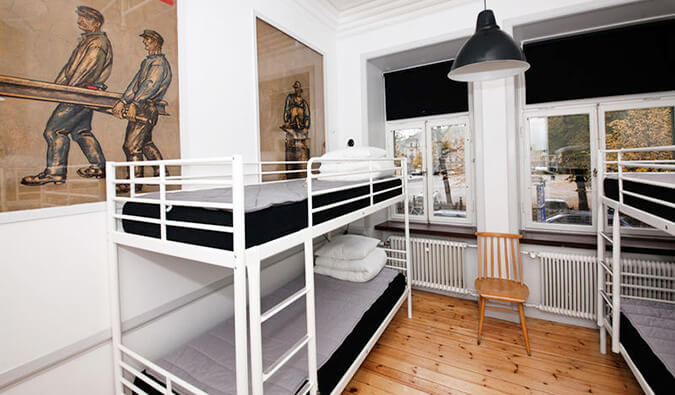
My 13 Favorite Hostels in Europe

My Step-By-Step Guide to Backpacking Europe
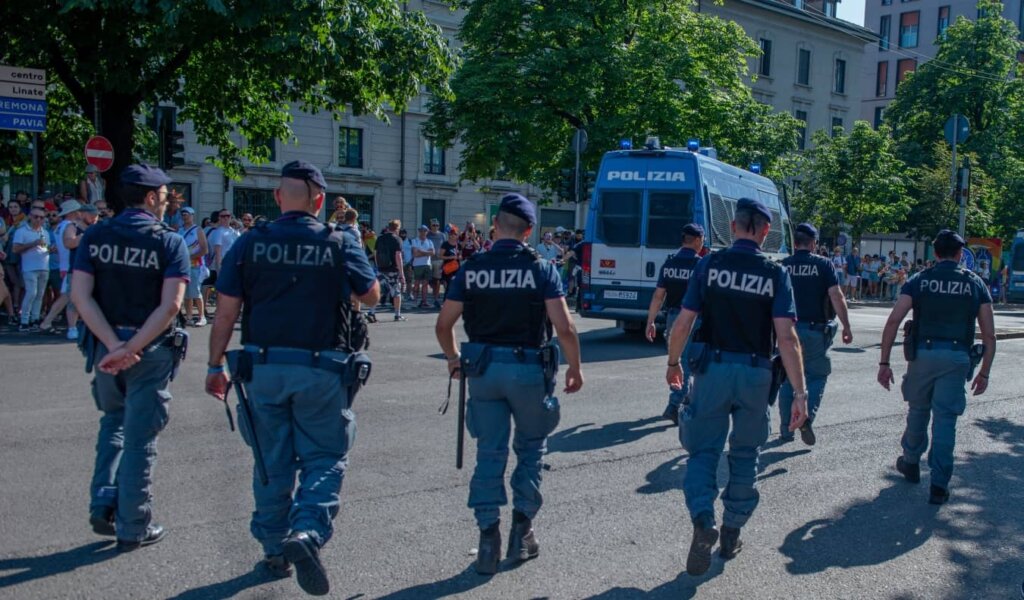
Is Europe Safe to Visit Right Now?

HostelPass Review: Is This Discount Pass Worth It?
Get your free travel starter kit.
Enter your email and get planning cheatsheets including a step by step checklist, packing list, tips cheat sheet, and more so you can plan like a pro!

- Where To Stay
- Transportation
- Booking Resources
- Related Blogs
- Search Please fill out this field.
- Manage Your Subscription
- Give a Gift Subscription
- Newsletters
- Sweepstakes
- Destinations
10 Affordable Places to Visit in Europe
Stick to these vibrant and affordable cities to visit Europe on a budget.
:max_bytes(150000):strip_icc():format(webp)/Lauren-Dana-Ellman-1cd58a16cf194beaad4749c08ba31269.jpeg)
Gautier Houba/Travel + Leisure
A trip to Europe doesn’t have to break the bank — so as long as you know where to go. Fortunately, the continent is home to majestic locales that offer wallet-friendly flights and lodging options.
To determine the most affordable places to visit in Europe right now, we tapped the pros at Priceline to pull data on the cheapest European destinations to fly to between August and October. What’s more, says Christina Bennett, Priceline’s consumer travel expert, “European travel is a late summer staple and has grown in popularity during the shoulder season for its mild, pleasant weather. Despite this, “exploring Europe on a budget is entirely feasible if you plan accordingly.”
With that in mind, we also consulted T+L A-List advisor Jay Ternavan of JayWay Travel to share some savvy money-saving tips.
As you scroll through the list below, you’ll notice all destinations offer an average round-trip airfare of less than $900. Unsurprisingly, a handful of cities featured also offer some of the most affordable average nightly hotel rates in Europe. And while some of these cities have ritzy reputations, free attractions run the gamut from lush parks and world-class museums to captivating festivals.
Keep reading for the complete list, and happy travels.
Copenhagen, Denmark
Maria Ligaya/Travel + Leisure
Average round-trip airfare: $688.32
The Danish capital lures in thousands of tourists with its eclectic architecture — it was even named a UNESCO World Capital of Architecture in 2023 — buzzy food scene (don’t miss the Copenhagen Cooking & Food Festival , which takes place in August), and fascinating history. Not only is the late summer/early fall one of the most affordable times to visit, but it’s also “much easier to secure a reservation at world-renowned restaurants like Geranium and Alchemist, known for their notoriously long waiting lists,” says Olivia Liveng , travel expert and Copenhagen resident. And while the city has a reputation for pricey fine dining, free attractions also abound, including the National Museum of Denmark, the Little Mermaid statue, and the changing of the guard at Amalienborg Palace. A trip to the Tivoli Gardens (tickets from $23) is also a must, as is a visit to Bakken , the world’s oldest amusement park (where admission is free). In terms of getting around, both Ternavan and Bennett advise renting a bike to explore the city, which is both an inexpensive and convenient mode of transportation. Last but not least, it’s worth noting that, per Priceline, Copenhagen offers the fifth-lowest hotel prices in Europe between August and October, with average nightly rates clocking in at $215.
Dublin, Ireland
Tessa Desjardins/Travel + Leisure
Average round-trip airfare: $756.08
“Dublin’s festivals, such as the Dublin Fringe Festival [which takes place in September], offer rich cultural experiences from August to October,” says Bennett. Additionally, the destination’s mild weather is “great for exploring parks and historic sites,” including St Stephen's Green, Phoenix Park, and the National Botanic Gardens, as well as Dublin Castle and St Patrick's Cathedral. Indoor attractions also abound, including the Guinness Storehouse (cheers!) and Trinity College, where you can catch a glimpse of the world-famous Book of Kells. According to Ternavan, budget-conscious travelers should “use the Leap Visitor Card for unlimited travel on public transport,” sign up for a free walking tour , and visit no-cost attractions like the National Museum of Ireland. When hunger calls, refuel at one of the city’s many traditional pubs, which offer affordable meals plus — in many cases — live music. Pro tip: “Look for lunch specials outside tourist areas,” says Ternavan. Also, when selecting hotels, there are plenty of options to choose from that won’t break the bank, especially when you consider that Dublin ranks among the top 15 European destinations with the cheapest hotel prices from August to October 2024, with an average nightly rate of $273, according to data from Priceline.
Nice, France
Christopher Larson/Travel + Leisure
Average round-trip airfare: $779.49
Each summer, thousands of tourists flock to tony Nice in search of fun in the sun. However, savvy travelers opt to visit in the early fall months (the destination’s shoulder season) to snag lower airfare and lodging rates coupled with minimal crowds. Sure, the city is best known for its beaches, but it also boasts a charming Old Town, as well as some of France’s best museums, including the Marc Chagall National Museum , which is sure to wow art enthusiasts of all ages. Also, while Nice is home to a burgeoning culinary scene , the eateries can be pricey. Instead, says Ternavan, “Skip restaurant lunches and visit the Cours Saleya Market for local food, available daily except Monday until 1:00 p.m.” For the best city views, make a beeline for the free Castle Hill, a former military citadel turned park; just be sure to wear comfortable shoes. Finally, visitors may also consider a day trip to buzzy Cannes, accessible via a 40-minute train ride that costs less than 9 euros per person each way.
London, England
Gautier Houba/Travel + Leisure
Average round-trip airfare: $790.35
From its royal palaces and historic landmarks (looking at you, Big Ben) to adorable neighborhoods and world-class museums, there’s lots to love about London . Bennett recommends visiting in the late summer and early fall “for memorable events like the Notting Hill Carnival in late August and the London Film Festival in October.” Enjoy the mild autumn weather and lush foliage by retreating to Hyde Park and Kew Gardens, and be sure to take advantage of other free attractions such as the changing of the guards at Buckingham Palace, The British Museum, and The National Gallery. Skip a fancy lunch in favor of a visit to Borough Market to sample an array of eclectic eats for a lower price. A Visitor Oyster Card can help you save on transportation costs, while a London Pass is especially great since you can skip the lines, book attractions online, and snag discounts. Theater enthusiasts, meanwhile, can visit the TKTS booth for cheap, last-minute tickets to a West End show.
Paris, France
Ambika Verma/Travel + Leisure
Average round-trip airfare: $797.55
Come July, millions of travelers from across the globe will flock to Paris to watch the 2024 Summer Olympics (July 26 to Aug.11); however, come mid-August, the crowds will clear out, and hotel prices will significantly drop. The savings continue into the early fall months, which coincide with the city’s shoulder season, and the beautiful foliage is just the icing on the cake. Paris Pass provides access to over 75 attractions and sightseeing tours. While we’d argue the city is best explored on foot — choose from a handful of free walking tours to enhance your experience — public transportation is readily available and inexpensive, and travel passes are also available. While a trip to Paris most certainly includes stops at top-notch eateries, you can save a few bucks by ordering a “ carafe d’eau (tap water bottle) in Parisian restaurants to avoid the cost of bottled water,” says Ternavan. Similarly, he advises travelers “carry a refillable bottle for public drinking fountains around the city's parks.” Lastly, the travel advisor notes that free admission is available to several museums, including Musée d'Art Moderne de la Ville de Paris, Maison de Balzac, Musée Carnavalet, Petit Palais, Maison de Victor Hugo, and Musée de la Vie Romantique.
Reykjavik, Iceland
Irjaliina Paavonpera/Travel + Leisure
Average round-trip airfare: $812.18
Reyjavik, which recently made our list of the most affordable solo travel destinations , also happens to be one of the cheapest places to visit in Europe this year. During this time, travelers can try their luck at spotting the northern lights while partaking in outdoor adventures and activities — scenic hiking opportunities abound, including Mount Esja, Glymur Waterfall, and Kerid Crater, all of which are within an hour from the city. When it comes to exploring the city proper, Ternavan recommends “getting a Reykjavik City Card for free bus travel and entry to many attractions,” including the National Museum of Iceland, Reykjavík Zoo and Family Park, and a slew of thermal pools for restorative soaks. Pre- or post-sightseeing, treat yourself to a pastry at one of the city’s many bakeries , including buzzy BakaBaka and the 1834-era Bernhoftsbakari . Additionally, the eclectic city made Priceline’s list of the top 15 most affordable places to visit in Europe based on hotel prices, with an average nightly rate of $273.
Lisbon, Portugal
Average round-trip airfare: $868.94
Rich history, colorful architecture, and vibrant nightlife: Find all this and more in Portugal’s capital city, which dates back to 1200 B.C. Additionally, says Bennett, “Lisbon’s warm weather from August to October is perfect for exploring its historic districts and outdoor events.” Alternatively, she adds, “spend a sunny day exploring the beaches of the Iberian Peninsula, only 30 minutes from the city center,” because, yes, you can still enjoy the beach outside of peak season — and the fewer crowds are an excellent added bonus. Plus, a trip here doesn’t need to break the bank: “Use trams, buses, and metro, and buy a Lisboa Card for unlimited travel and free entry to many museums,” says Ternavan. He also recommends carving out some time to explore the beautiful Alfama neighborhood, where you can watch free live Fado performances. When it comes time to rest your head, breathe easy: Priceline listed Lisbon as the eighth-cheapest place in Europe based on hotel prices, with the average nightly rate being $240.
Barcelona, Spain
Daniel Gioia/Travel + Leisure
Average round-trip airfare: $872.05
Per Bennett, this beautiful beachfront city is brimming with festivals between August and October, with La Mercè (Sept. 20-24, 2024) being the most notable. During this time, travelers can also soak up the sun at the beach or one of the city’s many parks, including, of course, the world-renowned Park Güell , a UNESCO World Heritage Site. Both Bennett and Ternavan recommend buying a T10 ticket for discounted travel on public transportation. Also, says Ternavan, “Skip the touristy La Boqueria and visit local markets like Santa Catarina instead for fresh and affordable food.” Bonus: With an average nightly room rate of $261, Barcelona also made Priceline’s list of the most affordable destinations in Europe based on hotel prices from August to October 2024.
Manchester, England
Atlantide Phototravel/Travel + Leisure
Average round-trip airfare: $873.04
Manchester stands out among England’s most dynamic cities , and traveling here is “often a more affordable way to experience English culture,” says Bennett. “Furthermore,” she adds, “events like the Manchester Pride Festival in late August and the Manchester Food and Drink Festival in September showcase the city's diversity, uniqueness, and accessibility.” The destination also offers a slew of free attractions to choose from, including museums (don’t miss the Science and Industry Museum, which is home to the world’s oldest surviving passenger railway station), the Central Library, and the Manchester Town Hall, known for its elaborate Victorian Gothic Revival-style architecture. Those craving reprieve from the city’s hustle and bustle can head to Runway Visitor Park, which sits adjacent to the airport so you can watch the planes take off, or Whitworth Park, which spans 18 tranquil acres on the University of Manchester campus. The free hop-on, hop-off bus service makes getting around the city easy and hassle-free. Also, take advantage of free walking tours, such as this one , offered daily at 11 a.m.
Zurich, Switzerland
Stephanie Pollak/Travel + Leisure
Average round-trip airfare: $891.88
While Zurich — and Switzerland as a whole — is known for being pricey, visiting in late summer and early fall is a great way to save. Additionally, says Bennett, “Zurich hosts various cultural festivals and open-air events from August to October,” including Zürcher Theater Spektakel (Aug. 15-Sept. 1,2024), Zürich Openair (Aug. 23-31, 2024), and Zurich Design Weeks (Sept. 12-29, 2024). Meanwhile, “The crisp weather is great for exploring lakes and parks,” including the eponymously named Lake Zurich and Greifensee , along with the tranquil Belvoir Park and the small but spectacular Chinagarten , where you’ll find a small palace plus a pond. Ternavan also recommends travelers take advantage of the city’s “efficient public transport system with day passes for unlimited travel.” He continues, telling Travel + Leisure , “Keep your sightseeing costs reasonable by opting for a small group walking tour over [a] private [option].” Based on data from Priceline, Zurich clocks in at number seven on the top 10 most affordable European destinations to visit based on hotel prices, with an average rate of $237 per night.
Related Articles

IMAGES
COMMENTS
20 European Vacation Ideas for Your Europe Trip. These are my best one week vacations in Europe. Taking a multi city European vacation can be a great way to experience several different cultures on one continent. I know that one week in Europe isn't a lot of time, so I've picked cities that are either close in proximity or a quick and cheap ...
An important must-know for all first time visitors to Europe is that border-free travel doesn't exist across the continent (as is commonly believed). Rather, border-free travel apples only between countries in the Schengen Area, this group of 27 countries (accurate as of 2023): Austria. Belgium. Croatia.
3. Check Europe Travel Visa Requirements. Americans traveling to Europe won't need a Visa to travel to most countries on the continent. Europe travel visas are a little complicated, but you can learn more about them here. If you're looking to stay in Europe for more than 90 days, read this. Beginning in 2023, US citizens and citizens of other previously non-visa countries coming to the EU ...
🏟 Day 1-3: Rome, Italy. Start your 10 day Europe trip in the ancient capital of Italy. Rome is home to endless historical monuments, artsy squares, and scenic lookouts. Learn about the gladiators' world at the majestic Colosseum and admire world-famous art in Vatican City, where the Pope resides.. As touristy as it is, tossing a coin into the Trevi Fountain is a must.
This 7-day itinerary is a must-do in Europe for the rich history, culture, and food and drink. Bavaria is one of the most beautiful parts of Germany, and Salzburg one of the most visited destinations in Austria. A view of historic Munich. In Munich, try traditional Munich food like white sausage, pretzels and beer.
Athens. #10 in Best Places to Visit in Europe for 2023-2024. Athens was made for history buffs and architecture aficionados thanks to its world-renowned landmarks like the Acropolis, home of the ...
Some of our favorite bucket list European road trips so far have been in Tuscany, Provence, Sicily, Ireland, Southern Spain, and Croatia -but there are many more to come in the future. A Norway road trip in the summer, a Transylvania road trip, and a Scottish Highlands road trip are all at the top of our wish list!
Most fairytale stories are plucked straight from the lovely and quaint villages scattered throughout France, Germany, and Austria. This 3 weeks Europe itinerary is just the ticket for a dreamy fairytale trip to see magical castles and enchanting storybook towns. Day 1-4: Paris, France. Day 5-7: Colmar + Riquewihr, France.
Days 12 - 14: Rome. Your next stop in Italy, and the last stop on your Europe itinerary, is the Italian capital of Rome. Founded almost 3,000 years ago, Rome is absolutely stuffed full of historical wonders and attractions. We think that to do Rome justice, you should spend three days here.
Itinerary #6 West Europe: The UK, Netherlands, and Belgium. The last itinerary option for your 2 weeks in Europe includes the countries the UK, Netherlands, and Belgium, also known as the west of Europe. The UK is popular for many things, including its monarchy, culture, history, and performers.
Best 10-Day Europe Trip itinerary Ideas! In this article, we've teamed up with other travel bloggers to describe 25 magical 10-day Europe itineraries, to help you plan your dream trip. While you can rent a car and do a 10-day Europe road trip if you wish, you can also reach many many destinations without the need to drive yourself.
Top tips for planning your itinerary. 1. Don't try to see everything. Rome wasn't built in a day. And Europe can't be seen in a month, but you can scratch more than the surface on a 30-day traveling budget. Whether you want to tick off the top sights or spend your time more leisurely and get to know the vibe of a city, research, and ...
4. Nice, France. A great inclusion for an ultimate Europe itinerary, Nice gives you a chance to experience the famous French Riviera. Since Nice is a coastal city, it only makes sense to start with a good stroll along the Promenade des Anglais, which follows the city's waterfront.
Plan Your Trip Geographically. Make a list of all your must-hit places, then look at where they fall on a map — connect the dots, and you have your route. Maybe you start in Spain and work your ...
Europe in 10 Days: Best Europe Itineraries. 1. London + Paris + Rome: The Classic First Timer's Route. Itinerary Route: London - Paris - Rome. Days spent in each city: 4 days in London, 3 days in Paris, and 3 days in Rome. Louvre Museum in Paris. This itinerary combines the charm and beauty of the most loved cities in the world - London ...
8. Stay Longer in One Place. Staying in one place longer can allow you to experience the city or neighborhood like a local. Making friends with locals, finding local restaurants restaurants and venturing off the beaten path, can make for exciting travel stories and often the most memorable experiences.
Another tip if you're going to Europe for the first time: always, always check online to see if you can buy tickets to something ahead of time. Museums, churches, really anything! You'll save yourself from having to wait in a long line, and chances are good that you'll be able to buy a ticket for a discount. 10.
Backpacking Europe Suggested Budgets. Prices for travel in Europe vary greatly depending on how far north, east, south, or west you travel. If you stick to the budget accommodations, food, and tours listed here and use all my tips on saving money, you need about 65-110 EUR per day in Western Europe, 40-50 EUR in Eastern Europe, and about 85-130 EUR in Scandinavia.
Reykjavik, Iceland. Average round-trip airfare: $812.18. Reyjavik, which recently made our list of the most affordable solo travel destinations, also happens to be one of the cheapest places to ...
The top destinations in Europe are no secret. The map has been drawn and the photos have been 'Grammed. Paris. London. Rome.You've been dreaming of a European adventure to these cities for what feels like forever. Rearrange this top ten list however you wish and you'll still have trouble deciding which to visit first.
With more than 50 million redeemed miles under her belt, Becky Pokora is a rewards travel expert. She's been writing about credit cards and reward travel since 2011 with articles on Forbes Advisor ...
If you're off on holiday to Europe, then you'll likely have to drive through France to reach your destination. This guide looks at everything you need to know. ... RAC > Drive > Travel > Driving in Europe > Top 16 tips for driving through France in 2024. Top 16 tips for driving through France in 2024. 28th Dec 2023. Share; Facebook; Twitter;